CATECHESIS Q & A: Deepening Our Knowledge
We have created this section on our website and in our bulletin for the purpose of presenting Church teaching in an easy-to-understand forum. When space permits in the Parish Bulletin, we will present a new Question and Answer there about some topic of our Catholic Faith in order that each of us may understand Church teachings better and be able to share our beliefs with others.
Various members of the parish staff, along with the Carmelite Friars, have submitted these articles (including articles written by well-known Catholic apologists). These articles will be kept in this section of the website so that you may refer back to them.
God bless!
CATEGORIES: So that you may more easily find the answers to your questions, the categories (in alphabetic order) into which these articles fall are listed to the right. Some articles appear in more than one category.
The titles of the articles can be seen below; they are listed in the order of publication in the bulletin.
by Ruben Beltran
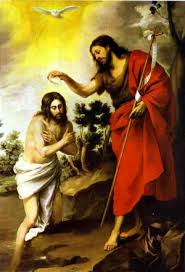
"I need to be baptized by you, and do you come to me?"
Matt. 3:14
"Why was Jesus Baptized?" Every January the Church celebrates the Baptism of Jesus Christ, an event recorded in all four Gospels. But the question is often asked, “Why was Jesus Baptized?” Baptism, according to the Catechism of the Catholic Church (Paragraph 1279), “…includes the forgiveness of original sin and all personal sins, birth into new life by which man becomes an adoptive son of the Father, a member of Christ and a temple of the Holy Spirit.”
But Jesus was sinless and is eternally the Son of the Father. Even John the Baptist seems confused by what Jesus did. “John would have prevented Him, saying, ‘I need to be baptized by you, and do you come to me?’ But Jesus answered him, ‘Let it be so now; for thus it is fitting for us to fulfill all righteousness.’ Then he consented” (Matt. 3:14-15). In the context of Matthew, “righteousness” is a fulfillment of the Law.
So why was Jesus Baptized?
Emeritus Pope Benedict the XVI explains it beautifully: “The Significance of this event could not fully emerge until it was seen in light of the Cross and Resurrection. Descending into the water, the candidates for Baptism confess their sin and seek to be rid of their burden of guilt. What did Jesus do in this same situation? …Looking at the events in light of the Cross and Resurrection, the Christian people realized what happened: Jesus loaded the burden of all mankind’s guilt upon His shoulders; He bore it down into the depths of the Jordan. He inaugurated His public activity by stepping into the place of sinners. This inaugural gesture is an anticipation of the Cross……
The whole significance of Jesus’ Baptism, the fact that He bears “all righteousness,” first comes to light on the Cross: The Baptism is an acceptance of death for the sins of humanity, and the voice that calls out “This is my beloved Son” over the baptismal waters is an anticipatory reference to the Resurrection” (Benedict XVI, Jesus of Nazareth, Vol. 1).
For further reading on the Baptism of Christ see Catechism of the Catholic Church (Paragraph 536).
Published in the 1/11/15 bulletin
Excerpted from “What’s The Smoke For?” by Johan Van Parys
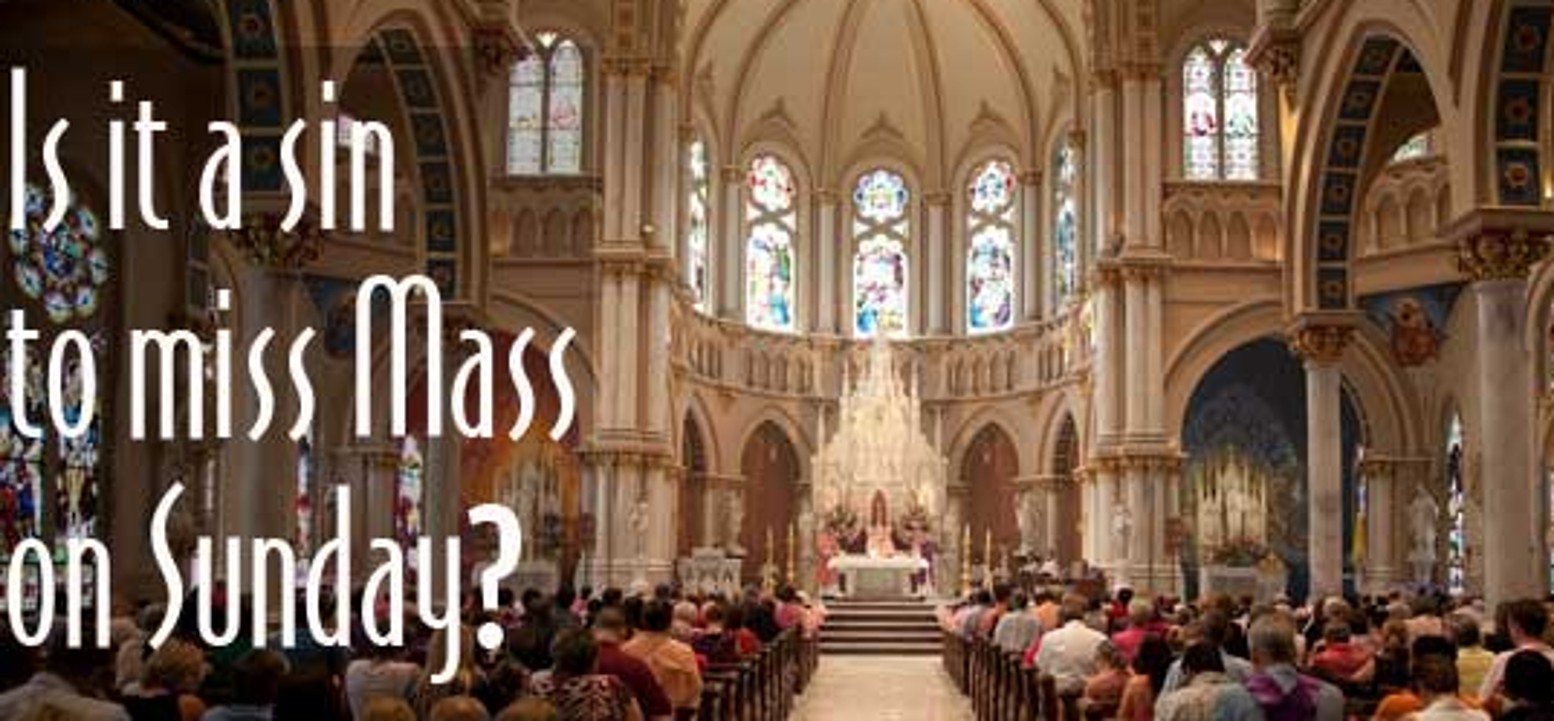
When you love someone, do you see it as an obligation to spend time with them?
Is it a Sin to Miss Mass on Sunday? Do we as Catholics still believe we are “obligated” to “Keep Holy the Sabbath Day”? And why are there other days of “Holy days of Obligation”? When you love someone, do you see it as an obligation to spend time with them? Or, would the person who has been saved from drowning or a fire ever think it is a burden to thank their savior? These questions bespeak a legalistic and minimalist approach to the celebration of the mysteries of our faith, which is rather regrettable and supremely sad.
Our current understanding of Sunday and holy days of obligation is that it has been imposed on us by the Church, and rightfully so. By contrast, the early Church had no such law because there simply was no need for it. The sense of “obligation” early Christians felt to celebrate Sunday Eucharist flowed from a deep personal and communal desire. Theirs was an inner obligation to celebration of the Eucharist. St John Paul II in his apostolic letter Dies Domini (On Keeping the Lord’s Day Holy), calls it “obligation of conscience”. As this “obligation of conscience” or inner desire started to wane, individual bishops found it necessary to remind the faithful that the Sunday assembly was not simply an option but rather a sacred duty. In 1917 the Code of Canon Law 1247 defined the obligation to celebrate Eucharist on Sundays and Holy days of obligation as universal law.
CCC 2181: The Sunday Eucharist is the foundation and confirmation of all Christian practice. For this reason the faithful are obligated to participate in the Eucharist on days of obligation, unless excused for a serious reason (for example, illness, the care of infants, etc.) or dispensed by their own pastor. Those who deliberately fail in this obligation commit a grave sin.
Published in the 1/18/15 bulletin
by Ruben Beltran
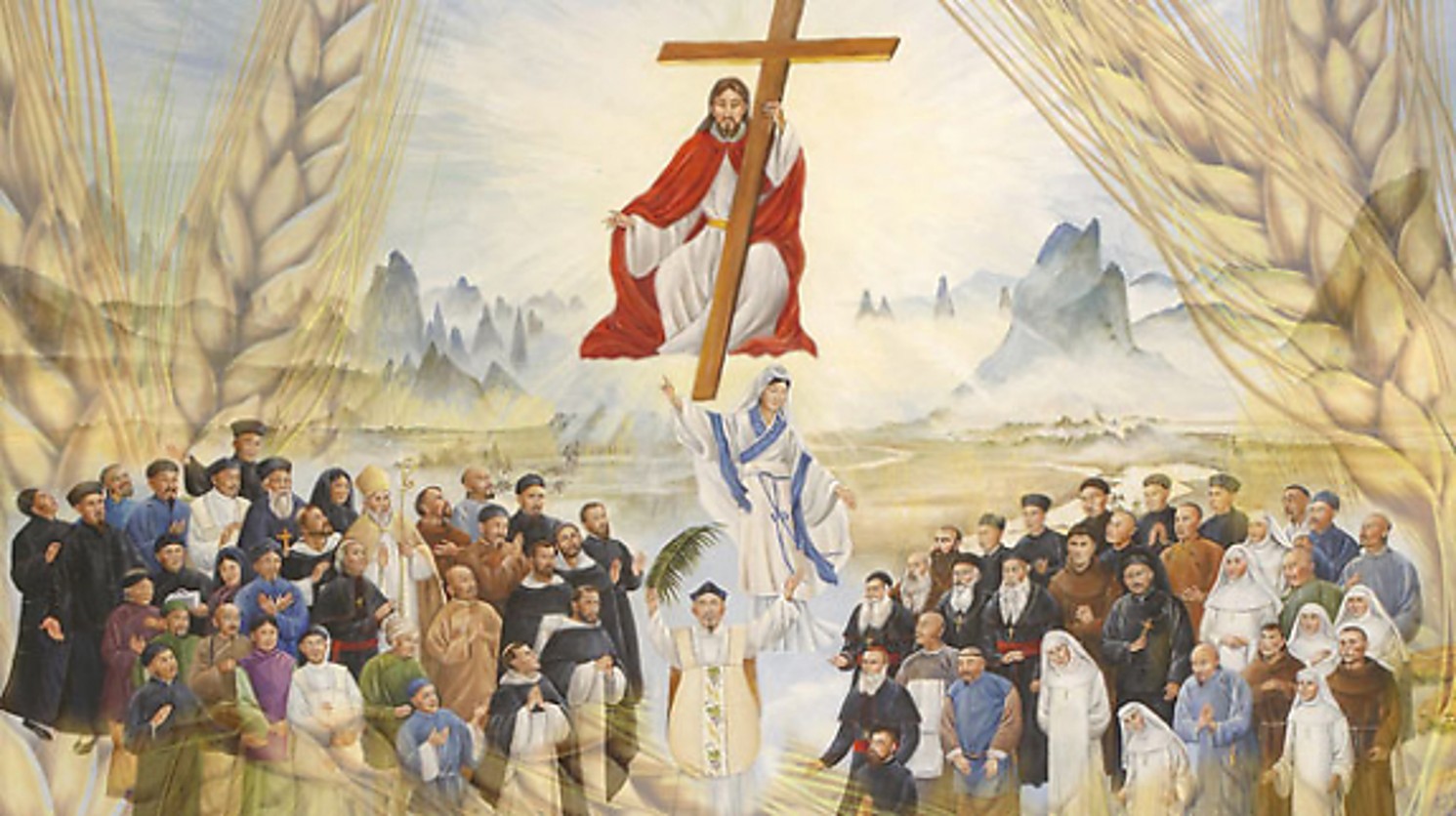
Why do Catholics pray to the Saints? Why not pray directly to Jesus? This is a question Catholics often get asked; unfortunately, most Catholics do not know how to answer. First and foremost, we need to look at what the Church teaches on the subject, and for that we turn to the Catechism of the Catholic Church, Paragraph 2683: The witnesses who have preceded us into the kingdom, especially those whom the Church recognizes as saints, share in the living tradition of prayer by the example of their lives, the transmission of their writings, and their prayer today. They contemplate God, praise Him, and constantly care for those whom they have left on earth. When they entered into the joy of their Master, they were "put in charge of many things." Their intercession is their most exalted service to God's plan. We can and should ask them to intercede for us and for the whole world.
The first thing that needs to be pointed out is that we do not pray to the saints in the same manner that we pray to God. God alone has the power to grant or deny our petitions. When we pray to the saints we only ask for their intercession; in other words, we ask them to pray for us. Some may object that the Bible says that there is only one mediator between God and man, Jesus: "For there is one God, and there is one mediator between God and men, the man Christ Jesus" (1 Tim. 2:5).
This is true. However, most non-Catholics have no problem asking a family member or friend to pray for them; and asking one person to pray for you in no way violates Christ’s mediatorship. Why not? Dr. Scott Hahn points out that: “First, the Greek word used here for 'one' is eis, which means 'first' or 'primary,' not monos, which means 'only' or 'sole.' Just as there is one mediator, there is also one Divine Sonship, which we all share—by way of participation—with Christ.” Because we are all part of the one Mystical Body of Christ, we share in His roles and participate in them.
Finally, some may say, ”The saints are dead; they cannot hear you and the Bible forbids communicating with the dead” (for example, Deuteronomy 18:10-11), but necromancy was the practice of conjuring up the dead through wizards or mediums in order to manipulate the spiritual realm or foresee the future, which is categorically different from asking our brothers and sisters in Christ who have passed on to pray for us.
Furthermore, the Book of Revelation shows that the saints in Heaven are clearly aware of what is happening on earth (Rev 5:8, Rev 6:10). Scripture says we are surrounded by a great cloud of witnesses (Hebrews 12:1). These are the saints who have "run the race" here on earth and are now cheering us on in Heaven. They are perfected in love because they are in the presence of God—who is Love. To love is to will the good of another, and that is what the saints do. They will that we attain the greatest good of all: God. That is why we ask them to pray with us and for us.
Published in the 1/25/15 bulletin
By Denise Holguin-McMaster, Parish Secretary
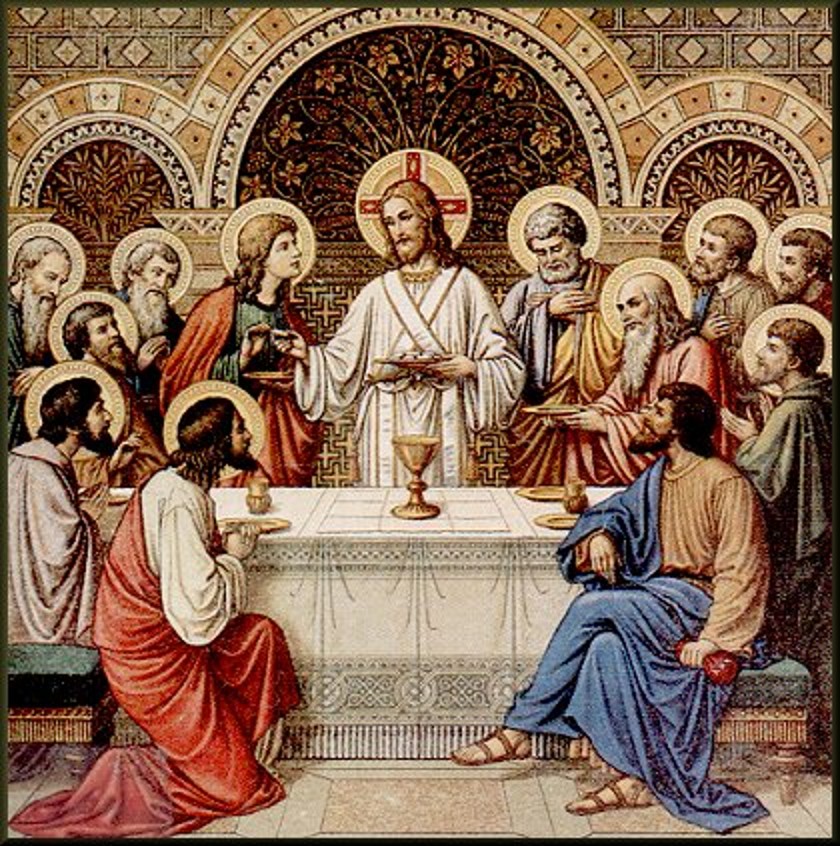
“How Should I Prepare to Come to Mass?”
Preparing to attend Mass should begin at home. First, each person who
plans to receive Holy Communion must observe the fasting requirement,
which is to refrain from food and drink for at least for one hour before
receiving. Some people mistakenly believe the Church has done away with
the fasting rule; however, it is still required—though greatly
modified. Before Vatican II, Catholics were required to fast beginning
at Midnight before receiving Holy Communion!
Next, it is important that we be in the proper frame of mind and truly contemplate what we are about to do. The Daily Roman Missal tells us that, in preparation for Mass, we can contemplate the fact that the Eucharistic Sacrifice is the most important event that happens each day—the most pleasing reality we can offer to God. It also recommends praying that the Holy Spirit will guide the priest’s words and actions, and that He will enlighten the members of the congregation to “open their ears” to receive the Word of God and accept its meaning. While there are many ways to pray in order to prepare for the Most Holy Sacrifice of the Mass, the point is to orient our minds toward God, to join with our brothers and sisters in the congregation, to have the right intention, and unite ourselves to the Sacrifice of Jesus.
Second, we should prepare for Mass in the way we dress—both modestly and respectfully. Sunday is a special day, and God's House is a special place; and so our clothing ought to reflect this truth. In the Scriptures we read, “Worship the Lord in holy attire” ( 1 Chronicles 16:29, Psalms 29:2, 96:9). Also, the Catholic Catechism teaches that our clothing “ought to convey the respect, solemnity, and joy of the moment when Christ becomes our guest” in Holy Communion ( CCC 1387). The exterior reflects the interior, and God definitely deserves the best we have—inside and out! This is also why altar dressings and priests’ vestments, etc., are normally the best the church can manage. However, we have to remember that our souls should also be “dressed nice,” which leads to our second question...
“Should I Receive Holy Communion at Mass?” In order to respond to the Lord’s invitation to eat His Body and drink His Blood, we must first examine our consciences. St. Paul says, “Therefore, whoever eats the Bread or drinks the Cup of the Lord unworthily shall be guilty of the Body and the Blood of the Lord” (1 Cor. 11:27). This means that if we have committed a serious (mortal) sin, we must not receive until we have gone to Confession. If this is the case, in lieu of receiving you may come forward and tacitly ask for a blessing by simply crossing your arms over your chest. Those who are not Catholic or who are not in full communion with the Church (professing and believing in all the Church’s teachings) are also not permitted to receive. The reason is simple: To receive while not being a practicing Catholic is to witness to something that we do not actually believe. In essence, each person who receives Holy Communion is proclaiming publicly that “I am a practicing member of the Catholic Church and I believe and follow all its teachings.”
Published in the Bulletin of February 1, 2015
By Rhonda Storey
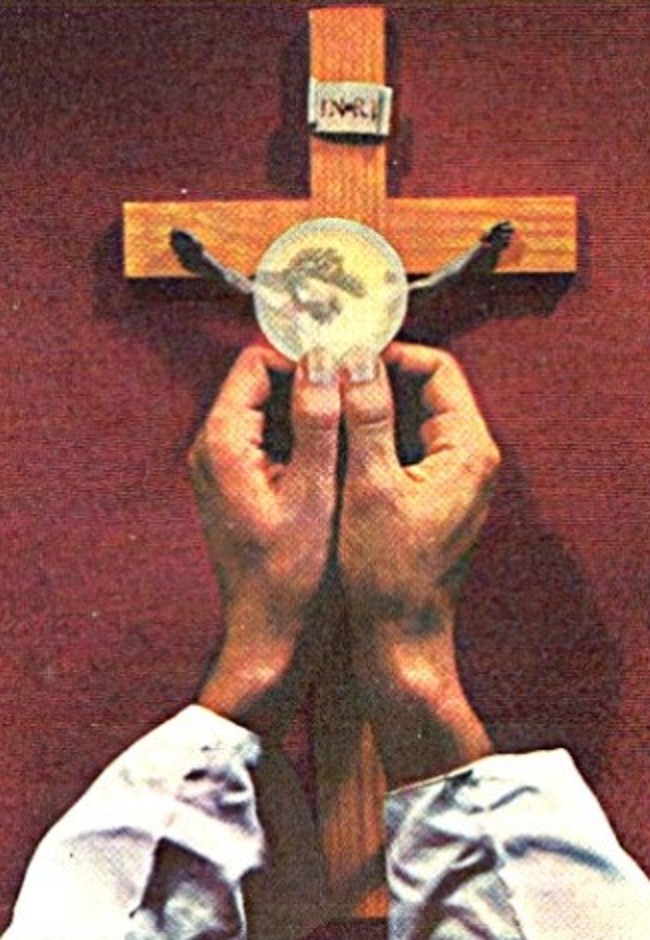
WHAT DO I MISS WHEN I COME IN LATE?
WHEN I LEAVE EARLY?
These two central parts of the Mass are flanked by two smaller parts: the Introductory Rites and the Concluding Rites. The Introductory Rites open the celebration of the Mass and prepare the faithful for their sacred encounter with God in His Word and in the Eucharist. So if we come in late, we are not “preparing” properly for Mass. After Communion, the Concluding Rites formally close the celebration and send the people forth to do good works and take Christ into the world. Mass is not over at Communion. We must remember to kneel down after receiving the Body and Blood of Jesus Christ and give thanks and praise to Him. Then after the Blessing, we sing joyfully together as the priest processes out.
The
chart below lays out these four main sections of the Mass, which serve
as an umbrella for the smaller, individual parts of the liturgy. Keeping
this "big picture" of the Mass in mind will be helpful to become more
faithful participants.
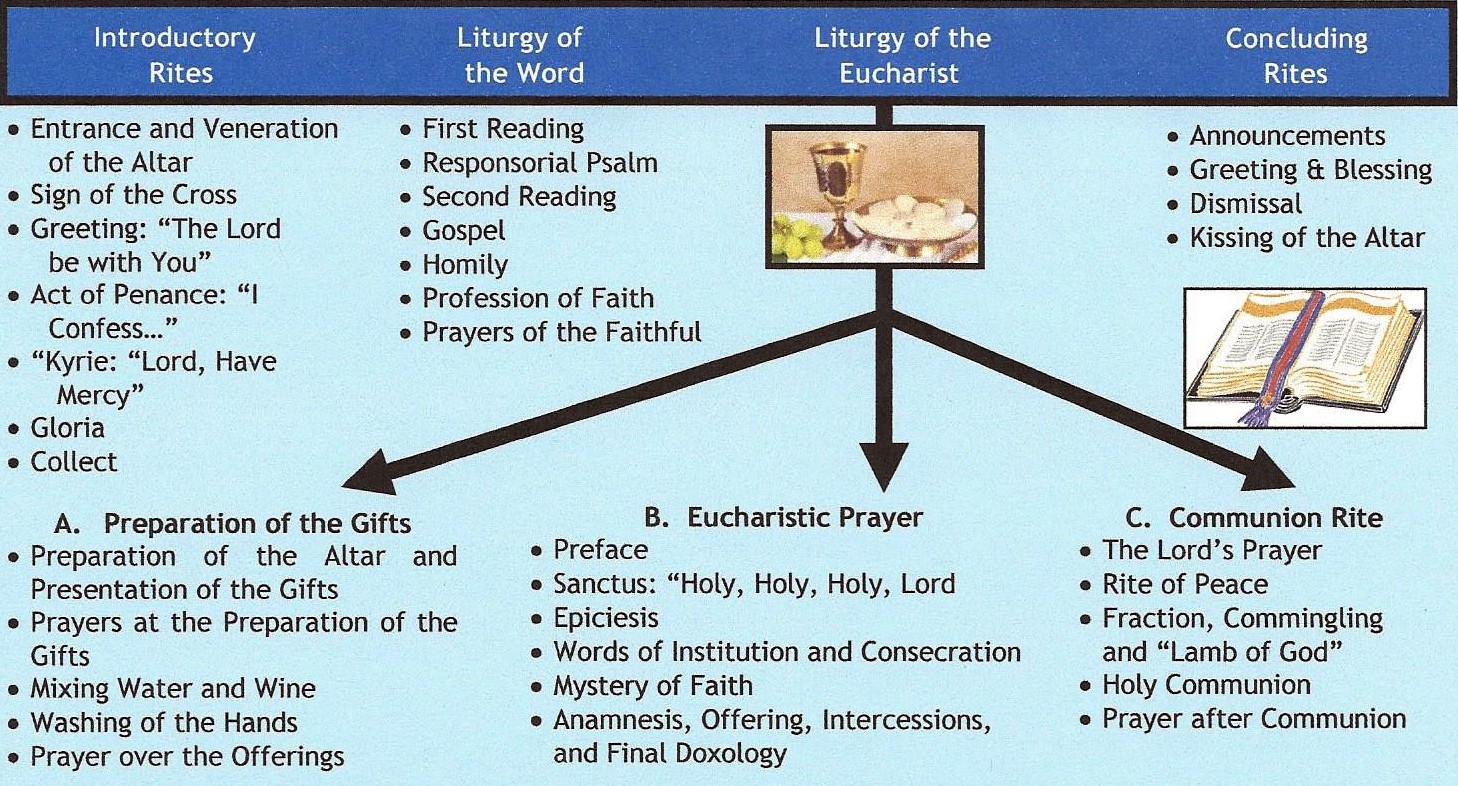
By Ruben Beltran
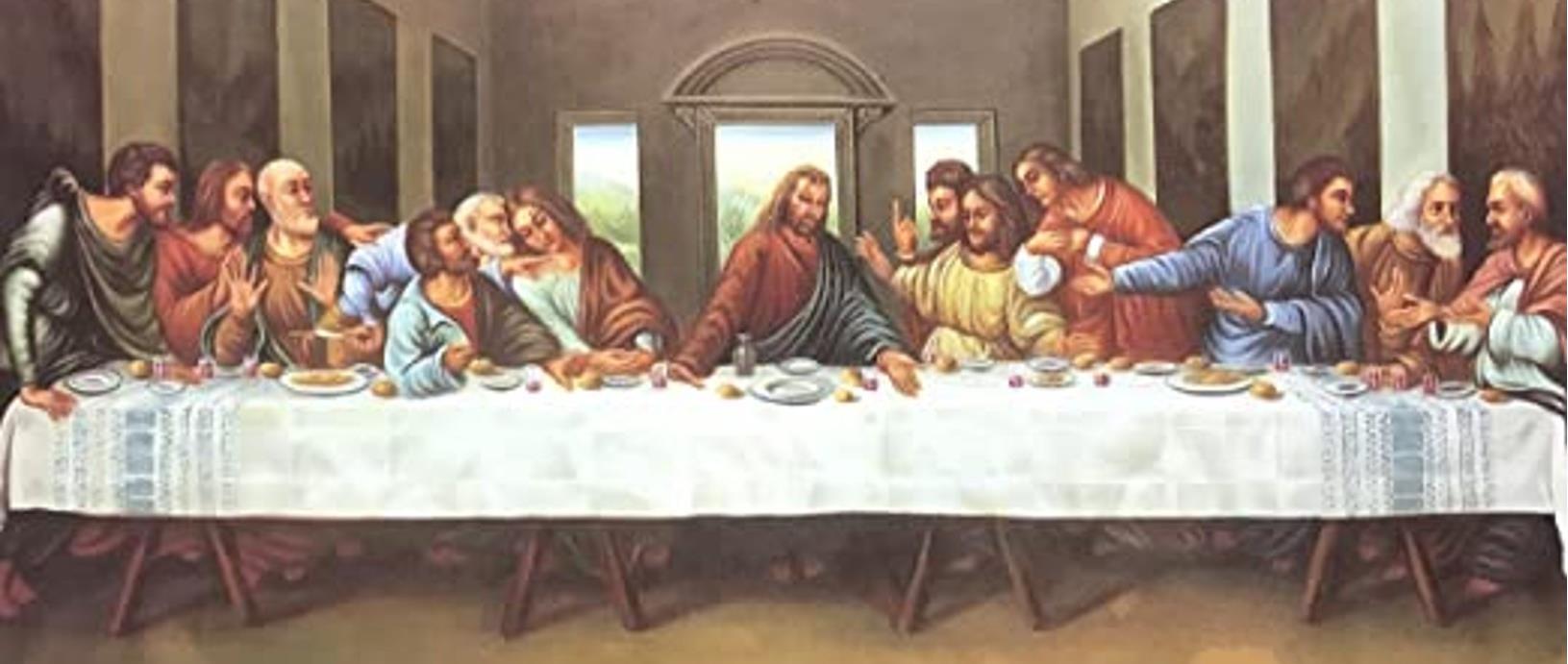
"Where in Scripture Does Jesus Speak of His Body and Blood as Food?" The Eucharist is a sacrament in which is contained—by the marvelous conversion of the whole substance of bread into the Body of Jesus Christ, and that of wine into His precious Blood—truly, really, and substantially, the Body, the Blood, the Soul, and Divinity of the same Lord Jesus Christ, under the appearance of bread and wine, as our spiritual food. The Catechism of the Catholic Church teaches in paragraph 1324: “The Eucharist is ‘the source and summit of the Christian life.’ The other sacraments, and indeed all ecclesiastical ministries and works of the apostolate, are bound up with the Eucharist and are oriented toward it. For in the blessed Eucharist is contained the whole spiritual good of the Church, namely Christ Himself, our Pasch."
But where in the Bible does Jesus explicitly say that He will give us His flesh to eat?
We are all familiar with the institution narratives in the Gospels, specifically Luke’s Gospel, because we hear it every week at Mass. It is the first place most Catholics will turn to show that Jesus Instituted the Eucharist: “And He took bread, and when He had given thanks, He broke it and gave it to them, saying, ‘This is my body which is given for you. Do this in remembrance of me’” (Luke 22:19). However, the Sixth Chapter of the Gospel of John (one which every Catholic should read and be familiar with) gives us the “Bread of Life Discourse”. This Chapter is one of the most important sermons Jesus ever preached but also one of the most disastrous from a human perspective.
Beginning
in verse 35, we see Jesus calling Himself the “Bread of Life” and
saying that we must eat His flesh and drink His blood—something which is
forbidden in the book of Leviticus (17:10). The Jews who are listening
are scandalized by this and begin to murmur: "Then many of His disciples who were listening said, “This saying is hard; who can accept it?... As a result of this, many of His disciples returned to their former way of life and no longer accompanied Him."
What is interesting is that Jesus, knowing that those listening to Him are disturbed by His words, never backpedals. Instead, Jesus intensifies what He says. In the original Greek (John 6:49, 50, 51, 53), Jesus made use of a more common verb for eating, "esthio". However, beginning in verse 54, after the Jews dispute among themselves, Jesus changes the word to "trogo," which means to “chew” or to “gnaw” like an animal. Jesus, knowing in Himself that His disciples murmured at it, said to them, "Do you take offense at this? Then what if you were to see the Son of Man ascending where He was before? It is the Spirit that gives life, the flesh is of no avail; the words that I have spoken to you are Spirit and Life.” Here Jesus explains how this will all take place: “It is the Spirit that gives life...”; so they must wait until the Spirit is given, the Spirit that raises the Body of Christ from the dead. It will be the Holy Spirit that makes Christ’s flesh and blood holy, glorious, and powerful, as food for our souls and bodies.
In verse 66, many of Christ’s disciples leave. Jesus never tries to stop them; in fact, Jesus turns to the Apostles and asks if they, too, wish to leave. In every other instance, when the disciples find something hard to understand, Jesus is quick to explain what He was trying to say, but here we find Jesus allowing words to remain “scandalous”—even for the Twelve. If Jesus was speaking figuratively, He would have taken the time to make that clear to His disciples, but He doesn’t. He was willing to allow the Twelve to leave rather than to soften or change what He said.
Jesus said what He meant, and meant what He said: “My flesh is food indeed, and my blood is drink indeed.”
Published in the Bulletin of February 15, 2015
By Jimmy Akin
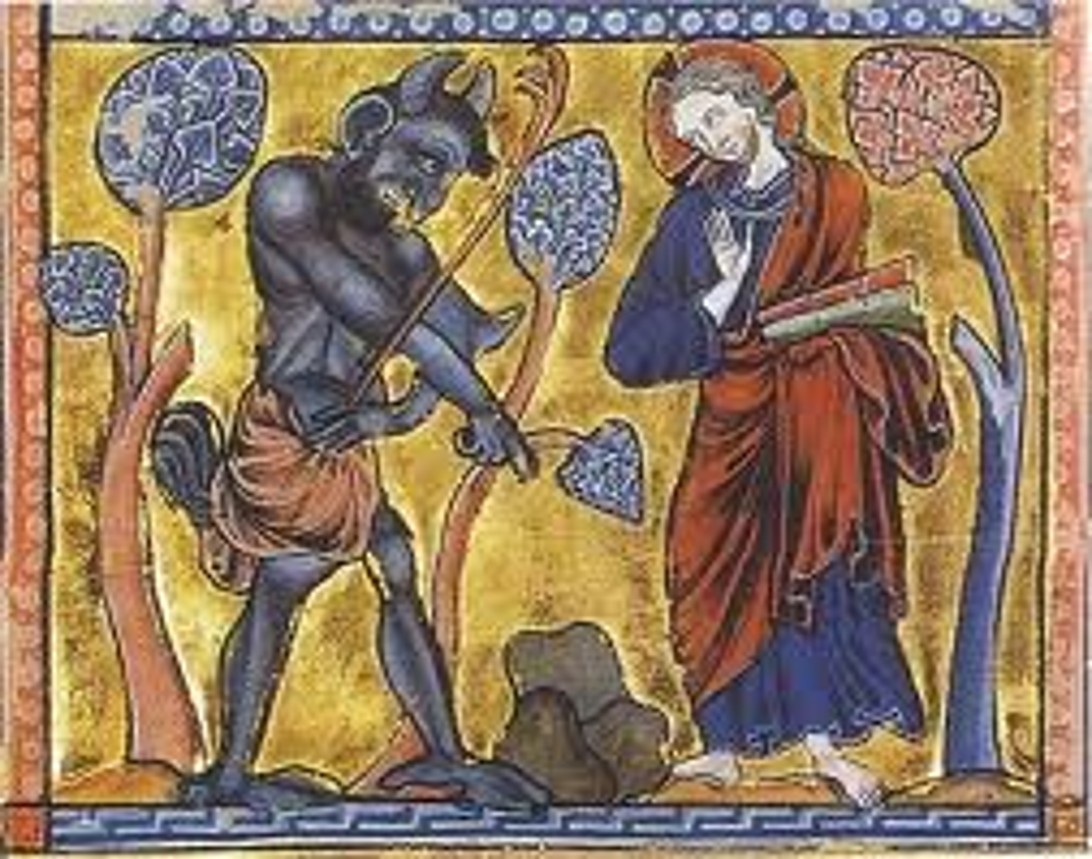
"Why Was Jesus Tested for Forty Days in the Desert?" The Gospel for the First Sunday of Lent in 2015 commemorates Jesus’ forty days of testing in the desert. Jesus decided to spend forty days of testing in the desert as preparation for His adult ministry (forty days is the traditional number for spiritual testing). The reason He chose to begin His ministry with a time of testing was to (a) set an example for us, (b) reveal His identity as Son of God to the opposing supernatural forces, and (c) reveal the nature of His ministry as Messiah to us.
Here is how the Catechism of the Catholic Church(CCC) explains the event (538): The Gospels speak of a time of solitude for Jesus in the desert immediately after His baptism by John. Driven by the Spirit into the desert, Jesus remained there for forty days without eating; He lived among wild beasts, and angels ministered to Him [cf. Mk 1:12-13]. At the end of this time Satan tempted Him three times, seeking to compromise His filial attitude toward God. Jesus rebuffed these attacks, which recapitulated the temptations of Adam in Paradise and of Israel in the desert, causing the devil to leave Him “until an opportune time” [Lk 4:13].
The Catechism continues (539): The evangelists indicated the salvific meaning of this mysterious event: Jesus is the new Adam who remained faithful, unlike the first Adam who gave in to temptation. Jesus fulfilled Israel’s vocation perfectly: in contrast to those who had once provoked God during their forty years in the desert, Christ revealed Himself as God’s Servant, totally obedient to the divine will. In this, Jesus is the devil’s conqueror: He “binds the strong man” to take back his plunder (cf. Ps 95:10; Mk 3:27). Jesus’ victory over the tempter in the desert anticipates victory at the Passion—the supreme act of obedience of His filial love for the Father.
The CCC(540) says that Jesus’ temptation reveals the way in which the Son of God is Messiah, contrary to the way Satan proposed to Him and the way men wish to attribute to Him (cf Mt 16:2 1-23). This is why Christ vanquished the Tempter for us: “For we have not a high priest who is unable to sympathize with our weaknesses, but one who in every respect has been tested as we are, yet without sinning” (Heb. 4:15). By the solemn forty days of Lent, the Church unites herself each year to the mystery of Jesus in the desert.
CCC 566: The temptation in the desert shows Jesus, the humble Messiah, who triumphs over Satan by His total adherence to the plan of salvation willed by the Father. One additional thing that should be known is that the biblical term for “tempting” is the same as the term for “testing.” Jesus was not tempted in the sense that we are—that is, having evil desires—but in the sense of being tested to see if it was possible to tempt Him in the sense of giving Him evil desires. He was not capable of receiving such desires because of His infinite holiness as Son of God.
Published in the Bulletin of February 22, 2015
by Ruben Beltran
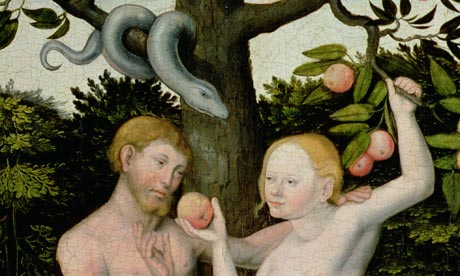
"Why Does the Church Encourage the Faithful to Practice Fasting, Almsgiving, and Prayer--Especially at Lent?"
In order to answer this question, we need to go all the way back to
our first parents—all the way back to the Garden of Eden. If you ask
your average Catholic, “What was the reason for the fall?,” the standard
answer will be “pride”. That answer is correct; however, it is
incomplete. A careful reading of Genesis 3:1-6, wherein Eve is tempted
to eat the fruit from the Tree of Knowledge, will reveal three reasons
for the fall: 1) “She saw that it was good for food”; 2) that it was “a
delight to the eyes”; and 3) that it was “desirable to make one wise.”
In these three reasons lies the seed of every sin that has come into the world. The ancient Jewish Rabbis referred to these three reasons as the “threefold lust.” St. John refers to the threefold lust as the “lust of the flesh, the lust of the eyes, and the pride of life” (1 John 2:16). In more modern terms, these three reasons have come to be known as “Money, Sex, and Power.” Let us see some of the things to which each refers:
- Lust of the Flesh: This refers to a disordered desire for pleasure (food, drink, alcohol, sex, drugs, etc.)
- Lust of the Eyes: This refers to a disordered desire for possessions (money, clothing, cars, houses, investments, gambling, etc.)
- Pride of Life: This refers to pride/power (being selfish, egotistical, controlling, and prone to anger, etc.)
These three desires drive the world; however, they are not in themselves inherently evil. It is only when we put these desires before God that they become disordered, when we choose the least good over the greatest Good—which is God. It is the fact that we want these things on our own terms without God which gives them their lustful nature.
So what is a good Catholic to do? Well, onto the scene steps Jesus, the “New Adam” who reverses Adam and Eve’s sin in the garden and shows us how to conquer sin at its root. One of the first things Jesus does is head out to the desert (Lk 4:1-13). In this context, the desert symbolizes what became of Paradise; that is, Adam turned it into a barren desert by allowing sin to enter the world. Satan proceeds to try and tempt Christ with the threefold lusts: Food (flesh), Kingdom (possessions), and Manifestation of Power (pride). Jesus uses Scripture (specifically the book of Deuteronomy) to combat Satan, and that is what each of us should do. We should always turn to the Word of God to combat the Evil One.
However, Jesus unites Scripture with fasting, almsgiving, and prayer to conquer Satan. Fasting helps us overcome the lust of the flesh and strengthens our wills so that we realize that we cannot live by bread alone. Almsgiving helps us overcome the lust of the eyes and allows us to detach ourselves from the things of the world and to realize that we are to worship God alone. Finally, Prayer humbles us and takes pride out at its root. It helps us realize that without God we are powerless. Christ gives us all we need to conquer the Evil One and reverse the fall of Adam and Eve. This Lent let us use these weapons that Our Lord has given us in order to become more like Him.
Published in the Bulletin of March 1, 2015
Submitted by Deacon Joe & Lorraine Mizerski (Parish Annulment Facilitators)
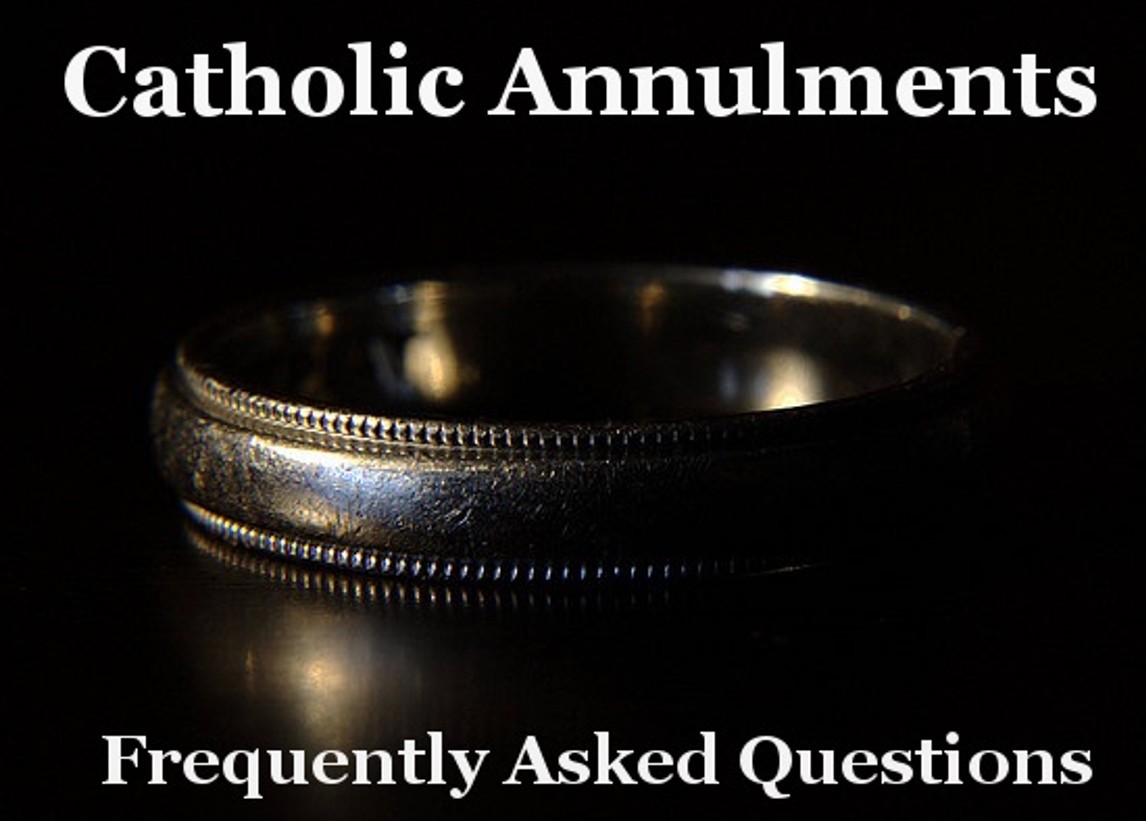
"What is a Catholic Annulment?" "Annulment"is
an unfortunate word that is sometimes used to refer to a Catholic
"declaration of nullity." Actually, nothing is made null through the
process. Rather, a Church tribunal (a Catholic Church court) declares
that a marriage thought to be valid according to Church law actually
fell short of at least one of the essential elements required for a
binding union.
A valid Catholic marriage results from five elements: (1) the spouses are free to marry; (2) they freely exchange their consent; (3) in consenting to marry, they have the intention to marry for life, to be faithful to one another and be open to children; (4) they intend the good of each other; and (5) their consent is given in the presence of two witnesses and before a properly authorized Church minister. Exceptions to the last requirement must be approved by church authority.
Why does the Church require a divorced Catholic to obtain a declaration of nullity before re-marrying in the Church? The Church presumes that marriages are valid and lifelong; therefore, unless the ex-spouse has died, the Church requires the divorced Catholic to obtain a declaration of nullity before re-marrying. The tribunal process seeks to determine if something essential was missing from the relationship from the moment of consent, that is, the time of the wedding. If so, the Church can declare that a valid marriage never actually brought occurred on the wedding day.
What does the tribunal process involve? Several steps are involved. The person who is asking for the declaration of nullity (the petitioner) submits written testimony about the marriage and a list of persons who are familiar with the marriage. These people must be willing to answer questions about the spouses and the marriage. The tribunal will contact the ex-spouse (the respondent), who has a right to be involved. The respondent's cooperation is welcome but not essential. In some cases the respondent does not wish to become involved; the case can still move forward. Both the petitioner and the respondent can read the testimony submitted, except that protected by civil law (for example, counseling records). Each party may appoint a Church advocate who could represent the person before the tribunal. A representative for the Church, called the defender of the bond, argues for the validity of the marriage. After the tribunal has reached a decision, it is reviewed by a second tribunal. Both parties can participate in this second review as well.
How long does the process take? It can vary from diocese to diocese, often taking 12 to 18 months or longer in some cases. The diocesan tribunal may be able to give you a more exact estimate.
How can a couple married for many years present a case? The tribunal process examines the events leading up to, and at the time of, the wedding ceremony, in an effort to determine whether what was required for a valid marriage was ever brought about. The length of common life is not proof of validity but a long marriage does provide evidence that a couple had some capacity for a life-long commitment. It does not prove or disprove the existence of a valid marriage bond.
If a marriage is declared null, does it mean that the marriage never existed? No. It means it was not valid according to Church law. A declaration of nullity does not deny that a relationship existed. It simply states that the relationship was missing something that the Church requires for a sacramental marriage.
If a marriage is annulled, are the children considered illegitimate? No. A declaration of nullity has no effect on the legitimacy of children, since the child's mother and father were presumed to be married at the time that the child was born. Legitimacy depends on civil law.
Since I do not plan to re-marry, why should I present a marriage case? Some people find that simply writing out their testimony helps them to understand what went wrong and why. They gain insights into themselves. Others say that the process allowed them to tell their whole story for the first time to someone who was willing to listen. Many find that the process helped them to let go of their former relationship, heal their hurts, and move on with their lives. A person cannot know today if they might want to marry in the future when crucial witnesses may be deceased or their own memories may have dimmed.
Why does the Catholic Church require an intended spouse, who is divorced but not Catholic, to obtain an annulment before marrying in the Catholic Church? The Catholic Church respects all marriages and presumes that they are valid. Thus, for example, it considers the marriages of two Protestant, Jewish, or even nonbelieving persons to be binding for life. The Church requires a declaration of nullity to establish that an essential element was missing in that previous union preventing it from being a valid marriage. This is often a difficult and emotional issue. If the intended spouse comes from a faith tradition that accepts divorce and remarriage, it may be hard for them to understand why they must go through the Catholic tribunal process. Couples in this situation may find it helpful to talk with a priest or deacon. To go through the process can be a sign of great love of the non-Catholic for their intended spouse.
My fiancé and I want to marry in the Catholic Church. He has been married before and has applied for an annulment. When can we set a date for our wedding? You should not set a date until the annulment has been finalized. First, his petition may not be granted. Second, even if the petition is eventually granted, there may be unexpected delays in the process. Many pastors will not allow the couple to set a date until the petition is officially approved.
To begin your own annulment process, please contact the Parish Annulment Facilitators, Deacon Joe & Lorraine Mizerski, at (626) 282-2744, ext. 333.
Published in the Bulletins of March 8 and March 15, 2015
By Scott Hahn
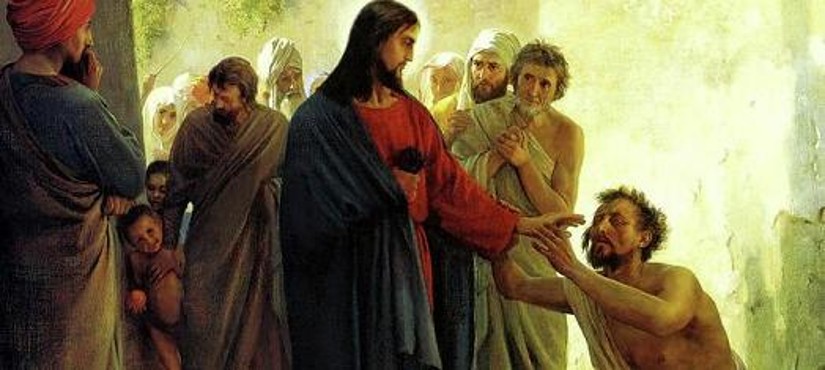
"What is the Anointing of the Sick?" When Jesus commissioned the Twelve, they went out into the world and saw immediate results. In St. Mark’s Gospel we learn that they “anointed with oil many who were sick and healed them” (Mk 6:13). They must have been astonished at the power flowing through them. Yet it was a mere shadow of the task that still lay ahead of them. For, as Jesus made clear elsewhere in St. Mark’s Gospel, it is a greater work to forgive sins than to heal even the gravely ill. (Mk 2:9).
Jesus healed people with dire illnesses and disabilities as a sign of spiritual healing: “…that you may know that the Son of Man has authority on earth to forgive sin” (Mk 2:10). The physical signs were there for the sake of a spiritual reality. They were a concession to human weakness. In fact, after the apostles had witnessed many such marvels, Jesus assured them that they would accomplish “greater works than these” (Jn 14:12).
In the beginning of their ministry, the apostles, like Jesus, restored bodily health. But it was a sign of the deeper healing they would accomplish, through the Church, after Pentecost. We catch a glimpse of the Church’s ministry of spiritual healing in the Letter of St. James: “Is any among you sick? Let him call for the elders [presbyters, or priests] of the Church, and let them pray over him, anointing him with oil in the name of the Lord; and the prayer of faith will save the sick man, and the Lord will raise him up; and if he has committed sins, he will be forgiven” (Jas 5:14-15). This is the Sacrament we know today as the Anointing of the Sick. But it’s fair for us to ask today why physical illness should be an occasion for spiritual healing. There are many good reasons, not least that grave physical suffering is often accompanied by difficult spiritual trial. When we are in extremis, we are far more likely to be tempted to doubt God’s goodness and power—or even His existence. Job’s wife sincerely expected her husband to give in to despair and “curse God” (Job 2:9).
Sacramental oil gives us the grace we need to face such trials. Consider what the symbol of oil suggested to the early Christians. Oil healed, and oil strengthened. It was a base for many medicines. It was also a liniment used by athletes in the arena. Olive oil was a rub down that strengthened wrestlers for a contest and enabled them to slip away from the grip of their enemies. For Christians, all of these worldly values are symbolic of the spiritual value of anointing. Anointing both heals and strengthens us spiritually, and enables us to slip away from the devil’s grasp and endure our contest with him—and, more than endure, to prevail, to be “more than conquerors through Him who loved us” (Rom 8:37). The anointing even brings about that great marvel that Jesus alluded to in St. Mark’s Gospel: the forgiveness of sins. Thus we can face even certain death with a serene and peaceful conscience, in the reasonable hope that death will be our gateway to eternal life.
Sometimes, the sacramental anointing will bring about physical healing as well, if healing will be conductive to the salvation of the soul. That’s wonderful but unusual; and actually, it’s far less a marvel than the Sacrament’s ordinary effects. Anointing is far more likely to give us what we really need: humble acceptance of our suffering, in union with the suffering of Christ and in atonement for sins, especially our own. Anointing helps us transform physical suffering into something more deeply remedial, something truly redemptive.
(Published in the Bulletin of March 22, 2015)
From the Website of Catholic News Agency
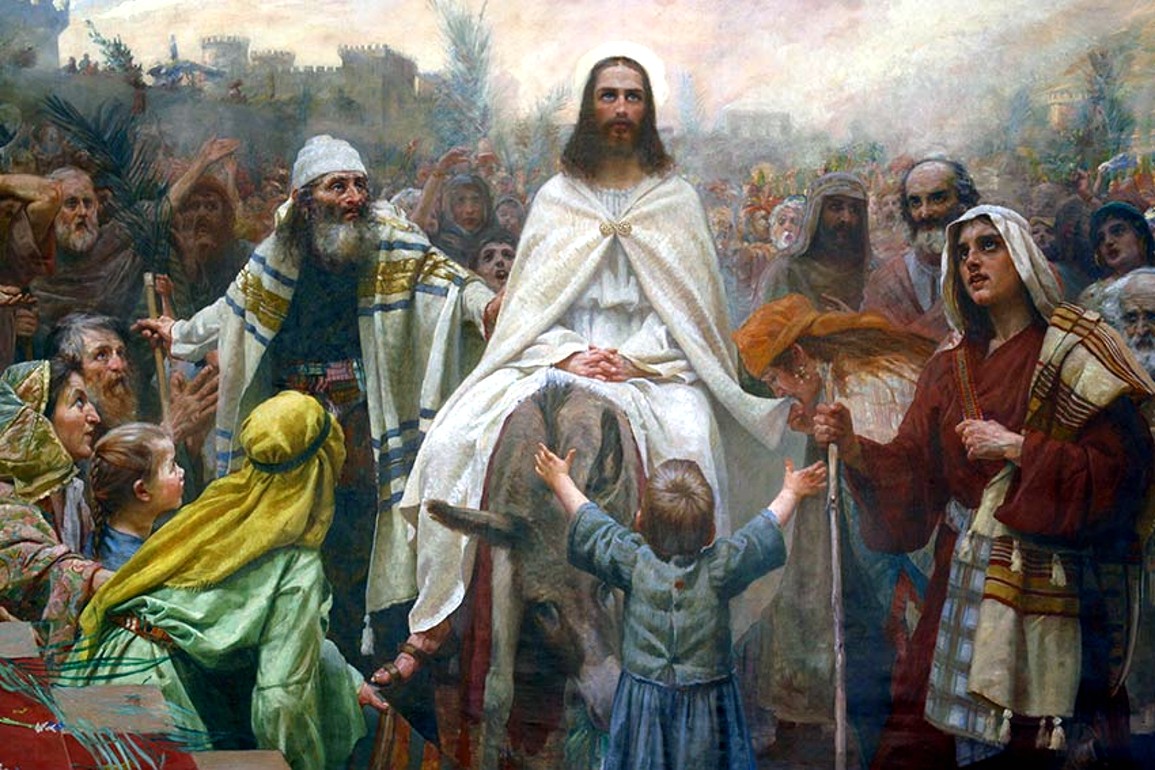
So they took branches of palm trees and went out to meet Him, crying, "Hosanna!
Blessed is he who comes in the name of the Lord, even the King of Israel!
And Jesus found a young ass and sat upon it; as it is written, "Fear not,
daughter of Zion; behold, your king is coming, sitting on the colt of an ass” (Jn 12:13-15).
The Palm Sunday procession is formed of Christians who, in the "fullness of faith," make their own the gesture of the Jews and endow it with its full significance. Following the Jews' example, we proclaim Christ as Victor: “Hosanna to the Son of David! Blessed is He who comes in the Name of the Lord.” But by our faith we know, as they did not, all that His triumph stands for. He is the Messiah, the Son of God. He is the sign of contradiction, acclaimed by some and reviled by others. Sent into this world to take us from sin and the power of Satan, He underwent His Passion, the punishment for our sins, but comes forth triumphant from the tomb, the victor over death, making our peace with God and taking us with Him into the kingdom of His Father in heaven. (For further reading go to: CatholicCulture.org.)
HOLY THURSDAY – THE BEGINNING OF THE HOLY TRIDUUM: Except for the celebration of the Easter Vigil, Holy Thursday is possibly one of the most important, complex, and profound days of celebration in the Catholic Church. Holy Thursday celebrates the institution of the Eucharist as the true Body and Blood of Jesus Christ and the institution of the Sacrament of the Priesthood. During the Last Supper, Jesus offers Himself as the Passover sacrifice, the sacrificial lamb, and teaches that every ordained priest is to follow the same sacrifice in the exact same way. Christ also bids farewell to His followers and prophesizes that one of them will betray Him and hand Him over to the Roman soldiers, and that one would deny Him three times.
During the night, after sundown—because Passover begins at sundown—the Holy Thursday Liturgy takes place, marking the end of Lent and the beginning of the Sacred "Triduum,” (three days) of Holy Week. These days are the three holiest days in the Catholic Church. This Mass stresses the importance Jesus puts on the humility of service, and the need for cleansing with water, a symbol of baptism. Also emphasized are the critical importance of the Eucharist and the sacrifice of Christ’s Body, which we now find present in the consecrated Host.
At the conclusion of the Mass, the faithful are invited to continue Adoration of the Blessed Sacrament, just as the disciples were invited to stay up with the Lord during His agony in the garden before His betrayal by Judas. After Holy Thursday, no Mass will be celebrated again in the Church until the Easter Vigil celebrates and proclaims the Resurrection of the Lord Jesus Christ.
GOOD FRIDAY: On Good Friday, the entire Church fixes her gaze on the Cross at Calvary. Each member of the Church tries to understand at what cost Christ has won our redemption. In the solemn ceremonies of Good Friday, in the Adoration of the Cross, in the chanting of the 'Reproaches', in the reading of the Passion, and in receiving the pre-consecrated Host, we unite ourselves to our Savior, and we contemplate our own death to sin in the Death of our Lord.
The Church--stripped of its ornaments, the altar bare, and with the door of the empty tabernacle standing open--is as if in mourning. In the fourth century the Apostolic Constitutions described this day as a "day of mourning, not a day of festive joy," and it was called the "Pasch (passage) of the Crucifixion." The liturgical observance of this day of Christ's suffering, crucifixion and death evidently has been in existence from the earliest days of the Church. No Mass is celebrated on this day, but the service of Good Friday is called the Mass of the Presanctified because Communion (in the species of bread), which had already been consecrated on Holy Thursday, is given to the people.
Traditionally, the organ is silent from Holy Thursday until the Alleluia at the Easter Vigil, as are all bells or other instruments, the only music during this period being unaccompanied chant. The omission of the prayer of consecration deepens our sense of loss because Mass throughout the year reminds us of the Lord's triumph over death, the source of our joy and blessing. The desolate quality of the rites of this day reminds us of Christ's humiliation and suffering during his Passion. We can see that the parts of the Good Friday service correspond to the divisions of Mass:
- Liturgy of the Word - reading of the Passion.
- Intercessory prayers for the Church and the entire world, Christian and non-Christian.
- Veneration of the Cross
- Communion, or the 'Mass of the Pre-Sanctified.'
HOLY SATURDAY: On Holy Saturday the Church waits at the Lord's tomb, meditating on his suffering and death. The altar is left bare, and the sacrifice of the Mass is not celebrated. Only after the solemn vigil during the night, held in anticipation of the resurrection, does the Easter celebration begin, with a spirit of joy that overflows into the following period of fifty days. The the Easter Vigil is the most beautiful liturgy in the Church—and the liturgy that marks the beginning of Easter. We are awaiting our Master's return with our lamps full and burning, so that He will find us awake and will seat us at His table The vigil is divided into four parts:
- Service of Light
- Liturgy of the Word
- Liturgy of Baptism
- Liturgy of the Eucharist
From its very beginnings, the Christian community placed the celebration of Baptism within the context of the Easter Vigil. On this night, catechumens will be baptized, and the congregation will renew their Baptismal promises.
(Published in the Bulletin of March 29, 2015)
By Saint Mary’s Press - Living in Christ Series
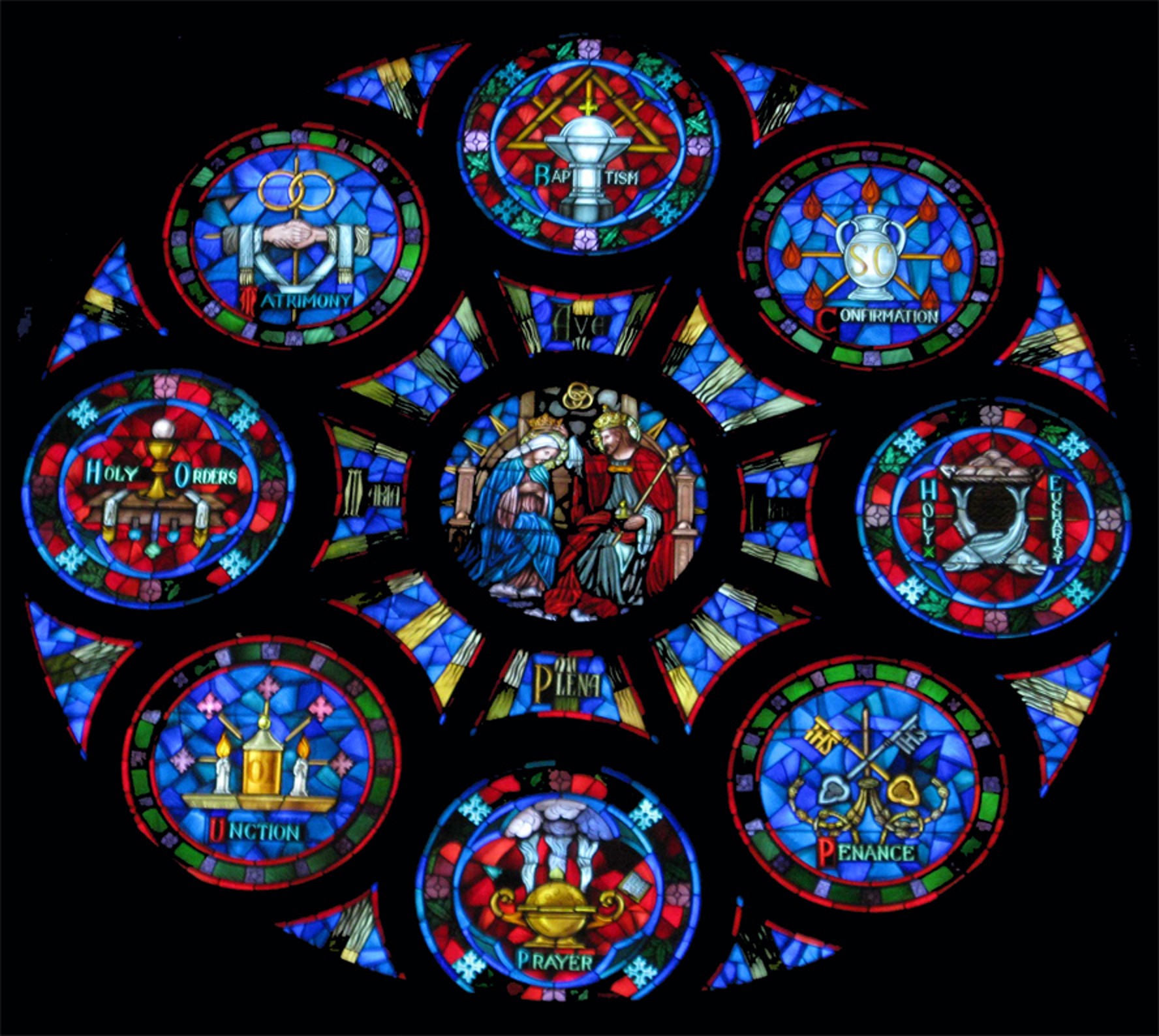
"How Do We Participate in the Paschal Mystery?" Individual Christians participate in the Paschal Mystery through their own sacrifices and through the sacramental life of the Church.
The Paschal Mystery is not just about our own salvation; it calls us to continue Christ’s mission, inviting other people to know God’s saving power.
Consider the Ascension, the final event in the Paschal Mystery definition. Christ’s Ascension marks the beginning of the mission of the Church. At His Ascension, Christ gives the Apostles their mission: “Go, therefore, and make disciples of all nations, baptizing them in the name of the Father, and of the Son, and of the Holy Spirit, teaching them to observe all that I have commanded you. And behold, I am with you always, until the end of the age” (Matthew 28:19–20). Soon after this, the Apostles receive the fullness of the Holy Spirit, empowering them for this mission.
Christ Himself set the foundation for uniting our sacrifices with His for the sake of our salvation and for the salvation of others. He instructs His disciples, “Whoever wishes to come after me must deny himself, take up his cross, and follow me. For whoever wishes to save his life will lose it, but whoever loses his life for my sake will find it” (Matthew 16:24–25). After we have been redeemed through our Baptism, we want to share the Gospel with others, even though doing so often requires some form of sacrifice. We might need to sacrifice comfort, popularity, or personal freedom. Or our sacrifice might be the pain of being rejected, misunderstood, or even tortured for speaking the truth and acting on it. The Church holds martyrs as exemplars of the Paschal Mystery because of the high price they paid in following Christ. We endure these sacrifices not on our own power, but by seeing them as extensions of Christ’s Passion. In prayer we consciously unite our sacrifices—even the suffering we do not choose, such as the suffering caused by illness or accidents—with Christ’s Passion and death.
There is a fine distinction to be made here. Taking up our cross does not mean that we earn our own salvation; that work is Christ’s alone. However, our willingness to endure suffering and even death to continue Christ’s mission earns us merit in the sight of God. We avoid egoism and give God His rightful glory by remembering that we can take up our cross only because God first reaches out to us and gives us the needed strength to do so. The sacramental life of the Church is the superlative source for experiencing God’s saving power and receiving the grace necessary to continue Christ’s mission. In the Sacrament of Baptism we are redeemed from our slavery to sin, and our original justice is restored. In the Sacrament of Confirmation we receive the fullness of the Holy Spirit to continue Christ’s saving mission. In the Sacrament of Penance and Reconciliation, we are again freed from slavery to sin when sin reenters our lives. In the Sacraments of Matrimony and Holy Orders, we receive the graces needed to continue Christ’s mission of salvation in family life or as an ordained minister of the Church. And in the Sacrament of Anointing of the Sick, we receive God’s healing power and the grace to unite our suffering with Christ’s Passion.
The Sacrament of the Eucharist has a special place in our participation in the Paschal Mystery. In the Eucharist we receive Christ’s Body and Blood, the same Body and Blood that was broken and poured out to redeem us. We receive the same Christ who was raised as the promise of our own eternal life with God. Our hearing of the Word of God and our reception of the Eucharist is both the sign and the reality of our full communion with God. The Eucharist makes Christ’s Paschal Sacrifice present to us, so that we truly and actively participate in its saving power.
(Published in the Bulletin of April 19, 2015)
By Ruben Beltran

"What is Catholic Education?" The Second Vatican Council’s Gravissimum Educationis
(Declaration on Christian Education) insists that “a true education
aims at the formation of the human person in the pursuit of his ultimate
end and of the good of the societies of which he is a member and in
whose obligations as an adult he will share.” The same document speaks
of helping young people “to develop harmoniously their physical, moral,
and intellectual endowments,” and it insists they get it.
The Vatican’s Congregation for Catholic Education defines a school as “a place of integral formation by means of a systematic and critical assimilation of culture.” Integral means all the pieces are there and they fit together. Formation means education concerns the kind of person one becomes, not just what one knows. In other words, it concerns intellectual and moral knowledge but also virtues—habits of acting for the true, the good, and the beautiful. Integral formation also includes spiritual formation. The integral formation of the human person, which is the purpose of education, includes the development of all the human faculties of the students, together with preparation for professional life, formation of ethical and social awareness, and religious education.”
In short, this document speaks of liberal education; that is, the education of the “free man,” the person who knows his mind and exercises virtue; someone who seeks the true, the good, and the beautiful in his own pursuit of happiness and in his contribution to that of others. The Church presupposes all of that when she speaks of Catholic or Christian education.
The proper function of Catholic education involves evangelization and discipleship training for life. As the "Declaration on Catholic Education" states: “A Christian education…has as its principal purpose this goal: that the baptized become ever more aware of the gift of faith they have received and that they learn how to worship God, especially in liturgical action, and be conformed in their personal lives. Also, that they develop in the fullness of Christ and strive for the growth of the Mystical Body; that they are aware of their calling and learn not only how to bear witness to the hope that is in them, but also how to help in the Christian formation of the world.”
Notice that the principal purpose of Catholic education is to form disciples—people who know and follow Christ and make Him known. Not excellence in education, as important as that is; not equipping students to have successful careers, however valuable that may be. But forming disciples. Do our students know Jesus, follow Him and share Him with others? In our zeal for academic excellence, do we obscure or minimize the evangelical purpose of our schools? How many leaders of Catholic schools can honestly say their institutions are principally about forming educated disciples? The “education part” of Catholic education must keep the “Catholic part” honest when it comes to the formation of the whole person, including the intellectual dimension. This helps Catholic education avoid becoming a glorified Bible study or apologetics program. When that happens, the “Catholic part” of Catholic education suffers, too. Vital dimensions of the student’s life are not fully developed in light of the Gospel because they’re not developed or adequately developed. The minds and wills God gave young people to exercise and grow are stunted.
But the “Catholic part” of Catholic education must keep the “education part” honest, too. Otherwise, Catholic schools may achieve academic excellence but at the expense of forming disciples. Ironically, such education is less than full academic excellence, for it has shaped the student without regard for his ultimate end—union with God. Catholic education must form the whole person according to intellectual, moral and physical excellence. But all of that must be ordered to the formation of genuine disciples of Jesus—people who know Him, love Him and serve Him.
That’s what makes Catholic Education Catholic.
(Published in the Bulletin of April 26, 2015)
WHAT IS THE CLASSICAL APPROACH TO EDUCATION?
“Creating the ability to think is our goal in a classical curriculum; we want our children to acquire the art of learning. It is not the number of facts they are acquainted with that measure the educational success, but what they are able to do with the facts: whether they are able to make distinctions, to follow an argument, to make reasonable deductions from the facts, and finally, to have the right judgment about the way things are.” — Laura Berquist (Designing Your Own Classical Curriculum)
A Classical Education:
· Teaches the Child How to Think
· Follows the Child's Natural Stages of Learning
· Takes Account of the Child's Individual Needs
· Supports the Spiritual Formation of the Child
· Allows the Parents to Play an Integral Role
A Classical Education Creates:
· Learners who have the knowledge and ability to perform independent research.
· Students who are effective Communicators
· Students who are able to read and comprehend diverse written materials.
· Students who demonstrate rhetorical and analytical skills in their written work.
· Students who express themselves with confidence in written communication.
· Students who are independent thinkers
· Students who are able to analyze information, and form and explain their own opinions
A classical education will give our children the beginning of the education every educated person in Western Civilization once received, a classical or liberal arts education. The idea is to educate the students so that they develops all the powers of their souls, and their minds are formed, strengthened, and developed. The end of this educational process is wisdom. Man desires by nature to know, and that means we want to have not only the facts, but the reasons for the facts. We want to think about the most noble things, the most interesting in themselves. Therefore, the goal of education is to teach children how to think; to help them learn the art of learning. If children learn how to learn, they will be to master any subject. Thinking can be done well or badly, but one can be taught to do it well. In large measure, the role of the teacher of grade and high school children is this: teaching children to think well. It begins in wonder and aims at wisdom.
The tools of learning, through which children learn the art of learning, are acquired by concentrating, at each stage of intellectual formation, on the areas of development that are appropriate to that stage in the child’s intellectual and spiritual development. Further, all we do will be faithful to the doctrine and teaching of the Catholic Church, which shall enlighten and inform all the areas of the curriculum.
(Published in the Bulletin of April 26, 2015)
By Michael Trueman

He was confronted by the religious leaders of the day, who knew divorce was wrong, though made legal in the Jewish and Roman societies. When asked if divorce was okay, our Lord responded: “Have you not read that the one who made them at the beginning ‘made them male and female,’ and said, ‘For this reason a man shall leave his father and mother and be joined to his wife, and the two shall become one flesh’? So they are no longer two, but one flesh. Therefore what God has joined together, let no one separate” (Mt 19:4b–6).
“The married couple forms ‘the intimate partnership of life and love established by the Creator and governed by his laws; it is rooted in the conjugal covenant, that is, in their irrevocable personal consent.’ Both give themselves definitively and totally to one another. They are no longer two; from now on they form one flesh. The covenant they freely contracted imposes on the spouses the obligation to preserve it as unique and indissoluble” (Catechism of the Catholic Church [“CCC”] 2364).
Jesus brought the discussion back to the origin of God’s creation of man and woman. God designed men and women for marriage, to be one flesh in sexual cooperation to bring about the wonder of children and the mutual self-giving of the spouses to each other for the entirety of their earthly lives together. You might say that Jesus was only teaching Christians—and that the Church’s consistent teaching through the centuries on the indissolubility of marriage is only for Christians—but this is not true. Jesus, in citing God’s creation of men and women, applied this teaching to all of humanity, regardless of religion or nationality.
The Church presumes, therefore, that all “first time for both” marriages—including the marriages of Catholics, other Christians, Jews, Muslims, Hindus, etc—create a covenant for the husband and wife’s entire life. Therefore, if you were married, chances are you are bound by a covenant of marriage with that person.
Marriage is an Indissoluble Covenant God’s teaching holds that marriage is a covenant that cannot be revoked or ended by human decision or human law. This is what we mean by marriage being indissoluble. When a man and woman enter marriage for the first time, the bond of marriage is presumed to endure until the death of one of the parties; but this presumption can be overturned, as will soon be explained.
The Vows Bring about a Marriage Establishing a covenant of marriage is relatively simple—a man and woman who are not already in a marriage covenant need only to exchange their consent (i.e., the wedding vows) publicly before witnesses. “The marriage consent is an act of the will which signifies and involves a mutual giving which unites the spouses between themselves and at the same time binds them to the children which they may eventually have, with whom they constitute one family, one single home, a ‘domestic Church’” (Blessed John Paul II, “Consent Makes Marriage, Its Defense by the Church,” 28 January 1982, no. 4, quoted in William H. Woestman (ed.), Papal Allocutions to the Roman Rota: 1939–1994 (Ottawa: Faculty of Canon Law, Saint Paul University, 1994), p. 172). There are, of course, several requirements to wed, such as proper age and not being forced into marriage, but the basic requirement is the exchanging of the wedding vows. With Catholics, however, there is one other essential requirement: the couple must express their vows before a priest or deacon of the Catholic Church.
Married “Outside the Church” You’ve heard it said, “I married outside the Church.” This means that a Catholic did not marry in front of a priest or deacon and two witnesses. The union may be recognized by the State government or even by a non-Catholic denomination or different religion, but it is not recognized as a marriage covenant by the Church. If the man and woman are in such a union, they may correct what was previously missing and exchange their consent before a priest or deacon and two witnesses. This is called a convalidation ceremony, which is in every way the wedding ceremony that all Catholics experience. However, if one or the other is in a marriage covenant, then he or she will need to be freed from that marriage covenant before being able to celebrate a marriage recognized by the Church through the convalidation ceremony.
Marriage, Separation, and Divorce … and Remarriage For someone in a marriage covenant who has separated and has obtained a civil divorce, there is no serious offense with their situation provided they live a life of chastity, respecting the covenant of marriage. For the divorced Catholic, this means he or she can continue in the practice of their Catholic faith by reception of the sacraments (except marriage), by taking on certain parish-based ministries, etc. However, someone in a marriage covenant who has separated, obtained a civil divorce, and has entered a new union (i.e., civil marriage) or is not living chastely is violating the covenant of his or her first marriage. This way of life is at odds with God’s design for him or her, and for the covenant of marriage. For Catholics in the new union, this means they must refrain from receiving the sacraments.
I am “Remarried” without an Annulment — What Do I Do? If the covenant of marriage is presumed to exist, the most common way to realize another marriage in the Church is to challenge the validity of the prior marriage or cite where and how divine law permits a prior bond of marriage to be dissolved. Only after it is declared that a prior marriage was invalidly established, or can be dissolved, can a person validly attempt to enter a new marriage.
Challenging the Validity of the First Marriage Covenant Formal Annulment. Since consent (i.e., the wedding vows) brings the marriage into existence, and consent is a human act, you can always make the claim that the consent that was given was defective—that there was a problem when either (or both) people approached the marriage. It can be argued that one or both parties (1) did not intend what must be intended regarding marriage (e.g., left no openness to children), or (2) did not understand the nature of marriage (e.g., honestly thought it was dissoluble), or (3) did not have the capacity to take on what was required of them in marriage (e.g., made the decision recklessly, without due regard for what would be required of them). These cases take about 12–18 months to complete.
Lack of Canonical Form. This only applies to Catholics (and Eastern Orthodox Christians). Catholics must marry before a priest or deacon. If they do not marry in this way, the law directs that these marriages are not valid due to a lack of canonical form. It is called “canonical form” because the formalities for the ceremony are spelled out in canon law. If you are a Catholic and married outside the Church, you can present a lack of form case. This process takes a few months to complete.
Proving an Impediment Existed. Sometimes, a simple and verifiable fact blocks a marriage from being validly established. The impediment must have been present at the moment of the wedding. One common example is what most dioceses call a Ligamen Case. These cases can be processed only when it is your former spouse who was previously married. Only the parties of a marriage have the right to challenge its validity, so using the rationale that a valid marriage creates a bond to the exclusion of all others, your former spouse’s first marriage impeded him or her from establishing a marriage with you. This process takes about a month or two to complete.
Seeking a Dissolution of the First Marriage Covenant
Pauline Privilege. If you and your former spouse were non-baptized people at the time of your wedding and at any time after the wedding you became baptized, you can seek the Pauline Privilege (cf. St. Paul’s 1 Cor 7:10–15) provided that your former spouse does not want baptism and that he or she does not want to restore common life and live peacefully with you. To seek this, you must want a new marriage since at the moment of the exchange of consent your first bond of marriage is dissolved. This process takes only one or two months to complete.
Privilege of the Faith (Petrine Privilege). If you or your former spouse were non-baptized people at the time of your marriage and at least one of you remained not baptized through your years together, you may seek the Petrine Privilege from the Holy Father. The Church has come to see that for the good of one’s Christian faith, as Vicar of Christ, the Pope can invoke Christ’s own divine power to dissolve a marriage that is not between two baptized people. To seek this privilege, you must want to marry, and this proposed relationship is considered in the application to ensure that, in fact, your Christian faith will benefit from the new union. This process takes about one year to complete.
Non-Consummated Marriage. If a couple, after their exchange of consent, do not at any point have sexual intercourse freely chosen and in the natural manner designed for the conception of children, then the marriage has not accomplished its fullness and can be dissolved by the Pope invoking Christ’s own divine power as his Vicar. While non-consummation is rare in our sex-charged society, it does happen. This process takes about a year to complete.
In all of these cases, contact your local parish or diocese, and you will be guided in the right direction.
Who Needs to be Freed from a Covenant of Marriage? Any person bound by a covenant of marriage who is in a second union or wants a second union needs to challenge the validity or seek a dissolution through the Pauline Privilege, Petrine Privilege, or Non-Consummation case. This applies, of course, to Catholics, but also to everyone else since Christ’s teaching is clear: “Therefore what God has joined together, let no one separate” (Mt 19:6b). Whenever a non-Catholic who is in a covenant of marriage wants to marry a Catholic who is free to marry, the non-Catholic first must be freed from his or her covenant of marriage.
Once Free to Marry After the Church determines the presumed covenant of marriage is not valid, or that the bond of marriage can be dissolved through Pauline Privilege, Petrine Privilege, or Non-Consummation, then a “new” marriage can be celebrated in and recognized by the Church.
The Church Understands and Cares The clergy and the laity who assist the clergy know that the times in which we live are hostile and ignorant toward the God-given and wonderful covenant of marriage. Most dioceses appropriate significant financial resources to operate marriage tribunals to help people be faithful to Christ’s teaching, and which may provide the possibility of being freed from a marriage covenant to realize a “new” marriage in the Church. The teaching of Christ, “Therefore what God has joined together, let no one separate,” is not an easy one to understand and follow—but pray to your heavenly Father that, on this path that might seem daunting and even impossible, you will have the grace to understand and the courage to follow. Christ’s Church will walk with you.
Mr. Michael Trueman, M.Div., J.C.L., currently serves as Chancellor of the Archdiocese of Detroit and adjunct part-time faculty for Sacred Heart Major Seminary, Detroit. He is the co-author of two question and answer books on church law (Surprised by Canon Law, Volumes 1 and 2,Servant Books, 2004, 2007).
From www.CatholicsComeHome.Org (Submitted and Edited by Denise McMaster-Holguin)
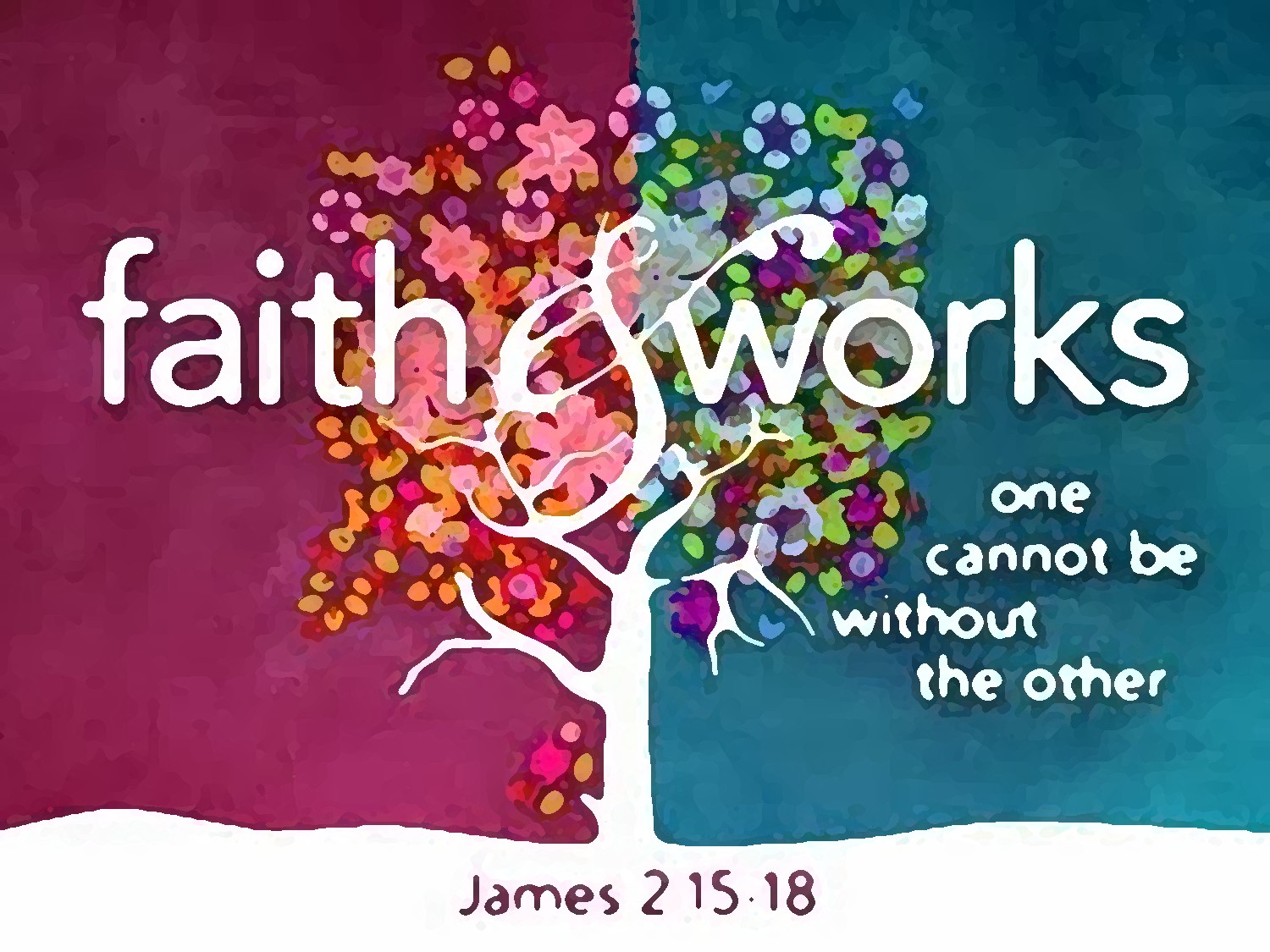
"Are We Saved Through Faith Alone?" Many Protestants believe we are saved by "faith alone" and they say Catholics believe they can “work” their way into Heaven. How do we answer them? First of all, ask them to show you where in the Catechism, the official teaching of the Catholic Church, does it teach that we can “work” our way into Heaven? They can’t, because it doesn’t. The Catholic Church does not now, nor has it ever, taught a doctrine of salvation by works…that we can “work” our way into Heaven.
Second, ask them to show you where in the Bible does it teach that we are saved by “faith alone.” They can’t, because it doesn’t. The only place in all of Scripture where the phrase “faith alone” appears is in James (James 2:24), where it says that we are NOT…justified (or saved) by faith alone. So, one of the two main pillars of Protestantism (the doctrine of salvation by faith alone) not only doesn’t appear in the Bible, but the Bible actually says the exact opposite: That we are NOT saved by faith alone.
Third, ask them that if works have nothing to do with our salvation, then how come every passage in the New Testament that talks about judgment says we will be judged by our works, not by whether or not we have faith alone? We see this in Romans 2, Matthew 15 and 16, 1 Peter, Revelations 20 and 22, 2 Corinthians 5, and many, many more verses.
Fourth, ask them that if we are saved by faith alone, why does 1 Corinthians 13:13 say that love is greater than faith? Shouldn’t it be the other way around?
As Catholics, we believe that we are saved by God’s grace alone. We can do nothing, apart from God’s grace, to receive the free gift of salvation. We also believe, however, that we have to RESPOND to God’s grace. Protestants believe that, too. However, many Protestants believe that the only response necessary is an act of faith; whereas, Catholics believe a response of faith and works is necessary or, as the Bible puts it in Galatians 5:6, “For in Christ Jesus neither circumcision nor uncircumcision has any value, but only faith working through love.”
(Published in the Bulletin of May 10, 2015)
By Ruben Beltran
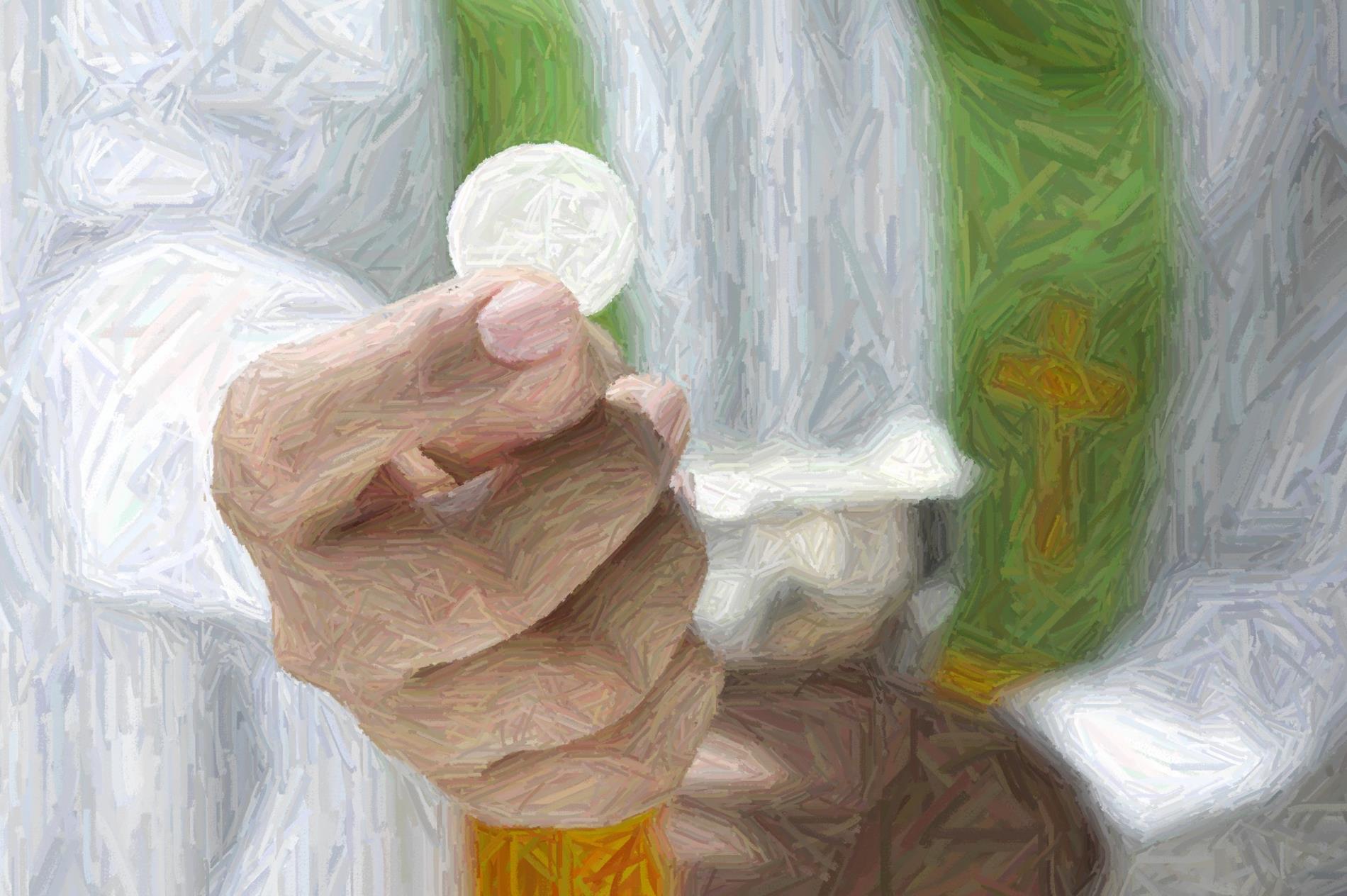
First, let us begin with a person’s spiritual state. The Catechism of the Catholic Church states in paragraph 1385: “To respond to this invitation, we must prepare ourselves for so great and so holy a moment. St. Paul urges us to examine our conscience: ‘Whoever, therefore, eats the bread or drinks the cup of the Lord in an unworthy manner will be guilty of profaning the Body and Blood of the Lord. Let a man examine himself, and so eat of the bread and drink of the cup. For anyone who eats and drinks without discerning the Body eats and drinks judgment upon himself.’” Anyone conscious of a grave sin must receive the sacrament of Reconciliation before coming to communion.
Also in Paragraph 1457 the Catechism states: “According to the Church’s command, ‘after having attained the age of discretion, each of the faithful is bound by an obligation to faithfully confess serious sins at least once a year.’ Anyone who is aware of having committed a mortal sin must not receive Holy Communion, even if he experiences deep contrition, without having first received sacramental absolution, unless he has a grave reason for receiving Communion and there is no possibility of going to confession.”
Let us now consider appropriate ways to physically receive our Lord. The U.S. Bishops determined that the faithful should bow before receiving Holy Communion as an act of reverence—preferably at the time the person immediately in front is receiving. The norm in the United States is that Holy Communion is to be received standing. However, if an individual person wishes to receive Communion while kneeling, it is perfectly licit for them to do so, and the priest should not hinder them unless there is good reason. The Congregation for Divine Worship and the Discipline of the Sacraments states: “Hence, any baptized Catholic who is not prevented by law must be admitted to Holy Communion. Therefore, it is not licit to deny Holy Communion to any of Christ’s faithful solely on the grounds, for example, that the person wishes to receive the Eucharist kneeling or standing.
Furthermore, to the question of whether it is more appropriate to receive on the tongue or in the hand, the Congregation for Divine Worship and the Discipline of the Sacraments goes on to say, “Although each of the faithful always has the right to receive Holy Communion on the tongue, at his choice, if any communicant should wish to receive the Sacrament in the hand, in areas where the Bishops’ Conference with the recognition of the Apostolic See has given permission, the sacred host is to be administered to him or her. However, special care should be taken to ensure that the host is consumed by the communicant in the presence of the minister, so that no one goes away carrying the Eucharistic species in his hand. If there is a risk of profanation, then Holy Communion should not be given in the hand to the faithful.”
Receiving in the hand is outside of the norm within the Roman Rite, but is allowed in the United States. Furthermore, the Precious Blood should be received standing only. It is important to note the Host MUST be consumed in the presence of the Minister. The document also states that it is illicit for the faithful to take the Host for themselves from the hands or chalice of the Minister. It is also illicit for spouses to give Communion to each other. Communion should be received individually and not as a couple or group. The Priest and when necessity calls for it, the extraordinary ministers, are the only ones allowed to distribute Holy Communion. For those who wish to receive in the hand, it would be wise to keep the words of St. Cyril of Jerusalem in mind: “Make your left hand like a throne to support your right hand in order to receive the Celestial King. Treat the consecrated Host with great care, ensuring that pieces do not fall on the ground, just as we would not let pieces of gold fall to the ground.”
(Published in the Bulletin of May 17, 2015)
By Father Paul Wickens (Handbook for Parents by Neumann Press)
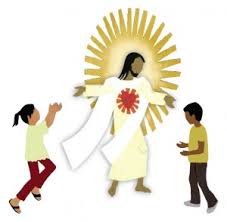
Yet, parents must do “everything” they can do to raise a child in the Faith and then trust that God will complete the work. I think there is a danger in thinking that a person is “done” at 18, that a child is “raised well” (or not) by then. After all, which of us is totally complete, finally the person God calls us to be even before we hit the second decade age mark? Moving towards God and towards Heaven takes an entire life’s work. In the early years, parents are critical in launching the child in this direction. Later on, the decision, responsibility, and privilege will be the child’s own. But it is a process, and we have to remember that. That being said, what should good parents know in order to raise their children well in the Faith? And what should parents do?
What Parents Should Know: Knowing several things will help Catholic parents navigate the exciting world of raising their children well. First, parents should know that the world, generally, will not support their efforts to raise their children in the Catholic faith. That’s not being negative. It’s stating a fact. Since the time Jesus walked the earth Christian beliefs and Christians themselves have been persecuted. We need to arm ourselves with a joyful demeanor and live the Christian live fully without expecting it to be easy or to be applauded. The world will frequently contradict our desires to be modest, chaste, kind, generous, patient, temperate, and holy. We must be all those things anyway. The world will tell us to pursue materialism, earthly goods, fame, power, and success. We must reject that and reach for higher goals—and teach our children to do the same. We have to expect to be revolutionaries, of sorts, radically living in peace, for Christ. And remember, revolutionaries don’t necessarily have support groups.
Yes, there may be pockets here and there of support, of like-minded people who are striving to raise their children the way that we are, and finding these folks will be blessed relief and consolation, like cold water is to a thirsty soul. Indeed, we should seek out like-minded parents to network and brainstorm with them, but we must not expect to rely on them in all cases, at all times. God alone will be our perfect strength as we seek to do His will in our families.
Second, parents should also know that children learn far more from example than from preaching or formal lessons. The best way we can raise good Catholic children is to be good Catholic people ourselves. Children learn temperance by seeing us model that. They learn kindness of speech by seeing that exemplified in us. They learn to love the Mass and Sacraments when we love the Mass and Sacraments and bring them with us to experience them. We don’t need to preach to children the importance of praying the Rosary, although sharing stories and the Church’s guidance in this regard is good. We need to give them little plastic rosaries when they are just toddlers and snuggle with them on our laps as we recite the mysteries and pray this prayer ourselves. Our Catholic faith must be totally and entirely integrated in our lives, both for our own good and so our children can absorb it.
Third, parents should know that perseverance is essential because suffering often comes with the territory of raising children. This can be difficult to understand when one is in the midst of it, especially at the beginning. We might initially address child-raising like we have other “projects”—by making a plan and giving it our best efforts. We expect immediate positive results because we have tried so hard and done our research. Yet, raising good Catholic children is not like any other “project”. It takes more time, more faith, more trust than anything else we have ever done. Sometimes situations arise in child-rearing that challenge us to the very core of ourselves and elicit suffering, sometimes great suffering. This is perfectly normal. You see, God molds us as we mold our children. These are “growing pains” of sorts. The growth toward holiness, in fact, should, be a family endeavor. If we stay close to Him, we have nothing to fear and are assured of “success” in His time and in His way.
One day when I was at Mass, I suddenly and surely felt that a distinct part of the vocation of mothers is to suffer for their children. I sincerely believe that when we unite our daily sufferings to those of Jesus on the cross, our suffering can be redemptive. Our children may be buoyed by our generosity and spirit of acceptance when they would otherwise be tempted to falter just by our offering our sufferings for them. The more children we have the more prayers we ought to be offering, and the more willing we ought to be to accept life’s little and big crosses for them. Our children’s eternal salvation may depend on it. I can’t help but think of good St. Monica who followed her selfish and sinful son to Rome, and then to Milan, literally hounding him with prayers. It is said that a bishop once said to a distraught Monica, “Surely a son of so many tears and prayers will not be lost.” And we all know the outcome of that story... St. Monica became a great saint, as did her son St. Augustine, who was also named a Doctor of the Church. We would all do well to emulate the example of St. Monica and be relentless prayer warriors for our children.
What Parents Should Do: There is no formula for raising good Catholic children into good Catholic adults, but we can utilize a strategy that has helped many parents and families. These 7 “R”s can help you in your parenting journey.
Receive the sacraments soon and frequently. This cannot be emphasized enough. Baptize babies immediately. It is most important that a child receives their baptism as soon as possible after birth. Make a family confession date every month. Some families like to go out for ice cream afterwards or another little treat. The sacrament of confession is critical for the spiritual growth of everyone. We wouldn’t dream of going months without showering, which cleanses our bodies, so why should we consider going more than a month without Confession, which cleanses our souls? Last, we should take our children to Mass every Sunday and Holy days of obligation. If your children are not in a Catholic school, enroll them in your parish’s Religious education program. Attend form kindergarten all the way through high school Confirmation. Don’t be Sacramental Catholics who come around only when it’s time to fulfill a Sacrament. As they grow older, puts sports and coaches second rather than first before the third commandment. If you don’t joyfully value and practice the Mass and sacraments, neither will your children who are watching you.
Read to your child.Start with simple toddler bible stories when they are small, then move on to other Catholic board books and short stories which teach the Faith in simple terms. Incorporate these into evening story time. As your child grows older, add the “real” bible, the catechism, enriching words from all sources. Take the time to teach your children simple apologetics. The complexity of the apologetics books chosen can grow with your child’s age and wisdom. Snuggling on the sofa with a good book and your child can be bonding like few things are, and will help your child grow in Faith if you choose the right reading.
Remember to pray - often - and together as a family. Teach them to talk to God regularly and teach them their prayers. Pray in the morning, the evening, at meals (even in public), when there’s trouble and when there is rejoicing. Teach them to talk to God often!
Remain steadfast. Endure and trust in Him.
Rely on God’s good graces. Trust Him.
Rejoice Be thankful. Enjoy each moment, each stage and yes, each challenge. As we strive to raise our children well we will see personal growth too. God is so good.
Relax Give yourself a break when you need one, and find ways to spiritually re-charge. Attend a bible study at your parish alone, take time for personal prayer, or meet a like-minded friend for lunch and exchange of ideas. Try hard but don’t expect perfection right off the bat. If you falter, forgive yourself and get up and try again. Remember a fool sits enjoying a mud puddle, but an equal fool may recognize his situation yet sits and laments his fate in the puddle without trying to get out. A wise person recognizes when she is deep “in the mud”, gets up, wipes herself off (Confession) and tries again, careful to avoid the puddle the next time. An eighth “R” might also be to recognize that “success” is not measured by external cues alone. God works in mysterious ways in the deep recesses of the human soul. He is working on our children as He is working on us. Trust Him.
A Ninth “R” – an addition by Rhonda Storey:
Review Be involved in their lives. Know where they are going, what they are watching and who their friends are. Stay involved in all aspects of their lives. Don’t let the TV, phones, iPads, lap tops etc. be their babysitters. As they become teens keep a close eye on their computer sites and phone apps. Talk with them about media topics and keep a constant open dialog with your kids. Talk about bullying and being a vigilant Christian. They will talk with you if you LISTEN. You are the first and most important teachers of YOUR children.
(Published in the Bulletins of May 24 and May 31, 2015)
By Ruben Beltran
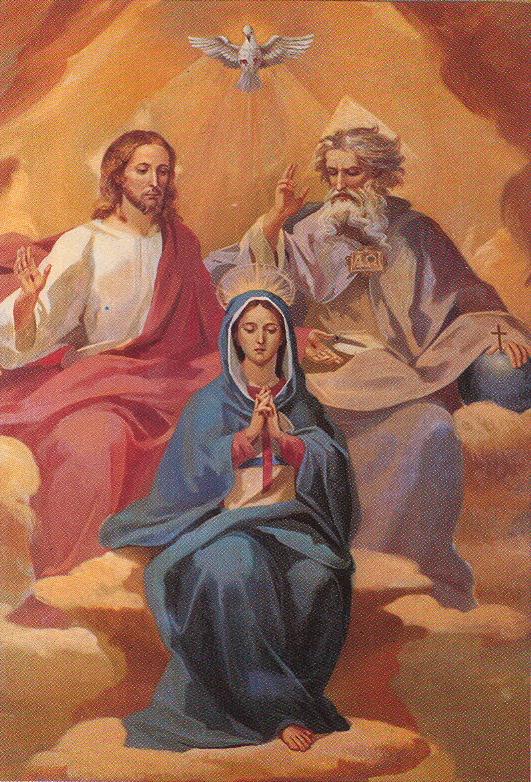
“How Do We Know We Are Part of God's Family?” When we think about God we usually think of Him as Creator, Redeemer, or Sanctifier, but these words describe what God does in time and not who He is. Creation had a beginning, redemption was for creation, and God sanctifies that which He creates. Creation is not eternal but God is, so who is God from all eternity? St. Pope John Paul ll once said: “God in His deepest mystery is not a solitude, but a family, since He has in Himself Fatherhood, Sonship and the essence of the family, which is love.”
God is Father because He is eternally fathering the Son, and that interpersonal love between the Father and the Son is the Holy Spirit. Notice in the above quote that St. Pope John Paul ll did not say God is like a family but that He is a family. Every earthly family is an icon of the Most Holy Trinity. The Father gives His love to the Son, the Son receives that love, and then returns it to the Father, and that interpersonal love is the Holy Spirit. In the same way, the husband gives his love to his wife, the wife then receives that love, and then returns it to her husband, and that love between them creates a third person. The two become one and in so doing become three in one. But how do we know God is our Father and how do we know we are part of His family? Dr. Scott Hahn gives a great explanation:
“First, we live in His house. As members of the Catholic Church, we live in the house which Christ promised to build—as a wise man does—upon the rock (cf. Mt. 16:17–19; 7:24–27). ‘Christ was faithful over God’s house as a son. And we are His house if we hold fast our confidence and pride in hope’ (Heb. 3:6). So then you are no longer strangers and sojourners, but you are fellow citizens with the saints and members of the household of God, built upon the foundation of the apostles and prophets, Christ Jesus Himself being the cornerstone (Eph. 2:19–20).
“Second, we are called by His name. In Baptism, we are marked for life in the name of the Father, the Son, and the Holy Spirit (Mt. 28:18–20). We ‘were sealed with the promised Holy Spirit, who is the guarantee of our inheritance until we acquire possession of it’ (Eph. 1:13–14). Our family unity is thus based upon the unity of the Spirit in the bond of peace. There is one body and one Spirit, just as you were called to the one hope that belongs to your call, one Lord, one faith, one baptism, one God and Father of us all (Eph. 4:3–6).
“Third, we sit at His table. We ‘partake of the table of the Lord’ (1 Cor. 10:21)—as God’s children—in the Eucharist, which Jesus instituted in the presence of His disciples ‘as they were at table eating’ (Mk. 14:18).
“Fourth, we share His Flesh and Blood. In Holy Communion, we come to share in Christ’s Flesh and Blood, according to His command: ‘Truly, truly I say to you, unless you eat the Flesh of the Son of Man and drink His Blood, you have no life in you; he who eats my Flesh and drinks my Blood has eternal life, and I will raise him up at the last day. For my Flesh is food indeed, and my Blood is drink indeed. He who eats my Flesh and drinks my Blood abides in me, and I in him’ (Jn. 6:53–56).
“Fifth, His bride is our mother. The Church is Christ’s bride, the heavenly Jerusalem (cf. Eph. 5:21–32; Rev. 21:1–10, 22–23), and also our mother. ‘But the Jerusalem above is free, and she is our mother’ (Gal. 4:26). Even more, Jesus gave us His mother, the Virgin Mary, to be our mother: When Jesus saw his mother, and the disciple whom he loved standing near, he said to his mother, ‘Woman, behold, your son!’ Then he said to the disciple, ‘Behold, your mother!’ And from that hour the disciple took her to his own home (Jn. 19:26–27).
“Sixth, we celebrate as a family. We gather together as the children of God to celebrate, most especially in the Eucharistic banquet: ‘Christ, our paschal lamb, has been sacrificed. Let us, therefore, celebrate the festival’ (1 Cor. 5:7–8). For this reason, God calls us to ‘be filled with the Spirit, addressing one another in psalms and hymns and spiritual songs, singing and making melody to the Lord with all your heart’ (Eph. 5:18–19). As Catholics, we celebrate different feast days to honor our Blessed Mother and our spiritual brothers and sisters, the saints—not only for their holy lives, but also their glorious deaths, which marked their own joyous homecoming.
“Seventh,
we receive instruction and discipline from Him. Our Heavenly Father
even uses our labors and sufferings to instruct and discipline us. ‘My
son, do not regard lightly the discipline of the Lord, nor lose courage
when you are punished by Him. For the Lord disciplines him whom he
loves, and chastises every son whom He receives. It is for discipline
that you have to endure. God is treating you as sons; for what son is
there whom his father does not discipline? …for they disciplined us for a
short time at their pleasure, but He disciplines us for our good, that
we may share His holiness’ (Heb. 12:5–7, 10).
“In
sum, Our Heavenly Father has given to us rock-solid grounds for
assurance, more than any earthly father has ever provided. And so we can
exclaim: ‘See what love the Father has given us, that we should be
called children of God; and so we are’ (1 Jn. 3:1). Not only can we know
that we are God’s children, but we can be confident that our omnipotent
Father will get us home safely: ‘I am sure that he who began a good
work in you will bring it to completion at the day of Jesus Christ’
(Phil. 1:6).”
One of the reasons why the family has always been under attack is because it is an icon of the Trinity. This is precisely why the Church is a great defender of the family. If you destroy the family, you destroy the best understanding we have of God.
(Published in the Bulletin of June 14, 2015)
By Scott P. Richert (Catholic Apologist and Author)
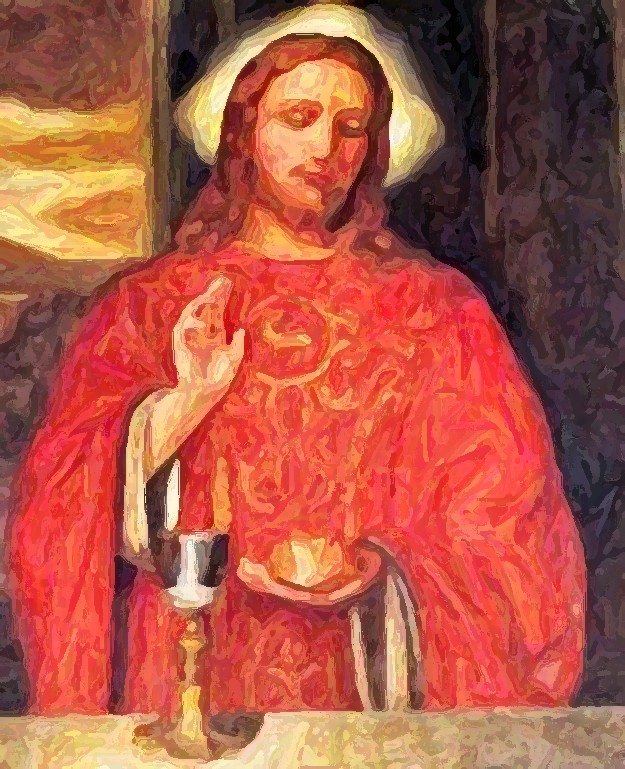
“Why Can't Women Be Ordained as Catholic Priests?" Among the most vocal controversies in the Catholic Church has been the question of the ordination of women. As more Protestant denominations have begun ordaining women, the Catholic Church's teaching on the all-male priesthood has come under attack, with some claiming that the ordination of women is simply a matter of justice, and the lack of such ordination is proof that the Catholic Church does not value women. The Church's teaching on this matter, however, is doctrine and thus cannot change. So . . . why can't women be priests?
At
the most basic level, the answer to the question is simple: The New
Testament priesthood is the priesthood of Christ Himself. All men who,
through the Sacrament of Holy Orders, have become priests or bishops
participate in Christ's priesthood in a very special way: They act in
persona Christi Capitis,
in the person of Christ, the Head of His Body, the Church. Christ, of
course, was a man; but some who argue for the ordination of women insist
that His sex is irrelevant, that a woman can act in the person of
Christ as well as a man can. This is a misunderstanding of Catholic
teaching on the differences between men and women, which the Church
insists are irreducible; men and women, by their natures, are suited to
different, yet complementary, roles and functions. Yet even if we
disregard the differences between the sexes, as many advocates of
women's ordination do, we have to face the fact that the ordination of
men is an unbroken tradition that goes back not only to the Apostles but
to Christ Himself.
As
the Catechism of the Catholic Church (Para. 1577) states: "Only a
baptized man validly receives sacred ordination." The Lord Jesus chose
men to form the college of the twelve apostles, and the apostles did the
same when they chose collaborators to succeed them in their ministry.
The college of bishops, with whom the priests are united in the
priesthood, makes the college of the twelve an ever-present and
ever-active reality until Christ's return. The Church recognizes herself
to be bound by this choice made by the Lord Himself. For this reason
the ordination of women is not possible. Still, the argument continues,
some traditions are made to be broken. But again, that misunderstands
the nature of the priesthood. Ordination does not simply give a man
permission to perform the functions of a priest; it imparts to him an
indelible (permanent) spiritual character that makes him a priest, and
since Christ and His Apostles chose only men to be priests, only men can
validly become priests.
In
other words, it's not simply that the Catholic Church does not allow
women to be ordained. If a validly-ordained bishop were to perform the
rite of the Sacrament of Holy Orders exactly, but the person supposedly
being ordained were a woman rather than a man, the woman would no more
be a priest at the end of the rite than she was before it began. The
bishop's action in attempting the ordination of a woman would be both
illicit (against the laws and regulations of the Church) and invalid
(ineffective, and hence null and void).
In his Apostolic Letter Ordinatio sacerdotalis (1994), St. Pope John Paul II declared that “the
Church has no authority whatsoever to confer priestly ordination on
women and that this judgment is to be definitively held by all the
Church's faithful.” This definitive
statement leaves no “wiggle room” for those who would like to continue
debating the question. As the Congregation for the Doctrine of the Faith
made clear in 1995, the statement that, “the
Church has no authority to ordain women as priests,” is not merely a
matter of Church discipline (which can be changed), but belongs to the deposit of faith (which cannot be changed).
The movement for women's ordination in the Catholic Church, therefore, will never get anywhere. Other Christian denominations, to justify ordaining women, have had to change their understanding of the nature of the priesthood from one which conveys an indelible spiritual character on the man who is ordained to one in which the priesthood is treated as a mere function. But to abandon the 2,000-year-old understanding of the nature of the priesthood would be a doctrinal change. The Catholic Church cannot change doctrine and remain Christ’s true Church.
Published in the Bulletin of June 21, 2015) - See Article No. 52 for another article on this subject
By Cailin Bootsma (Consultant to the VIRTUS Programs)
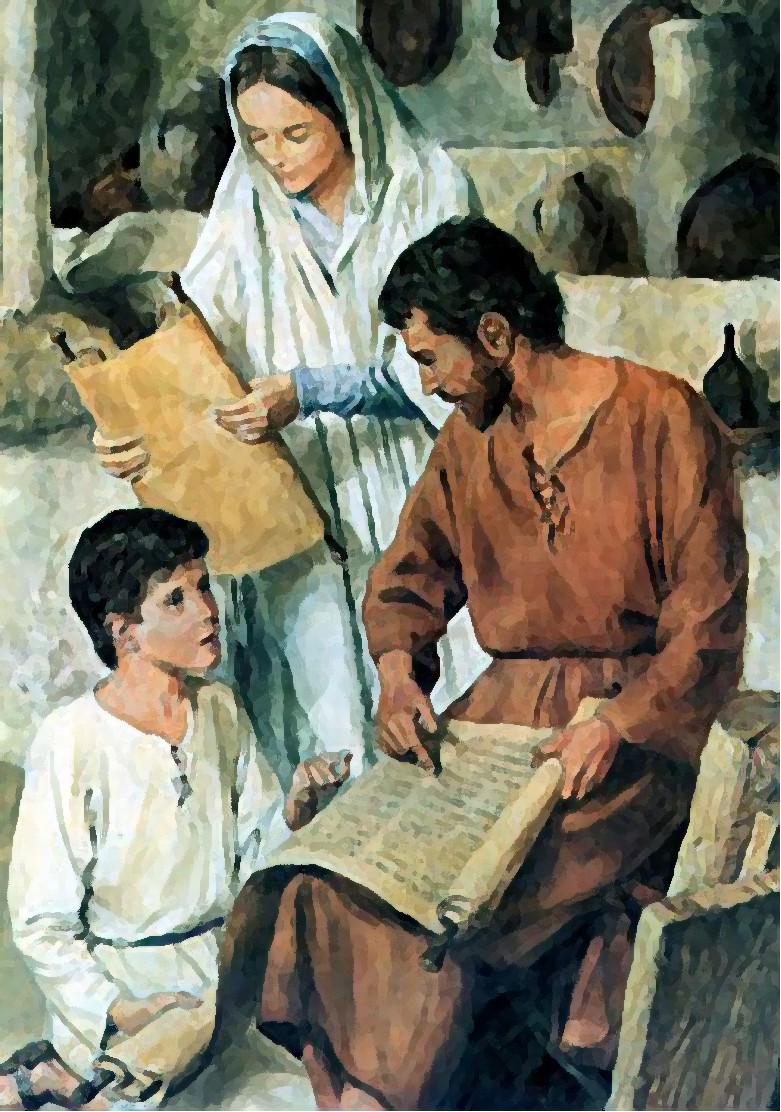
Of
course, the first example we have of this is the Holy Family, wherein
both Mary and Joseph are now with their Son in Heaven. Their willingness
to follow God wherever He called them—from Bethlehem to Egypt and,
ultimately, to Calvary—is a witness to the faith to which we are all
called. Whether as parents or as adults who work with or minister to
children, the Holy Family are our primary example of the holiness that
can be fostered within family life.
St.
John Paul II, in his timeless encyclical “Familiaris Consortio,”
emphasizes the pivotal role of the family in introducing children to
God. He writes that not only is the family designed to bring a child
into a human community but “by means of the rebirth of baptism and
education in the faith the child is also introduced into God's family,
which is the Church” (No. 15).
Throughout
Church history, there are examples of families who supported one
another in this pursuit of holiness. Not only through the Holy Family,
but also by choosing two sets of brothers to be His apostles, Christ
shows us that sanctity can be nurtured by family life. When Jesus walked
along the Sea of Galilee and called James and John, Simon (later Peter)
and Andrew, to be “fishers of men,” they immediately dropped their nets
and followed Christ. One wonders how these two pairs of brothers were
raised so that they were so ready to respond to Christ’s call.
Parents
who dedicated themselves to raising their children in the faith are
also among the saints. Famously, St. Monica dedicated her adult life to
praying for her wayward son’s conversion (he did, in fact, return to the
faith and later St. Augustine became a Doctor of the Church!). St.
Therese’s parents, Louis and Zelie Martin, will become saints this
October, the first married couple to be canonized together. They raised
five daughters (including St. Therese), all of whom became religious
sisters.
And
who could forget St. Benedict and St. Scholastica? The siblings were
very close to one another, but still dedicated their lives to God by
entering religious life. They maintained their relationship and were a
great support to one another and were even more closely united because
they both recognized God as their Father.
Not every child is fortunate enough to be raised in a household that values the Faith. However, as educators of children, we have the opportunity to instill in children a deep appreciation of the gift that God has given us in the family. Perhaps a child filled with faith will influence their parents to return to a relationship with God. Hopefully, many of these children will one day start families and recognize the importance of transmitting the faith to their own children.
(Published in the Bulletin of June 28, 2015)
Excerpted from the Website of the Oblates of St. Thomas Aquinas Center of Apologetics
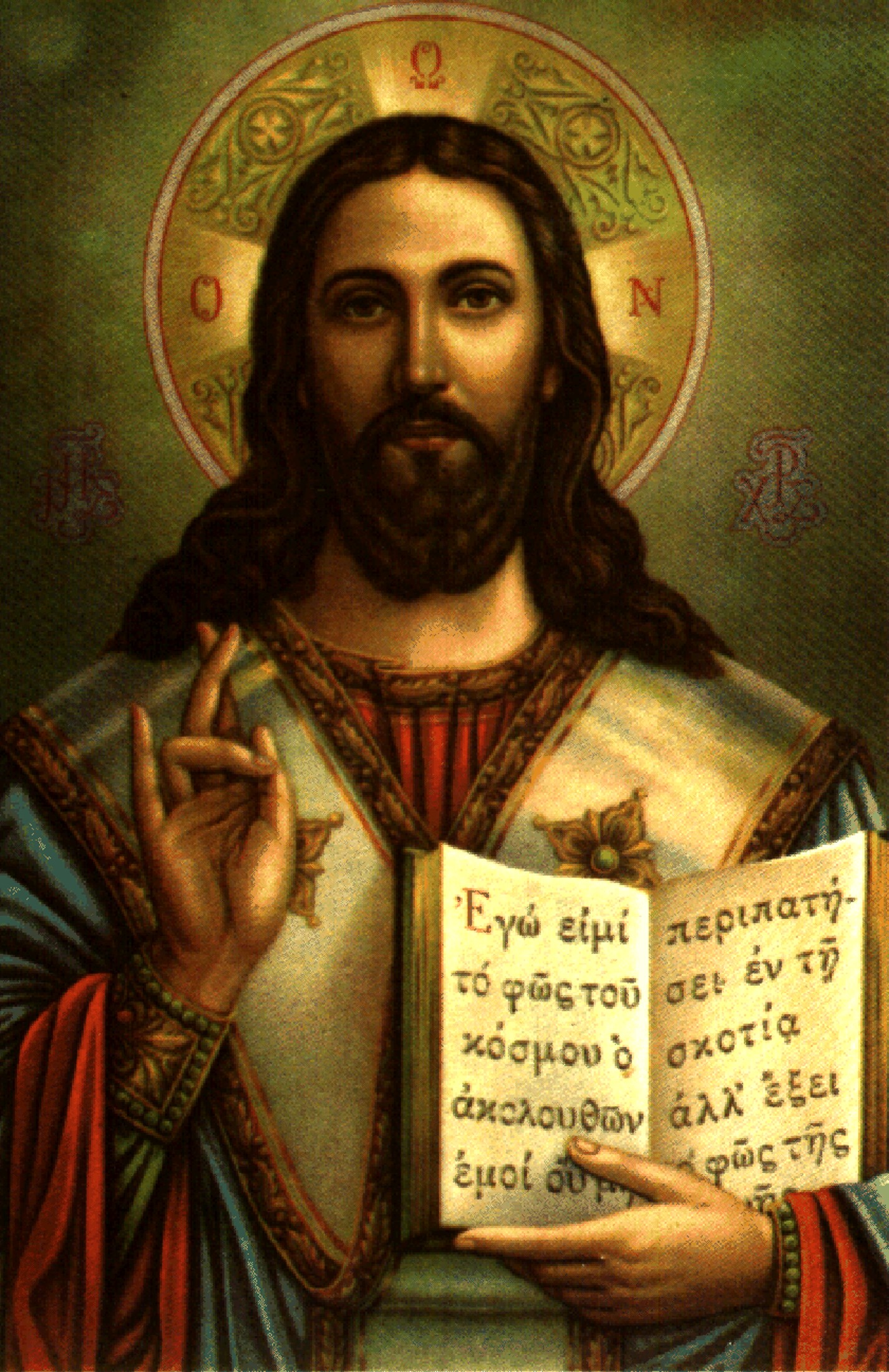
"What Is More Important: Sacred Scripture or Sacred Tradition?" The Catholic Church holds onto both Sacred Tradition and Sacred Scripture. However, these two fundamental Pillars of the Church are not an either/or distinction. Protestants claim the Bible is the only rule of faith, meaning that they believe it contains all of the material one needs for theology and that this material is sufficiently clear that one does not need apostolic tradition or the Church’s Magisterium (teaching authority) to help one understand it. In the Protestant view, the whole of Christian truth is found within the Bible’s pages. Anything extraneous to the Bible is simply non-authoritative, unnecessary, or wrong—and may well hinder one in coming to God.
However, the Catholic Church recognizes that the Bible does not endorse this view and that, in fact, it is repudiated in Scripture. The true "rule of faith"—as expressed in the Bible itself—is Scripture plus Apostolic Tradition, as manifested in the living teaching authority of the Catholic Church, to which were entrusted the oral teachings of Jesus and the apostles, along with the authority to interpret Scripture correctly. The Church has always held onto bothTradition and Scripture. In the Second Vatican Council’s document on divine revelation, Dei Verbum ("The Word of God"), the relationship between Tradition and Scripture is explained: "Hence there exists a close connection and communication between sacred Tradition and sacred Scripture. For both of them, flowing from the same divine wellspring, in a certain way merge into a unity and tend toward the same end. For sacred Scripture is the word of God inasmuch as it is consigned to writing under the inspiration of the divine Spirit. To the successors of the apostles, sacred Tradition hands on in its full purity God’s word, which was entrusted to the apostles by Christ the Lord and the Holy Spirit.”
In St. John’s Gospel (20:30), we are told that the Bible was composed so we can be helped to believe Jesus is the Messiah. It does not say the Bible is all we need for salvation, much less that the Bible is all we need for theology; nor does it say the Bible is even necessary to believe in Christ. After all, the earliest Christians had no New Testament to which they could appeal; they learned from oral, rather than written, instruction. Until relatively recent times, the Bible was inaccessible to most people, either because they could not read or because the printing press had not been invented. All these people learned from oral instruction, passed down, generation to generation, by the Church. Tradition determines what books are part of the Bible. The Bible itself is a Tradition, and the books that are in our Bible today have been passed down from our Catholic Tradition (the Holy Spirit guided the Bishops in this process).
Nowhere in the Bible does it tell us which books should be in or out. St. Paul himself required the aid of Tradition (2 Thess. 2:15). Some of the Catholic epistles were not written even when Paul wrote his letters to Timothy, and none of the books of the New Testament had been placed on the canon of the Scripture books. Thus, by the light of the Spirit of truth, the Church preserves this Word of God faithfully, explains it, and makes it more widely known. Consequently, it is not from sacred Scripture alone that the Church draws her certainty about everything which has been revealed. Both sacred Tradition and sacred Scripture are to be accepted and venerated with the same devotion and reverence. There is not one without the other.
Published in the Bulletin of July 5, 2015
By Peter Kreeft, Catholic Apologist

We have time and prayer backwards. We think time determines prayer, but prayer determines time. We think our lack of time is the cause of our lack of prayer, but our lack of prayer is the cause of our lack of time. When a little boy offered Christ five loaves and two fishes, He multiplied them miraculously. He does the same with our time, but only if we offer it to Him in prayer. This is literally miraculous, yet I know it happens from repeated experience. Every day that I say I am too busy to pray, I seem to have no time, accomplish little, and feel frazzled and enslaved by time. Every day that I say I'm too busy not to pray, every time I offer some time-loaves and life-fishes to Christ, He miraculously multiplies them and I share His conquest of time. I have no idea how He does it, but I know that He does it--time after time.
And yet I resist sacrificing my loaves and fishes to Him. I am an idiot. That's one of the things original sin means: spiritual insanity, preferring misery to joy, little bits of hell to little bits of heaven. We must restore our spiritual sanity. One giant step in that direction is to think truly about time. Time is like the setting of a play. The setting is really part of the play, contained by the play, determined by the play. But we often think the opposite: we think the play is contained by the setting. We think that the theme, the meaning, the spirit of the play is in its material setting instead of the other way around. That's like thinking the soul is in the body. In fact, the body is in the soul. And since time measures the movements of material bodies, while prayer measures the movements of the soul, time is really in prayer rather than prayer in time. Prayer determines and changes and miraculously multiplies time (the loaves and fishes).
But prayer multiplies time only if and when we sacrifice our time, offer it up. There's the rub. We fear sacrifice. It's a kind of death. All the real religions of the world are based on sacrifice, on willing death. Only the fake religion of pop psychology (which has infiltrated even the modern Church) ignores this fact. Even pagans and polytheists know it. The most popular god in India is Shiva, the Destroyer, and the most popular goddess is Kali, his female equivalent. Even Hindus know the importance of spiritual surgery, death, and sacrifice. After Calvary, how can Christians know this any less? Our Lord repeatedly taught us that unless we took up our cross and followed Him, we could not be His disciples.
This probably means some terrible and difficult things; but one of the simple and easy things it means is to sacrifice our time to God. For time is life—"life-time." The point is very simple: in order to create time to pray, we must destroy time to do something else. We must kill something, refuse something, say no to something. To what? Let me make a simple, obvious, radical suggestion: the TV. Kill the TV. Go cold turkey for a month. I dare you. If you can't do that, then TV is your drug and you're an addict. "A man is a slave to whatever he cannot part with that is less than himself," said George MacDonald.
Every single person and family I know who has done this (voluntarily) has been very happy about it. TV is largely a sewer pipe anyway; why fill your brain and your soul with the waste products from the most bigotedly antireligious elite in our society? Even if there were nothing to sacrifice TV for, it would be good to sacrifice it, to save your moral sanity and intelligence. All the more reason to sacrifice it for prayer. Find out how many hours a week you watch TV and use just half of that time for prayer. You get a threefold benefit: garbage cleanup, prayer time, and extra time left over.
The alternative is the mental slavery we see around us, the juggernaut—the worrying and rushing and never getting there because "there" is not in time at all but in eternity. The modern world is unhappy because it does not touch eternity. All true happiness is a foretaste of eternity. Eternity is not in the future but in the present. The future is unreal, not yet real. One of the devil's most ridiculous and successful lies is the idea that we should devote our lives to pursuing and acquiring goods we do not yet have rather than enjoying the ones we do have. This makes us slaves to time, to the unreal future, forever, for "tomorrow is always a day away." The first rule for prayer, the most important first step, is not about how to do it, but to just do it; not to perfect and complete it but to begin it. Once the car is moving, it's easy to steer it in the right direction, but it's much harder to start it up when it's stalled. And prayer is stalled in our world.
So stop reading and start praying. Right now.
Published in the Bulletin of July 12, 2015
By Fr. Philip Sullivan, O.C.D., Pastor

Vacation is defined as "freedom from obligations, leisure, and release." Vacation is sometimes called a holiday (holy day). Holy in Hebrew is "kiddushin," literally, "set apart". When we go on vacation, do we pack the Commandments or leave them at home on the dresser? Do we plan for Mass in our itineraries? Or do we sometimes feel like we need a ''vacation from God” and think that finding a church is a hassle? Here’s a different question: Did Jesus ever go on a vacation? Mary and Joseph annually took the Child to Jerusalem to celebrate the Passover in the Great Temple. This was a costly journey for this working-class family. Nazareth to Jerusalem was about a five-day walk over ninety miles of rough country. The sun would beat down on the caravan by day and the nights would be unpredictable. They would visit relatives, see new sites, shop in a busy market place with countless vendors, and, of course, visit the Temple, all while enjoying the culture, the music, the food, and whatever else this holy and massive city offered.
But vacations are supposed to be FUN! Some may argue that, while they do not go to Mass all the time, they do worship God at home in their own personal way. Great! Praying at home is great! But that does not satisfy the Commandment. Ask yourself the question, “If such worship was not kosher for Christ, how can it be acceptable for any of us today?” Padre Pio once said, "If we understood the Eucharist, we would risk our lives to get to Mass.”
Why bother going to Mass? We’re on vacation! Some intellectuals say, "If the homilies were better, I would go to Mass." The teens tell me all the time, “Mass is boring.” Why are teens so quick to say Mass is boring? What are their expectations? Constant entertainment? My response to that is if you want a good laugh listen to Obama sing "Amazing Grace." We come to Mass to worship God because it is our duty and salvation. Can you imagine the number of dull sermons Jesus of Nazareth must have heard over thirty-three years? Or the conversations He had with His parents after a day at the synagogue? Yet, He faithfully kept HOLY the Sabbath day.
"I don't go to church because there are so many hypocrites there." Do you really think there were no such hypocrites around during the days of Jesus' public worship? He openly challenged hypocrites to change. The Church is not a museum of saints but rather a hospital for the sick…and since I have become a priest, I feel like I am constantly in the emergency room! And I love it! I love being a priest!
Boring homilies and hypocrites notwithstanding, the Nazarene was obliged to keep Holy the Sabbath day. Since Christ tithed, went to synagogue, honored and respected His parents, and of course kept all the Father’s commandments, so, of course, should you and I. Furthermore, the Scriptures tell us that Jesus invested much of His time in private prayer as well. It was a given that every Jewish family would have a schedule of daily private prayer. This would be particularly true at meals. As the Last Supper indicates, Jesus continued this custom to the end.
Yet, He put aside quality time for private prayer--not the few minutes left at the end of the day or the desperate prayer of “faith” when we lose our keys so we are not late for the movies. Luke’s Gospel tells us, "Crowds pressed on Him. But He retired to a mountain and prayed." In Mark we read, "In the morning, He got up, left the house, and went off to a lonely place, and prayed there." Ralph Stockman, in Cor ad Cor Loquitor [Heart Speaks to Heart], says, "To pray is to expose the shore of the mind to the incoming tide of God."
One must thereby conclude that Jesus considered prayer a necessity. The Scriptures warn us that the servant is not greater than the master and the pupil not greater than the teacher. Jesus gives us yet another example of right living and a right relationship with God. Why then do we assign prayer to the fringes of our busy lives? And why are our lives so busy? What are we doing that is so important? And is what we are doing more important than keeping God’s Commandments? Vacations are good and sometimes necessary, but no matter how hard we try, we can never, ever vacation from God.
FOR MORE INFORMATION ABOUT THE REQUIREMENT OF ATTENDING MASS, SEE ARTICLE NO. 3 ("IS IT A SIN TO MISS MASS ON SUNDAY?")
Published in the Bulletin of July 19, 2015
From the website of the U.S. Catholic Conference of Bishops
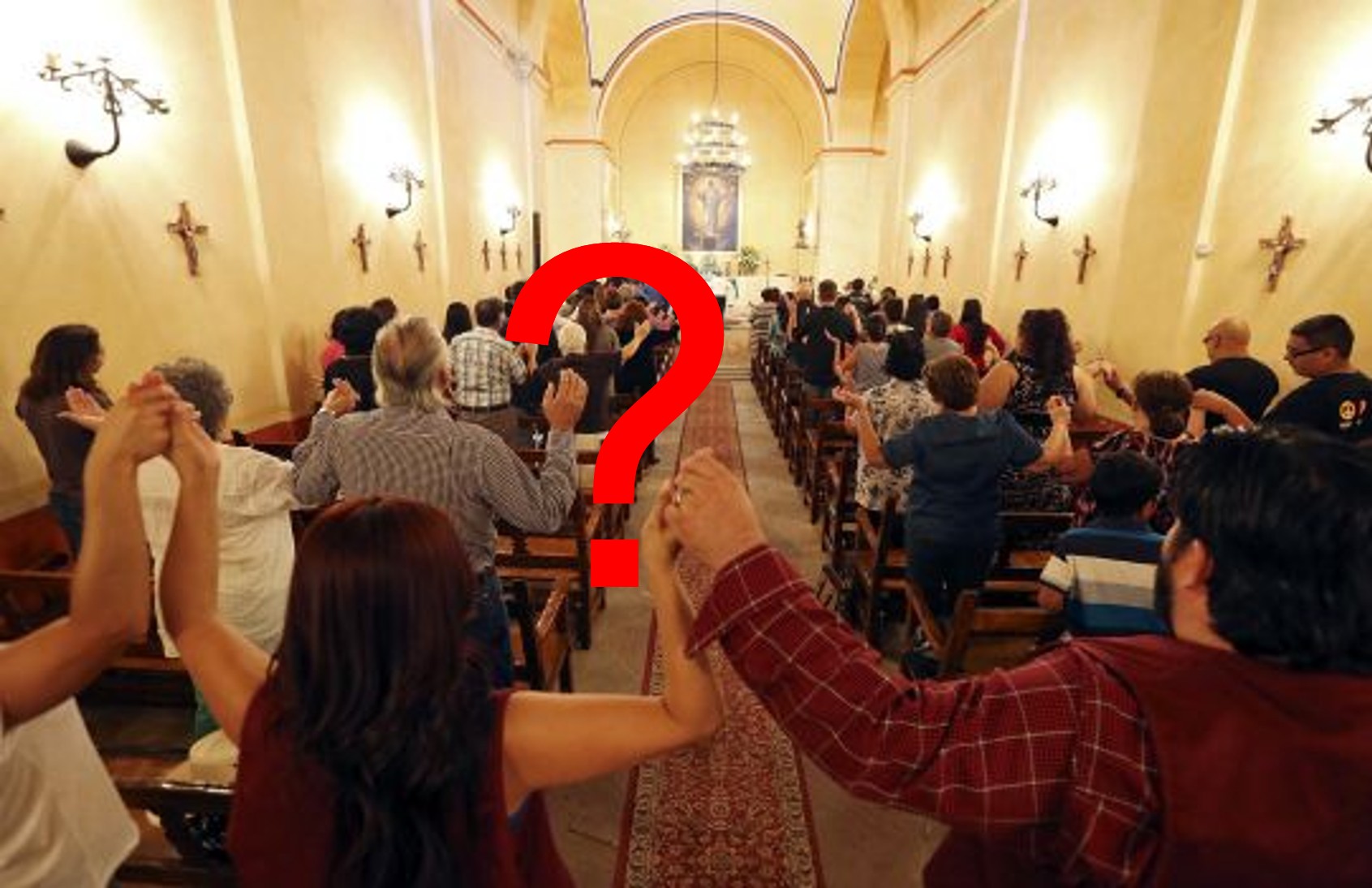
"What are the Proper Postures During Mass?": Should people stand or kneel during the Eucharistic Prayer? This is answered in the General Instruction of the Roman Missal (GIRM), number 43:
In the Dioceses of the United States of America, they should kneel beginning after the singing or recitation of the "Sanctus" ("Holy, Holy, Holy") and remain kneeing until after the "Amen" of the Eucharistic Prayer, except when prevented on occasion by ill health, or for reasons of lack of space, of the large number of people present, or for another reasonable cause. However, those who do not kneel ought to make a profound bow when the Priest genuflects after the Consecration. The faithful kneel after the "Agnus Dei" ("Lamb of God") unless the Diocesan Bishop determines otherwise.
Some people hold hands during the Lord's Prayer, while others hold their hands out like the priest. Is there a prescribed posture for the Our Father?
No position is prescribed in the Roman Missal for an assembly gesture during the Lord's Prayer. However, Jimmy Akin’s book, "Mass Confusion," available at shop.catholic.com, is an excellent resource for questions like this. Concerning holding hands during the Our Father, Jimmy states, “The Holy See has not ruled directly on this issue. In a response to a query, however, the Holy See stated that holding hands ‘is a liturgical gesture introduced spontaneously but on personal initiative; it is not in the rubrics’ . . . For this reason, no one can be required to hold hands during the Our Father” (161). Jimmy describes the practice as “discouraged.”
A different case is the practice in which some people adopt the “orantes” posture during the Our Father, praying like the priest, with hands extended. In some countries, Italy, for example, the Holy See has granted the bishops’ request to allow anyone who wishes to adopt this posture during the Our Father. Usually about a third to one-half of the assembled faithful choose to do so. Despite appearances, this gesture is not, strictly speaking, a case of the laity trying to usurp priestly functions. The Our Father is the prayer of the entire assembly and not a priestly or presidential prayer. In fact, it is perhaps the only case when the rubrics direct the priest to pray with arms extended in a prayer that he does not say alone or only with other priests. Therefore, in the case of the Our Father, the orantes posture expresses the prayer directed to God by his children. The U.S. Bishops’ Conference debated a proposal by some bishops to allow the use of the orantes posture while discussing the “American Adaptations to the General Instruction to the Roman Missal” that year. Some bishops even argued that it was the best way of ridding the country of holding hands. The proposal failed to garner the required two-thirds majority of votes, however, and was dropped from the agenda.
The Associate Pastors of St. Therese Church have also weighed in on these questions. Fr. Philip Sullivan, OCD, states, “Unless the Office of Divine Worship or the Synod of local Bishops comes out with a clear statement of where the congregation’s hands should be, then no official way can be prescribed or imposed. Historically, liturgical prayer, although it has maintained unity in its varied liturgical expressions, has never accomplished a strict uniformity because of the context in which the liturgy is celebrated within the Roman Rite.”
Fr. Bernard Perkins, OCD, adds, “The Our Father is part of the Communion Rite; it is given to us by Holy Mother Church as a preparatory prayer for the reception of Holy Communion. It was never intended for fellowship. The fellowship takes place during the sign of peace”.
Published in the Bulletin of July 26, 2015
By Leon Suprenant

Incense at Mass: Incense, mentioned over one hundred times in Sacred Scripture, represents the holiness of God’s presence and the prayers of the faithful rising to God. The General Instruction of the Roman Missal (GIRM) teaches, “Thurification or incensation is an expression of reverence and of prayer, as is signified in Sacred Scripture (cf. Ps. 141[140]:2; Rev. 8:3).” The Roman Missal of 1962 limited the use of incense to certain Masses. The postconciliar liturgical reform actually expanded the use of incense. Indeed, current liturgical legislation permits the use of incense at any Mass.
The GIRM states:
Incense may be used if desired in any form of the Mass:
a. During the Entrance procession;
b. At the beginning of Mass, to incense the cross and the altar;
c. At the Gospel procession and the proclamation of the Gospel itself;
d. After the bread and the chalice have been placed on the altar, to incense the offerings, the cross, and the altar, as well as the priest and people; and
e. At the raising of the host and chalice after the consecration.
The GIRM further describes the bows, number of incensations, and other details associated with the use of incense at Mass.
Bells at the Consecration:
Bells are mentioned seven times in Sacred Scripture, in every instance in connection with liturgical worship. In six of those seven instances, bells draw attention to the coming of a sacred person. The Church strongly encourages, but does not require, the ringing of a bell before and after the Consecration in parish and other public churches. In the Mass, the bell indicates the coming of the Person of Jesus Christ and His presence under the appearances of bread and wine at the consecration. A little before the consecration, when appropriate, the server rings a bell as a signal to the faithful. According to local custom, the server also rings the bell as the priest raises the host and the chalice.
In 1972, the following query was put to the Sacred Congregation for Divine Worship and the Discipline of the Sacraments: “Is a bell to be rung at Mass?” The Congregation’s authoritative reply follows:
It all depends on the different circumstances of places and people, as is clear from GIRM, No. 109: “A little before the Consecration, the server may ring a bell as a signal to the faithful. Depending on local custom, he also rings the bell at the showing of both the host and the chalice.” From a long and attentive catechesis and education in liturgy, a particular liturgical assembly may be able to take part in the Mass with such attention and awareness that it has no need of this signal at the central part of the Mass. This may easily be the case, for example, with religious communities or with particular or small groups. The opposite may be presumed in a parish or public church, where there is a different level of liturgical and religious education, and where often people who are visitors or are not regular churchgoers take part. In these cases the bell as a signal is entirely appropriate and is sometimes necessary. To conclude: usually a signal with the bell should be given, at least at the two elevations, in order to elicit joy and attention.
Published in the Bulletin of August 2, 2015
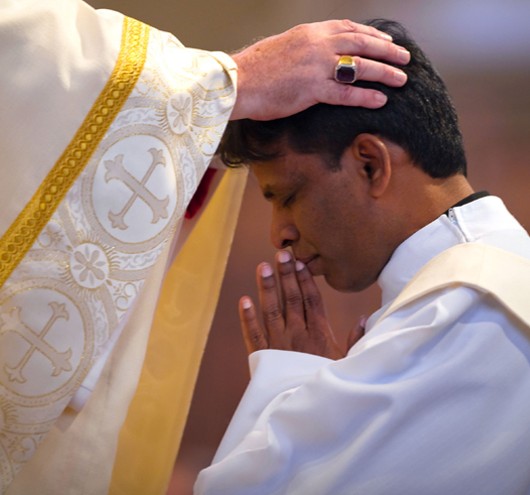
“What is Priestly Ordination?” The Rite of Ordination is what "makes" a man a priest. The Rite of Ordination occurs within the context of Holy Mass. After being called forward and presented to the assembly, the candidate is questioned and promises to diligently perform the duties of the Priesthood and to respect and obey his Ordinary (bishop or religious superior). Then the candidate lies prostrate before the altar, while the assembled faithful kneel and pray for the help of all the saints in the singing of the Litany of the Saints. The essential part of the rite is when the bishop silently lays his hands upon the candidate (followed by all priests present), before offering the consecratory prayer, addressed to God the Father, invoking the power of the Holy Spirit upon the man being ordained.
After the consecratory prayer, the newly ordained is vested with the stole and chasuble and then the bishop anoints his hands with chrism oil before presenting him with the holy chalice and paten which he will use when presiding at the Eucharist. Following this, the gifts of bread and wine are brought forward and given to the new priest; then all the priests present concelebrate the Eucharist with the newly ordained taking the place of honor at the right of the bishop.
The laying of hands of the priesthood is found in the Scriptures in 1 Timothy 4:14: “Do not neglect the gift you have, which was conferred on you through the prophetic word with the imposition of hands of the presbyterate." There are three main aspects to the priesthood: offering the Eucharist, hearing confessions, and counseling. Whilst continuing to hold the importance of these three aspects of the priesthood, the Church now has a significantly broader understanding. Priests are also responsible for daily recitation of the principal and minor offices of the Liturgy of the Hours. In addition to celebrating the Holy Sacrifice of the Mass, only priests can administer the Sacraments of Penance and Anointing of the Sick.
The New Testament depicts Jesus as the "great High Priest” of the New Covenant who, instead of offering the ritual animal sacrifices prescribed by the Jewish Law, offered Himself on the Cross as the true and perfect sacrifice. The Catholic priesthood is a participation in this priesthood of Christ, and therefore traces its origins to Jesus Christ Himself. Thus, the New Testament says that as high priest, Jesus has made the Church "a kingdom of priests.” All who are baptized are given a share in the priesthood of Christ; that is, they are conformed to Christ and made capable of offering true worship and praise to God. The ministerial Catholic Priesthood has a distinct history. This ministerial priesthood involves the direct consecration of a man to Christ through the Sacrament of Holy Orders, so that he can act in the person of Christ for the sake of the Christian faithful, above all in dispensing the Sacraments. Christ instituted the Sacrament of Holy Orders at the Last Supper when He instituted the first Mass in the presence of the Twelve Apostles, commanding them to "do this in memory of me."
The Catholic priesthood, therefore, is a share in the priesthood of Christ and traces its historical origins to the Twelve Apostles appointed by Christ. Those apostles in turn selected other men to succeed them as the bishops (episkopoi, Greek for "overseers") of the Christian communities. As the communities multiplied and grew in size, the bishops appointed more and more presbyters to preside at the Eucharist in place of the bishop. The diaconate evolved as the liturgical assistants of the bishop and his delegate for the administration of Church funds and programs for the poor. Today, the rank of "presbyter" is typically what one thinks of as a priest, although technically both a bishop and a presbyter are "priests" in the sense that they share in Christ's ministerial priesthood and offer sacrifice to God in the person of Christ.
The Canon law of the Catholic Church holds that the priesthood is a sacred and perpetual vocational state, not just a profession (which is a reason for, and symbolized by, the state of celibacy). The seminary education to become a priest is extensive and lasts at least five or six years. In the United States, priests must have a four-year university degree in philosophy plus an additional four to five years of graduate-level seminary formation in theology with a focus on Biblical research. A Master of Divinity is the most common degree.
For more information about the priesthood, see Article No. 19 (“Why Can't Women be Ordained as Catholic Priests?”) and Article No. 53 ("What is the Sacrament of Holy Orders?")
After the consecratory prayer, the newly ordained is vested with the stole and chasuble and then the bishop anoints his hands with chrism oil before presenting him with the holy chalice and paten which he will use when presiding at the Eucharist. Following this, the gifts of bread and wine are brought forward and given to the new priest; then all the priests present concelebrate the Eucharist with the newly ordained taking the place of honor at the right of the bishop.
The laying of hands of the priesthood is found in the Scriptures in 1 Timothy 4:14: “Do not neglect the gift you have, which was conferred on you through the prophetic word with the imposition of hands of the presbyterate." There are three main aspects to the priesthood: offering the Eucharist, hearing confessions, and counseling. Whilst continuing to hold the importance of these three aspects of the priesthood, the Church now has a significantly broader understanding. Priests are also responsible for daily recitation of the principal and minor offices of the Liturgy of the Hours. In addition to celebrating the Holy Sacrifice of the Mass, only priests can administer the Sacraments of Penance and Anointing of the Sick.
The New Testament depicts Jesus as the "great High Priest” of the New Covenant who, instead of offering the ritual animal sacrifices prescribed by the Jewish Law, offered Himself on the Cross as the true and perfect sacrifice. The Catholic priesthood is a participation in this priesthood of Christ, and therefore traces its origins to Jesus Christ Himself. Thus, the New Testament says that as high priest, Jesus has made the Church "a kingdom of priests.” All who are baptized are given a share in the priesthood of Christ; that is, they are conformed to Christ and made capable of offering true worship and praise to God. The ministerial Catholic Priesthood has a distinct history. This ministerial priesthood involves the direct consecration of a man to Christ through the Sacrament of Holy Orders, so that he can act in the person of Christ for the sake of the Christian faithful, above all in dispensing the Sacraments. Christ instituted the Sacrament of Holy Orders at the Last Supper when He instituted the first Mass in the presence of the Twelve Apostles, commanding them to "do this in memory of me."
The Catholic priesthood, therefore, is a share in the priesthood of Christ and traces its historical origins to the Twelve Apostles appointed by Christ. Those apostles in turn selected other men to succeed them as the bishops (episkopoi, Greek for "overseers") of the Christian communities. As the communities multiplied and grew in size, the bishops appointed more and more presbyters to preside at the Eucharist in place of the bishop. The diaconate evolved as the liturgical assistants of the bishop and his delegate for the administration of Church funds and programs for the poor. Today, the rank of "presbyter" is typically what one thinks of as a priest, although technically both a bishop and a presbyter are "priests" in the sense that they share in Christ's ministerial priesthood and offer sacrifice to God in the person of Christ.
The Canon law of the Catholic Church holds that the priesthood is a sacred and perpetual vocational state, not just a profession (which is a reason for, and symbolized by, the state of celibacy). The seminary education to become a priest is extensive and lasts at least five or six years. In the United States, priests must have a four-year university degree in philosophy plus an additional four to five years of graduate-level seminary formation in theology with a focus on Biblical research. A Master of Divinity is the most common degree.
For more information about the priesthood, see Article No. 19 (“Why Can't Women be Ordained as Catholic Priests?”) and Article No. 53 ("What is the Sacrament of Holy Orders?")
Published in the Bulletin of August 9, 2015
By Jimmy Akin
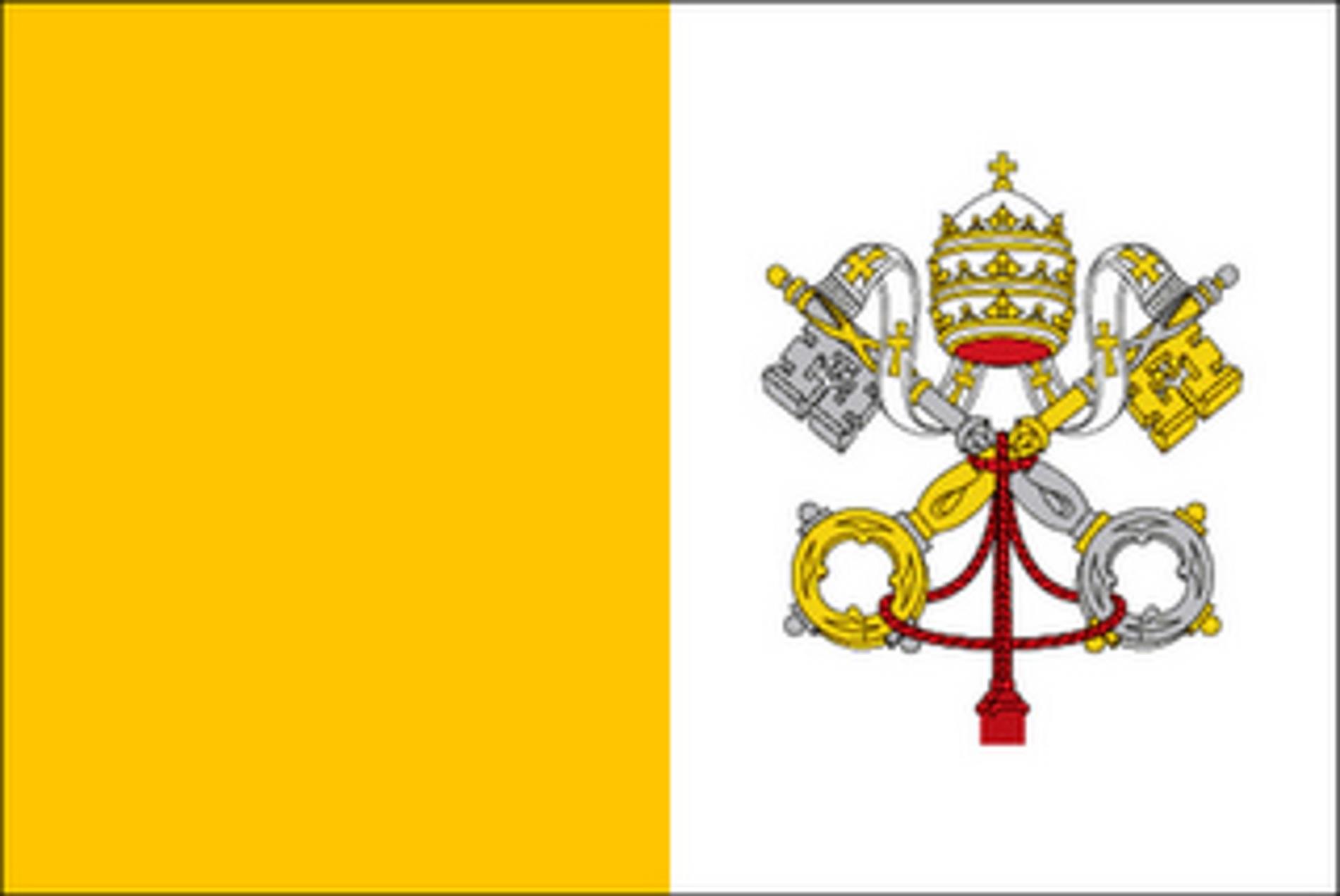
In some cases the term "doctrine" may be used to refer to things that have been infallibly taught by the Magisterium. It may even be used as a synonym for "dogma," but it is easy to show that this is not always the case. For example, the Code of Canon Law (749 §3) provides that: “No doctrine is understood as defined infallibly unless this is manifestly evident.” All dogmas are infallibly defined, as we will see, so this reveals that there can be doctrines that are not infallible and thus that are not dogmas.
What Is Dogma? The Greek word dogma originally meant "opinion," but it has come to mean something much more specific. The current understanding of "dogma" arose in the 1700s (so be warned that earlier documents, such as the writings of the Fathers, or Medievals like St. Thomas Aquinas, tend to use the term in the broader sense of just a theological opinion). Cardinal Avery Dulles explains the present meaning of the term: “In current Catholic usage, the term ‘dogma’ means a divinely revealed truth, proclaimed as such by the infallible teaching authority of the Church, and hence binding on all the faithful without exception, now and forever [The Survival of Dogma, 153].
There are two essential elements here: First, a dogma must be divinely revealed. That is to say, it must be found explicitly or implicitly in the deposit of faith that Christ gave the Church. This is found in sacred Scripture and sacred Tradition. If something is to be a dogma, it must be in one of those two places—or in both of them. Second, a dogma must be infallibly taught by the Magisterium as divinely revealed.
This is an important qualifier, because the Magisterium is capable of infallibly defining certain things that aren't divinely revealed. According to Church teaching, the Magisterium is able to infallibly teach both things that have been divinely revealed and truths that have a certain kind of connection with them, so that they may be properly explained and defended. The relationship between dogma, doctrine, and theology are represented below. Dogmas and Infallible Doctrines (the most authoritative teachings) are at the top and are the most important.
By Fr. Hal Stockert
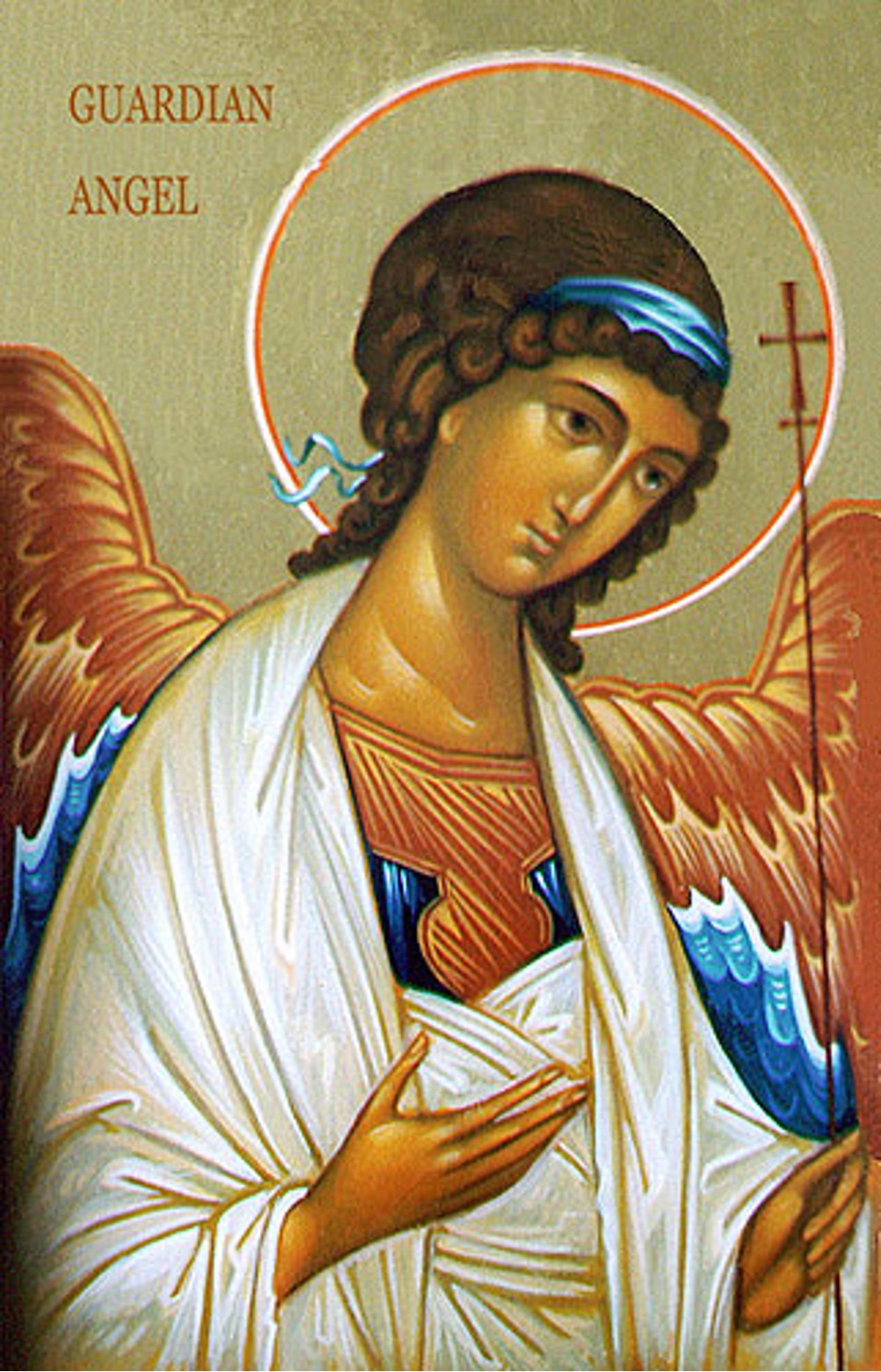
"Do Angels Really Exist?" The teaching of the Church and the testimony of the Bible
instruct us that angels are spiritual beings who have a free will and
an intellect that is far superior to ours. Coming from those two sources
ought to settle the matter of their existence for anyone who
accepts either as authoritative sources. Those of us who accept both
as authoritative ought to have even less problem believing in angels.
We know that the evil ones dwell in Hell and the holy ones dwell in
Heaven and are therefore considered to be saints. God uses angels as
messengers, guardians, and all-around helpers to us—as well as to
reflect His glory. In Tobit 12:12, the Archangel Raphael said to Tobias,
"So now when you and Sarah prayed, it was I who brought and read the
record of your prayer before the glory of the Lord, and likewise
whenever you would bury the dead." In Tobit 12:14-16, we read, "And at
the same time God sent me to heal you and Sarah your daughter-in-law. I
am Raphael, one of the seven angels who stand ready and enter before the
glory of the Lord.”
There are many other places in both the Old and the New Testaments where we read about angels. They appeared, for example, to Abraham before visiting Sodom to try to find ten honest men. Jacob wrestled an angel and had a dream in which he saw angels ascending and descending upon a ladder. There was an angel stationed at the gates of Eden as Adam and Eve were cast out. There was the angel of the Annunciation, Gabriel—without whose presence it is difficult to visualize the Incarnation. There was the angel who appeared to John the Baptist’s father, angels who appeared outside the tomb, and angels who appeared to the faithful at the Ascension—not to mention angels who "ministered" to Christ so often in Scripture. These are far too many references to be simple embellishments, with far too much detail.
The Church also teaches that God has given us angels as guardians to lead us to good thoughts, works and words, and to preserve us from evil (since the 17th century the Church has celebrated a feast honoring them—now observed on October 2nd). He has charged His angels with the ministry of watching and safeguarding every one of His creatures that do not behold His face. Our Lord says in the Gospel, "Beware lest ye scandalize any of these little ones, for their angels in Heaven see the face of My Father." The existence of Guardian Angels, is, hence a dogma of the Christian faith: this being so, we need to be respectful of angels. How great our solicitude should be, lest, by any act of ours, we offend those eyes which are ever bent upon us in all our ways!
Through study of the Scriptures, we can come to the conclusion that angels possess the following qualities:
- Angels are immortal. "Then He will say to those at His left hand, 'You that are accursed, depart from me into the eternal fire prepared for the devil and his angels.'" (Mt. 25:41).
- Angels possess understanding and free will. "For if God did not spare the angels when they sinned, but cast them into hell and committed them to chains of deepest darkness to be kept until the judgment..." [2 Peter 2:4]. The angels had a free will and knew it when they were disobeying God by following Satan in his rebellion.
- Angels are greater in might and power than any other creature. "Whereas angels, though greater in might and power, do not bring against them a slanderous judgment from the Lord" (2 Peter 2:11).
Most Catholics were taught as children at least two formal prayers that were addressed to angels: “Prayer to St. Michael the Archangel” and “Angel of God”. As adults we would do well to continue saying these prayers daily in order to seek the guidance and protection of God’s holy angels.
Punished in the Bulletin of August 23, 2015
By Bishop Robert Barron
(W A R N I N G: This article is a little graphic—but honest)

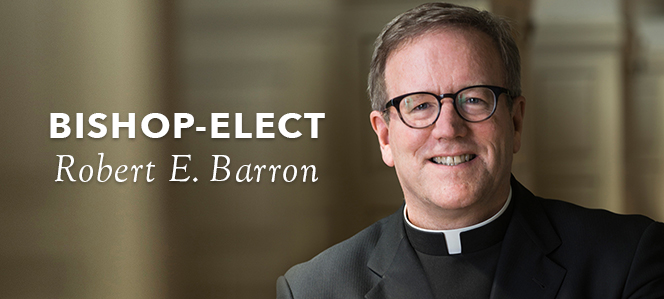
While they slurp wine in elegant restaurants, the good doctors--both women--blandly talk about what price they would expect for providing valuable inner organs, and how the skillful abortionists of Planned Parenthood know just how to murder babies so as not to damage the goods. One of the doctors specified that the abortion providers employ less "crunchy" methods when they know that the organs of a baby are going to be harvested for sale. Mind you, the "crunchiness" she's talking about is a reference to the skull-crushing and dismemberment by knife and suction typically employed in abortions. For me the most bone-chilling moment was when one of the kindly physicians, informed that the price she was asking was too low, leered and said, "Oh, good, because I'd like a Lamborghini."
Now
it is easy enough to remark and lament about the moral coarseness of
these women and the particularly repulsive way that they combine
violence and greed. However, I would like to explore a deeper issue that
these videos bring to light, namely, the forgetfulness of the dignity
of the human being that is on ever-clearer display in our Western
culture. One has only to consider the over 58,000,000 abortions that
have taken place, under full protection of the law, in our country since
Roe v. Wade in 1973,
or the ever-more insistent push toward permitting euthanasia, even of
children in some European countries, or the wanton killing going on
nightly in the streets of our major cities. The figures in my home town
of Chicago typically surpass those recorded in the battle grounds of the
Middle East.
What makes this sort of startling violence against human beings possible, I would submit, is the attenuation of our sense of God’s existence. In the classical Western perspective, the dignity of the human person is a consequence and function of his or her status as a creature of God. Precisely because the human being is made in the image and likeness of the Creator and destined, finally, for eternal life on high with God, he is a subject of inalienable rights. I use Jefferson’s language from the Declaration of Independence on purpose here, for the great founding father knew that the absolute nature of the rights he was describing follows from their derivation from God: “they are endowed by their Creator with certain unalienable rights…” When God is removed from the picture, human rights rather rapidly evanesce, which can be seen with clarity in both ancient and modern times. For Cicero, Aristotle, and Plato, a cultural elite enjoyed rights, privileges, and dignity, while the vast majority of people were legitimately relegated to inferior status, some even to the condition of slavery. In the totalitarianisms of the last century—marked in every case by an aggressive dismissal of God—untold millions of human beings were treated as little more than vermin.
I realize that many philosophers and social theorists have tried to ground a sense of human dignity in something other than God, but these attempts have all proven fruitless. For instance, if human worth is a function of a person’s intelligence or creativity or imagination, or her capacity to enter into friendship, then why not say that this worth disappears the moment those powers are underdeveloped, weakened, or eliminated altogether? Or if respect for human dignity is related to the strength of one’s feeling for another person, then who is to say that that dignity vanishes once one’s sentiments change or dry up? My suspicion is that if we interrogated people on the street and asked them why human beings should be respected, some version of this argument from sentimentality would emerge. But again, the problem is that feelings are so ephemeral, shifting and changing like the wind. If you doubt me, read some of the accounts of the officers and soldiers in the Nazi death camps, who, after years of killing, lost all feeling for those they were murdering, seeing them as little more than rats or insects.
For the past two hundred years, atheists have been loudly asserting that the dismissal of God will lead to human liberation. I would strenuously argue precisely the contrary. Once the human being is untethered from God, he becomes, in very short order, an object among objects, and hence susceptible to the grossest manipulation by the powerful and self-interested. In the measure that people still speak of the irreducible dignity of the individual, they are, whether they know it or not, standing upon Biblical foundations. When those foundations are shaken—as they increasingly are today—a culture of death will follow just as surely as night follows day. If there is no God, then human beings are dispensable; so why not trade the organs of infants for a nice Lamborghini?
Published in the Bulletin of August 30, 2015
By Fr. Roger Landry
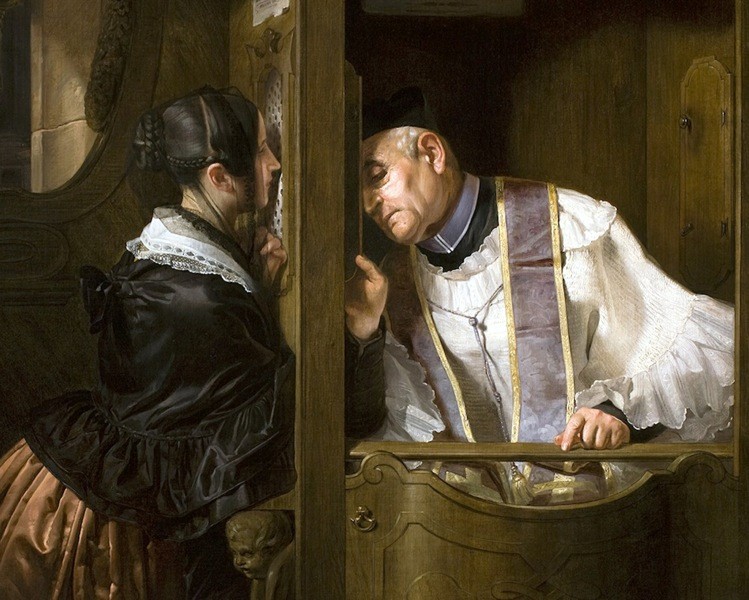
Since the apostles were unable to read minds, the only way that they would know which sins to forgive and which to retain is if people told them their sins. Jesus thus established the essential structure of the Sacrament of Confession. Just as He uses priests to give us His Body and Blood at Mass, so He uses them to give us His mercy in Penance. The Sacrament consists of three actions on the part of the penitent: 1) Contrition (sorrow for one’s sins); 2) Confession (telling one’s sins to the priest; and 3) Penance (a desire, shown by some action given to us by the priest, to make up for one’s sins and amend one’s life). Together, these three actions are called the “acts of the penitent.” Before going to Confession, it is important to first ask God for help in prayerfully examining one’s actions in the light of Christ’s teaching and example. Some review their behavior by the Ten Commandments, others by Christ’s command to love God and love others, others by their correspondence to the beatitudes, others by comparing their behavior to the most important Christian virtues, and others by the seven “capital” sins (pride, envy, anger, sloth, greed, lust and gluttony). It is not enough merely to focus on how one has broken God’s “rules,” but rather how one has damaged his relationship with God and others and hurt himself interiorly.
Sin is an offense against God that ruptures our communion with Him and with His Church (CCC 1440). It is far more than “breaking the rules,” but, much more importantly, is a failure to love God and to love others, which causes real damage in all our relationships. Archbishop Sheen used to say that “sin is hurting the One we love…” There are sins totally incompatible with love for God and others (mortal sins, in which genuine love is “dead”), and ones in which love is less grievously wounded (venial or “easily forgiven”). A mortal sin involves 1) an action whose object is grave matter that is committed with 2) full knowledge and 3) deliberate consent. Grave matter is generally understood to be something that violates the Ten Commandments. Full knowledge means that one is aware that God or the Church He founded considers the act sinful (even if one doesn’t totally understand why it is sinful). Deliberate consent means sufficiently intentional to be a personal choice (CCC 1857-1859). A mortal sin “results in the loss of charity and the privation of sanctifying grace; that is, of the state of grace. If it is not redeemed by repentance and God’s forgiveness, it causes exclusion from Christ’s kingdom and the eternal death of Hell, for our freedom has the power to make choices for ever, with no turning back” (CCC 1861). This is why it is so important for mortal sins to be confessed to a priest as soon as possible (CIC 988) and before receiving any of the other Sacraments.
Jesus, the Lamb of God who came to take away the sins of the world, said “Repent, for the kingdom of God is at hand” (Mt 4:17). He healed people both physically and spiritually by forgiving their sins. He taught us to pray to the Father to forgive us our sins and to bring us to forgive the relatively smaller debts of those who sin against us (Mt 6:12; 18:21-35). On the Cross, as He prepared to die to take away the punishment due to us for our sins, he prayed: “Father, forgive them, for they do not know what they are doing.” After His resurrection, not only did Jesus give the apostles the ability to forgive sins in His name, but He also commanded them to preach “repentance and forgiveness of sins” to all nations (Jn 20:21-23; Lk 24:47). That’s what the Church continues through preaching the need for repentance and making Jesus’ mercy available through the Sacrament of Penance.
Should I go to confession if I haven’t committed any sins since my last confession? No, you should stay at home and wait for your canonization papers to arrive! Seriously, if it’s been several weeks since your last confession and you think you haven’t committed any sins, you have probably not examined your conscience very carefully. “The just man,” the Book of Proverbs tells us, “falls seven times a day” (Prov. 24:16). If you’re struggling to find matter to confess, examine your conscience for sins of omission (James 4:17 declares, "Anyone, then, who knows the good he ought to do and doesn't do it, sins."), or think about the seven capital sins, or just meditate on whether you in fact have shown that you love the Lord with “your whole heart, mind, soul and strength” (Lk 10:27).
Although having venial sins will not keep us from receiving Holy Communion, it is important to go to the Sacrament to confess them. Through the Sacrament, we are not only forgiven our sins, but we also receive God’s grace to fight against temptation. The great saints, who were filled with love of God and seemed for the most part to have avoided mortal sins, confessed very frequently, because the Sacrament helped them grow in God’s grace. Confession reveals to us our need for God’s help in the “little things” of the day and leads us to ask for that help.
Remember, in the Sacrament you are fundamentally talking to God through the priest. God loves you, wishes to forgive you, and desires to embrace you with the joy with which the prodigal son was embraced in Jesus’ parable (Lk 15:11-32). Moreover, know that you will not say anything that the priest has not heard before. If you feel nervous or uncomfortable, share that with the priest and he will help you to overcome that and to help you make a “good” Confession.
(Additional information can be found in Article No. 42, "Is the Sacrament of Confession Scripture-Based?," published in the St. Therese Bulletin of April 17, 2016. and Article No. 44, "Is Confession a Time for Spiritiual Direction?," published in the Bulletin of May 1, 2016)
Published in the Bulletin of September 6, 2015
CATEGORIES: So that you may more easily find the answers to your questions, the categories (in alphabetic order) into which these articles fall are listed to the right. Some articles appear in more than one category.
The titles of the articles can be seen below; they are listed in the order of publication in the bulletin.
By Ruben Beltran
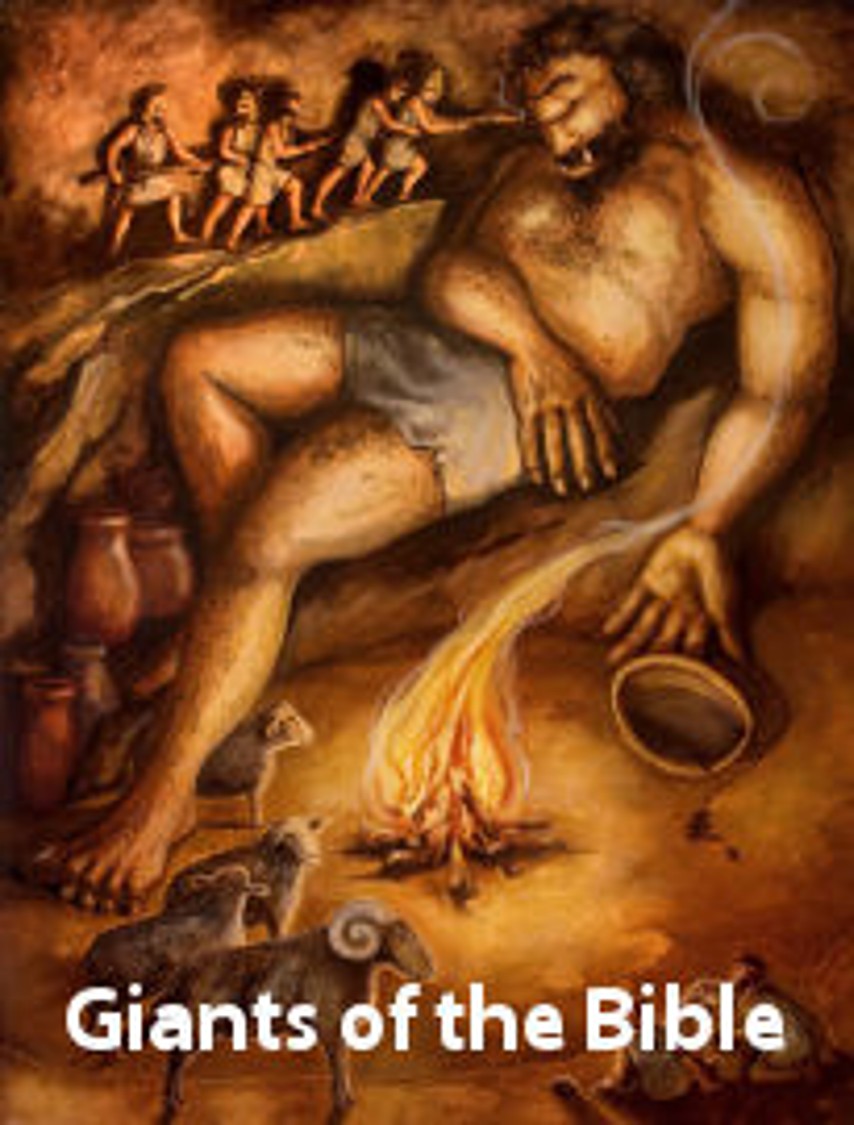
"Does the Bible Really Say That Giants Existed?"
“When
men began to multiply on the face of the ground, and daughters were
born to them, the sons of God saw that the daughters of men were fair;
and they took to wife such of them as they chose. Then the LORD said,
‘My spirit shall not abide in man forever, for he is flesh, but his days
shall be a hundred and twenty years.’ The Nephilim were on the earth
in those days, and also afterward, when the sons of God came in to the
daughters of men, and they bore children to them. These were the mighty
men that were of old, the men of renown” (Genesis 6: 1-4).
I frequently get asked to what does the above verse refer to. Who are the Sons of God? Are they really fallen angels that had relations with women on earth, and as a result gave birth to the Nephilim (Giants)? The short answer is “No.” The Bible is speaking of two different groups: Those who follow the will of God (Sethites) and those who do not (Cainites). Biblical scholars debate what the expression “sons of God” means here, and the Church has made no official declaration.
Jewish tradition and some ancient Christian writers read it as meaning fallen angels; but that explanation does not fit in with the spiritual nature of angels. In Matthew 22:30 Christ says that the Angels are not married nor given in marriage; and, therefore, are pure spirits and cannot reproduce. Furthermore, angels are never referred to as sons of God anywhere else in Genesis. So who are the sons of God? In his book, “A Father Who Keeps His Promises,” Dr. Scott Hahn explains:
“When people began to multiply on the face of the earth, ‘the sons of God,’ that is, the Sethite men, were seduced by the beauty of ‘the daughters of men;’ that is, the Cainite women. The beauty of the wicked proved stronger than the resolve of the righteous. Sethite men found a new forbidden fruit, the beautiful but ungodly Cainite women, to be irresistible. And they didn’t just marry them; ‘they married as they chose,’ which might imply that, along with mixed marriages, polygamy had now also entered into the line of Seth, the covenant family of God. Thus, violent men were born. When left unchecked, sin becomes institutionalized. In every age of salvation history, sexual immorality and violence go hand in hand, triggering the hard remedy of God’s judgment in the form of the covenant curses. And nothing institutionalizes sin more than marital infidelity. The whole culture gets clobbered, especially the children. And afterwards only a remnant survives, barely.”
Dr. Hahn goes on to explain that the word “Nephilim” in the Hebrew can mean “giants,” but can also be translated as “tyrants”—violent men who want to make a name for themselves and will do whatever it takes to achieve it. We must remember that because the Bible was written in a different language and time, Catholics must be careful when interpreting certain passages. The Bible is not a scientific textbook and, therefore, should not be read as if it were stating scientific fact. It is the Word of God and consequently free from all error, as stated in Dei Verbum, Paragraph 11. When reading the Bible, we should keep in mind St. Augustine’s guideline for how Catholics should deal with an apparent error in Scripture. In a brilliant letter to St. Jerome, Augustine affirms that the authors of Scripture were “completely free from error,” and lays down this general rule:
“And if in these writings I am perplexed by anything which appears to me opposed to truth, I do not hesitate to suppose that [1] either the manuscript is faulty, or [2] the translator has not caught the meaning of what was said, or [3] I myself have failed to understand.”
Published in the Bulletin of September 27, 2015
Submitted by Denise McMaster-Holguin (Parish Secretary)
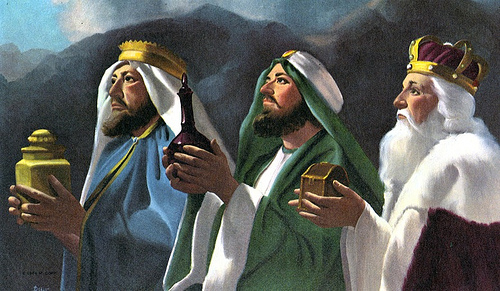
According to Matthew (Matthew 2:1-12), the only one of the four Gospels to mention the Magi, they came "from the east" to worship the "king of the Jews," offering gifts of gold, frankincense, and myrrh to the Holy Child. Although the account does not mention the number of Magi, the three gifts has led to the widespread assumption that there were three men. Unfortunately, nothing is known with certainty about the identities of the Wise Men from the East. It is surmised that they were gifted astronomers and astrologers--probably Medes from the clan of Magus, from ancient Babylon (modern Iraq). Scripture tells us that the Magi made their presence known to King Herod before the visit and that they were warned in a dream to return to their own country by a different route to avoid Herod after they saw Jesus. Their identification as kings is probably linked to Psalms 72:11, "May all kings fall down before Him".
Although the New Testament does not give any names to the Magi, by the 8th Century they were identified as Balthasar, Gaspar, and Melchior, and were all regarded as saints. Tradition tells us that Balthasar is often represented as a king or a scholar from Babylonia; Melchior as a king or scholar from Persia, and Gaspar as a king or scholar from India. These names apparently derive from a Greek manuscript probably composed in Alexandria around 500 translated into Latin with the title Excerpta Latina Barbari. Another Greek document from the 8th century, translated into Latin with the title Collectanea et Flores, continues the tradition of three kings and, along with the above-cited names, gives additional details.
The Bible specifies no interval between Jesus' birth and the magi's visit; however, the closeness of the traditional dates of December 25 and January 6 encourage the popular assumption that the visit took place the same winter as the birth, but later traditions varied, with the visit taken as occurring up to two winters later. This maximum interval explained Herod's command in Matthew 2:16-18 that the massacre of the innocents should include boys up to two years old.
If you were to stroll around Prague or Frankfurt or Budapest or Kraków over the next few weeks, you might see curious graffiti scratched in chalk over some doorways: "20 G M B 16." The families dwelling behind those doors have celebrated the Epiphany door blessing. They have gathered before the feast-day meal, probably after Mass, and the head of the family has traced the sign of the cross on the piece of chalk. Standing on a ladder, the leader writes the numbers for the new year, and the letters C M B for Christus Mansionem Benedicat, Latin for "May Christ bless this house." The letters also point to the names that tradition has assigned to the mysterious magi, Caspar (an alternate name for Gaspar), Melchior, and Balthasar.
The blessing speaks of journeys ended and journeys begun at the doorway, and prays that all journeys be as satisfying as was the magi's. It prays that the house beyond the door has the quality of love and peace that the magi marveled at when they at last arrived in Bethlehem. In some countries where the Soviet Union tried to impose a harsh atheism, the vigor of this household custom survived all efforts to erase Christian customs. In the years of struggle, the chalked blessings were a pervasive sign of defiance, and now in the light of new freedoms, they are a sign of the resilience of our tradition and the fulfillment of the magi's quest for meaning and peace.
Published in the Bulletin of January 3, 2016
From "Boys to Men: The Transforming Power of Virtue" by Tim Gray
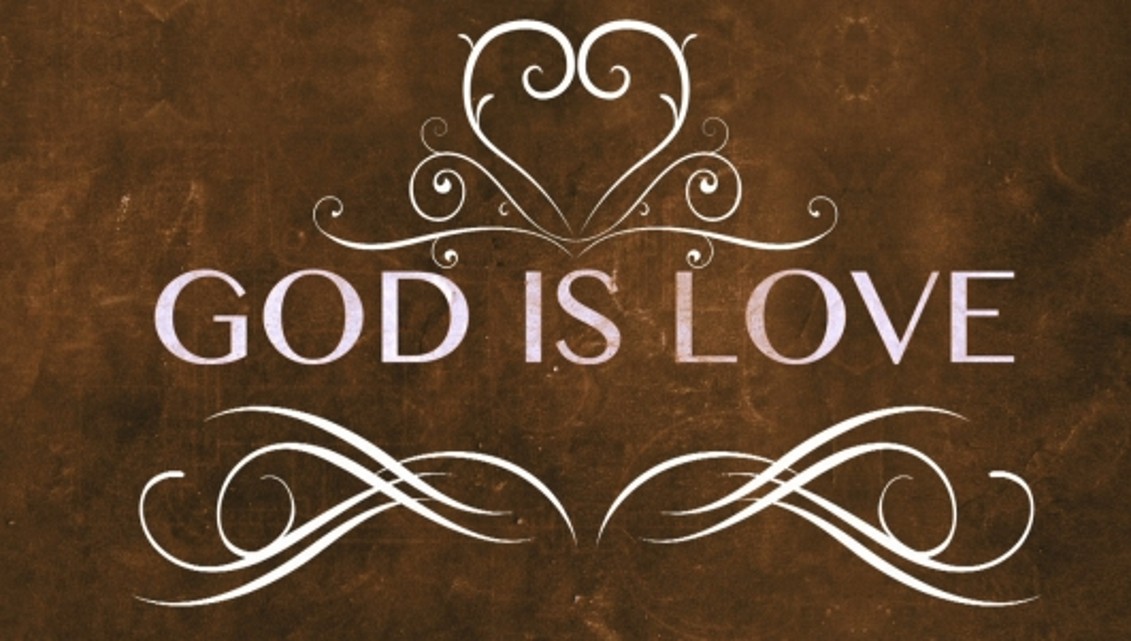
"How Can True Love Be Explained?" Faith is a virtue of the intellect. Love, on the other hand, is a virtue of the will. That is, love is a mode of willing. By willing, we mean choosing something as good. We all love: It is just a question of what do we love—what do we choose as being good for us? The theological virtue of love is the desire for the greatest good for others and ourselves. The greatest good, of course, is God Himself.
Understanding love as an act of the will is in stark contrast to the more common consideration of love as a feeling. St. Thomas Aquinas distinguished the passion or feeling of love from love as a virtue. As a passion, love is the desire for some good, like ice cream, baseball, or a Mercedes-Benz. Love, in this sense, is something that happens to us. We are passive recipients of emotional experiences. Our passions, that is, our desires, control our feelings and, in a sense, hold us captive to our basic instincts (cf. Catechism, no. 1765). Although these passions may be good and directed toward a real good, they do not indicate the presence of the virtue of love. Love, as a virtue, is about what we choose, not how we feel.
For example, when a young man commits himself to a woman in the Sacrament of Marriage, he makes a vow to love her regardless of his feelings. What does this mean? As time passes and the trials of life weigh down, the couple may not feel the sentiments of love. Because many people have a wrong understanding of love, they feel justified to leave the marriage and look for those same feelings in another person. This makes sense if we reduce love to mere feelings. True marital love, however, understands that the commitment transcends subjective feelings. The feelings may have been necessary at the beginning of courtship, but if it evolves into true love, feelings become secondary. Marriage is about a choice to commit one’s life to another for their well-being regardless of emotions. This is sometimes very difficult, but it is an example of the self-sacrificing nature of love.
Love, in this sense, is not about the wants of the one who loves, but about what is best for the beloved. True love is about the other, not the self. Consequently, love often demands sacrificing one’s own desires for the good of the other. The degree to which one is able to sacrifice for others is the measure of his love. We may want to love, but if we are going to will to love, we must have the virtues. The father who rises in the middle of the night to care for his new child is not acting out of a desire to get less sleep (hardly!), but out of love for his new daughter and tired wife. He acts for the benefit of others, not for himself.
There is a wonderful story told of a little boy who worked hard to earn enough money for a beautiful model of a sailing ship. He worked for days to build the ship and finally it was completed. He went down to a local park and placed his beloved ship in the lake. It was a great success and his ship floated perfectly. The model sails even caught the wind and moved the ship along. Then, unexpectedly, a strong gust of wind came and blew the small ship beyond the reach of the boy. He watched helplessly as the wind pulled the ship farther and farther into the great lake. He waited for hours hoping his ship would come back, but it was hopeless. His beloved ship was lost.
Devastated,
the boy returned home without his prized possession. Weeks passed and
he could not get the ship out of his mind. One day, he was walking
through town, and as he passed a local shop, he raised his eyes and
could not believe what he saw. His ship was sitting in the storefront
window. He rushed in and explained to the owner that the ship was his
and how he had lost it. The owner was moved, but he told the boy that he
had purchased the ship from the person who found it and that he would
have to sell the ship to the boy for a price. Having spent all of his
money on the original purchase, the boy went home and began working
diligently to save the money he needed to buy back his ship. Finally,
with the money in his hand, he returned to the shop and bought his
cherished ship. As he held the ship in his hands, the shopkeeper
overheard the boy say, “My little ship! How I love you. You are now mine twice. I made you, and then I lost you, but I have bought you back.”
In Christ, God has done even more for us! He has created us out of love, and bought us back at the price of His own blood.
By Rhonda Storey
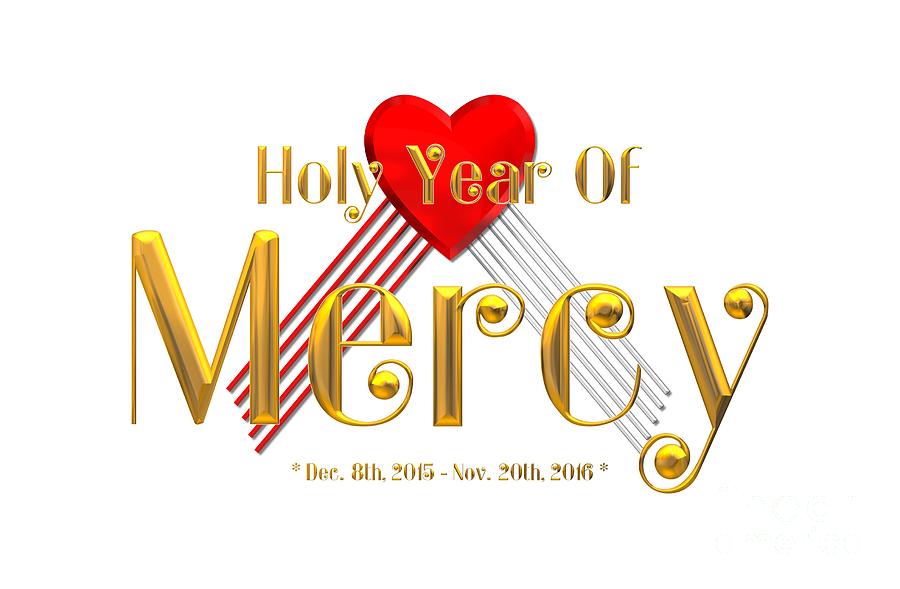
The Holy Year is traditionally a year of forgiveness of sins and also of the punishment merited by one’s sins. It is also a year for reconciliation between enemies, conversion, and receiving the Sacrament of Reconciliation. Until now there have only been 26 ordinary Jubilees and three extraordinary, the last of which was the Jubilee of 2000. Each has featured a special plenary indulgence.
What is an Extraordinary Jubilee Year? An Extraordinary Jubilee can be called for a special occasion or for an event that has a particular importance. The first extraordinary Jubilee was called in the 16th century, and the most recent were in 1933, when Pope Pius XI called one to celebrate 1,900 years of Redemption, and in 1983, when St. John Paul II proclaimed one to honor 1,950 years of redemption after Christ’s death and resurrection.
What is a Holy Door? If you kept up with the Pope during his recent trip to Africa, you probably caught the early opening of the Holy Door for the Year of Mercy in Bangui, Central African Republic. Although the Holy Year officially kicked off on December 8, it marked the first time in history that a Pope has opened a Holy Door outside of Rome. Each of the four papal basilicas in Rome has a holy door, which are normally sealed shut from the inside so that they cannot be opened. The doors are only opened during Jubilee years so that pilgrims can enter through them in order to gain the plenary indulgence that is connected with the Jubilee. The rite of the opening of the Holy Door is intended to symbolically illustrate the idea that the Church’s faithful are offered an “extraordinary path” toward salvation during the time of Jubilee. It symbolizes a person’s leaving behind of the world and entering into the presence of God, similar to the way the High Priests in the Old Testament would pass through the veiled entrance of the Holy of Holies on Yom Kippur to enter the presence of God and offer sacrifices.
After the Holy Door opened in St. Peter’s Basilica, the other three Roman basilicas, St. John Lateran, St. Paul Outside the Walls and St. Mary Major, were opened as well. In the case of a plenary indulgence, it is a full remission of sins.
How to obtain an indulgence during a Holy Year: According to the Apostolic Penitentiary, to gain indulgences (plenary or partial) it is necessary that the faithful be in the state of grace at least at the time the indulgenced work is completed. To receive the Jubilee Year indulgence, you must fulfill the usual conditions (specified below) and perform the indulgenced act: Passing through a designated Holy Door during the extraordinary Jubilee Year of Mercy (between December 8, 2015, the Solemnity of the Immaculate Conception, and November 20, 2016, the Solemnity of Christ the King) and/or performing one of the corporal or spiritual works of mercy.
In order to obtain a plenary indulgence, the faithful must, in addition to being in the state of grace: 1) Have the interior disposition of complete detachment from sin, even venial sin; 2) Have sacramentally confessed their sins; 3) Receive the Holy Eucharist (preferably within the context of Mass); and 4) Pray for the intentions of the Pope (a spiritual work of mercy). Ideally, one would go to confession, receive Communion, and perform the indulgence works all on the same day; but it is sufficient that these sacraments, works of mercy, and prayers be carried out within several days (about 20) before or after the indulgenced act. Prayers for the Pope’s intentions are left to the choice of the faithful, but an “Our Father” and a “Hail Mary” are customary. One sacramental Confession suffices for several plenary indulgences, but a separate Holy Communion and a separate prayer for the Holy Father’s intentions are required for each plenary indulgence. Exceptions can be made by confessors for the sick and the homebound. Indulgences can always be applied either to oneself or to the souls of the deceased, but they cannot be applied to other persons living on earth.
For more information, please see the articles on the EVENTS page about where to obtain a Plenary Indulgence in the Southern California area for the “Year of Mercy,” as well as an explanation of Church teaching about indulgences.
Published in the Bulletin of February 7, 2016
by Jimmy Akin
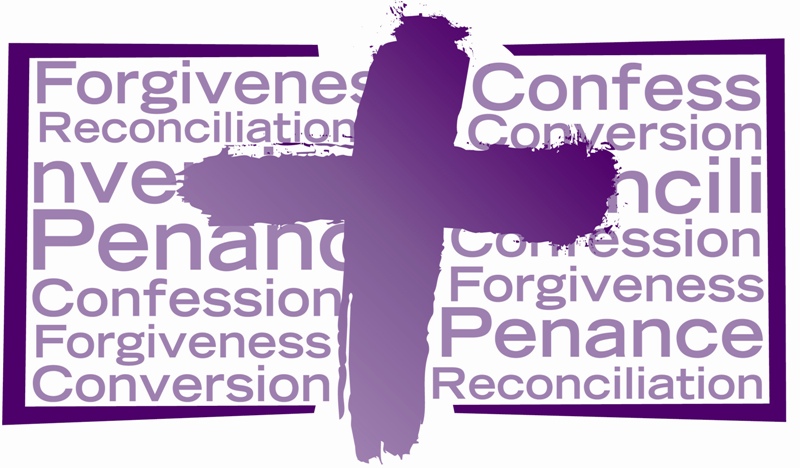
"How Do Catholics Practice Lent?"
Q: What is Lent? Lent is the forty-day period before Easter, excluding Sundays, that begins on Ash Wednesday (the day on which the faithful have their foreheads signed with ashes in the form of a Cross) and ends just before the Mass of the Lord’s Supper begins on the evening of Holy Thursday. Ash Wednesday is also a day of fast and abstinence. As soon as the Mass of the Lord’s Supper starts, a short liturgical season begins: The three days of the Holy Triduum. This does not mean that our Lenten sacrifices should end as they should be observed through Good Friday and Holy Saturday—the solemn and sacred days of Christ’s death and resurrection.
Q: What are appropriate activities for ordinary days during Lent? Giving up something we enjoy for Lent, doing something “extra,” such as corporal or spiritual works of mercy for others, prayer, fasting, almsgiving, abstinence, going to confession, and other acts expressing repentance in general.
Q: Is the custom of giving up something for Lent mandatory? No. However, it is a salutary custom, and parents or caretakers may choose to require it of their children to encourage their spiritual training, which is their prime responsibility in the raising of their children.
Q: What is a day of fast and abstinence? Under current canon law in the Western Rite of the Church, a day of fast is one on which Catholics who are eighteen to sixty years old are required to keep a limited fast. In this country, one may eat a single, normal meal and have two snacks, so long as these snacks do not add up to a second meal. Children are not required to fast, but their parents must ensure they are properly educated in the spiritual practice of fasting. Those with medical conditions requiring a greater or more regular food intake can easily be dispensed from the requirement of fasting by their pastor. A day of abstinence is a day on which Catholics fourteen years or older are required to abstain from eating meat (under the current discipline in America, fish, eggs, milk products, and condiments or foods made using animal fat are permitted in the Western Rite of the Church, though not in the Eastern Rites). Again, persons with special dietary needs can easily be dispensed by their pastor.
Q: Is there a biblical basis for abstaining from meat as a sign of repentance? Yes. The book of Daniel states, "In the third year of Cyrus, king of Persia . . . 'I, Daniel, mourned for three weeks. I ate no choice food; no meat or wine touched my lips; and I used no lotions at all until the three weeks were over'" (Daniel 10:1-3).
Q: In addition to Ash Wednesday, are any other days during Lent days of fast or abstinence? Yes. All Fridays during Lent are days of abstinence. Also, Good Friday, the day on which Christ was crucified, is another day of both fast and abstinence. All days in Lent are appropriate for fasting or abstaining, but canon law does not require fasting on those days. Such fasting or abstinence is voluntary, like a freewill offering.
Q: Why are Fridays during Lent days of abstinence? This is because Jesus died for our sins on Friday, making it an especially appropriate day of mourning our sins (just as Sunday, the day on which He rose for our salvation is an especially appropriate day to rejoice) by denying ourselves something we enjoy. During the rest of the year Catholics in this country are permitted to use a different act of penance on Friday in place of abstinence, though all Fridays are days of penance on which we are required to do something expressing sorrow for our sins, just as Sundays are holy days on which we are required to worship and celebrate God's great gift of salvation.
Q: Why are Sundays excluded from the reckoning of the forty days? Because Sunday is the day on which Christ arose, making it an inappropriate day to fast and mourn our sins. On Sunday we must celebrate Christ's Resurrection for our salvation. It is Friday on which we commemorate His death for our sins. The Sundays of the year are days of celebration, “mini Easters” and the Fridays of the year are days of penance.
Q: Why are the forty days called Lent? They are called Lent because that is the Old English word for spring, the season of the year during which they fall. This is something unique to English. In almost all other languages its name is a derivative of the Latin term Quadragesima, or "the forty days."
Q: Why is Lent forty days long? Because forty days is a traditional number of discipline, devotion, and preparation in the Bible. Thus Moses stayed on the Mountain of God forty days (Exodus 24:18 and 34:28), the spies were in the land for forty days (Numbers 13:25), Elijah traveled forty days before he reached the cave where he had his vision (1 Kings 19:8), Nineveh was given forty days to repent (Jonah 3:4), and, most importantly, prior to undertaking His ministry, Jesus spent forty days in the wilderness praying and fasting (Matthew 4:2). Since Lent is a period of prayer, fasting & almsgiving, it is fitting for Christians to imitate their Lord with a forty-day period. Christ used a forty-day period of prayer and fasting to prepare for His ministry, which culminated in His death and resurrection; and thus it is fitting for Christians to imitate Him with a forty day period of prayer and fasting to prepare for the celebration of His ministry's climax, Good Friday (the day of the crucifixion) and Easter Sunday (the day of the resurrection). Thus the Catechism of the Catholic Church states: "'For we have not a high priest who is unable to sympathize with our weaknesses, but one who in every respect has been tested as we are, yet without sinning’ [Heb 4:15]. By the solemn forty days of Lent the Church unites herself each year to the mystery of Jesus in the desert." (CCC 540).
Q: Are acts of repentance appropriate on other days during Lent? Yes. Thus the Code of Canon Law states: "All Fridays through the year and the time of Lent are penitential days throughout the universal Church" (CIC 1250).
Q: Why are acts of repentance appropriate at this time of year? Because it is the time leading up to the commemoration of Our Lord's death for our sins and the commemoration of His resurrection for our salvation. It is thus especially appropriate to mourn the sins for which He died. Humans have an innate psychological need to mourn tragedies, and our sins are tragedies of the greatest sort. It is thus appropriate to have set times of repentance. Lent is one of those set times.
Q: Aside from Ash Wednesday, which begins Lent, what are its principal events? There are a variety of saints' days which fall during Lent, and some of these change from year to year since the dates of Lent itself change based on when Easter falls. However, the Sundays during the Lenten season commemorate special events in the life of Our Lord, such as His Transfiguration and His Triumphal Entrance into Jerusalem on Palm Sunday, which begins Holy Week. Holy week climaxes with Holy Thursday, on which Christ celebrated the first Mass; Good Friday, on which He was Crucified; and Holy Saturday—the last day of Lent—during which Our Lord lay in the Tomb before His Resurrection on Easter Sunday, the first day after Lent.
Published in the Bulletins of February 14 and February 21, 2016
by Jimmy Akin
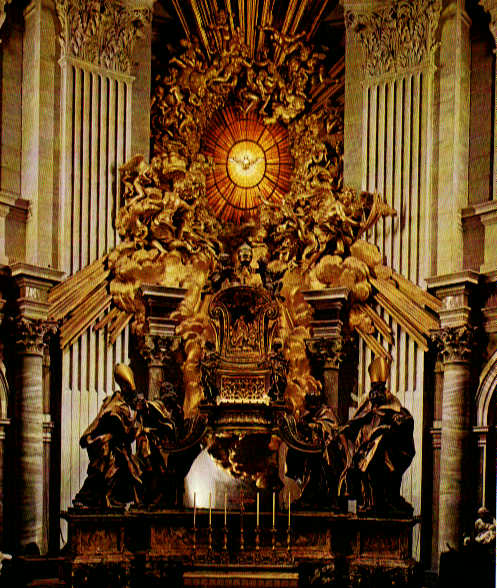
What is the "Chair of St. Peter"? Here are nine answers to that question.
1. What is the Chair of Peter? It depends on what you mean. On the one hand, there is a physical object--an ancient, ornamented chair--located in the apse of St. Peter's Basilica. On the other hand, there is the spiritual authority that this chair represents. Here we will look at both the physical object and the spiritual reality it represents.
2. What is the physical Chair of St. Peter? This object--known as the Cathedra Petri (Latin, "Chair of Peter")--is located in the apse of St. Peter's Basilica. It is in the back of the chamber, behind the famous altar, on the far, back wall, below the well-known, stained glass image depicting the Holy Spirit as a dove. This display contains an ancient chair that has been repaired and ornamented over time. The Catholic Encyclopedia states of the original chair: The seat is about one foot ten inches above the ground, and two feet eleven and seven-eighths inches wide; the sides are two feet one and one-half inches deep; the height of the back up to the tympanum is three feet five and one-third inches; the entire height of the chair is four feet seven and one-eighth inches. According to the examination then made by Padre Garucci and Giovanni Battista de Rossi, the oldest portion is a perfectly plain oaken arm-chair with four legs connected by cross-bars. The wood is much worm-eaten, and pieces have been cut from various spots at different times, evidently for relics. To the right and left of the seat are four strong iron rings, intended for carrying-poles, which are set into the legs.
3. How has the chair changed over time? Various modifications have been made to the chair, to repair and ornament it. Most notably, the famous Italian artist/architect Bernini (1598-1680) created the current display. The Catholic Encyclopedia notes: During the Middle Ages it was customary to exhibit [the chair] yearly to the faithful; the newly-elected pope was also solemnly enthroned on this venerable chair. . . . In order to preserve for posterity this precious relic, Alexander VII (1655-67) enclosed, after the designs of Bernini, the Cathedra Petri above the apsidal altar of St. Peter's in a gigantic casing of bronze, supported by four Doctors of the Church (Ambrose, Augustine, Athanasius, Chrysostom).
4. Did St. Peter really sit in this chair? In the early 20th century, the Catholic Encyclopedia stated: We conclude, therefore, that there is no reason for doubting the genuineness of the relic preserved at the Vatican, and known as the Cathedra Petri. However, since that time the fields of history and archaeology have advanced considerably, and, when Pope Benedict addressed the subject in 2006 and 2012, he spoke in a more reserved way, saying: Dear brothers and sisters, in the apse of St Peter's Basilica, as you know, is the monument to the Chair of the Apostle, a mature work of Bernini. It is in the form of a great bronze throne supported by the statues of four Doctors of the Church: two from the West, St Augustine and St Ambrose, and two from the East: St John Chrysostom and St Athanasius [General Audience, Feb. 22, 2006]. The Chair of St Peter, represented in the apse of the Vatican Basilica is a monumental sculpture by Bernini. It is a symbol of the special mission of Peter and his Successors to tend Christ’s flock, keeping it united in faith and in charity [Angelus, Feb. 19, 2012]. He thus placed less emphasis on the archaeological authenticity of the chair than on its spiritual significance.
5. What is the spiritual significance of the feast the Church celebrates on February 22?According to Pope Benedict, "This is a very ancient tradition, proven to have existed in Rome since the fourth century. On it we give thanks to God for the mission He entrusted to the Apostle Peter and his Successors. 'Cathedra' literally means the established seat of the Bishop, placed in the mother church of a diocese which for this reason is known as a 'cathedral'; it is the symbol of the Bishop's authority and in particular, of his 'magisterium', that is, the evangelical teaching which, as a successor of the Apostles, he is called to safeguard and to transmit to the Christian Community. . . . The See of Rome, after St. Peter's travels, thus came to be recognized as the See of the Successor of Peter, and its Bishop's 'cathedra' represented the mission entrusted to him by Christ to tend His entire flock..."
Celebrating the "Chair" of Peter, therefore, as we do today, means attributing a strong spiritual significance to it and recognizing it as a privileged sign of the love of God, the eternal Good Shepherd, who wanted to gather His whole Church and lead her on the path of salvation [General Audience, Feb. 22, 2006].
6. What does the first Scripture reading of the day have to teach us? The first reading for the day is 1 Peter 5:1–4, which reads: So I exhort the elders among you, as a fellow elder and a witness of the sufferings of Christ as well as a partaker in the glory that is to be revealed. Tend the flock of God that is your charge, not by constraint but willingly, not for shameful gain but eagerly, not as domineering over those in your charge but being examples to the flock. And when the chief Shepherd is manifested, you will obtain the unfading crown of glory. This reading introduces the idea of the leaders of God's people as spiritual shepherds, focusing on Christ as the Chief Shepherd. Although Peter is below Christ as His under-shepherd (John 21:15-17), he does not direct attention to himself. Instead, he extends the office of shepherd to the leaders in his audience, revealing to them the way that they are to serve the portions of Christ's flock entrusted to their care--not by lording it over them ("domineering over those in your charge") but by serving in a truly spiritual manner ("being examples to the flock").
The first reading thus serves as instruction in the first place for those who are ordained ministers in Christ's Church but--in an extended way--it serves as instruction for all of us, for we all influence others and should set the same example.
7. What does the responsorial Psalm of the day have to teach us? The responsorial Psalm is taken from Psalm 23:1-6. It also echoes the theme of shepherding. In this case the Lord is identified for the individual believer as "my Shepherd," with the result that "I shall not want" (that is, I shall not lack anything). The whole Psalm thus is taken up into the theme of the day, focusing on the relationship between God as the ultimate shepherd of our souls and we as the individual members of His flock.
8. What does the Gospel reading for the feast have to teach us? The Gospel reading for the feast is Matthew 16:13-19, in which Jesus declares Peter the rock on which He will build His Church.
9. Does the pope have to sit in the physical Chair of Peter to be infallible? No. Although the pope's infallible pronouncements are called ex cathedra (Latin, "from the chair") statements, he does not have to be sitting in the physical chair (which is rather high off the ground in any case). In fact, he doesn't have to be seated at all. He simply has to use the fullness of his authority as the successor of Peter to definitively teach a particular matter pertaining to faith or morals. This use of the full extent of his teaching authority is referred to figuratively, as him speaking "from the chair" of St. Peter. It's a figurative expression, not a reference to the physical object.
Inserted into the Bulletin of February 28, 2016
From Catholic Answers (1993) - Edited by Denise Holguin, Parish Secretary
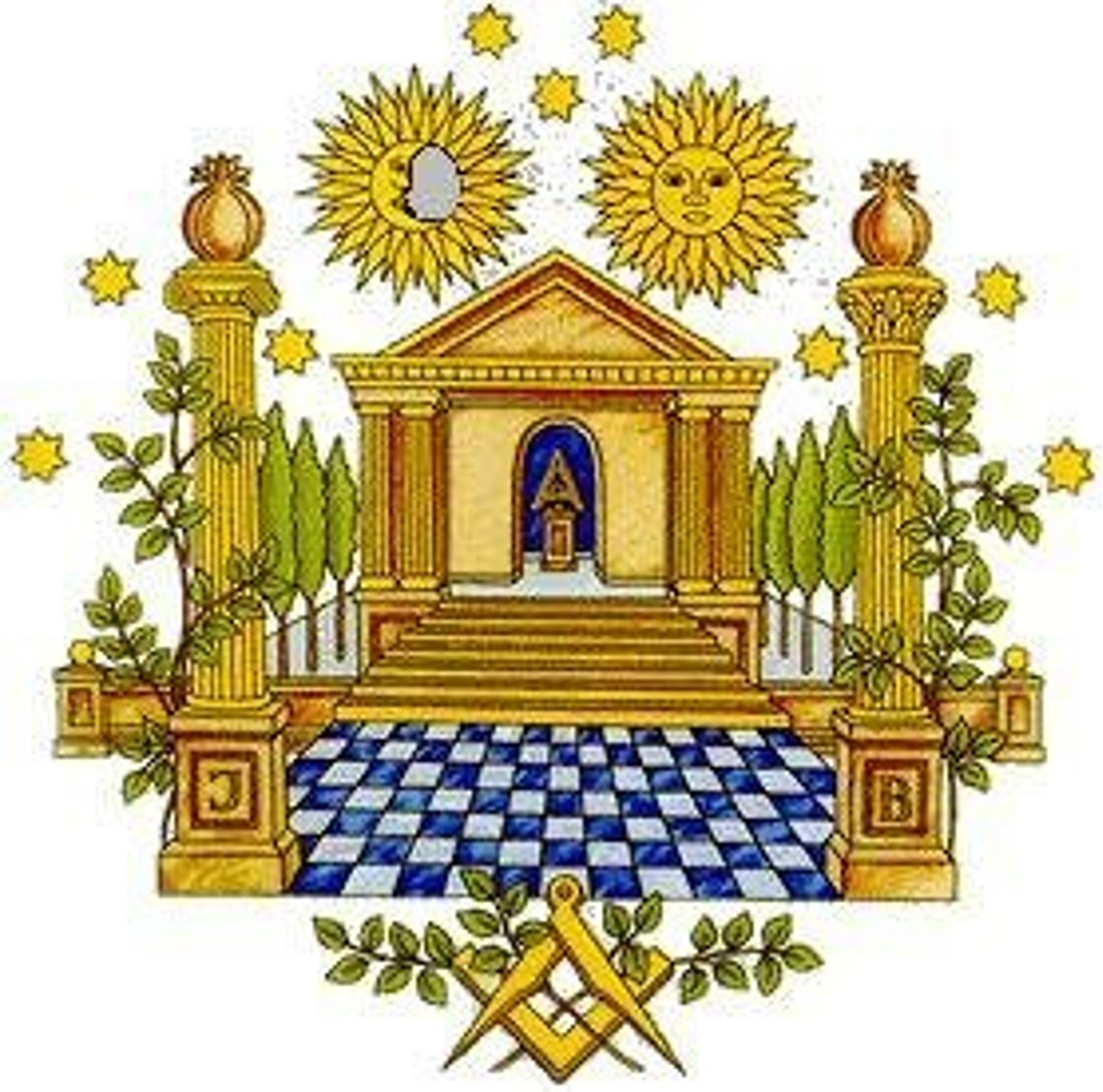
What is Freemasonry? Are Catholics Free to Become Masons?
Freemasonry is a fraternal organization that traces its origins to the loose organization of medieval stonemasonry. Today, in the United States, the Fraternity is divided between fifty-one Grand Lodges (one for each State, plus DC), which have a total membership of just under two million.
Freemasonry is incompatible with the Catholic Faith as it teaches a naturalistic religion that espouses indifferentism, the position that a person can be equally pleasing to God while remaining in any religion. Masonry is a parallel religion to Christianity, displaying all the elements of religion. As such, it becomes a rival to the religion of the Gospel. It includes temples and altars, prayers, a moral code, worship, vestments, feast days, the promise of reward and punishment in the afterlife, a hierarchy, and burial rites.
Historically, one of Masonry's primary objectives has been the destruction of the Catholic Church; this is especially true of Freemasonry as it has existed in certain European countries. In the United States, Freemasonry is often little more than a social club, but it still espouses a naturalistic religion that contradicts orthodox Christianity.
The Church has imposed the penalty of excommunication on Catholics who become Freemasons. This penalty was explicit in the 1917 code of Canon law (Canon 2335), and it is implicit in the 1983 Code (Canon 1374): “… the Church’s negative judgment in regard to Masonic association remains unchanged since their principles have always been considered irreconcilable with the doctrine of the Church and therefore membership in them remains forbidden. The faithful who enroll in Masonic associations are in a state of grave sin and may not receive Holy Communion.”
For Catholic men who would like to join a fraternal organization, the Knights of Columbus is the perfect choice. To join, contact the Grand Knight for the Alhambra Knights, Thomas Quintana, at (626) 863-7061.
Published in the Bulletin of March 20, 2016
by Jimmy Akin
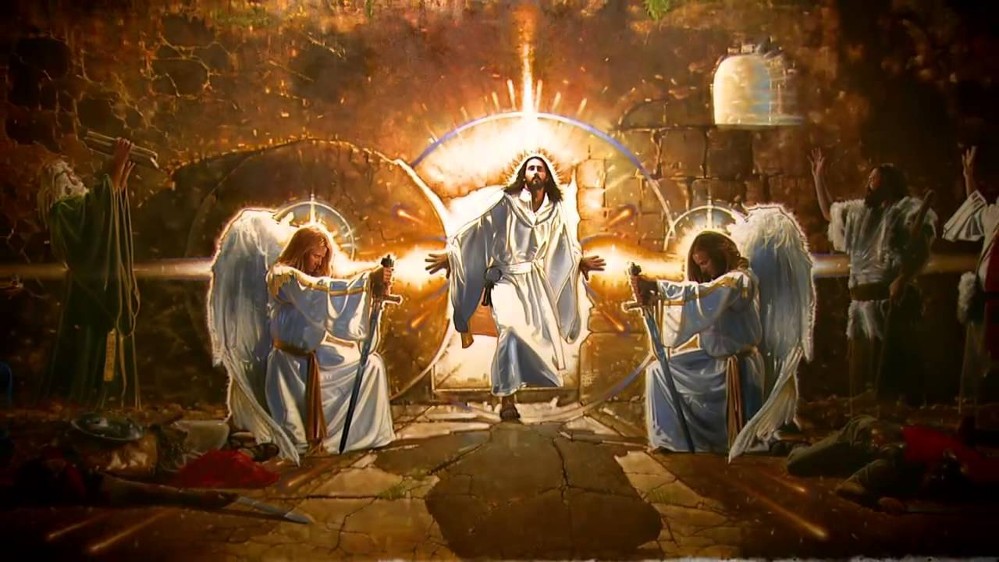
“Is Easter Originally a Pagan rather than a Christian holiday, as shown by its very name and by the fact that its date is determined by the full moon after the Spring equinox?” Anyone making this charge shows a total lack of comprehension of global Christianity. In fact, only a person speaking English or German could even possibly make this charge. First, let’s deal with the date. Easter is the first Sunday after the first full moon following March 21 (historically, the Spring equinox). The reason, however, has nothing to do with paganism. It has everything to do with Judaism and with Christ’s Resurrection.
Christ was resurrected on Sunday—the first day of the week (Matthew 28:1), thus, since the First Council of Nicaea in A.D. 325, all Christians have celebrated His Resurrection on Sunday. Prior to that, most celebrated it on Sunday, but some, known as Quartodecimians (“Fourteenth-ers”), celebrated it on the 14th day of the Jewish month of Nisan, when Passover occurred. At First Nicaea all Christians agreed to celebrate the Resurrection of Christ on the first Sunday after the 14th of Nisan, because that was the day Christ was Resurrected in the first century—the Sunday after Passover.
Because first century Jews used a lunar calendar, every month was twenty-eight days long, beginning with the new moon until the full moon on the 14th of the month. Nisan, being the month in which the Spring equinox occurred, always had Passover—the 14th of Nisan—falling on the first full moon on or after the Spring equinox. Thus since Passover was always on or after the first full moon after the Spring equinox, and since the Resurrection was the first Sunday after Passover, Easter is always the first Sunday after the first full moon after March 21 (historically, the Spring equinox). There is nothing about a pagan lunar celebration in here. It has nothing to do with paganism, but everything to do with the Resurrection of Christ in its Jewish-Passover context.
Now let us deal with the name of Easter. The fact is that there are only two languages in which the name has any pagan associations whatsoever: English and German. This, of course, is a problem for King James “Only-ites,” since the term “Easter” appears in the King James Version in Acts 12:4 as a translation for the Jewish holiday of Passover. In English, of course, the word is “Easter” and in German, “Ostern.” These are related in name to a pagan spring festival, whose name, if you check a dictionary, was derived from the prehistoric West Germanic word akin to the Old English term “east,” which means, simply enough, “east,” the direction of the rising sun. It has nothing to do, contrary to what you will hear from some anti-Easter-ites, with the goddess Ishtar.
But in virtually every language, except English and German, the name of Easter is derived from the Jewish word “Pesach” or “Passover.” Thus, in Greek and in Latin, the term for Easter is Pascha. From there it passed into the Romance languages, and so in Spanish it is Pascua; in Italian, Pasqua; in French, Paques; and in Portugese, Pascoa. It also passed into the non-Romance languages, such as Dutch, where it is Pasen; and Danish, where it is Paaske. Thus only in the highly Protestant countries of Germany (where the Reformation started) and England (where the intense persecution and martyrdom of Catholics was the harshest), does the term “Easter” have any pagan associations at all. So perhaps in these two Protestant countries paganism was not sufficiently stamped out to use the Judeo-Christian term for the celebration of Christ’s Resurrection that was used everywhere else in Europe.
Published in the Bulletin of March 27, 2016 - Easter
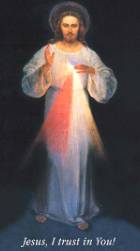
"What is the Divine Mercy Message and Devotion?"
Beginning in February 1931, St. Faustina Kowalski, a Polish nun
reported receiving visitations from Jesus. One of the things He asked
her for was that a painting be made of the vision of His Merciful Heart
and that a Feast of Divine Mercy be established on the first Sunday
after Easter. She also related that Jesus told her, “I
am offering people a vessel with which they are to keep coming for
graces to the fountain of mercy. That vessel is this image (shown to
the right) with the signature: ‘Jesus, I trust in You.’ The two rays
denote Blood and Water. The pale ray stands for the Water which makes
souls righteous. The red ray stands for the Blood which is the life of
souls. These two rays issued forth from the very depths of My tender
mercy when My agonized Heart was opened by a lance on the cross.”
St. Faustina also, in obedience to her spiritual director, wrote a diary of about 600 pages recording the revelations she received. Even before her death in 1938, the devotion to The Divine Mercy had begun to spread. According to St. Faustina’s diary, Our Lord promised that all those who would receive Him in Holy Communion and go to Confession on the Sunday after Easter “shall obtain the complete forgiveness of sins and punishment.” The message and devotional practices proposed in the Diary of Saint Faustina are completely in accordance with the teachings of the Church and are firmly rooted in the Gospel message of our Merciful Savior. Properly understood and implemented, they will help us grow as genuine followers of Christ. When St. John Paul canonized her in 2000, he proclaimed that the Second Sunday of Easter would be known from then on as Divine Mercy Sunday, thereby widely promoting the devotions associated with Faustina’s visions.
The message of The Divine Mercy is simple. It is that God loves ALL of us, and He wants us to recognize that His mercy is greater than our sins, so that we will call upon Him with trust, receive His mercy, and let it flow through us to others. Thus, all will come to share His joy. We can recall the message to mind simply by remembering ABC: A - Ask for His Mercy. God wants us to approach Him in prayer constantly, repenting of our sins and asking Him to pour His mercy out upon us and upon the whole world; B - Be merciful. God wants us to receive His mercy and let it flow through us to others. He wants us to extend love and forgiveness to others just as He does to us; C - Completely trust in Jesus. God wants us to know that the graces of His mercy are dependent upon our trust. The more we trust in Jesus, the more we will receive.
By Fr. Philip Sullivan, O.C.D. (Pastor of St. Therese Church)
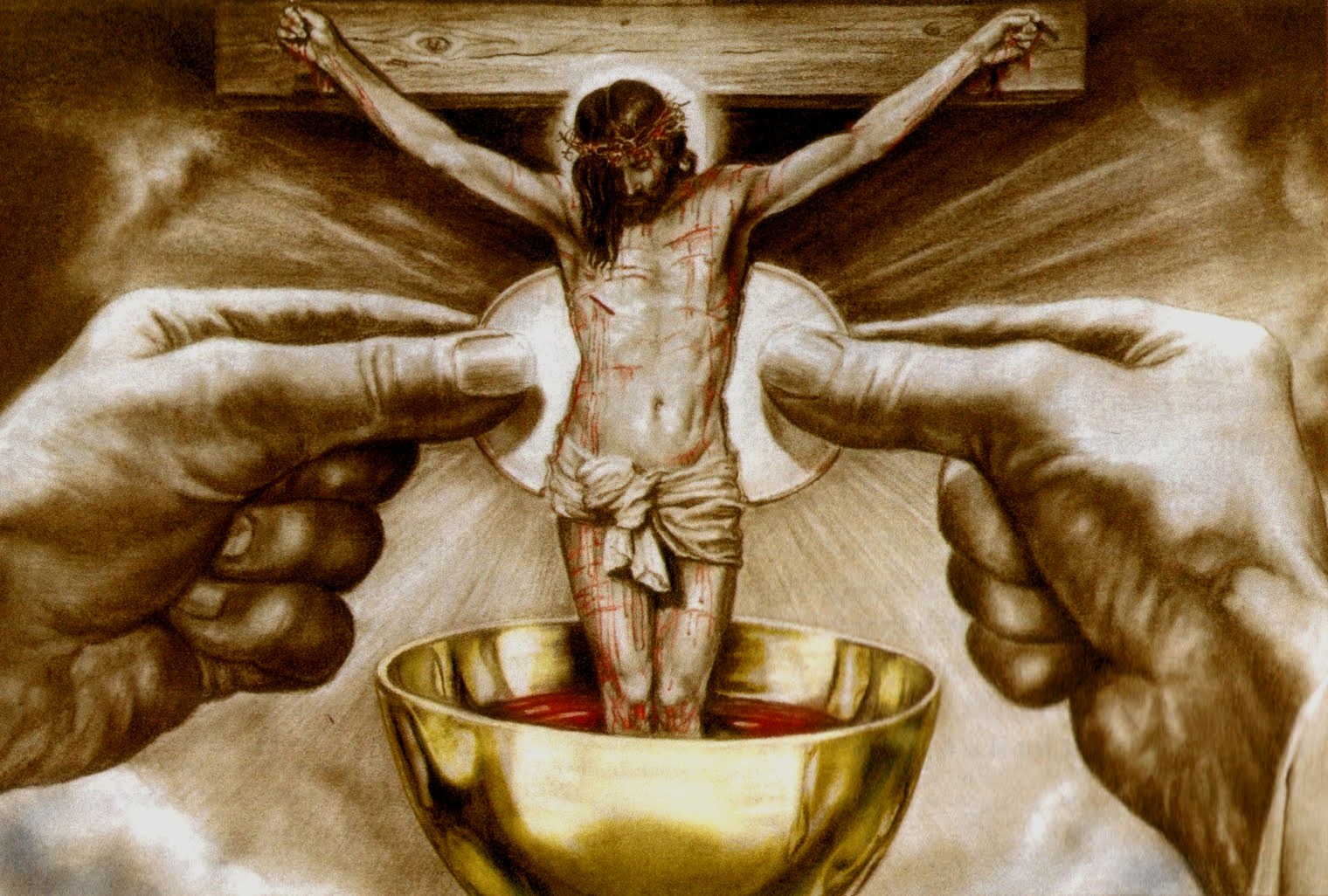
We refer to many people and things as holy based on this definition of being set apart. Catholic churches, too, are set apart and are holy places, not because of their beauty but because of what Catholic churches contain, the Eucharist:
THE BODY, BLOOD, SOUL, AND DIVINITY
OF OUR LORD AND SAVIOR, JESUS CHRIST.
Faithful Catholics come to this holy place every week to celebrate and recall the Betrothal event of Calvary, which began with a Supper and ended with the consummating and sacrificial love of Jesus, the Bridegroom, once and for all on the Cross. The holy hour we spend at Mass is time we set apart from all other time so that we may become what we receive, the Eucharist. Both time and space are set apart for a specific action and for a specific purpose, the Eucharist. We then become set apart and unite our worship with the Eternal Banquet which Christ promises to those who “eat His Flesh and drink His Blood” (John 6:53). In order to hear what God is communicating to us in the intimate reception of Holy Communion, like a bridegroom whispering sentiments of love to his bride, we have to allow for silence.
Do you come to Mass to fulfill an obligation? Hopefully not! We do not celebrate Mass to fulfill an obligation but rather to have an encounter with the Resurrected Christ—as did Mary Magdalene, Peter, Thomas, the men on the road to Emmaus, and many others. We can be sure that all, with the exception of the Blessed Virgin Mary, had sinful lives prior to experiencing the mysterious presence of Jesus in His Glorious Resurrection. Hopefully, we attend Mass with the same burning desire as Mary Magdalene had when she ran to the Open Tomb of Christ, or when Peter and John raced each other to the Open Tomb of Christ! Running to Mass on Sundays and Holy Days is not just an obligation; rather, we run to Mass, the Open Tomb of Christ, because it is our duty and our salvation to experience the Resurrected Christ in His Flesh and Blood, the Eucharist!
Does it surprise you that so few of Our Lord’s disciples actually went to the Open Tomb of Christ? Would it surprise you to know that roughly 30% of the 69.5 million Roman Catholics living in the United States believe in the True Presence of Jesus in the Holy Eucharist? At St. Therese Carmelite School, 30% would get you a big, fat "F"! We are FAILING to live out what Christ expects from His disciples when we do not attend Mass on Sundays and Holy Days. However, 70% of doubters seems consistent with the majority who walked away from Our Lord during the “Bread of Life Discourse” (John 6:22-59), the few who stood at the Cross of our Lord’s Crucifixion (Matthew 27:32), and the few who ran to the Open Tomb of Christ (John 20:1-18). While 2,000 years have passed and many claim to be Christian, it seems too few Catholics have the burning desire to run to Mass (the Open Tomb of Christ) to experience the Resurrection in the Eucharist. It would seem that 70% of our Lord’s “friends” are too busy or too bored to follow His instruction: “Do this in remembrance of Me” (1 Corinthians 11:24); (Luke 22:19). His words spoken to the Apostles should shake us to the core: “Will you leave also?” (John 6:67).
Mass is the holy event which requires us to check our degrees at the door, to turn off the world, and to humbly and sincerely surrender to God’s Love. We must realize that the Eucharist elevates us beyond what is popular reasoning and beyond our own limited ability to comprehend the Presence of Jesus in the Eucharist. In order to receive the physical presence of Our Lord in the Eucharist, we must first run to the Open Tomb of Christ every Sunday—or every day if you can!—and then humbly pray the words of St. Thomas, the Doubting Apostle, “My Lord and my God!” (John 20:28).
God’s unselfish Love is victorious! Death has NO power over this Love. This Love is communicated at every Mass in the whispering words of the Bridegroom at Consecration: “This is My Body”. . . “This is My Blood” (Luke 22:15-20). This Love is offered in the joyful Resurrection of Jesus the Bridegroom and must be humbly received by His faithful Bride, the Church. Thus, Jesus Christ in the Eucharist sets us apart, allowing us to become what we consume, to become holy because “the Lord God is holy” (Leviticus19:1). What is your response? Are you one of the 30% who run to the Open Tomb of Christ every Sunday to encounter the Resurrected Lord in the Eucharist? Or are you part of the 70% who are perhaps too busy or too bored?
“For He has risen, just as He said. Come and see
where the Lord was placed” (Matthew 28:6).
Published in the Bulletin of April 10, 2016
By Rhonda Storey
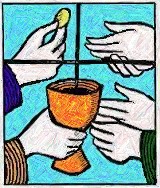
The Church does permit the use of Extraordinary Ministers of
Holy Communion under certain circumstances. The Catechism, quoting the
Code of Canon Law [can. 230 § 3], states: “When the necessity of the
Church warrants it and when Ministers are lacking, lay persons … can
also … distribute Holy Communion in accord with the prescriptions of
law” (no. 903).
INSTITUTED ACOLYTES
In 1972, Pope Paul VI revised several ministries and minor clerical orders. One ministry that was preserved was the ministry of the Instituted Acolyte. While the term acolyte is at times used when referring to young men and women who assist at the altar (altar servers), the ministry of Instituted Acolyte is a permanent institution. Because the ministry has its roots in the formation of ordained clergy, the ministry is reserved to men. The Instituted Acolyte is appointed to assist the deacon and serve the priest in the celebration of the liturgy.
As of the writing of this article on April 10, 2016, both Peter Pham and Gil Vargas serve as our Instituted Acolytes.
bishops, priests, or deacons. If such Ordinary Ministers of Holy Communion are not present, "the priest may call upon Extraordinary Ministers to assist him, i.e., duly instituted acolytes or even other faithful who have been delegated for this purpose. In case of necessity, the priest may also delegate suitable faithful for this single occasion (GIRM 162)."
Extraordinary Ministers of Holy Communion should receive sufficient spiritual, theological, and practical preparation to fulfill their role with knowledge and reverence. In all matters they should follow the guidance of the Diocesan Bishop (Norms for the Distribution and Reception of Holy Communion Under Both Kinds for the Dioceses of the United States of America, NDRHC, no. 28). All Extraordinary Ministers of Holy Communion should show the greatest reverence for the Most Holy Eucharist by their demeanor, their attire, and the manner in which they handle the consecrated Body or Blood [ GIRM, 280]." (NDRHC, 29).
Serving at St. Therese: Here at St. Therese, we use Extraordinary Minister (E.M.) Communion tags. Fifteen minutes prior to each Mass, each Minister should go to the Sacristy vestibule to sign in and retrieve the assigned tag. If you haven’t picked up your tag before Mass, the Sacristan will give your assignment and tag to another Minister. It is important to arrive early to Mass, be dressed appropriately and modestly—without distracting jewelry or flashy nail polish. You should also be wearing an E.M. tag. Wearing the tag is very important because it keeps the correct number of Extraordinary Ministers. The bigger Masses, such as the Holy Triduum Masses, Confirmation, Ordinations, Christmas, and special Solemnity Masses, use all attending clergy (Ordinary Ministers) and Confirmed Acolytes first. Sometimes the older adult Altar servers are also Ministers so the congregation cannot see the count that the Sacristan is using. Also, in the case of Good Friday, only Hosts are distributed, no Cups. If you are attending one of these larger Masses or see extra Concelebrants, a Bishop, or several priests on the Altar, please see the Sacristan in the back first before going into the Sanctuary as an E.M. If the tags are not hanging in their spots, that’s also an indication that something different may be going on and you should check in with the Sacristan first.
After Communion, ciboriums are to be placed only on the Altar, but Communion cups and patens are to be taken into the Marian chapel for purification by a priest or deacon. Any remaining Precious Blood can be consumed by an E.M., but ONLY in the chapel, NEVER in the body of the Church in view of the congregation. If a minister cannot consume remaining Precious Blood, he or she should place the pacificator over the chalice and let the Sacristan know.
Rome Has Spoken: In a 1987 letter to Archbishop John L. May, Apostolic Pro-Nuncio Pio Laghi conveyed the directives of Cardinal Paul Augustin Mayer, head of the Vatican Congregation of Sacraments: “To be sure, the faculty granted to the laity enabling them to distribute Holy Communion as Extraordinary Ministers of the Eucharist (Canons 230 §2; 910 §2) represents without a doubt one of the most suitable forms of lay participation in the Church’s liturgical action. On the one hand, this privilege has provided a real help to both the celebrant and to the congregation on occasions when there exists a large number of people receiving Holy Communion. On the other hand, however, in certain instances, significant abuses of this privilege have taken place. Such abuses have led to situations where the extraordinary character of this ministry has been lost. At times, it also appears as though the designation of Extraordinary Ministers becomes a kind of reward to repay those who have worked for the Church; but in fact it is a privilege and an honor and not a right.”
Liturgy of the Eucharist: As the Agnus Dei or Lamb of God is begun, the Bishop or priest alone, or with the assistance of the deacon, and, if necessary, of concelebrating priests, breaks the Eucharistic Bread. Other empty ciboria or patens are then brought to the altar as necessary. The deacon or priest places the Consecrated Bread in several ciboria or patens, if necessary, as required for the distribution of Holy Communion. If it is not possible to accomplish this distribution in a reasonable time, the celebrant may call upon the assistance of other deacons or concelebrating priests.
If Extraordinary Ministers of Holy Communion are required by pastoral need, they should not approach the altar before the priest has received Communion. After the priest has concluded his own Communion, he distributes Communion to the Extraordinary Ministers, assisted by the deacon or concelebrant. After all Extraordinary Ministers of Holy Communion have received the Eucharist, the bishop or priest celebrant reverently hands vessels containing the Body or the Blood of the Lord to the deacons or Extraordinary Ministers who will assist with the distribution of Holy Communion. The deacon may assist the priest in handing the vessels containing the Body and Blood of the Lord to the Extraordinary Ministers of Holy Communion (NDRHC, 40).
The proper and only permissible form for distributing Holy Communion is to offer the consecrated Hosts by saying, "The Body of Christ" and to offer the consecrated wine by saying, "The Blood of Christ." No other words or person’s names should be added; and the formula should not be edited in any way (GIRM, 161; 284-287).
If a Host or some particle of it falls, it should be picked up reverently by the minister. The Host may be consumed or completely dissolved in water before being poured down the sacrarium. Should there be any mishap, for example, if the consecrated wine is spilled from the chalice, the area should be washed and the water poured into the sacrarium.
The sacred vessels are to be purified by the priest, the deacon or an Instituted Acolyte. The amount of wine to be consecrated should be carefully measured before the celebration so that none remains afterward. It is strictly forbidden to pour the Precious Blood into the ground or into the sacrarium. (NDRHC, 51-55). Similarly, "Consecrated Hosts are to be reserved in a ciborium or vessel in sufficient quantity for the needs of the faithful; they are to be frequently renewed and the old hosts properly consumed" (Code of Canon Law, No. 939). Burying Hosts or Consecrated Eucharistic Bread is strictly forbidden.
Published in the Bulletin of April 10, 2016
"How Does One Serve as an "Extra-Ordinary" Minister of Holy Communion?"
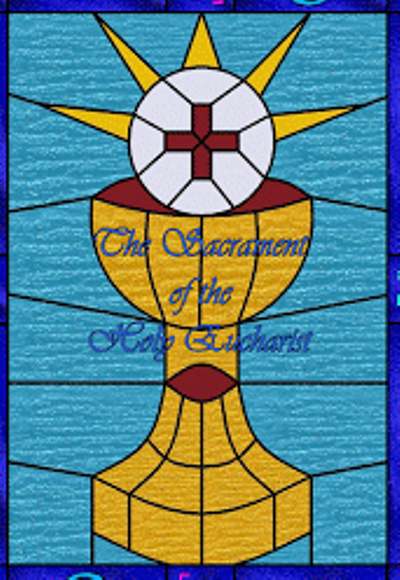
"How Does One Serve as an 'Extra-Ordinary' Minister of Holy Communion?" Notice the title, “EXTRA-Ordinary Minister” of the Eucharist. This title means that we are EXTRA Ministers, and that the Priests, Deacons, and any visiting clergy are the ORDINARY Ministers of the Eucharist. If additional Ministers are needed because there are not enough ordained clergy to
distribute the Eucharist in a timely and orderly manner, the laity are
assigned as EXTRA-ORDINARY Ministers. We, as the laity who serve at the
altar, must be careful that we do not refer to ourselves as Ordinary
Ministers as that is the title reserved only for Clergy.
In 1978 the Bishops of the United States voted to extend permission for the congregation to receive the Eucharist under both species—the Bread and the Wine—at Sunday and Holy Day Masses. This welcomed change has increased the need for “Extra-Ordinary Ministers” in the sharing of Communion. I have been privileged to have been a part of this ministry for over twenty years. I feel extremely blessed to share in this ministry because God unites the Extraordinary Ministers of the Eucharist to the members of the Congregation, into the Body of Christ through our Baptism.
When the Minister says, “The Body of Christ” or “The Blood of Christ,” our proper response should be, “AMEN,” which literally means, “I BELIEVE!” or “SO BE IT!”.
Prayer for Extraordinary Ministers of Holy Communion
Jesus, bless these hands you have chosen as your tools.
Jesus, always keep me aware and in awe of this sacred mission.
Jesus, make me worthy of this great ministry I have humbly accepted.
Jesus, send me out into the world to distribute your Love. Amen.
As an Extraordinary Minister, it saddens me when members of the congregation do not respond with AMEN. This is why you have come to this celebration, not to socialize with the Extraordinary Minister standing in front of you, but to give full honor and glory to Our Lord in His Precious Body and Blood. We are to treat Our Lord’s Body and Blood with dignity and respect, as it truly is His Body and Blood. Holy Communion is the gift of receiving the Lord Jesus. You are not given a wafer to handle as you would a cookie or to chew as a piece of gum! No! It is the Body, Blood, Soul, and Divinity of Jesus Christ! The Cup from which you sip contains the Consecrated Blood of Christ Crucified. His Blood is NOT a “terrible-tasting wine”—as one of our parishioners says on a regular basis! Scandalous!
The Eucharist is the Real Presence of our Crucified Lord and Savior. After receiving Holy Communion and returning to your pew, kneel down to say prayers of Thanksgiving. One should certainly not leave church immediately after receiving! Jesus Christ has given us so much in this Eucharistic Celebration that we should give Him our utmost respect and love before, during, and after our reception of Holy Communion.
Suggested Prayer Form
After Receiving Holy Communion:
When a Communicant has the Lord within him or her, it is vitally important to spend time praying. To help you be focused, use the letters in the word ALTAR:
A = Adore; L = Love; T = Thank; A = Ask; R = Resolve.
This will help to remember to tell God how and why you Adore and Love Him; to Thank Him for His gifts and graces and express gratitude for His life on earth and for His Passion, Death, and Resurrection, etc.; to Ask Him for whatever you need; and to tell Him that you Resolve to follow Him and obey Him, etc. This prayer form is especially useful if you are feeling distracted or preoccupied.
By Fr. William Saunders
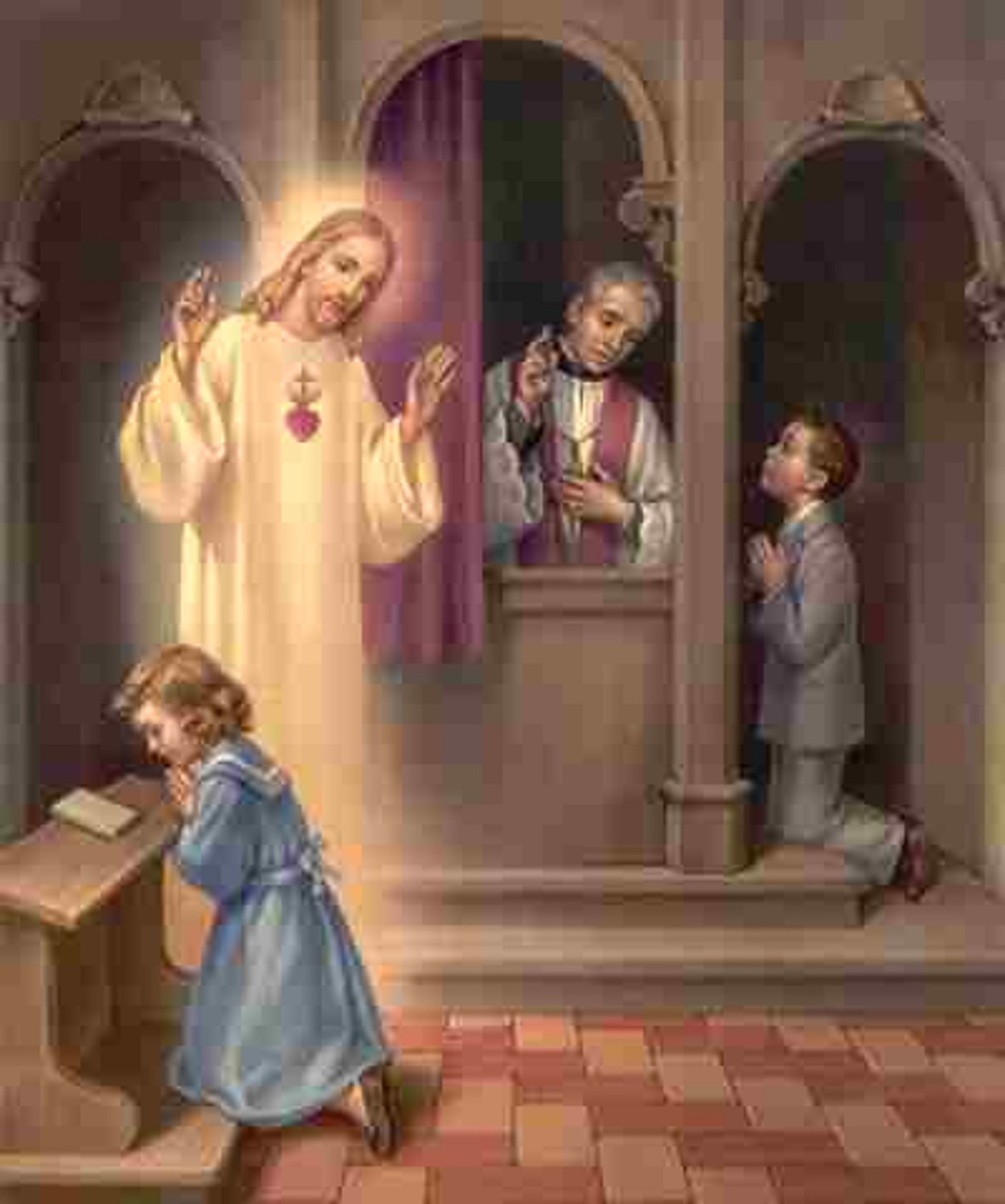
"Is the Sacrament of Confession Scripture-Based?" Some of my Protestant friends have asked why Catholics go to confession and if it is Scripture-based. What would you say?
Jesus entered this world to forgive sins. Recall the words of our Lord: "God so loved the world that He gave His only Son, that whoever believes in Him may not die but may have eternal life" (Jn 3:16). During His public ministry, Jesus preached about the forgiveness of sins; for instance, in the parables of the Prodigal Son (Lk 15:11) or the Lost Sheep (Lk 15:1).
Remember also His teaching that, "There will likewise be more joy in heaven over one repentant sinner than over 96 righteous people who have no need to repent" (Lk 15:7). Jesus Himself forgave sins; remember the story of the woman caught in adultery (Jn 8:1) or the woman who washed His feet with her tears (Lk 7:36). He also taught us to pray for forgiveness in the "Our Father". His mission of reconciliation would climax in His Passion, Death and Resurrection: Jesus suffered, died and rose to free us from sin and death.
However, Jesus never trivialized sin or rationalized it. No, for Jesus, sin is sin, a violation of love against God and neighbor. However, in His Divine Mercy, Jesus called the sinner to realize the sin, to repent of it, and to be reconciled with God and neighbor. Jesus wanted this ministry of reconciliation to continue. On the first Easter Sunday evening, Jesus appeared to His Apostles, "breathed on them," and said, "Receive the Holy Spirit. If you forgive men's sins, they are forgiven them; if you hold them bound, they are held bound" (Jn 20:21-23). Only twice in Sacred Scripture do we find God breathing into human beings. First, in the Genesis account of creation, God breathes the life of a soul into the man He has created (Gen 2:7). Now, Jesus the Son, breathes His life into His Apostles, His priests, so that through them He will "breathe" life into the souls of contrite sinners. In this scene, Christ instituted the Sacrament of Penance and made His Apostles the ministers of it. At the Ascension, Jesus again charged His Apostles with this ministry: "Thus it is written that the Messiah must suffer and rise from the dead on the third day. In His name penance for the remission of sins is to be preached to all the nations, beginning at Jerusalem. You are witnesses of this" (Lk 24:46). Clearly, Jesus came to forgive sins. He wanted that reconciliation to continue and He gave the Church a Sacrament through which priests would continue to act as the ministers of this reconciliation.
Perhaps many Protestants do not see the need for confession to a priest or minister because most Protestant denominations do not have Sacraments or at least the understanding of Sacraments as efficacious signs through which the Lord gives us grace. (However, traditional or "high" Episcopalians have confessions; the Lutherans also have a ritual for reconciliation.) Nevertheless, we see this ministry of reconciliation lived out in the early Church. St. Paul wrote, "God has reconciled us to Himself through Christ and has given us the ministry of reconciliation" (2 Cor 5:18). The Didache (or Teachings of the Twelve Apostles), written about 80 AD, stated, "In the congregation you shall confess your transgressions" and "On the Lord's Day, come together and break bread...having confessed your transgressions, that your sacrifice may be pure." St. Cyprian wrote, concerning the reconciliation of Christians who had succumbed to offering pagan worship rather than face martyrdom, "Let each confess his sin while he is still in this world, while his confession can be received, while satisfaction and the forgiveness granted by the priests is acceptable to God." At this time of persecution, when local "parishes" were small, individuals publicly confessed their sins at the beginning of Mass (as mentioned in the Didache) and received absolution from the bishop or priest.
After the legalization of the Church by Constantine, the Church Fathers continued to emphasize the importance of confession. St. Ambrose wrote, "It seemed impossible that sins should be forgiven through penance; Christ granted this power to the Apostles and from the Apostles it has been transmitted to the office of priests." Similarly, St. Athanasius asserted, "As the man whom the priest baptizes is enlightened by the grace of the Holy Ghost, so does he who in penance confesses his sins, receive through the priest forgiveness in virtue of the grace of Christ." By the mid-400s and the pontificate of Leo I, private confession under the seal of secrecy becomes the norm to safeguard the reputation of the penitent and to attract others to the sacrament. We go to confession because it is a sacrament given to us by Christ, and it has always been a Church practice.
This Sacrament is so important in our sharing in the life of Christ, the Church has even mandated its practice. To prevent laxity, the Fourth Lateran Council in 1215 required that "the faithful who have reached the age of discretion should at least once a year faithfully confess all their sins to a priest. They should strive as far as possible to fulfill the penance imposed on them, and with reverence receive at least during Easter time the sacrament of the Eucharist." This rule is still a precept of the Church. The Council of Trent in 1551, in its Doctrine on the Sacrament of Penance, asserted that since mortal sin "kills" the life of God in our souls, these sins must be confessed and absolved through the Sacrament of Penance. Trent also said, "it is right and profitable" to confess venial sins.
We could end the answer here. However, regular confession is a healthy spiritual practice. Each sincere Catholic needs to periodically—every month or two—do a good examination of conscience. Each person should reflect on how well he has lived a "Christ-like life" by following the commandments and the teachings of the Church. Perhaps one's failures are not so much commissions as they are omissions. For all of these, we bring our souls to the Lord and receive forgiveness. The healing grace of the Sacrament of Penance washes away sin and give us the strength to avoid that sin again.
(Additional information can be found in Article No. 30, published in the St. Therese Bulletin of September 6, 2015)
Published in the Bulletin of April 16, 2016
By Ruben Beltran
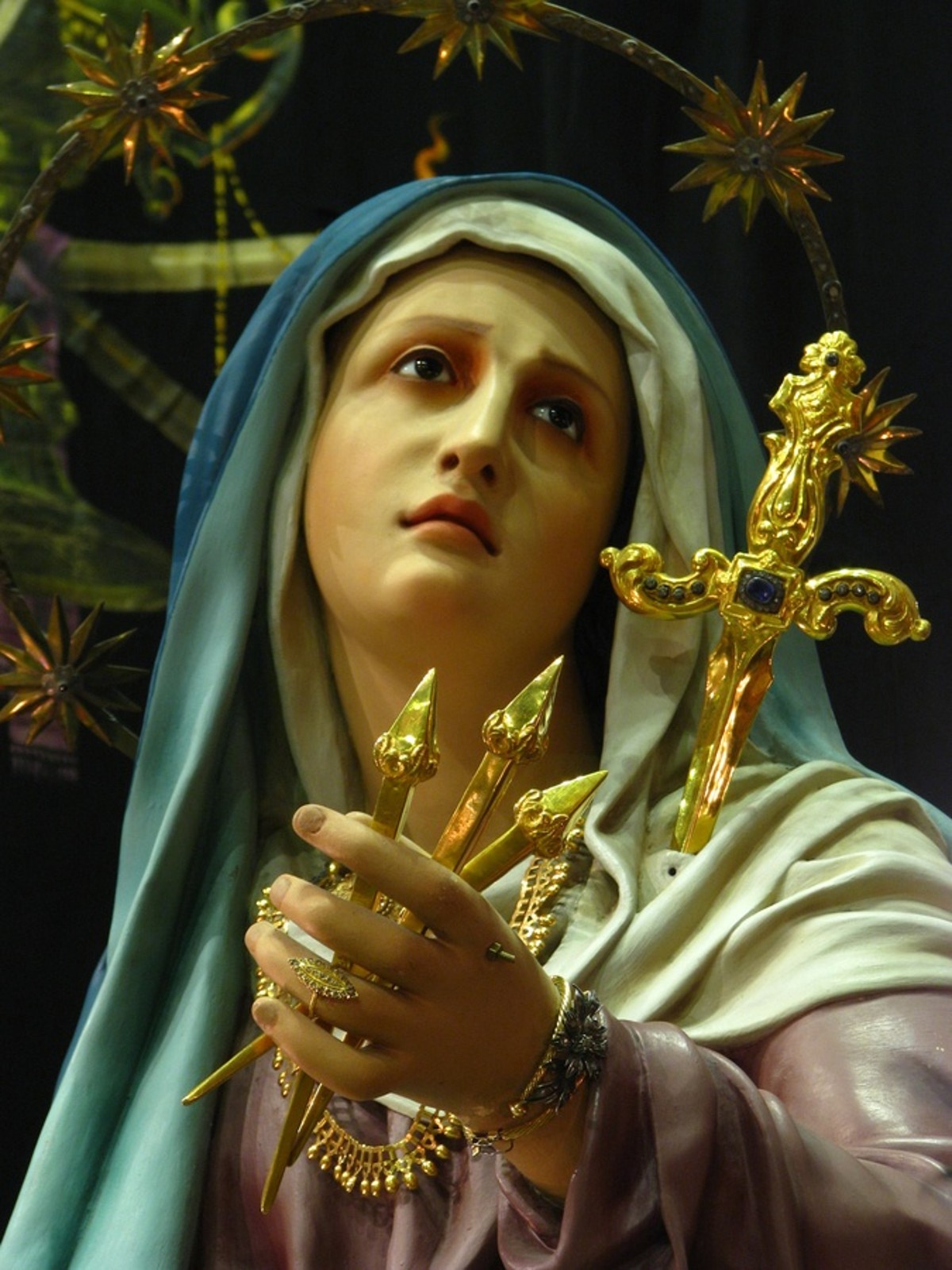
"Did Mary Have Knowledge of Christ's Divinity?"
“Mary, Did You Know?”
is a popular song written by Mark Lowry that seems to question Mary’s
knowledge of Christ’s divinity. Unfortunately, there have been many
songs and movies that portray Mary—and sometimes even Christ Himself—as
ignorant of what their roles are in God’s plan, as in the recent film,
“The Young Messiah”. So, what did Mary know about Jesus, after being told by an angel that she would bear the Son of God?
The Catholic Church has always taught that the Holy Spirit revealed to Mary who her Son was and all He would accomplish. Simeon’s prophecy perhaps informed her (if she didn’t know it already) of another aspect of her role as the Mother of God: that a sword would pierce her heart (Luke 2:25–35). There are countless verses in Scripture which show that Mary and Christ had full knowledge of what their roles were in God’s divine plan.
As Fr. William Most writes in his book, Mary in Our Life, "The traditional view holds that Mary knew that Christ was divine at the time of the Annunciation. This view is still held today by not only the best theologians, but also by the best Scriptural scholars. Would God ask her to consent in the name of the whole human race, and still withhold from her knowledge of that to which she was consenting? We are not permitted to give Holy Communion to children who do not know what they are receiving. Would Mary be given this far greater Communion in ignorance of what she was receiving? She did know that her Son was divine.”
Dave Armstrong continues this train of thought in his book, "The Catholic Mary" Quite Contrary to the Bible?”, saying, "After the Angel Gabriel told the Blessed Virgin in the Annunciation, Mary’s knowledge of Christ’s divinity from that time on is, therefore, an explicitly biblical teaching: 'He will be great and will be called the Son of the Most High; and the Lord God will give to Him the throne of David … and of His Kingdom there will be no end… the Child to be born will be called holy, the Son of God’ (Luke 1:32–35). Apart from the Messianic implications, it can be shown that the Messiah was divine, through cross-referencing in the Old Testament alone; for example, Isaiah 9:6–7, the fact that Jesus was called (by an archangel) Son of God was sufficient to establish His deity or divinity or Godhood. We know this from John 5:17–18 where Jesus called God the Father ‘My Father.’ The Jews then sought to kill Him for blasphemy, because, as St. John tells us, He ‘called God His own Father, making Himself equal with God’ (5:18). This is how ‘Son of God’ was understood in the Jewish mind. Roughly the same thing occurs again in the record of John 10:22–33 (and at that time He also added ‘I and the Father are One’—10:30).
"Neither Jesus nor Mary ‘grew in awareness’ or ‘gradually figured out’ Who He was. Such a teaching is theological liberalism and heterodoxy. Jesus knew all along what would happen (including His Resurrection; see, for example, Matthew 16:21–23; Mark 8:31–33; and Luke 9:21–22). The Gospels present one harmonious presentation of Jesus: the real Jesus of verifiable history. The four accounts complement each other. Furthermore, Mary’s knowledge was ‘confirmed’ when she visited Elizabeth, mother of John the Baptist, who called her the ‘Mother of my Lord’ (Luke 1:43). Right after that passage, we see Mary praising God in the famous Magnificat (Luke 1:46–55), because she was to be the Mother of the Son of God, the Messiah, God the Son, God Incarnate—which is precisely why she has been called ‘blessed’ (Luke 1:48). She quite obviously knew all this. It’s spelled out as clear as it could be. Even beyond that, we have the words of Simeon to Joseph and Mary when they presented Jesus in the Temple (Luke 2:22–35). One might point out in retort that Mary and Joseph were ‘amazed’ at these words (2:33), but that could just as easily refer to their amazement that Simeon had this knowledge and word from the Lord; rather than the content of his message. The prophetess Anna also appeared in the Temple at that time and spoke about Jesus’ Messianic mission (Luke 2:36–38). So not only did Mary and Joseph know full well Who Jesus was, so would all who heard (and believed) her words or Simeon’s.
"Moreover, there was the preaching of John the Baptist and the knowledge of the Magi (Matthew 2:1–6, 9–11). Their knowledge that Jesus was Messiah was precisely what caused Herod to try to kill all the infants, so as to kill the Messiah (Matthew 2:7–8, 16–18). Lastly, Joseph was told by ‘an angel of the Lord’ in a dream Who Jesus was, and that ‘He will save His people from their sins’ and that one of His names would be ‘Emmanuel,’ which means ‘God is with us’ (Matthew 1:18–25). Yet some would, nevertheless, have us believe that Mary—the very one whom an angel visited to announce the Virgin Birth and Incarnation—did not know what many others already knew either before or soon after Jesus’ birth. It makes little sense—even considered apart from all this biblical data—to think that Mary’s celebrated ‘yes’ or ‘fiat’ to the angel’s glorious announcement (Luke 1:38) was made without having the slightest (or only dim) idea of what she was consenting to.”
So, in response to the question, "Mary, did you know?," yes, yes she did know. So, please, stop asking her! :-)
Published in the Bulletin of April 24, 2016
By Fr. Ryan Erlenbush
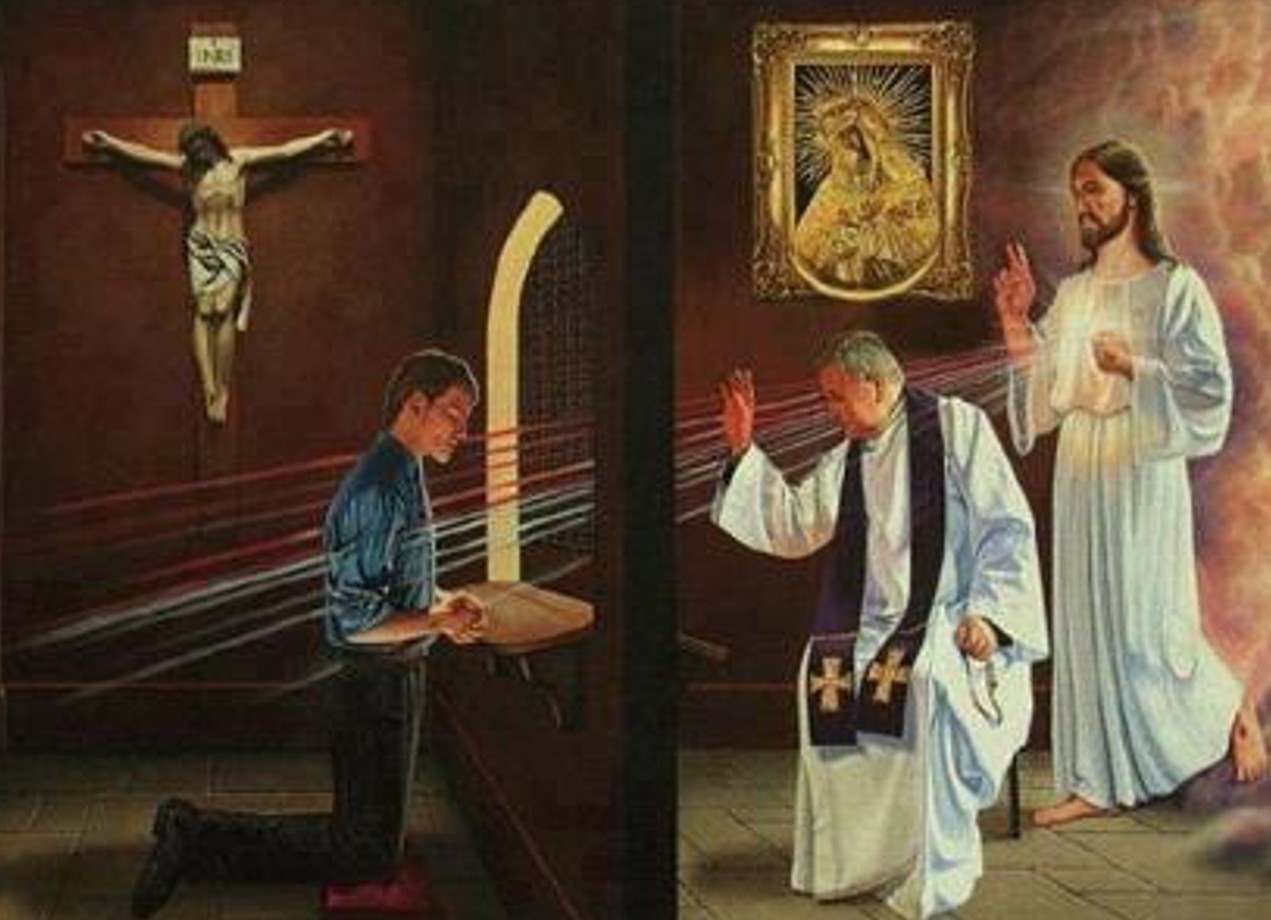
Still, we simply must admit that confession is not spiritual direction proper and there is the realistic fact of time constraints. What will be necessary, then, is to discuss the occasions in which it is appropriate (and perhaps even obligatory) for the priest to give some spiritual counsel to the penitent without taking on the role of a therapist.
Answering the penitent’s questions: Certainly, there will be times when the penitent has a question regarding the seriousness of a sin, or even as to whether a particular act is a sin at all. While the priest must be careful to keep the confession from turning into a simple conversation, a truly pastoral zeal should lead him to answer questions simply and directly. Penitents need to be cognizant of those who are also in line for Confession.
Directing the penitent toward contemplation: It is the opinion of St. Alphonsus and of the best of the doctors of the spiritual life that the confessor ought at least occasionally to question the penitent regarding his interior life and, generally, to offer at least some advice, direction, and encouragement. When a penitent has overcome mortal sin and is generally living in the state of grace, it will be essential to his spiritual growth that he begin to practice regular meditation; for instance, the Rosary. Likewise, as the soul grows into closer union with God, the Savior will lead the penitent more and more toward contemplative prayer: thus, the faithful servant of Christ will eventually be brought into the dark night of the senses (on the verge of the purgative and illuminative ways). At this time, especially, it will be necessary for the confessor to question and advise the penitent regarding personal prayer. St. Alphonsus states that the confessor is a father, a physician, a teacher, and a judge. Especially in his role as father and teacher, the confessor must be ready and willing to direct the penitent through periods of spiritual dryness and toward the life of contemplation. Here, we must mention that the good confessor will move the soul toward contemplation neither too quickly nor too slowly.
Confession as a universal avenue of spiritual direction: It is said that St. John Vianney could hear the confessions of grave sinners who had spent years away from confession in not much more than ten minutes. Certainly, most priests will not be quite so wise as the Curé, hence we should not be surprised if a confession occasionally takes more time. Still, in general, we can safely say that the questioning and directing of penitents should not usually be a grave burden on either priest or people. In any case, the lay faithful generally want the direction of a holy priest–and they deserve this guidance, since Christ has entrusted the duty of pastoring souls specifically to priests. Therefore, it will be necessary for priests to give some level of (informal) spiritual direction to penitents in the confessional.
In
Conclusion: Following the direction of St. Alphonsus, it does not seem
that a confession should take much time at all. Indeed, though the
priest should always give some little bit of advice or encouragement,
this should never devolve into a simple conversation as this would be
quite disrespectful of the Sacrament itself. Moreover, the level of
"spiritual direction" appropriate for the confessional is still quite
minimal. Spiritual direction is more appropriate and thorough when done
so through an appointment. A proper “Examination of Conscience” and
prayerful readiness should be completed before entering the
confessional. Remember 1st Corinthians 11:29: “...because whoever eats and drinks without recognizing the Body, eats and drinks judgment on himself.”
By William Saunders
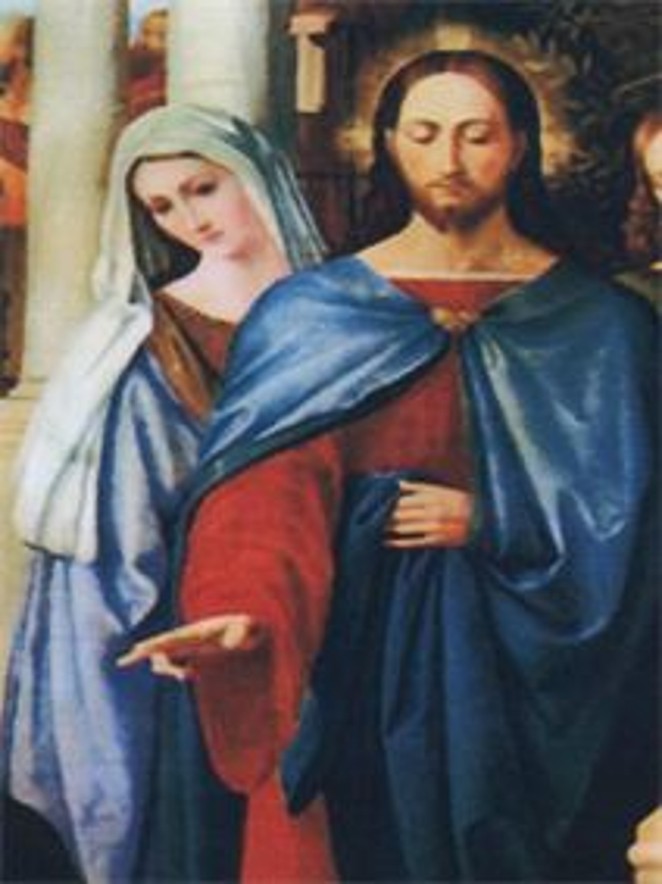
Hence the Church confesses that Mary is truly 'Mother of God' (Theotokos)" (CCC, No. 495). As St. John wrote, "The Word became flesh and made His dwelling among us, and we have seen His glory: The glory of an only Son coming from the Father filled with enduring love" (Jn 1:14).
For this reason, sometime in the early history of the Church, our Blessed Mother was given the title "Mother of God." St. John Chrysostom (d. 407) even composed a Eucharistic Prayer in honor of her: "It is truly just to proclaim you blessed, O Mother of God, who are most blessed, all pure and Mother of our God. We magnify you who are more honorable than the Cherubim and incomparably more glorious than the Seraphim. You who, without losing your virginity, gave birth to the Word of God. You who are truly the Mother of God." However, objection to the title "Mother of God" arose in the fifth century, due to confusion concerning the mystery of the Incarnation.
Nestorius, Bishop of Constantinople (428-431), incited a major controversy. He stated that Mary gave birth to Jesus Christ, a regular human person, period. To this human person was united the person of the Word of God (the Divine Jesus). This union of two persons—the human Christ and the divine Word—was "sublime and unique" but merely accidental. The Divine Person dwelt in the Human Person "as in a temple." Following his own reasoning, Nestorius asserted that the human Jesus died on the cross, not the Divine Jesus. As such, he said, “Mary is not ‘Mother of God,’ but simply ‘Mother of Christ’—the human Jesus.” Sound confusing? It is, but the result is the splitting of Christ into two persons and the denial of the Incarnation.
St. Cyril, Bishop of Alexandria (d. 440), refuted Nestorius, asserting, "It was not that an ordinary man was born first of the Holy Virgin, on whom afterwards the Word descended; what we say is that, being united with the flesh from the womb, the Word has undergone birth in the flesh, making the birth in the flesh His own..."
On June 22, 431, the Council of Ephesus convened to settle this argument. The Council declared, "If anyone does not confess that the Emmanuel is truly God and therefore that the holy Virgin is the Mother of God (Theotokos) since she begot according to the flesh the Word of God made flesh, *anathema sit (*let him or her be excommunicated)." Therefore, the Council officially recognized that Jesus is one Person, with two Natures—Human and Divine—united in a true union. Second, the Council of Ephesus affirmed that our Blessed Mother can rightfully be called the Mother of God. Mary is not Mother of God the Father, or Mother of God the Holy Spirit; rather, she is Mother of God the Son, Jesus Christ. The Council of Ephesus declared Nestorius a heretic, and the Emperor Theodosius ordered him deposed and exiled.
The Incarnation is indeed a profound mystery. The Church uses very precise—albeit philosophical—language to prevent confusion and error. Nevertheless, we must ponder this great mystery of how our Divine Savior entered this world, taking on our human flesh, to free us from sin. We must also ponder and emulate the great example of our Blessed Mother, who said, "I am the handmaid of the Lord; let it be done unto me according to Thy word."
May we turn to her always as our own Mother, pleading,"Holy Mary,
Mother of God, pray for us sinners now and at the hour of our death. Amen."
Published in the Bulletin of May 8, 2016
By Don and Sally Meredith
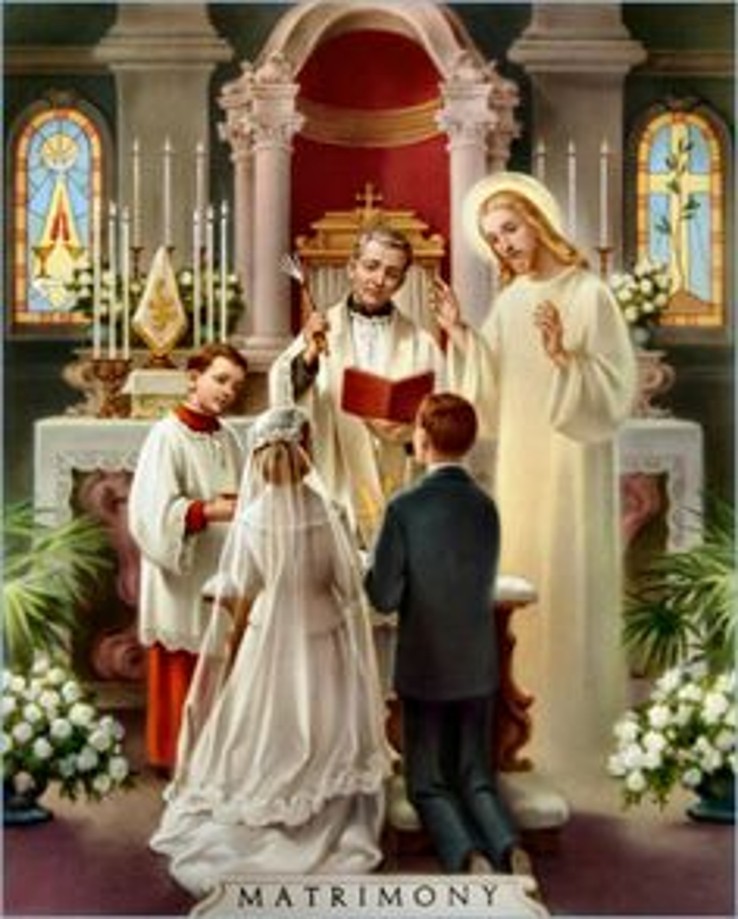
"What Does the Bible Say About Marriage?"
Most Christians see marriage as a gift from God and a sacred institution. Yet, in our experience as marriage counselors, we have found that even mature believers often don’t have a clear Biblical basis for their beliefs. Having a sound Christian perspective on marriage is vitally important today, as many in our society are trying to redefine marriage to fit their particular social or political agendas.
Created for Relationships: Love and relationships are a central theme in the Bible, beginning in Genesis and culminating in Revelation. St. Augustine made the statement, “Our hearts are restless until we find our rest in Thee.” God designed us for a relationship with Him. The whole of Scripture speaks of our relationship with Him: how to have it, how to hold onto it, how to rest in it, how to communicate it, how to enjoy it. But, God did not want us to just have relationship with Him alone. He created others that we might also learn to live with and love those He places in our lives. He said, “But now God has placed the members, each one of them, in the Body, just as He desired” (1 Corinthians 12:18-21).
If God is in the process of placing us into the Body of Christ (the Church), doesn’t this also mean He places each person called to marriage with the spouse of His choice? Since God places us in relationships we must ask ourselves the question: Why marriage? Why between a man and a woman? What is it about marriage that is so important to God? What is it about marriage that is so important to me? The Importance of Marriage to Each Spouse: Could it be that God has created marriage, the most intimate of human relationships, for the purpose of refining us, chiseling off our selfish human nature, and making us more “other-centered”? Isn’t this what He means when He says that we are being conformed to the image of Jesus Christ: “For whom He foreknew, He also predestined to become conformed to the image of His Son ...” (Romans 8:29)? How best to make us “other-centered” than to give us a spouse, very different from us, to mold us into His image?
The Importance of Marriage to God’s Plan for Mankind - Marriage also has purposes beyond each individual marriage that relate to God’s plan for mankind. In fact, there are three clear purposes outlined in Genesis:
- Reflect: Christian marriages are to reflect God’s image: Then God said, “Let us make man in our image, in our likeness…So, God created man in His own image, in the image of God He created him; male and female He created them” (Genesis 1:26-27). Each individual (as a male and as a female) is created in the image of God. However, a married couple has a unique capacity to reflect His image as husband and wife. When we recognize our purpose is to reflect the image of God, we see that we have an opportunity to be a witness to a lost world.
- Reproduce: God’s second purpose for marriage is to reproduce: God blessed them and said to them, “Be fruitful and increase in number; fill the earth and subdue it” (Genesis 1:28a). Marriage is an opportunity for men and women to procreate. Children are a gift from God and with them comes great responsibility: children are to be raised in His “likeness.” The Father gives His love to the Son, the Son receives that love and returns it to the Father and that interpersonal love is the Holy Spirit. In the same way a husband gives himself to his bride and the bride returns that love to her husband; and that love is so real that nine months later it is given a name.
- Reign - The third purpose for marriage is to reign: God blessed them and said to them, “Be fruitful and increase in number; fill the earth and subdue it” (Genesis 1:28a). According to this verse, married couples are to “subdue” the earth. To accomplish this requires good stewardship in the physical realm over that which God has given. It also requires diligence in the spiritual realm. Together married couples are to be “soldiers” directed by God to accomplish His intentions on earth.
Marriage As a Witness to the World: “By this shall all men know that you are my disciples, if you have love one for another” (John 13:35). Marriage is a significant institution by which a lost world can see Christianity in action. Marriage is the most intimate of human relationships in which husbands and wives learn to model Christ’s love. Marriage is the 18-year training ground for children so that they can also love “one another.” Marriage provides a unique opportunity to reflect Him as a couple. Marriage provides a platform for accomplishing God’s intentions for mankind.
Published in the Bulletin of May 15, 2016
By Scott Richert
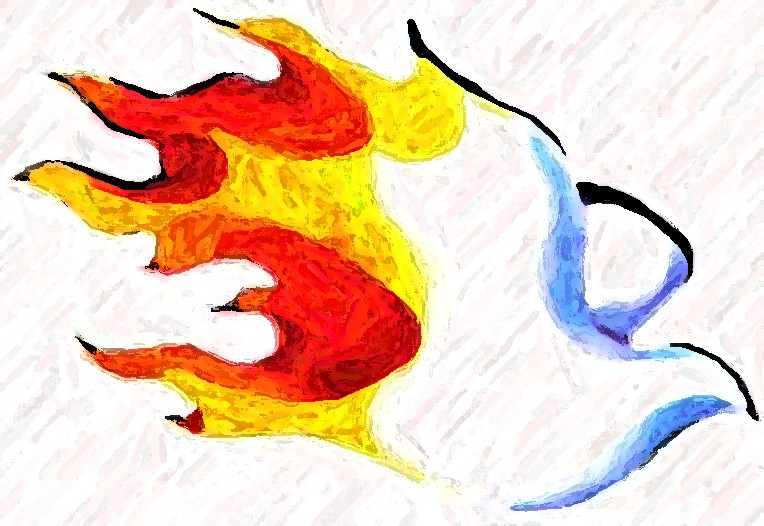
Many people think of the laying on of hands, which signifies the descent of the Holy Spirit, as the central act in the Sacrament of Confirmation. The essential element, however, is the anointing of the confirmandi with chrism, accompanied by the words, "Be sealed with the gift of the Holy Spirit". This seal is a consecration, representing the safeguarding by the Holy Spirit of the graces conferred on the Christian at Baptism. As the Catechism of the Catholic Church points out, "The original minister of Confirmation is the bishop." Each bishop is a successor to the apostles, upon whom the Holy Spirit descended at Pentecost, the first Confirmation. The Acts of the Apostles mentions the apostles imparting the Holy Spirit to believers by the laying on of hands (for example, Acts 8:15-17 and 19:6). The Church has always stressed this connection of Confirmation, through the bishop, to the ministry of the apostles.
The person being confirmed must be in a state of grace. If the sacrament is not received immediately after Baptism, the confirmandi should participate in the Sacrament of Confession before Confirmation. The Sacrament of Confirmation confers special graces of the Holy Spirit upon the person being confirmed, just as such graces were granted to the Apostles on Pentecost. Like Baptism, therefore, it can only be performed once, and Confirmation increases and deepens all of the graces granted at Baptism. The Catechism of the Catholic Church lists five effects of Confirmation:
· It roots us more deeply in the divine brotherhood, which makes us cry, "Abba! Father!";
· It unites us more firmly to Christ;
· It increases the gifts of the Holy Spirit in us;
· It renders our bond with the Church more perfect;
· It gives us a special strength of the Holy Spirit to spread and defend the faith by word and action as true witnesses of Christ, to confess the name of Christ boldly, and never to be ashamed of the Cross.
During Confirmation, the focus is on the Holy Spirit, who confirmed the apostles on Pentecost and gave them courage to practice their faith. Traditionally, the seven gifts of the Holy Spirit are wisdom, understanding, counsel, fortitude (courage), knowledge, piety, and fear of the Lord. These gifts are supernatural graces given to the soul. The 12 fruits of the Holy Spirit are charity, joy, peace, patience, benignity, goodness, long-suffering, mildness, faith, modesty, continency, and chastity—human qualities that can be activated by the Holy Spirit. The Confirmation ceremony may take place at Mass or outside of Mass, and the presiding bishop wears red vestments to symbolize the red tongues of fire seen hovering over the heads of the apostles at Pentecost. Each person wishing to be confirmed comes forward with his or her sponsor, who may or may not be one of the godparents chosen for Baptism. When you’re confirmed, you get to choose a Confirmation name to add to your first and middle names—or you can just use the names given to you at Baptism. However, your new name must be a Christian name such as one of the canonized saints or a hero from the Bible.
Any Catholic adult who has not received Confirmation should contact his or her local parish to arrange to attend classes. If at St. Therese, contact Ruben Beltran at 284-0020 (2).
Published in the Bulletin of May 22, 2016
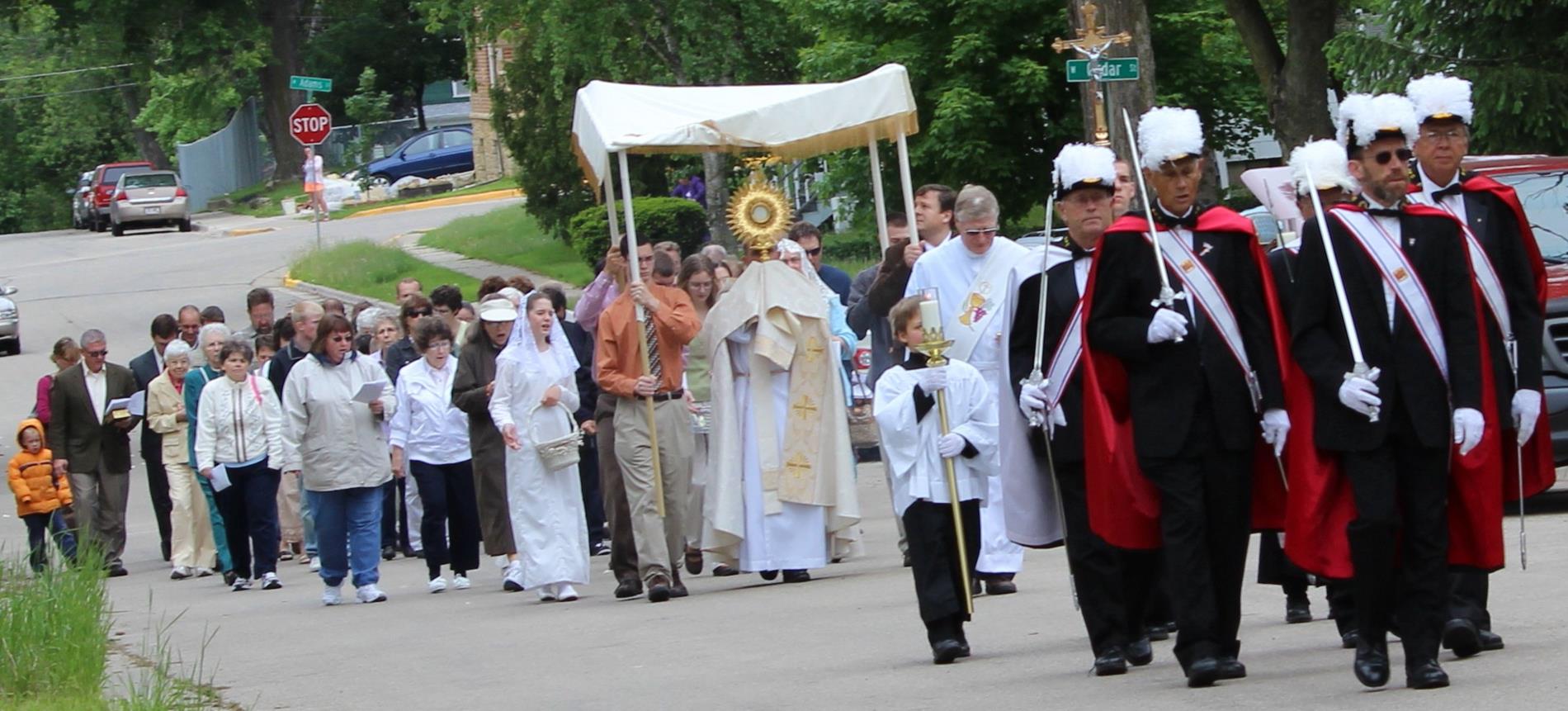
"What is Corpus Christi and What is its History?" The Solemnity of the Most Holy Body and Blood of Christ is also known as the Solemnity of Corpus Christi, which translates from Latin to "Body of Christ." This feast is celebrated in the U.S. on the Sunday following the Feast of the Holy Trinity. The institution of the Feast of Corpus Christi as a feast resulted from approximately forty years of work on the part of Saint Juliana of Liège, a 13th-century Norbertine canoness, also known as Juliana de Cornillon, born in 1191 or 1192 in Liège, Belgium, a city where there were groups of women dedicated to Eucharistic worship. Guided by exemplary priests, they lived together, devoted to prayer and to charitable works. Orphaned at the age of five, she and her sister Agnes were entrusted to the care of the Augustinian nuns at the convent of Mont-Cornillon, where Juliana developed a special veneration for the Blessed Sacrament. She always longed for a feast day outside of Lent in honor of the Blessed Sacrament. This desire was enhanced by a vision of Christ that she had in 1208, in which she was instructed to plead for the institution of the Feast of Corpus Christi. The vision was repeated for the next 20 years but she kept it a secret. When she eventually relayed it to her confessor, he relayed it to the bishop. Juliana also petitioned the learned Dominican Hugh of St-Cher, and Robert de Thorete, Bishop of Liège. At that time bishops could order feasts in their dioceses, so in 1246 Bishop Robert ordered a celebration of Corpus Christi to be held in the diocese each year thereafter on the Thursday after Trinity Sunday (since moved as stated above). Hugh of St-Cher travelled to Liège as Cardinal-Legate in 1251 and, finding that the feast was not being observed, reinstated it. In the following year, he established the feast for his whole jurisdiction (Germany, Dacia, Bohemia, and Moravia), but with a certain elasticity, for he granted an indulgence for all who confessed their sins and attended church "on a date and in a place where the feast was celebrated." Jacques Pantaléon of Troyes was also won over to the cause of the Feast of Corpus Christi during his ministry as Archdeacon in Liège. It was he who, having become Pope Urban IV in 1264, instituted the Solemnity of Corpus Christi on the Thursday after Pentecost as a feast for the entire Latin Rite, by the papal bull Transiturus de hoc mundo. Though this was the first papally-imposed universal feast for the Latin Rite, it was not in fact widely celebrated for half a century, although it was adopted by a number of dioceses in Germany and by the Cistercians, and in 1295 was celebrated in Venice. It became a truly universal feast only after the bull of Urban IV was included in the collection of laws known as the Clementines, compiled under Pope Clement V, but promulgated only by his successor Pope John XXII in 1317.
This feast calls us to focus on two manifestations of the Body of Christ, the Holy Eucharist and the Church. The primary purpose of this feast is to focus our attention on the Eucharist. The opening prayer at Mass calls our attention to Jesus' suffering and death and our worship of Him, especially in the Eucharist. At every Mass our attention is called to the Eucharist and the Real Presence of Christ in it. The secondary focus of this feast is upon the Body of Christ as it is present in the Church. The Church is called the Body of Christ because of the intimate communion which Jesus shares with His disciples. He expresses this in the Gospels by using the metaphor of a Body in which He is the Head. This image helps keep in focus both the unity and the diversity of the Church. The Feast of Corpus Christi is commonly used as an opportunity for public Eucharistic processions, which serves as a sign of common faith and adoration. Our worship of Jesus in His Body and Blood calls us to offer to God our Father a pledge of undivided love and an offering of ourselves to the service of others.
When Pope Pius V revised the General Roman Calendar, Corpus Christi was one of only two "feasts of devotion" that he kept; the other being Trinity Sunday. From 1849 until 1969 a separate Feast of the Most Precious Blood of Our Lord Jesus Christ was assigned to the first Sunday in July, later to the first day of the month. This feast was removed from the General Roman Calendar in 1969 because, it was stated, "...the Most Precious Blood of Christ the Redeemer is already venerated in the solemnities of the Passion, of Corpus Christi, of the Sacred Heart of Jesus, and in the feast of the Exaltation of the Holy Cross.
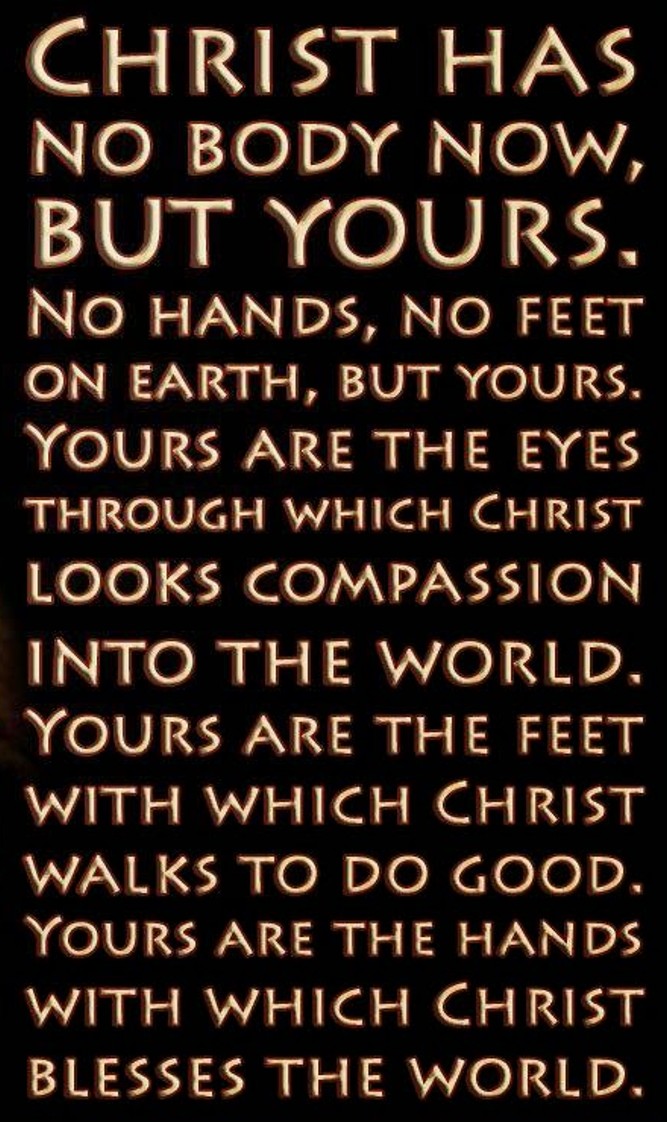
It is well to remember the teaching of the Church about the Corporal and Spiritual Works of Mercy. Mercy is said to be a virtue influencing one's will to have compassion for and, if possible, to alleviate another's misfortune. Practicing the works of mercy is extending God’s compassion to those around us. Its motive is to alleviate the misery which one discerns in another, particularly in so far as this condition is deemed to be, in some sense at least, involuntary.
The Divine command is set forth in the most stringent terms by Christ, and the failure to comply with it is visited with the supreme penalty (Matthew 25:41): "Then He shall say to them, 'Depart from me, you cursed, into the everlasting fire which was prepared for the devil and his angels.
For I was hungry, and you gave me not to eat; I was thirsty, and you
gave me not to drink. I was a stranger, and you took me not in; naked,
and you covered me not; sick and in prison,
and you did not visit me,’" etc.
The Corporal Works of Mercy give us a model for how we should treat others in their physical needs, as if they were Christ Himself. They are charitable actions by which we help our neighbors in their needs. They respond to the basic needs of humanity as we journey together through this life. The seven Corporal Works of Mercy are: To feed the hungry; to give drink to the thirsty; to clothe the naked; to shelter the homeless; to visit the sick; to visit the imprisoned; and to bury the dead.
Since the Spiritual Works of Mercy also deal with distresses whose relief is even more imperative, the injunction must extend to them also. Including the plain references of Christ to such works as fraternal correction (Matthew 18:15) and the forgiveness of injuries (Matthew 6:14), the Spiritual Works of Mercy are also found in the teachings of Jesus. The Spiritual Works of Mercy have long been a part of the Christian tradition, appearing in the works of theologians and spiritual writers throughout history. Just as Jesus attended to the spiritual well-being of those He ministered to, these Spiritual Works of Mercy are acts of compassion which guide us to help our neighbor in their emotional and spiritual needs. The seven Spiritual Works of Mercy are: To instruct the ignorant; to counsel the doubtful; to admonish sinners; to comfort the sorrowful; to bear wrongs patiently; to forgive offenses willingly; and to pray for the living and the dead.
Though generally enjoined upon all the faithful, often, in particular cases, a given individual will not be obligated or even competent to perform three of the seven spiritual works of mercy, namely: instructing the ignorant, counseling the doubtful, and admonishing sinners. These works may generally require a superior level of authority or knowledge or an extraordinary amount of tact. The other four works (comforting the sorrowful, bearing wrongs patiently, forgiving offenses willingly, and praying for the living and the dead) are considered to be an obligation of all the faithful to practice unconditionally.
In sum, our Final Judgment will be based largely on love of God but manifested in our love for neighbor. Indeed, using the words of Blessed Mother Teresa of Calcutta, “We must find Jesus present in the distressing disguise of the poor.”
Published in the Bulletin of June 5, 2016
By Matthew Warner
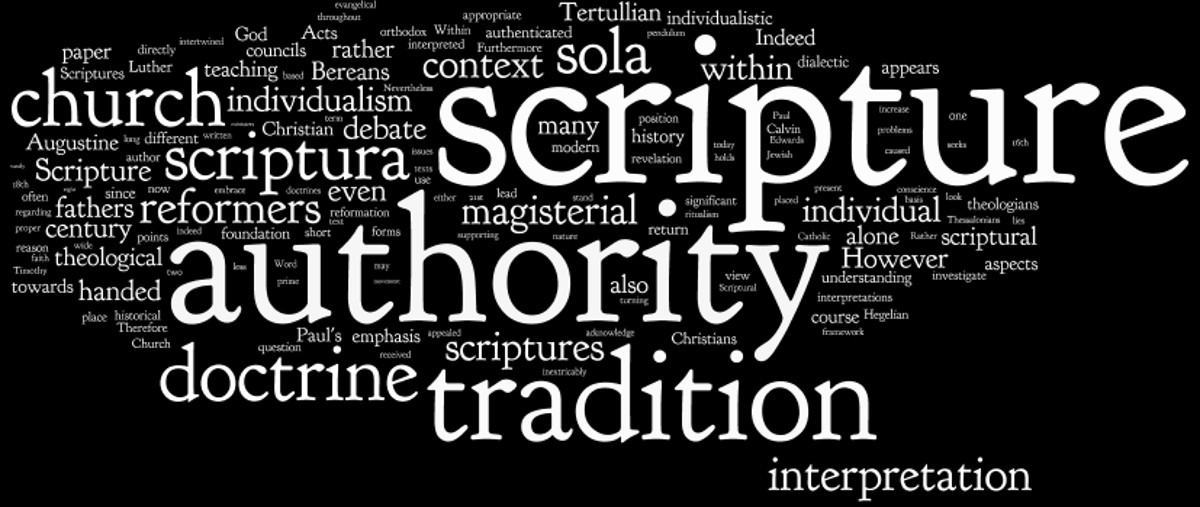
And if we should, then should those be the only things we believe? It’s amazing how many people ask the original question without even pondering these other more fundamental questions. Perhaps it’s a matter of our American, Protestant culture that simply takes the Bible as a given without a second thought. And perhaps it’s a lack of knowledge on the part of us Catholics when we automatically grant a non-Catholic that starting place without challenge. After all, at least we can all agree on the Bible, right? Or do we? I would say yes and no. First, an obvious disagreement is on what books should even be in the Bible. Protestants gradually removed seven of the Old Testament books (and parts of other books) shortly after the “reformation.” Though these books had always been in the official canon, some of them contradicted some of the new Protestant doctrine, so they were removed. But that brings up the next and more fundamental question: Who decides the canon of the Bible?
It is historical fact that the Catholic Church decided the canon of the Bible as we know it today. In the first few centuries there was a growing confusion over what writings were to be considered inspired Scripture and which weren’t. It was the bishops of the Catholic Church that met at the end of the 4th century to finally, officially determine the canon. So basically, the authority of the Bible’s canon is only as good as the authority that defined it—that of the Catholic Church. And since it is that same Church that Jesus gave the Keys to the Kingdom and the authority to bind and loose (Matt 16:19), then we can trust it. It is for this reason that Catholics can then believe in the Bible and trust in it as the inspired, inerrant Word of God. If you don’t believe in the authority of the Catholic Church, there is no case for such a claim. So it’s important to put the Bible into that context when relying on it to determine what we believe. Once we’re on the same page as to why we should believe in the Bible (because the Church that Jesus founded says so), then we can address the next question: Should we only believe things that are explicitly written in the Bible?
Well, as a start, does it say anywhere in the Bible that we should only believe the things written in the Bible? The answer is no. On the contrary, it explicitly instructs us through the apostles to “stand firm and hold to the traditions which you were taught by us, either by word of mouth or by letter” (2 Thess 2:15). And it goes on further to say, “What you have heard from me before many witnesses entrust to faithful men who will be able to teach others also” (2 Tim. 2:2). And this would have made perfect sense to those in the New Testament. First of all, this is how they had been taught. Jesus didn’t write the Bible, give it to them and say, “Here, this is your sole rule of faith. Get one of these into the hands of every person on the planet.” No. He gave us His Church and gave the Apostles the power to rule it and the Holy Spirit to guide it. And those Apostles entrusted their authority to other faithful men, our bishops, to teach us also. Further, if we trust the Catholic Church’s authority to determine what the canon of the Bible is, should we not also trust them to tell us how to use it?
The Catholic Church tells us, as does the Bible, that the true “rule of faith” is both Scripture and Apostolic Tradition (what the Apostles have passed down and the Church has always taught from the beginning). And it is these things working together through the teaching authority of the Church that we come to know the fullness of the Truth. The Catechism of the Catholic Church says this about them (CCC 80-82): “Sacred Tradition and Sacred Scripture are bound closely together. For both of them, flowing out from the same divine well-spring, come together in some fashion to form one thing, and move towards the same goal.” Each of them makes present and fruitful in the Church the mystery of Christ, who promised to remain with His own “always, to the close of the age”. “Sacred Scripture is the speech of God as it is put down in writing under the breath of the Holy Spirit. [Holy] Tradition transmits in its entirety the Word of God, which has been entrusted to the apostles by Christ and the Holy Spirit. It transmits it to the successors of the apostles so that they may preserve, expound, and spread it by their preaching.” So to answer the original question…
Nothing in the Bible contradicts anything that the Catholic Church teaches and vice versa (when interpreted properly). Sacred Scripture and Sacred Tradition are both sources of revealed truths so we must acknowledge them both and in practice, and reconcile them with each other. Therefore, Catholics believe in some things that are not necessarily mentioned in the Bible because God has revealed them to us through His Church.
Also, using the Bible as the sole rule of faith is a misuse of the Bible. It was not created, nor contains instruction, to be used in such a way. It must be used in the proper context and interpreted in light of Apostolic Tradition and the teaching authority of the Church given to it by Christ. Many Christians don’t realize that even the idea of using the Bible as the only rule of faith (Sola Scriptura) is actually a new invention only propagated in the past 500 years. It was unheard of before that point and was certainly not practiced by the Apostles or the early Christians. They would have been extremely perplexed at even the asking of such a question.
Published in the Bulletin of June 12, 2016
By Brian Williams, Catholic Apologist
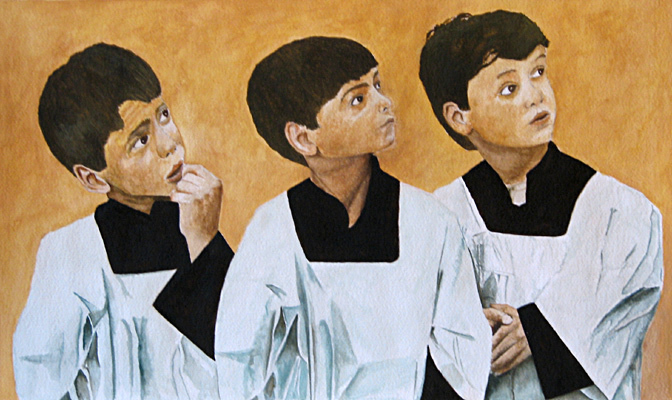
For years the faithful have been told that altar girls do not negatively impact priestly vocations. Indeed, far too many have approached this simply as a matter of “gender-equality” for young girls. Some even argue that the Church has spoken and it is time to accept this decision and move on. Nothing could be further from the truth.
Born
Out of Dissent - First we need to clarify that this is strictly a
discussion of Church discipline and not an issue of doctrine. As with
several other contemporary crises, the practice of girls serving at the
altar was born out of dissent. Despite clarifying statements from Rome
in both 1970 and again in 1980, the liturgical abuse still continued.
With the revision of the Code of Canon Law in 1983 the opportunity for
change presented itself. From the point of view of liturgical law, an
official interpretation of Canon 230, Paragraph 2, of the Code led to a
1994 letter from the Congregation for Divine Worship and the Sacraments
clarifying that “girls may serve at the altar, but bishops are not bound
to permit them to do so.” (Zenit News Agency, “Female Altar Servers,”
February 3, 2004).
It is also important to note, however, that the same 1994 letter from the Congregation also stated that: “The Holy See wishes to recall that it will always be very appropriate to follow the noble tradition of having only boys serve at the altar.” As is well known, this has led to a reassuring development of priestly vocations. Thus the obligation to support such groups of altar boys will always continue. Much like the excessive use of Extraordinary Ministers of Holy Communion, it is astonishing just how quickly altar girls serving at Mass became the norm. To date, only the Diocese of Lincoln, Nebraska, has never implemented the use of altar girls at Mass in the United States.
Priestly Vocations - Regardless of what anyone contends, this is not an issue of gender equality. Indeed, no one has a right to serve at the Mass. As a father of five, four of whom are girls, the equality argument rings hollow to me. To discuss altar girls under the banner of equality is to impose a false, secular notion of participation into the sacred and eternal realm of the liturgy. We all participate in the Holy Sacrifice of the Mass, regardless of what our roles are or aren't.
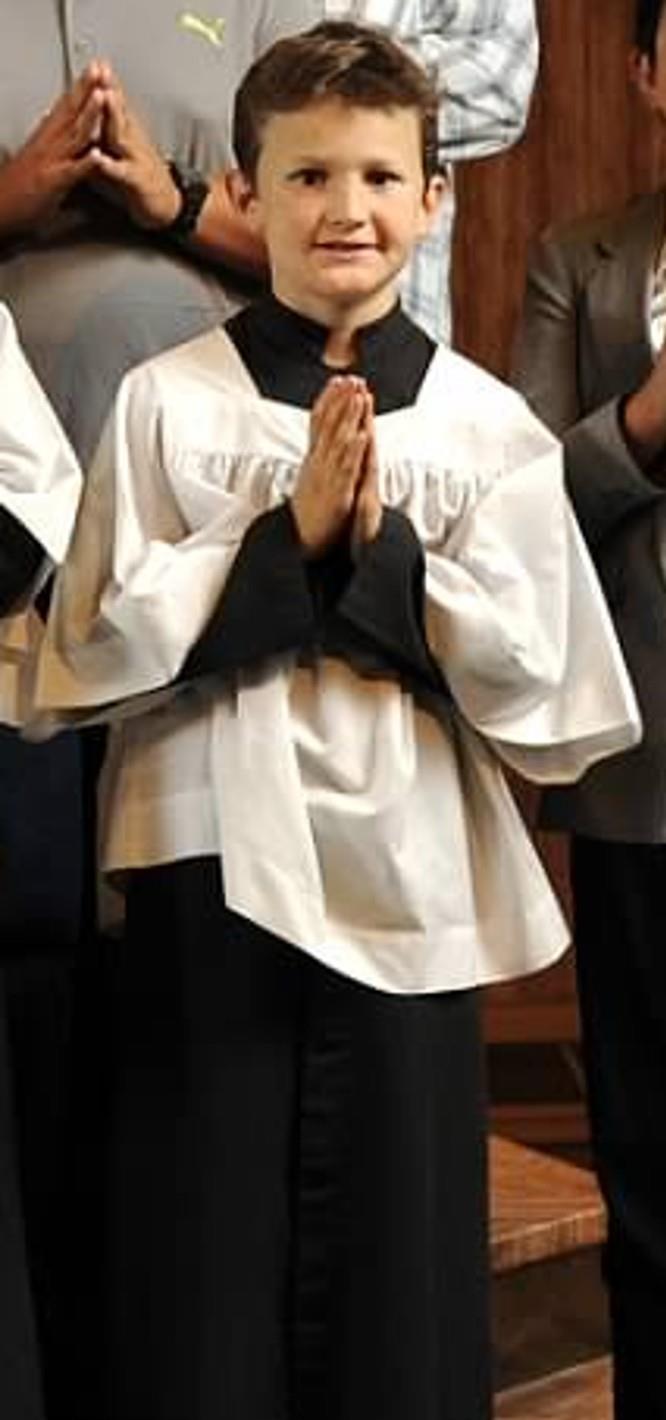
There are two vitally important questions that we need to be asking: First, shouldn’t we do all that we can to assist young men to discern a possible calling to the priesthood? Secondly, if we determine that young men are more likely to discern a vocation to the priesthood by being altar servers, shouldn’t we seek to increase their participation? I have often heard that there isn’t much data to support the argument that altar serving leads young men to the priesthood. This is uniformly untrue. For several years now the Center for Applied Research in the Apostolate (CARA) has conducted an annual Survey of Ordinands to the Priesthood, with typical response rates being between 65 to 75 percent. Questions address such topics as ordinands' age, ethnicity, siblings, education, and participation in parish ministries. Of the hundreds of men surveyed (who have since been ordained to the priesthood), an overwhelming majority were altar servers during their formative years.
Surveys over the last four years provide the following numbers: In 2010, 70 percent of the 339 respondents had been servers; In 2011, 71 percent of the 329 respondents had been servers; In 2012, 75 percent of the respondents had been servers; and in 2013, 67 percent of the 366 respondents had been servers. This is incredibly relevant data which should receive much more attention when discussing this topic.
A Return to the Noble Tradition - In July 2005, Catholic World Report published priestly vocation statistics from the previous year for the United States. Conducted over 10 years after Rome officially permitted girls to serve at the altar, it is interesting to note what it revealed. The previously mentioned Diocese of Lincoln, Nebraska (which had never implemented girl altar servers) led the entire nation with one seminarian per 2,625 Catholics. In the intervening years we have begun to see a modest, but consistent, increase in parishes reverting back to a boys-only policy for altar serving. The basic reasoning goes something like this: Boys want to serve with other boys. Returning to the noble tradition of boys-only serving at the Mass facilitates greater participation by young men. These young men, through their years of service, are then assisted in their formation and discernment for a possible calling to the priesthood. From this we then see a steady and consistent growth in men entering the seminary and, eventually, in more men being ordained.
Father John Hollowell, with his "On This Rock" blog, has done a great service by conducting a survey of several parishes which have made the switch from co-ed servers to males only. The below chart and data are courtesy of Fr. Hollowell’s research. While the sample size is small, it is still difficult to argue with an average increase of 450 percent in boys serving at the altar.
PARISH | CITY/STATE | # OF SERVERS BEFORE | # OF SERVERS AFTER | RESULT |
St. John | Osgood, IN | 9 | 18 | Doubled |
St. Luke | Indianapolis, IN | 20 | 120 | 6X larger |
Annunciation | Brazil, IN | 5 | 16 | 3.2X larger |
Holy Family | St. Louis Park, MN | 12 | 100 | 8.3X larger |
Cardinal Ritter | Indianapolis, IN | 5 | 25 | 5X larger |
Our Lady, Star of the Sea | Bennerton, WA | 20 | 100 | 5X larger |
In the coming years it is my sincere hope that more parishes, and even possibly dioceses, take a serious and prayerful second look at their policy for altar serving. Let us remove the emotions, polemics, and agendas from this discussion and simply seek what is best for the priesthood and for Holy Mother Church.
Published in the Bulletin of June 19, 2016
By Ruben Beltran
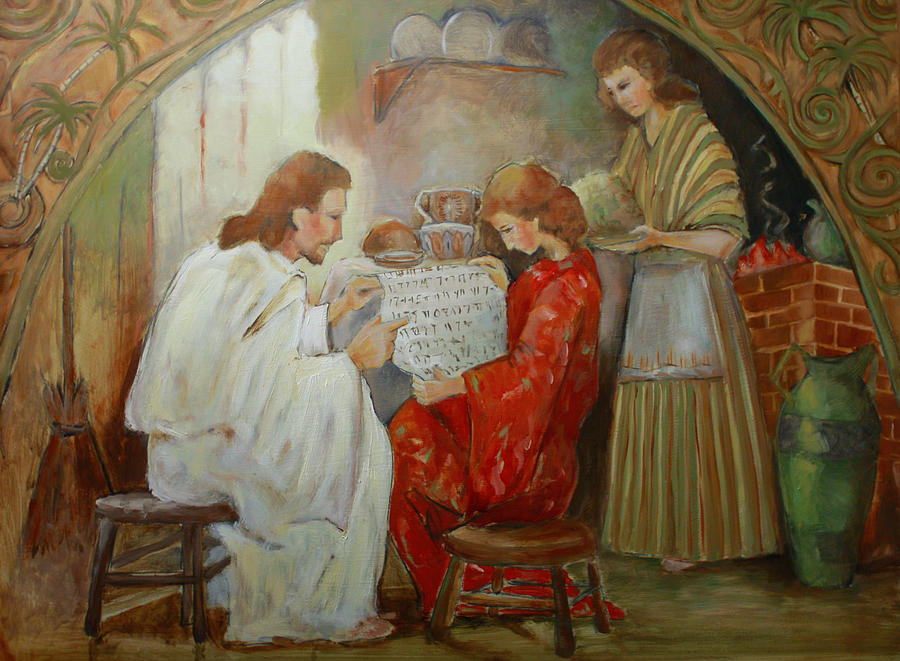
But today, with such confusion about self-identity and gender, the question has become a valid and sensible one. However, this question is not new to the Catholic Church. The reservation of priestly ordination to men is perhaps one of the most controversial teachings of the Church.
So why only men? Many people will argue that the only reason Jesus chose men was because he was conforming to a misogynistic time. However, if we look at Jesus’ actions in the Gospels, we clearly see he wasn’t a conformist. Calling the Pharisees and Sadducees a “brood of vipers” and turning over the money changers’ tables weren’t exactly in line with Jewish customs. Jesus’ interactions with women show a deliberate pattern of breaking Jewish and cultural norms. For example, Jesus talked publicly with a Samaritan woman; He took no notice of the legal impurity that resulted from being touched by the woman with a hemorrhage; He pardoned with compassion the woman caught in adultery, showing that women shouldn’t be judged more harshly than men; He was close friends with Mary and Martha (sisters of Lazarus); He allowed women to accompany Him in His ministry; and, perhaps most telling of all, women were the first witnesses of the Resurrection and were charged with bringing that message to the apostles, even though a woman’s testimony counted as nothing in court.
Keeping all this in mind, we can see that Christ choosing only men as Apostles was a deliberate action. As Joseph Cardinal Ratzinger noted before his election as Pope: “One forgets that in the ancient world all religions also had priestesses. All except one. The Jewish. Christianity, here too following the ‘scandalous’ original example of Jesus, opens a new situation to women: it accords them a position that represents a novelty with respect to Judaism. But of the latter, he preserves the exclusively male priesthood.” What Cardinal Ratzinger is pointing out here is that if Jesus did choose women to be priestesses, it would not have been as much as a shock as people think. All religions had priestesses. The astonishing thing was that they were absent from the community of Jesus Christ. As clearly stated in Scripture, Jesus broke many Jewish customs; however, here he deliberately retains it.
We must also look at the Priesthood as a Sacrament. According to the Catechism of the Catholic Church: “The sacraments are efficacious signs of grace, instituted by Christ and entrusted to the Church, by which divine life is dispensed to us. The visible rites by which the sacraments are celebrated signify and make present the graces proper to each Sacrament.” The Sacraments are outward “signs” which represent spiritual realities. For example, washing with water at Baptism signifies cleansing from sin, regeneration, and participation in the mystery of Christ’s death and resurrection. The water is an outward “sign” of what is really taking place spiritually. In the incarnation, Christ was born male and the priest is a sacramental sign or “icon” of Jesus Christ. Pope John Paul II alludes to this when he states that the apostles and their successors were given the mission of “representing” Christ. The Priest at Mass stands in Persona Christi (in the person of Christ); and Christ the Head and Mediator is male; therefore, the priest who represents Him must be male. Bonaventure adds to this a theological argument based on the long-standing tradition of regarding the bishop as the “spouse” or “bridegroom” of his diocese. Because of this, only a male should receive priestly ordination. Crucial to this theological argument is his suggestion that the sacramental symbolism of the priesthood reflects the bishop (or priest) in relationship with the Church, the “Bride of Christ”.
I would like to close with an excerpt from “Light of the World,” an interview with Pope Benedict XVI. In this book Pope Benedict XVI explains the Church’s position on the matter. “John Paul ll’s formulation is very important: The Church has ‘no authority’ to ordain women. The point is not that we are saying we don’t want to, but that we can’t. The Lord gave the Church a form with the Twelve and, as their successors, with the bishops and the presbyters, the priests. This form of the Church is not something we ourselves have produced. It is how He constituted the Church. Following this is an act of obedience. This obedience may be arduous in today’s situation. But it is important precisely for the Church to show that we are not a regime based on arbitrary rule. We cannot do what we want… Incidentally, women have so many great and meaningful functions in the Church that there can be no question of discrimination.” Finally, if there is any doubt of the Church’s respect for women, we need only look at Our Holy Mother, whom the Church formally declared to be the Queen of Heaven (Oct. 11, 1954, Pope Pius XII).
Published in the Bulletin of June 19, 2016 - See Article No. 19 for another article on this subject
By Jim Campbell, Catholic Apologist
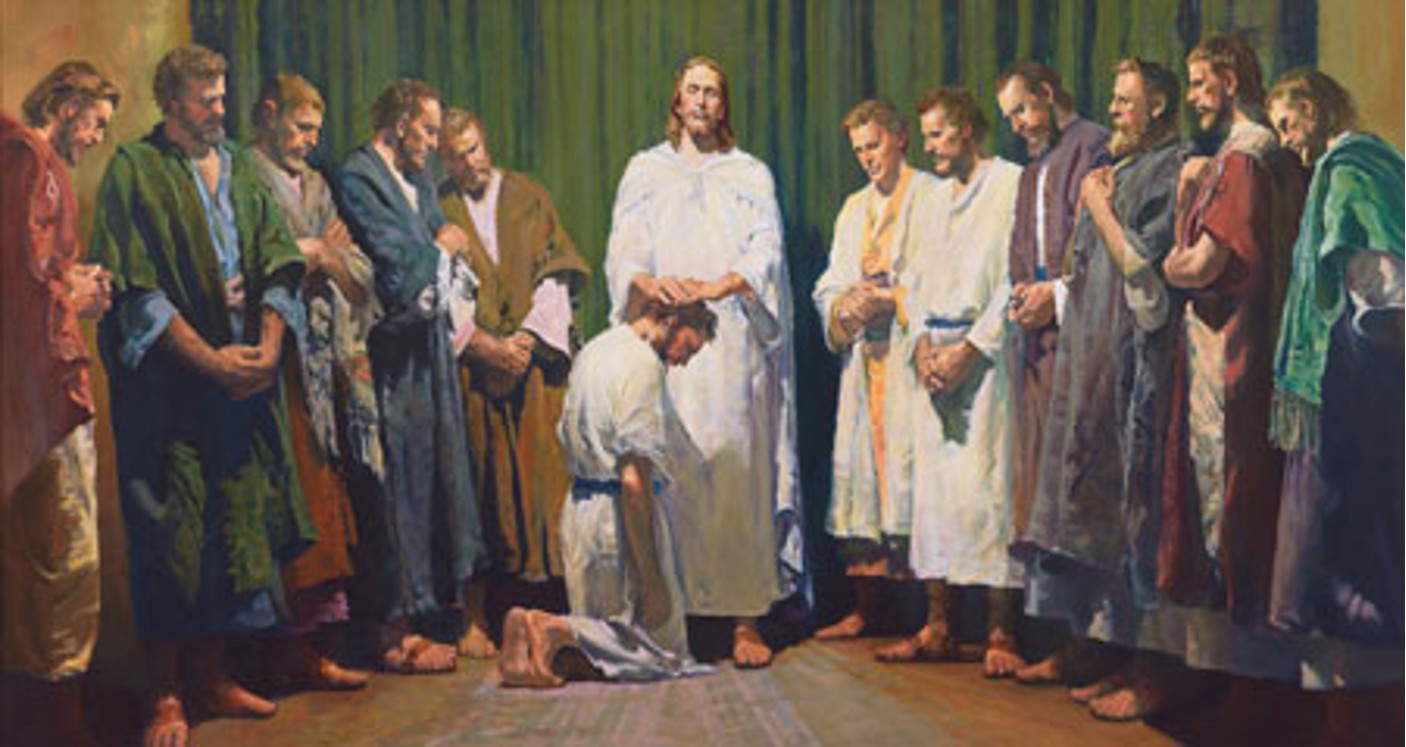
"What is the Sacrament of Holy Orders?" Jesus chose twelve men to be apostles. After His ascension, the apostles had the important mission of spreading the news about Jesus, but they were lacking one member. At a gathering of the disciples, Peter told the group that a replacement for Judas was needed. The man to be chosen needed to have been a witness to Jesus' life, death, resurrection, and ascension. Two men were proposed, Justus and Matthias. Peter and the apostles prayed for the Lord to show them whom to choose. Matthias was chosen and became the new apostle (Acts 1:15-26).
The pope and bishops are successors to the apostles, having been called and chosen to continue Jesus' work. All members of the Church participate in the priesthood of all believers through Baptism. However, some men are called to serve Jesus and the Church through the celebration of the Sacrament of Holy Orders. Holy Orders is the Sacrament through which the mission entrusted by Christ to His apostles continues to be exercised in the Church until the end of time: thus it is the sacrament of apostolic ministry. Through their leadership in the Church, priests help continue Jesus' presence on earth in the tradition of the apostles. Those who are called to be priests are ordained through the Rite of Ordination. In celebrating this Rite, men receive a permanent spiritual mark, called a character, signifying that they represent Jesus' presence in the Church.
There are three levels of participation in the Sacrament of Holy Orders: It includes three degrees: episcopate (as bishop), presbyterate (as priest), and diaconate (as deacon). A bishop receives the fullness of the Sacrament of Holy Orders. He is the head or Ordinary of the local Church. The area entrusted to him is called a Diocese or Archdiocese. A bishop is also a member of the Episcopal college, which is all the bishops who, with the pope, guide the Church.
Priests serve the community in various ways. They may be called to serve in their Dioceses and/or as religious order priests, carrying out the mission of a particular religious community. They preside at liturgies, preach, administer the Sacraments, counsel people, serve as pastors, and teach. Deacons are ordained for service in the Church, proclaiming the Gospel, teaching and preaching, baptizing, witnessing marriages, and assisting the priest celebrant at liturgies. Some deacons are studying to become priests; others are married men who are called to remain deacons for life and to serve the Church in this capacity.
Priests receive the Sacrament of Holy Orders in the Rite of Ordination. The bishop lays his hands on the head of the candidate and says a prayer asking for the outpouring of the Holy Spirit. In one part of the rite, the candidate lies in front of the altar while the Litany of the Saints is sung or recited. In another part of the rite, a priest's hands are anointed with chrism. In the rite for a bishop, the new bishop's head is anointed.
Published in the Bulletin of June 19, 2016
For more info on the priesthood, see Article No. 19 ("Why Can't Women be Ordained as Catholic Priests?") and Article No. 26 ("What is Priestly Ordination?")
By Catholic Answers
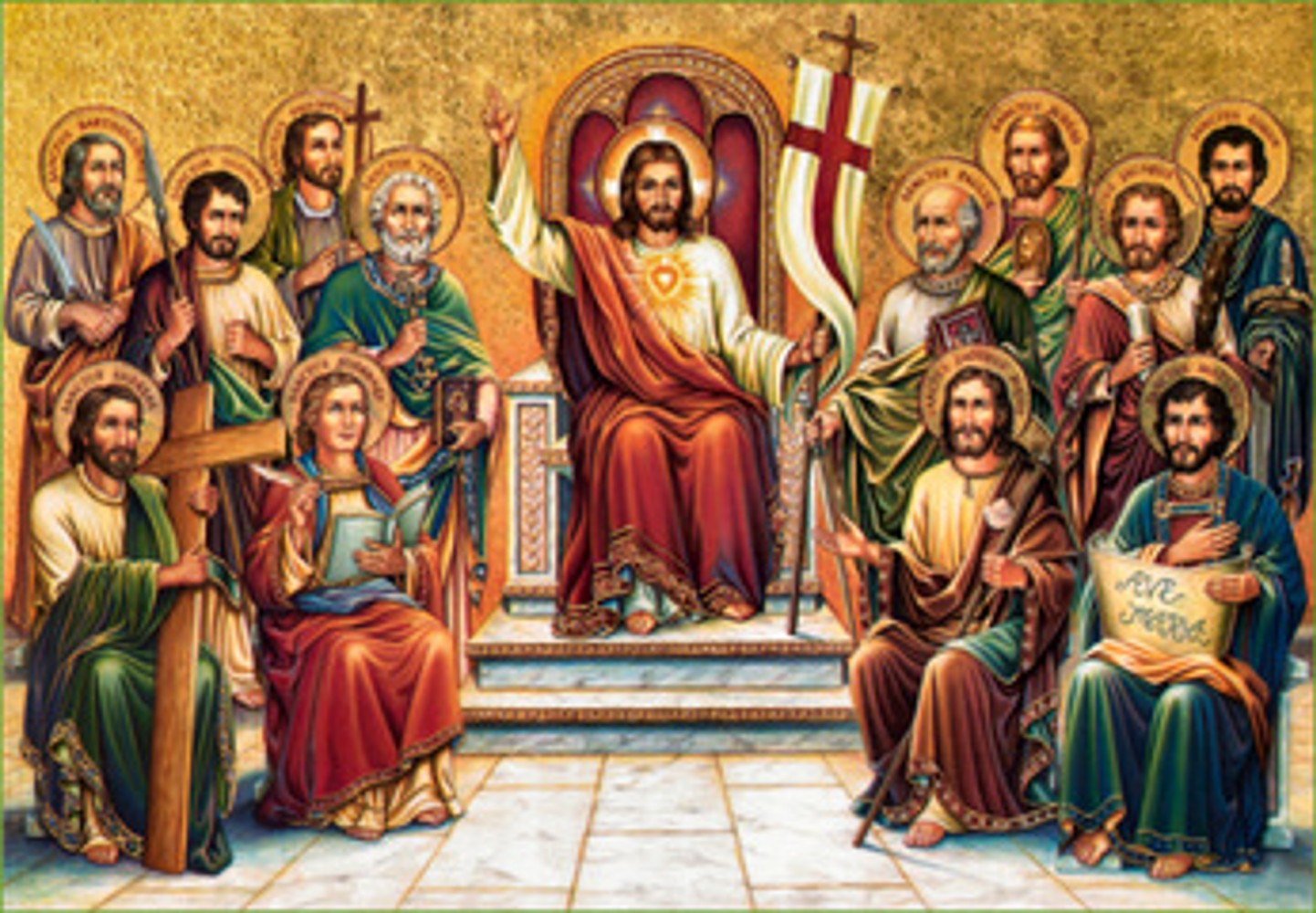
Thus all priests, ordained by bishops in the apostolic succession, are also part of the succession. For biblical corroboration look at Acts 1:21-26, where the apostles acted swiftly to replace the Judas’ position. After choosing Matthias they laid hands on him to confer apostolic authority. Also in 1 Timothy 4:14, where Paul reminds Timothy that the office of bishop had been conferred on him through the laying on of hands.
The testimony of the early Church is deafening in its unanimous assertion of apostolic succession. Far from being discussed by only a few writers, the belief that the apostles handed on their authority to others was one of the most frequently and vociferously defended doctrines in the first centuries of Christianity.
Published in the Bulletin of June 19, 2016
If you would like to read a more comprehensive explanation, here is the published study of the International Theological Commission, made in 1973:
This study sets out to throw light on the concept of apostolic succession, on the one hand, because a clear presentation of the Catholic doctrine would seem to be useful to the Catholic Church as a whole, and, on the other hand, because it is demanded by ecumenical dialogue. For some time now ecumenical dialogue has been going on in various parts of the world, and it has a promising future provided the Catholics taking part in it remain faithful to their Catholic identity. So we propose to present the Catholic teaching on apostolic succession in order to strengthen our brothers in the Faith and to contribute to the mature development of ecumenical dialogue.
We begin by listing some of the difficulties that are frequently encountered:
1. What can be deduced, scientifically, from the witness of the New Testament? How can one show the continuity between the New Testament and the Church’s Tradition?
2. What is the place of the imposition of hands in apostolic succession?
3. Is there not a tendency in some quarters to reduce apostolic succession to the apostolicity that is common to the whole Church, or, conversely, to reduce the apostolicity of the Church to apostolic succession?
4. How can one evaluate the ministry of other churches and Christian communities in relation to apostolic succession?
Behind all these questions lies the problem of the relationship between Scripture, Tradition, and the dogmatic pronouncements of the Church. The dominant note in our thinking is provided by the vision of the Church as willed by the Father, emerging from Christ’s Paschal mystery, animated by the Holy Spirit, and organically structured. We hope to set the specific and essential function of apostolic succession in the context of the whole Church, which confesses its apostolic Faith and bears witness to its Lord.
We rely upon Scripture, which has for us a twofold value as a historical record and an inspired document. Insofar as it is a historical record, Scripture recounts the most important events in the mission of Jesus and the life of the Church of the first century; insofar as it is an inspired document, it bears witness to certain facts and at the same time interprets them and reveals their inner significance and dynamic coherence. As an expression of the thought of God in the words of men, Scripture has a normative value for the thinking of Christ’s Church in every age.
But any interpretation of Scripture that regards it as inspired and therefore normative for all ages is necessarily an interpretation that takes place within the Church’s Tradition, which recognizes Scripture as inspired and normative. The recognition of the normative character of Scripture fundamentally implies a recognition of that Tradition within which Scripture itself was formed and came to be considered and accepted as inspired. The normative status of Scripture and its relationship to Tradition go hand in hand. The result is that any theological considerations about Scripture are at the same time ecclesial considerations.
This, then, is the methodological starting point of the document: any attempt to reconstitute the past by selecting isolated phrases from the New Testament Tradition and separating them from the way they were received in the living Tradition of the Church is contradictory. The theological approach that sees Scripture as an indivisible whole and that links it with the life and thought of the early community that acknowledges and "recognizes" it as Scripture certainly does not mean that properly historical judgments are eliminated in advance by an ecclesiological a priori, which would make impossible an interpretation in conformity with the demands of historical method.
The method adopted here enables one to grasp the limitations of pure historicism: it admits that the purely historical analysis of a book in isolation from its effects and influence cannot show with certainty that the way Faith actually developed in history was the only possible way But these limits to historical proof, which one cannot doubt, do not destroy the value and weight of historical knowledge. On the contrary, the fact that the early Church accepted Scripture as constitutive is something to be constantly meditated upon: that is, we have to think out again and again the relationship, the differences, and the unity between the different elements.
That also means that one cannot dissolve Scripture into a series of unrelated sketches, each one of which would be an attempt to express a lifestyle founded on Jesus of Nazareth, but rather that one must understand it as the expression of a historical unfolding path that reveals the unity and the catholicity of the Church. There are three broad stages along this path: the time before Easter, the apostolic period, and the subapostolic period, and each period has its own specific value; it is significant that what the dogmatic constitution "On Divine Revelation", Dei Verbum (18), calls "viri apostolici" should be responsible for some of the New Testament writings.
This helps one to see clearly how the community of Jesus Christ solved the problem of remaining apostolic even though it had become subapostolic. This explains why the subapostolic part of the New Testament has a normative character for the Church at a later period, for it must build on the apostles, who themselves have Christ as their foundation. In the subapostolic writings, Scripture itself bears witness to Tradition and gives evidence of the Magisterium in that it recalls the teaching of the apostles (see Acts 2:42; 2 Pet 1:20). This Magisterium really begins to develop in the second century, at the time when the idea of apostolic succession is made fully explicit.
Scripture and Tradition taken together, pondered upon and authentically interpreted by the Magisterium, faithfully transmit to us the teaching of Christ our Lord and Savior and determine the doctrine that it is the Church’s mission to proclaim to all peoples and to apply to each generation until the end of the world. It is in this theological perspective — fully in accord with the doctrine of Vatican II — that we have written this document on apostolic succession and evaluated the ministries that exist in churches and communities not yet in full communion with the Catholic Church.
I. THE APOSTOLICITY OF THE CHURCH AND THE COMMON PRIESTHOOD
1. The creeds confess their Faith in the apostolicity of the Church. That means not simply that the Church continues to hold the apostolic Faith but that it is determined to live according to the norm of the primitive Church, which derived from the first witnesses of Christ and was guided by the Holy Spirit, who was given to the Church by Christ after his Resurrection. The Epistles and the Acts of the Apostles show how effective was this presence of the Spirit in the whole Church, and that he ensured not only its diffusion but also and more importantly the transformation of hearts: the Spirit assimilates them to Christ and his feelings. Stephen, the first martyr, repeats the words of forgiveness of his dying Lord; Peter and John are beaten and rejoice that they should be found worthy to suffer with him; Paul bears in his body the marks of Christ (Gal 6:17), wants to be conformed to the death of Christ (Phil 3:10), to know nothing save the crucified One (1 Cor 1:23; 2:2), and he considers his whole life as an assimilation to the expiating sacrifice of the Cross (Phil 2:17; Col 1:24).
2. This assimilation to the "thoughts" of Christ and above all to his sacrificial death for the world gives ultimate meaning to the lives of those who want to lead a Christian, spiritual, and apostolic life. That is why the early Church adapted the priestly vocabulary of the Old Testament to Christ, the Paschal Lamb of the New Covenant (1 Cor 5:7), and then to Christians whose lives are defined in relation to the Paschal mystery of Christ. Converted by the preaching of the Gospel, they are convinced that they are living out a holy and royal priesthood that is a spiritual transposition of the priesthood of the Old Testament (1 Pet 2:5-9; see Ex 19:6; Is 61:6) and that was made possible by the sacrificial offering of him who recapitulates in himself all the sacrifices of the Old Law and opens the way for the complete and eschatological sacrifice of the Church (see St. Augustine, De civitate Dei 10, 6).
Christians as living stones in the new building that is the Church founded on Christ offer to God worship in the Spirit who has made them new; their cult is both personal, since they have to "present their bodies as a living sacrifice, holy and acceptable to God" (Rom 12:1; see 1 Pet 2:5), and communal, since together they make up the "spiritual house", the "royal priesthood" and "holy nation" (1 Pet 2:9), whose purpose is to offer "spiritual sacrifices that Jesus Christ has made acceptable to God", (1 Pet 2:8).
This priesthood has a moral dimension—since it must be exercised every day and in ordinary situations—and an eschatological dimension, since it is, in eternity to come that Christ has promised to make of us "a line of kings, priests to serve his God and Father" (Rev 1:6; see 5:10; 20:6); but it has also a cultural dimension, since the Eucharist by which they live is compared by Saint Paul to the sacrifices of the Old Law and even - though only to make a sharp contrast - to pagan sacrifices (1 Cor 10:16-21).
3. Now Christ instituted a ministry for the establishment, animation, and maintenance of this priesthood of Christians. This ministry was to be the sign and the instrument by which he would communicate to his people in the course of history the fruits of his life, death, and Resurrection. The first foundations of this ministry were laid when he called the Twelve, who at the same time represent the new Israel as a whole and, after Easter, will be the privileged eyewitnesses sent out to proclaim the Gospel of salvation and the leaders of the new people, "fellow workers with God for the building of his temple" (see 1 Cor 3:9). This ministry has an essential function to fulfill toward each generation of Christians. It must therefore be transmitted from the apostles by an unbroken line of succession. If one can say that the Church as a whole is established upon the foundation of the apostles (Eph 2:20; Rev 21:14), one has to add that this apostolicity, which is common to the whole Church, is linked with the ministerial apostolic succession, and that this is an inalienable ecclesial structure at the service of all Christians.
II. THE ORIGINALITY OF THE APOSTOLIC FOUNDATION OF THE CHURCH
The apostolic foundation has this special characteristic: it is both historical and spiritual.
It is historical in the sense that it comes into being through an act of Christ during his earthly existence: the call of the Twelve at the start of his public ministry, their commission to represent the new Israel and to be involved ever more closely with his Paschal journey, which is consummated in the Cross and Resurrection (Mk 1:17; 3:14; Lk 22:28; Jn 15:16). Far from destroying the pre-Easter structure, the Resurrection confirms it. In a special manner Christ makes the Twelve the witnesses of his Resurrection, and they head the list that he had ordered before his death: the earliest confession of Faith in the Risen One includes Peter and the Twelve as the privileged witnesses of his Resurrection (1 Cor).
Those who had been associated with Jesus from the beginning of his ministry to the eve of his Paschal death are able to bear public witness to the fact that it is the same Jesus who is risen (Jn 15:27). After Judas’ defection and even before Pentecost, the first concern of the Eleven is to replace him in their apostolic ministry with one of the disciples who had been with Jesus since his baptism, so that with them he could be a witness of his Resurrection (Acts 1:17-22). Moreover Paul, who was called to the apostolate by the risen Lord himself and thus became part of the Church’s foundation, is aware of the need to be in communion with the Twelve.
This foundation is not only historical; it is also spiritual. Christ’s pass-over, anticipated at the Last Supper, establishes the New Covenant and thus embraces the whole of human history. The mission and task of preaching the Gospel, governing, reconciling, and sanctifying that are entrusted to the first witnesses cannot be restricted to their lifetime. As far as the Eucharist is concerned, Tradition—whose broad lines are already laid down from the first century (see Lk and Jn)—declares that the apostles’ participation in the Last Supper conferred on them the power to preside at the eucharistic celebration.
Thus the apostolic ministry is an eschatological institution. Its spiritual origins appear in Christ’s prayer, inspired by the Holy Spirit, in which he discerns, as in all the great moments of his life, the will of the Father (Lk 6:12). The spiritual participation of the apostles in the mystery of Christ is completed fully by the gift of the Holy Spirit after Easter (Jn 20:22; Lk 24:44-49). The Spirit brings to their minds all that Jesus had said (Jn 14:26) and leads them to a fuller understanding of his mystery (Jn 16:13-15).
The kerygma, if it is to be properly understood, must not be separated or treated in abstraction from the Faith to which the Twelve and Paul came by their conversion to the Lord Jesus or from the witness to him manifested in their lives.
III. THE APOSTLES AND APOSTOLIC SUCCESSION IN HISTORY
The documents of the New Testament show that in the early days of the Church and in the lifetime of the apostles there was diversity in the way communities were organized, but also that there was, in the period immediately following, a tendency to assert and strengthen the ministry of teaching and leadership. Those who directed communities in the lifetime of the apostles or after their death have different names in the New Testmanet. In comparison with the rest of the Church, the feature of the presbyteroi-episkopoi is their apostolic ministry of teaching and governing. Whatever the method by which they are chosen, whether through the authority of the Twelve or Paul or some link with them, they share in the authority of the apostles who were instituted by Christ and who maintain for all time their unique character.
In the course of time this ministry underwent a development. This development happened by internal necessity. It was encouraged by external factors, and above all by the need to maintain unity in communities and to defend them against errors. When communities were deprived of the actual presence of apostles and yet still wanted to refer to the authority, there had to be some way of continuing to exercise adequately the functions that the apostles had exercised in and in relation to them.
Already in the New Testament texts there are echoes of the transition from the apostolic period to the subapostolic age, and one begins to see signs of the development that in the second century led to the stabilization and general recognition of the episcopal ministry. The stages of this development can be glimpsed in the last writings of the Pauline Tradition and in other texts linked with the authority of the apostles.
The significance of the apostles at the time of the foundation of the earliest Christian communities was held to be essential for the structure of the Church and local communities in the thinking of the subapostolic period. The principle of the apostolicity of the Church elaborated in this reflection led to the recognition of the ministry of teaching and governing as an institution derived from Christ by and through the mediation of the apostles. The Church lived in the certain conviction that Jesus, before he left this world, sent the Twelve on a universal mission and promised that he would be with them at all times until the end of the world (Mt 28:18-20). The time of the Church, which is the time of this universal mission, is therefore contained within the presence of Christ, which is the same in the apostolic period and later and which takes the form of a single apostolic ministry.
As one can see from the New Testament writings, conflicts could not always be avoided between individuals and communities and the authority of the ministry. Paul, on the one hand, strove to understand the Gospel with and in the community and so to work out with them norms for Christian life, but, on the other hand, he appealed to his apostolic authority whenever it was a matter of the truth of the Gospel (see Gal) or unyielding principles of Christian life (see 1 Cor 7 and so on).
Likewise, the ministry of governing should never be separated from the community in such a way as to place itself above it: its role is one of service in and for the community. But when the New Testament communities accept apostolic government, whether from the apostles themselves or their successors, then they obey and relate the authority of the ministry to that of Christ himself.
The absence of documents makes it difficult to say precisely how these transitions came about. By the end of the first century the situation was that the apostles or their closest helpers or eventually their successors directed the local colleges of episkopoi andpresbyteroi. By the beginning of the second century the figure of a single bishop who is the head of the communities appears very clearly in the letters of Saint Ignatius of Antioch, who further claims that this institution is established "unto the ends of the earth" (Ad Epk. 3, 2).
During the second century and after the Letter of Clement this institution is explicitly acknowledged to carry with it the apostolic succession. Ordination with imposition of hands, already witnessed to in the pastoral Epistles, appears in the process of clarification to be an important step in preserving the apostolic Tradition and guaranteeing succession in the ministry. The documents of the third century (Tradition of Hippolytus) show that this conviction was arrived at peacefully and was considered to be a necessary institution.
Clement and Irenaeus develop a doctrine on pastoral government and on the word in which they derive the idea of apostolic succession from the unity of the word, the unity of the mission, and the unity of the ministry of the Church; thus apostolic succession became the permanent ground from which the Catholic Church understood its own nature.
IV. THE SPIRITUAL ASPECT OF APOSTOLIC SUCCESSION
If after this historic survey we try to understand the spiritual dimensions of apostolic succession, we will have to stress first of all that the ordained ministry, although it represents the Gospel with authority and is essentially a service toward the whole Church, nevertheless demands that the minister should make Christ present in his humility (2 Cor 4:5) and make present Christ crucified (see Gal 2:19ff.; 16:14; 1 Cor 4:9ff.).
The Church that it serves is informed and moved by the Spirit, and "Church" here means the Church as a whole and in its members, for everyone who is baptized is "taught by the Spirit" (1 Thess 4:9; see Heb 8:11; Jer 31:33ff.; 1 Jn 2:20; Jn 6:45). The role of the priestly ministry is therefore to bring to mind authoritatively what is already embryonically included in baptismal Faith but can never be fully realized here below. Likewise the believer should nourish his Faith and his Christian life through the sacramental mediation of the divine life. The norm of Faith - which is formally known as the regula fidei - becomes immanent in Christian life thanks to the Spirit while it remains transcendent in relation to men, since it can never be purely an individual matter but is rather by its very nature ecclesial and catholic.
Thus in the rule of Faith the immediacy of the divine Spirit in each individual is necessarily linked to the communitarian form of this Faith. Paul’s statement is still valid: "No one can say ‘Jesus is the Lord’ except in the Holy Spirit" (1 Cor 2:3)—without the conversion that the Spirit is always ready to grant to human hearts, no one can recognize Jesus as the Son of God, and only those who know him as the Son will know the one whom Jesus calls "Father" (see Jn 14:7; 8:19; and so on). Since, therefore, it is the Spirit who brings us knowledge of the Father through Jesus, Christian Faith is trinitarian: its pneumatic or spiritual formnecessarily implies the content that is realized sacramentally in baptism in the name of Father, Son, and Holy Spirit.
The regula fidei, that is, the sort of baptismal catechesis in which the trinitarian content of Faith is developed, constitutes in its form and content the permanent basis for the apostolicity and catholicity of the Church. It realizes apostolicity because it binds those who preach the Faith to the christopneumatological norm: they do not speak in their own name but bear witness to what they have heard (see Jn 7:18; 16:13ff.).
Jesus Christ shows that he is the Son in that he proclaims that he comes from the Father. The Spirit shows that he is the Spirit of the Father and the Son, because he does not devise something of his own but reveals and recalls what comes from the Son (Jn 16:13). This prolongation of the work of Christ and of his Spirit gives apostolic succession its distinctive character and makes the Church’s Magisterium distinct from both the teaching authority of scholars and the rule of authoritarian power.
If the teaching authority were to fall into the hands of professors, Faith would depend upon the lights of individuals and would be thereby exposed to influence from the Zeitgeist, the spirit of the age. And where Faith depends upon the despotic power of certain individuals or groups, who themselves would decide what the norm was, then truth is replaced by arbitrary power. The true Magisterium, on the contrary, is bound by the word of the Lord and thus ushers those who listen to it into the realm of liberty.
Nothing in the Church can forego this need to refer to the apostles. Pastors and their flocks cannot avoid it; statements of Faith and moral precepts must be measured by it. The ordained ministry is bound to this apostolic mediation in a double way, since on the one hand it must submit to the norm of Christian origins and on the other hand it has the duty of learning from the community of believers, who themselves have the duty to instruct it.
We draw two conclusions from what has just been said:
1. No preacher of the Gospel has the right to proclaim the Gospel according to personal theories he may happen to have. He proclaims the Faith of the apostolic Church and not his own personality or his own religious experience.
This implies that we must add a third element to those we have already mentioned as belonging to the rule of Faith - form and content: the rule of Faith presupposes a witness who has been entrusted with a mission, who does not authorize him to speak, and that no individual community can authorize him to speak; and this comes about in virtue of the transcendence of the word. Authorization can only be given sacramentally through those who have already received the mission. It is true that the Spirit can freely arouse in the Church various charisms of evangelization and service and inspire all Christians to bear witness to their Faith, but these activities should be exercised with reference to the three elements mentioned in the regula fidei (see LG 12).
2. This mission (trinitarian in its basis) enters into the rule of Faith and implies a reference to the catholicity of Faith, which is at once a consequence of apostolicity and a condition of its permanence. For no individual and no community by itself has this power to send on a mission. It is only in relation with the whole - kath’holon, catholicity in time and in space - that permanence in mission can be guaranteed. In this way catholicity explains why the believer, as a member of the Church, is introduced into an immediate participation in the trinitarian life through the mediation not only of the God-Man but of the Church who is intimately associated with him.
Because of the catholic dimension of its truth and its life, the mediation of the Church has to be achieved in an ordered way, through a ministry that is given to the Church as one of its constitutive elements. This ministry does not have as its only point of reference a historical period that is now no more (and that is represented by a series of documents); given this reference back, it must be endowed with the power of representing in itself its Source, the living Christ, through an officially authorized proclamation of the Gospel and by authoritative celebration of sacramental acts, above all the Eucharist.
V. APOSTOLIC SUCCESSION AND ITS TRANSMISSION
Just as the divine Word made Flesh is itself both proclamation and the communicating principle of the divine life into which it brings us, so the ministry of the word in its fullness and the sacraments of Faith, especially the Eucharist, are the means by which Christ continues to be for mankind the ever-present event of salvation. Pastoral authority is simply the responsibility that the apostolic ministry has for the unity of the Church and its development, while the word is the source of salvation and the sacraments are both the manifestation and the locus of its realization.
Thus apostolic succession is that aspect of the nature and life of the Church that shows the dependence of our present-day community on Christ through those whom he has sent. The apostolic ministry is, therefore, the sacrament of the effective presence of Christ and of his Spirit in the midst of the people of God, and this view in no way underestimates the immediate influence of Christ and his Spirit on each believer.
The charism of apostolic succession is received in the visible community of the Church. It presupposes that someone who is to enter the ministry has the Faith of the Church. The gift of ministry is granted in an act that is the visible and efficacious symbol of the gift of the Spirit, and this act has as its instrument one or several of those ministers who have themselves entered the apostolic succession.
Thus the transmission of the apostolic ministry is achieved through ordination, including a rite with a visible sign and the invocation of God (epiklesis) to grant to the ordinand the gift of his Holy Spirit and the powers that are needed for the accomplishment of his task. This visible sign, from the New Testament onward, is the imposition of hands (see LG 21). The rite of ordination expresses the truth that what happens to the ordinand does not come from human origin and that the Church cannot do what it likes with the gift of the Spirit.
The Church is fully aware that its nature is bound up with apostolicity and that the ministry handed on by ordination establishes the one who has been ordained in the apostolic confession of the truth of the Father. The Church, therefore, has judged that ordination, given and received in the understanding she herself has of it, is necessary to apostolic succession in the strict sense of the word.
The apostolic succession of the ministry concerns the whole Church, but it is not something that derives from the Church taken as a whole but rather from Christ to the apostles and from the apostles to all bishops to the end of time.
VI. TOWARD AN EVALUATION OF NON-CATHOLIC MINISTRIES
The preceding sketch of the Catholic understanding of apostolic succession now enables us to give in broad outline an evaluation of non-Catholic ministries. In this context it is indispensable to keep firmly in mind the differences that have existed in the origins and in the subsequent development of these churches and communities, as also their own self-understanding.
1. In spite of a difference in their appreciation of the office of Peter, the Catholic Church, the Orthodox church, and the other churches that have retained the reality of apostolic succession are at one in sharing a basic understanding of the sacramentality of the Church, which developed from the New Testament and through the Fathers, notably through Irenaeus. These churches hold that the sacramental entry into the ministry comes about through the imposition of hands with the invocation of the Holy Spirit, and that this is the indispensable form for the transmission of the apostolic succession, which alone enables the Church to remain constant in its doctrine and communion. It is this unanimity concerning the unbroken coherence of Scripture, Tradition, and sacrament that explains why communion between these churches and the Catholic Church has never completely ceased and could today be revived.
2. Fruitful dialogues have taken place with Anglican communions, which have retained the imposition of hands, the interpretation of which has varied. We cannot here anticipate the eventual results of this dialogue, which has as its object to inquire how far factors constitutive of unity are included in the maintenance of the imposition of hands and accompanying prayers.
3. The communities that emerged from the sixteenth-century Reformation differ among themselves to such an extent that a description of their relationship to the Catholic Church has to take account of the many individual cases. However, some general lines are beginning to emerge. In general it was a feature of the Reformation to deny the link between Scripture and Tradition and to advocate the view that Scripture alone was normative. Even if later on some sort of place for Tradition is recognized, it is never given the same position and dignity as in the ancient Church. But since the sacrament of orders is the indispensable sacramental expression of communion in the Tradition, the proclamation of sola scriptura led inevitably to an obscuring of the older idea of the Church and its priesthood.
Thus through the centuries, the imposition of hands either by men already ordained or by others was often in practice abandoned. Where it did take place, it did not have the same meaning as in the Church of Tradition. This divergence in the mode of entry into the ministry and its interpretation is only the most noteworthy symptom of the different understandings of Church and Tradition. There have already been a number of promising contacts that have sought to reestablish links with the Tradition, although the break has so far not been successfully overcome.
In such circumstances, intercommunion remains impossible for the time being, because sacramental continuity in apostolic succession from the beginning is an indispensable element of ecclesial communion for both the Catholic Church and the Orthodox churches.
To say this is not to say that the ecclesial and spiritual qualities of the Protestant ministers and communities are thereby negligible. Their ministers have edified and nourished their communities. By baptism, by the study and the preaching of the word, by their prayer together and celebration of the Last Supper, and by their zeal they have guided men toward faith in the Lord and thus helped them to find the way of salvation. There are thus in such communities elements that certainly belong to the apostolicity of the unique Church of Christ.
By Steve Ray
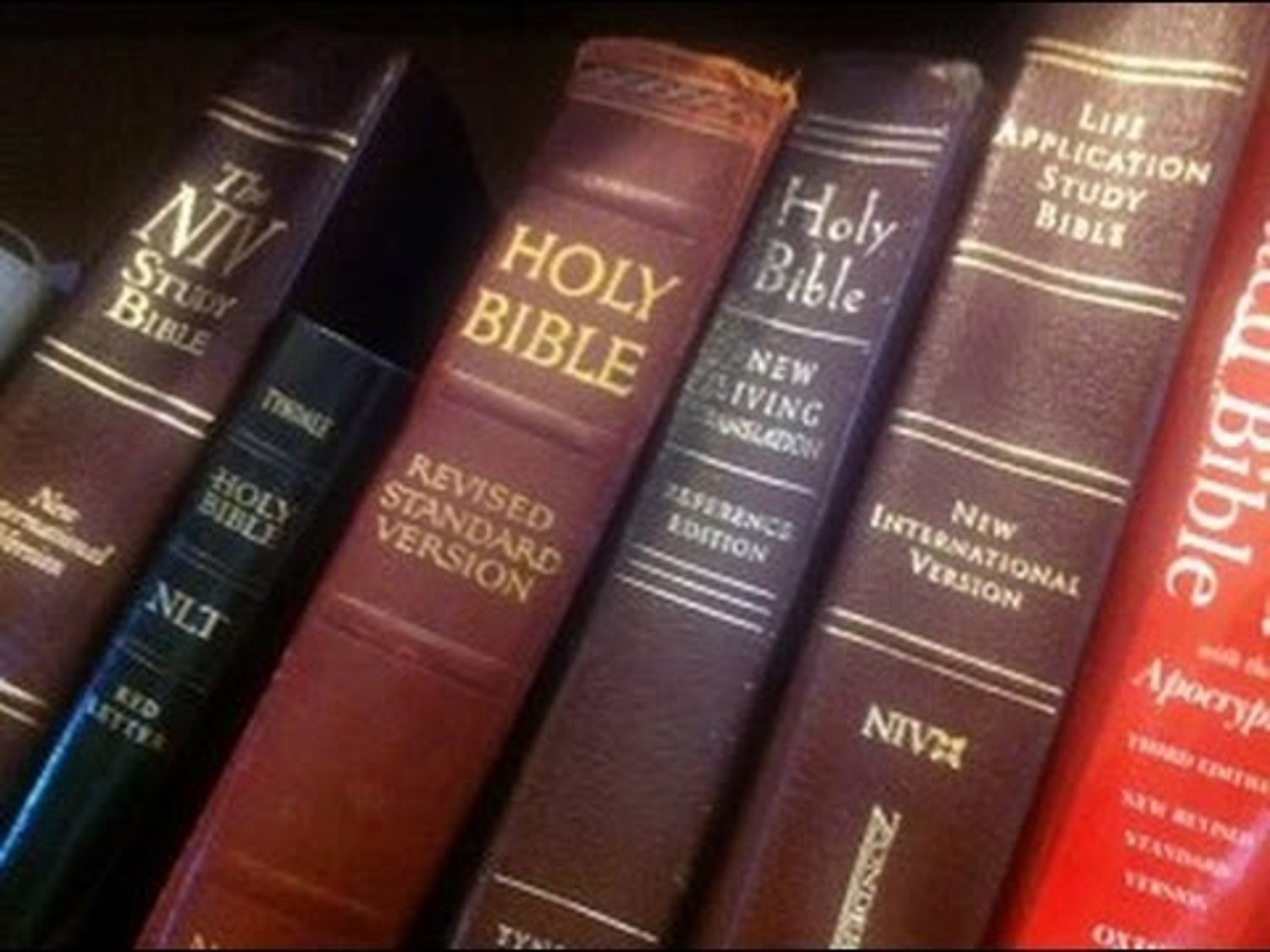
Literal translations relay the actual words used in the original language without being overly concerned with ease of reading or conveying the authors’ meaning. The emphasis is on what the original author says word-for-word. Dynamic translations try to relay the authors’ meaning without being overly literal—they express what the author means, not what he said. The emphasis is on what the author means without concern for using their actual words.
Here is a good example: A man speaking English says, “I shot myself in the foot.” What did he mean? Those who understand English “figures of speech” will know he was saying he made a fool of himself or did something stupid. For non-English speakers, they will look down at your foot and ask, “Is your foot OK?” If you translated the English into Russian literally, you will render it, “I shot myself in the foot.” But if you do, the Russian gets the completely-wrong message. They think we are talking about a medical condition. But if you want the Russian to understand the meaning of the author’s text, you will not use the literal words but translate it to something like, “I did something stupid and made a fool of myself.” With our example, the first is literal and the second is dynamic. The first emphasizes what the author says, the second what the author means. All translations fit somewhere in between.
So what Translations should we use? For Catholics I recommend reading the Revised Standard Bible, Catholic Edition (RSV) for the literal and the New American Bible (NAB) for the dynamic translation. It is best to read several translations side-by-side to get a much broader spectrum of the biblical passage. Want the best? Check out the Didache Bible published by Ignatius Press. I have purchased many of them to give to friends and priests. It is on the literal side of the sliding scale but becomes a dynamic translation as well by providing a plethora of footnotes and Catechism quotes.
Many suggested I include the Douay-Rheims translation. I don’t use this much myself because it’s a translation of a translation and uses old manuscripts and language. It is like translating Russian into Spanish and then Spanish into English—a hundred years ago. I use it sometimes for its strong Catholic emphasis in certain passages. Again, as I said, it is best to read many translations side-by-side. For a strong Catholic emphasis, the Douay-Rheims is a good version to have in your stack. Another might be the English translation of the Greek Septuagint, which was the Bible of the early Church.
The
chart below shows many translations, most of which are Protestant
translations, but it gives you the idea. The RSV is on the left end of
the chart, whereas the NAB is under the “thought-for-thought” category.
A paraphrase is not really a translation but the far extreme of the
dynamic where the translator puts things into his own words—often with
biases and personal opinions. If you want to find the right translation
for you, check out the Verbum Catholic Bible Software
that allows you to compare many translations side-by-side and to
instantly access the original languages with English explanations.
There’s nothing else like it!
BIBLE TRANSLATIONS
| WORD-FOR- WORD | THOUGHT-FOR-THOUGHT | #PARAPHRASE |
| New American Standard Bible | Holman Christian Standard Bible | New Int'l Reader's Version |
| Amplified Bible | New Revised Standard Bible | Good News Translation (a/k/a Good News Bible) |
| English Standard Version | *New American Bible (NAB) | Contemporary English Version |
| *Revised Standard Version (RSV) | New Jerusalem Bible | The Living Bible |
| King James Version | New International Version | The Message |
| New King James Version | Today's New International Version | |
| *Didache Bible | New Century Version | |
| New Living Translation |
*Recommended
#Paraphrase versions are not recommended
From Catholic Answers AND DefendingTheBride.Com
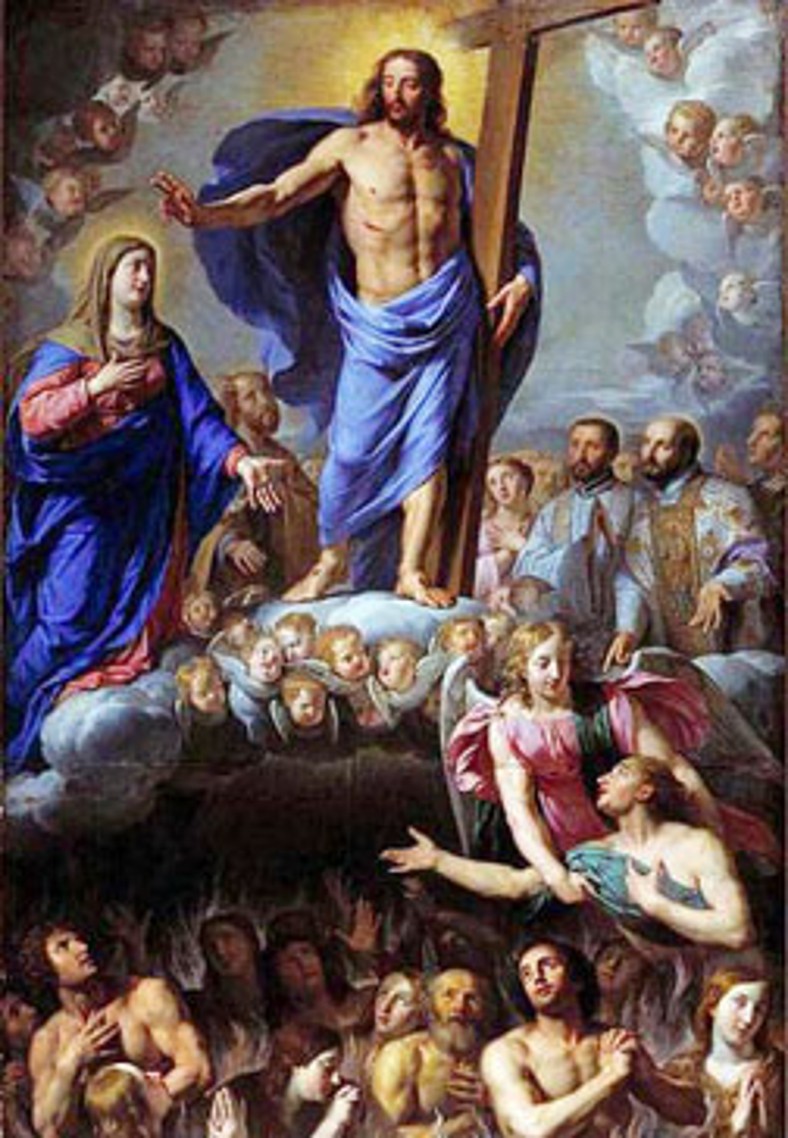
“For
if he were not expecting that those who had fallen would rise again, it
would have been superfluous and foolish to pray for the dead.
Therefore, he made atonement for the dead, that they might be delivered
from their sin” (2 Maccabees 12:39-46)
Purgatory is not a second chance, but is a temporary state that exists for our purification. Sin is a spiritual disease that attacks us from within. We need not only be forgiven, but also healed from the effects of sin. Imagine you said or did something that really hurt a close friend or family member. Most likely, you would want to do something to repair the relationship. In the same way, Purgatory is the opportunity for us to make reparation to God for the sins we failed to make reparation for on earth.
Just as we would be appalled to attend a grand banquet in our dirty work clothes, so a soul's thought of entering the Presence of the Holy God in a state of uncleanness will appall him or her. Thus, God mercifully promises “to cleanse us from all unrighteousness” (1 John 1:9). The teaching on the pains of Purgatory consists of two things: 1) pains of loss and 2) pains of sense. The pain of loss suffered by the souls in Purgatory is the greatest pain we will experience; it is the pain of being temporarily separated from the One we love—of being excluded from the beatific vision. St. Thomas Aquinas said, "For the more a thing is desired, the more painful is its absence." The pain of sense suffered by the souls in Purgatory involves the pain of purification. The nature of this cleansing has traditionally been assumed to mean a literal fire, but the only proposition the Church has dogmatically defined on this issue is that the purification involves some kind of pain. However, the Catechism teaches that the fires of Hell and Purgatory are not “vengeance inflicted by God, but follows from the very nature of sin” (CCC 1472).
In Spe Salvi, Pope Benedict quotes St. Paul, “Now if anyone builds on the foundation with gold, silver, precious stones, wood, hay, or straw, his work will become manifest; for the Day will disclose it, because it will be revealed with fire, and the fire will test what sort of work each one has done. If any man’s work is burned up, he will suffer loss, though he himself will be saved, but only as through fire” (1 Cor 3:12-15). In the Church’s catechetical tradition, this passage is traditionally used to show the Scriptural basis for the doctrine of Purgatory. The image of fire and burning may explain the common confusion of the "fire" of Purgatory with the "fire" of Hell. Lest there be any such confusion, the Catechism tells us that “this final purification of the elect…is entirely different from the punishment of the damned” (§1031). Primarily, the difference is that all who enter into the “purging fire” of Purgatory have the hope of absolute assurance that they will enter the presence of God and attain the Beatific Vision of God’s face. On the other hand, there is a total absence of hope in Hell--it is pure despair.
Another difference is that the fires of Hell are destructive, whereas the fires of Purgatory are purifying. In addition to this, the Holy Father points out that the fire described by St. Paul is nothing other than the soul’s encounter with Jesus! He writes, “The fire which both burns and saves is Christ Himself, the Judge and Savior. The encounter with Him is the decisive act of judgment. Before His gaze all falsehood melts away. This encounter with Him, as it burns us, transforms and frees us, allowing us to become truly ourselves.”
It is obvious that as we are finally separated from all our unloving attachments and stripped of our false self, we will experience pain and suffering. But this is not a cause for fear! “Yet in the pain of this encounter,” writes the Holy Father, “when the impurity and sickness of our lives become evident to us, there lies salvation. His gaze, the touch of His heart heals us through an undeniably painful transformation ‘as through fire’. But it is a blessed pain, in which the holy power of His love sears through us like a flame, enabling us to become totally ourselves and thus totally of God.” Described like this, we see not only how necessary Purgatory is, but also how desirable it is. Far from being afraid of Purgatory, we should begin to hope for it.
Objectors to the existence of Purgatory claim that “Christ’s suffering is all sufficient; therefore, there is no Purgatory.” Christ suffering IS all sufficient; however, their claim actually makes too little of Christ’s suffering by failing to recognize all that His suffering accomplishes. God does wash away all our guilt through the Sacraments, but He desires to accomplish even more than that. Christ’s suffering makes Purgatory possible. A world without a Purgatory actually would make God and His sufferings less effective than what they are.
People who die in a state of grace often have not had all their earthly desires purified on earth. Therefore, in the true and Catholic understanding, we need to be purged of those desires and sins before we can enter Heaven. We NEED Purgatory! Purgatory was made possible by the grace that Jesus won for us on the Cross. It is the state of existence where we are purged of our sinful desires and are reconciled with God in Heaven and His holy ways. No one in Heaven disagrees with God about what is good or evil, or holy or sinful, or true or heretical. So, before entering Heaven, we need to be purified of all that is wrong. “But nothing unclean shall enter it, nor anyone who practices abomination or falsehood, but only those who are written in the Lamb’s Book of Life” (Rev. 21:27).
Published in the Bulletin of July 3, 2016
By Leon Suprenat and Philip Gray
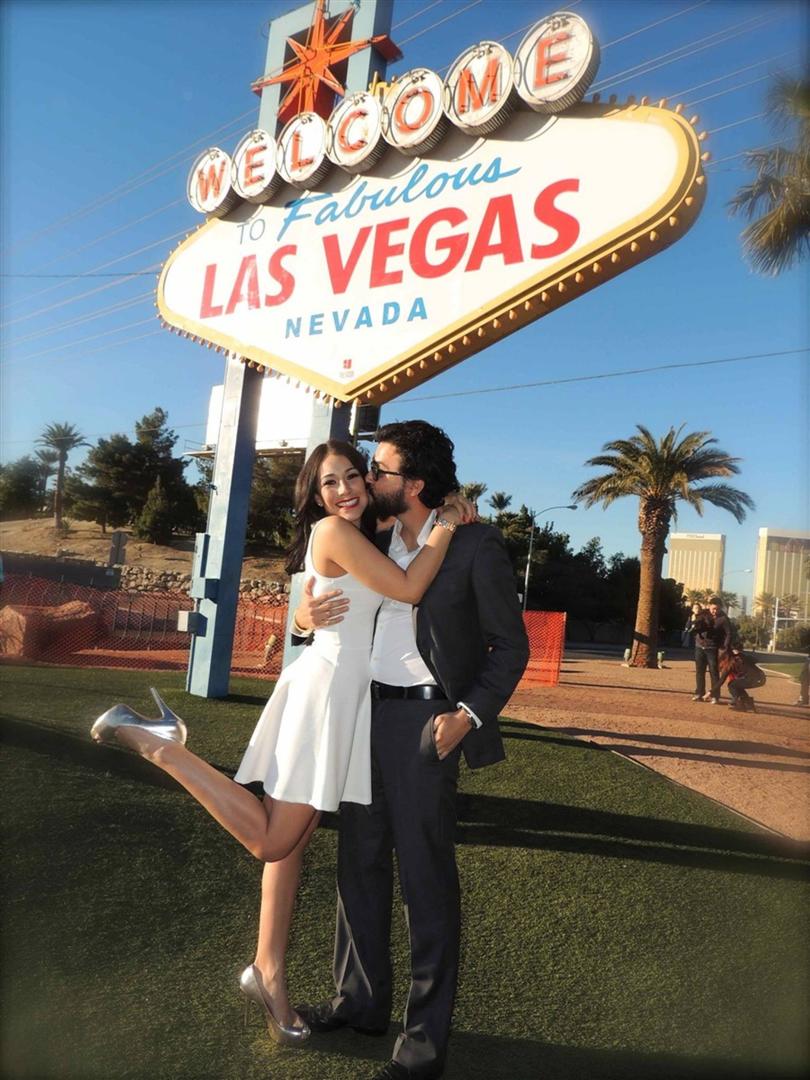
"How are Catholics to Handle Attending Problematic Weddings?"
Does the Catholic Church prohibit Catholics from attending weddings that the Church does not recognize?
If a Catholic is invited to such a wedding and can attend, is it permissible for him to be in the wedding party?
The Catholic Church does not explicitly prohibit Catholics from attending weddings whose validity she does not recognize. There are certain moral principles, however, that should be considered before a Catholic decides how to proceed. Most importantly, Catholics must avoid any actions that cause scandal or encourage others to sin. In today’s society, many couples live together before marriage, and divorce and remarriage are common. In addition, many Catholics marry outside the Church. Couples in these situations commit the sins of fornication or adultery. Because of these objectively sinful circumstances, Christians are often left in a quandary when they are invited to weddings the Church does not recognize--particularly when friends or relatives are involved. The way in which one prayerfully responds to these invitations must witness to the truths taught by Christ. Our actions must encourage and promote the salvation of all.
In continuing the work of Christ, the Church--without compromising her own holiness--embraces sinners and cleanses them with her sacraments (cf. Catechism, no. 827). Following Jesus’ example, we need to associate with fellow sinners, yet do so in a way that is ordered to their salvation and ours. If we allow or participate in the sin of another, we share that sin and its consequences. As the Catechism teaches, “Sin is a personal act. Moreover, we have a responsibility for the sins committed by others when we cooperate in them by 1) participating directly and voluntarily in them; 2) ordering, advising, praising, or approving them; 3) not disclosing or not hindering them when we have an obligation to do so; and 4) protecting evil-doers” (no. 1868).
Anyone who uses the power at his disposal in such a way that it leads others to do wrong becomes guilty of scandal and responsible for the evil that he has directly or indirectly encouraged. “Temptations to sin are sure to come; but woe to him by whom they come!” [Lk. 17:1] (nos. 2284, 2287). Fornication and adultery are grave violations of the Sixth Commandment (cf. Catechism, nos. 2331–2400). Those who persist in these sins endanger their salvation. Living together before marriage typically implies fornication (cf. Catechism, no. 2353). The subsequent marriage of the couple does not blot out the sins they already committed, nor does the wedding itself necessarily change their attitudes or habits toward chastity and purity. Remarriage following divorce is an act of adultery, whether or not the “spouses” are Catholic (cf. Mk. 10:10–12; Catechism, no. 2384). When a Catholic marries outside the Church, the union is considered illicit.
If a Catholic is asked to attend the wedding of a couple whose marriage is not recognized by the Church, he should ask himself: “What message will I send by my attendance? Will attending such a wedding encourage or hinder the salvation of others? What will not attending accomplish? If I go, will others consider my presence to be affirming of the sin? Will I commit scandal? How can I best witness to the truth?” A Catholic should not affirm fornication or adultery, nor should he give the appearance to others that he condones the acts. Such appearance can cause scandal. If his actions affirm or encourage the sin, he participates in the sin.
There is a real concern that if a person refuses to attend the wedding, a rift in friendship could occur. This division could hinder any witness to the truth, and this concern is especially serious if the wedding involves a close friend or family member. This concern alone must not hinder our witness (cf. Lk. 12:51–53), but it can guide our actions as we fulfill our obligation to bring others to Christ. It could be that not attending would destroy any possible chance to witness the truth to the persons involved, especially if no reason is given for not attending. It could also be that not attending, and giving reasons for the absence, will help the couple choose the way of Christ. If a Catholic chooses to attend, he will want to ensure that no one considers his presence to be an affirmation of the sin.
These principles apply whether one is a member of the wedding party, is attending the wedding, or is simply attending the reception. Participating in the wedding party, however, is more visible and will generally be understood as an affirmation of the union. It would be very difficult for a member of the wedding party to attend without affirming the situation or at least giving the impression to others that he is doing so. All who attend the reception should consider that discussions about the couple and their life together will arise. This may be more difficult for some people to handle without affirming the couple’s situation or bringing scandal to others. If one plans to attend the reception, one should consider what one will say about the couple’s situation when the merriment begins and everyone is talking about how wonderful this “marriage” is.
Morally speaking, there are many factors to consider before we judge such participation to be scandalous. Some situations are more conducive to scandal than others. Before we can witness to the truth, people must be open to what we have to say. In the same way, before our actions cause scandal, people have to consider our actions worthy of notice. What is important to remember is that we must prayerfully consider the situation, our response, and the probable reaction of others to our response. Using the teachings explained in the Catechism, we should ask ourselves, “How can we avoid participating in their sin, yet encourage their salvation? How can we avoid scandal, yet encourage the salvation of others?”
It is wise for anyone in this situation to discuss the matter with a spiritual director or confessor before making a decision. Whatever one’s decision may be, a Catholic should strive to give a clear and charitable witness to the faith. The Church does not teach whether we must or must not attend such a wedding. Christ does say we must witness to the truth in a charitable manner. If loved ones or friends go through with the wedding, a Catholic should look for opportunities to maintain contact and witness to the truth. Above all, our decisions and actions must promote the salvation of souls. In fostering the salvation of souls, the two great commandments are fulfilled.
Published in the Bulletin of August 7, 2016
From the websites of the U.S. Conference of Catholic Bishops and the L.A. Archdiocese
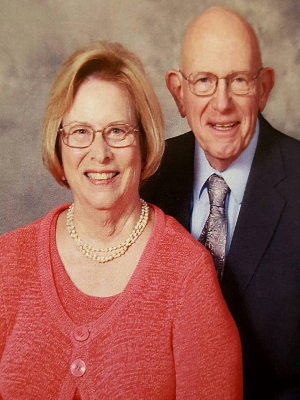
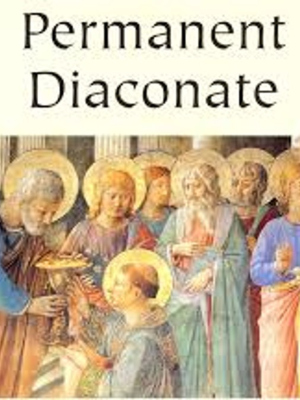
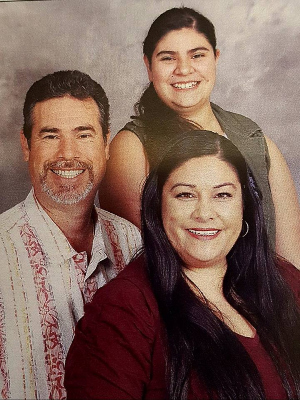
"What is the 'Permanent Diaconate'?" In the Catholic Church, the diaconate is the first of the three ranks in ordained ministry (followed by priests and bishops). Deacons preparing for the priesthood are transitional deacons. Those not planning to be ordained priests are called Permanent Deacons. All ordained ministers in the Church are called to functions of the Word and the Sacraments, but bishops, priests, and deacons exercise these functions in different ways. As ministers of the Word, deacons proclaim the Gospel, preach, and teach in the name of the Church. As ministers of the Sacraments, deacons baptize, lead the faithful in prayer, witness marriages, and conduct wakes and funeral services. They cannot celebrate Mass nor administer the Sacraments of Confirmation, Anointing, or Reconciliation. Both married and single men between the ages of 30 and 60 may be ordained permanent deacons; however, single men will not be allowed to marry after ordination. If a Deacon candidate is married, it is required that his wife be in complete support of him and that she attend the five-year preparation process along with him. If a permanent deacon's wife should die, he would not be allowed to remarry and would then practice celibacy.
For many years ordained ministers "ascended" from one office to another, culminating in ordination to the priesthood. The Second Vatican Council (1962–1965), however, authorized the restoration of the diaconate as a PERMANENT order of ministry. While students of the priesthood are still ordained deacons prior to their ordination as priests, there are more than 13,000 Permanent Deacons in the United States alone. There is no difference in the sacramental sign or the functions between "transitional" and "permanent” deacons.
A man ordained to the priesthood is to serve the Diocesan Church. Deacons are no different in this regard: they are assigned by the bishop to ministries for which the bishop perceives a great need, and for which the deacon may have special gifts or talents. Most often, this will be within a parish setting, just as most priests serve in a parish. Once assigned to the parish, the deacon and any other clergy assigned to the parish minister under the immediate supervision of the pastor.
The selection of diaconate candidates follows the guidelines presented by the National Conference of Catholic Bishops. An essential principle indicated by the NCCB is that the diaconate is a ministry and never an honor or personal reward. The call to the diaconate is both a call from God to serve and a call from the community of faith which is to be served. This call does not come to the individual alone, nor for his own sake. Anyone who hears such a call must have the gift validated by the Church.
In assessing prospective diaconate candidates, the general requirements--in addition to those mentioned above--are that a candidate be: fully initiated into the Roman Catholic Church for a minimum of three years; actively involved in the Church and faithful in the practice of the Faith; recommended by his pastor; active for at least six months in hands-on service to those in need; and in good physical and mental health. In addition, those who are married must have been married for at least three years and be in stable and sacramental marriages; those widowed must have been so for at least two years to allow for healing; those single must be celibate for at least three years before applying in order to demonstrate stable, settled lives, with histories of healthy relationships.
Here at St. Therese Church, DEACON JOE & LORRAINE MIZERSKI (pictured at the top on the left) have served as our Deacon Couple since Deacon Joe was ordained on June 10, 2000. At the time of the writing of this article, one of our parishioners, Gil VARGAS, along with his wife FRANCES (pictured at the top on the right), are in their fourth year of the five-year preparation process for the Permanent Diaconate. Following the successful completion of the program, Gil is set to be ordained on June 10, 2017 (exactly 17 years after Deacon Joe!).
If you are interested in serving as a Deacon and meet the qualifications, please contact the Diaconate Formation Office for the Archdiocese of Los Angeles at 3424 Wilshire Boulevard, Los Angeles 90010, or 213-637-7383.
"Deacons likewise must be dignified, not double-tongued, not addicted to much wine, not greedy for dishonest gain. Then let them serve as deacons if they prove themselves blameless. Their wives likewise must be dignified, not slanderers, but sober-minded, faithful in all things. Let deacons each be the husband of one wife, managing their children and their own households well" --1 Timothy 3:8-13.
by Rhonda Storey
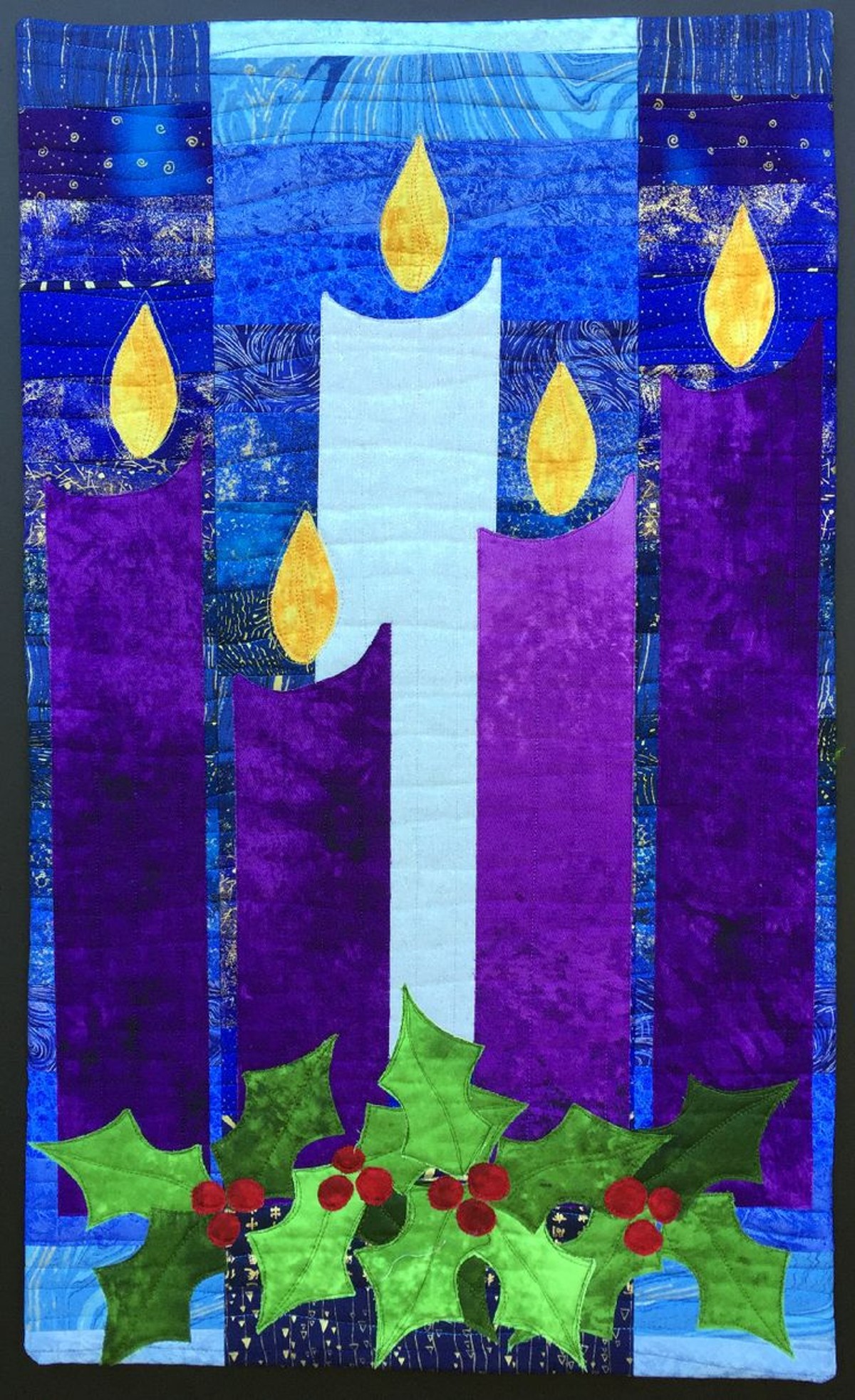
Advent devotions, including the Advent wreath, remind us of the meaning of the season. An Advent calendar can help you fully enter in to the season with daily activities and prayer suggestions to prepare you spiritually for the birth of Jesus Christ.
The History of Advent: The word “Advent” is derived from the Latin word adventus, meaning “coming,” which is a translation of the Greek word parousia. Scholars believe that during the 4th and 5th centuries in Spain and Gaul, Advent was a season of preparation for the baptism of new Christians at the January feast of Epiphany, the celebration of God’s incarnation represented by the visit of the Magi to the Baby Jesus (Matthew 2:1), His baptism in the Jordan River by John the Baptist (John 1:29), and His first miracle at Cana (John 2:1). During this season of preparation, Christians would spend 40 days in penance, prayer, and fasting to prepare for this celebration; originally, there was little connection between Advent and Christmas. By the 6th century, however, Roman Christians had tied Advent to the coming of Christ. But the “coming” they had in mind was not Christ’s first coming in the manger in Bethlehem, but His Second Coming in the clouds as the judge of the world. It was not until the Middle Ages that the Advent season was explicitly linked to Christ’s first coming at Christmas.
Advent Today: Today, the Advent season lasts for four Sundays leading up to Christmas. At that time, the new Christian year begins with the twelve-day celebration of Christmastide, which lasts from Christmas Eve until Epiphany (this year, on January 8). Advent symbolizes the present situation of the Church in these “last days” (Acts 2:17; Hebrews 1:2), as God’s people wait for the return of Christ in glory to consummate His eternal kingdom. The church is in a similar situation to Israel at the end of the Old Testament: in exile, waiting and hoping in prayerful expectation for the coming of the Messiah. Israel looked back to God’s past gracious actions on their behalf in leading them out of Egypt in the Exodus; and, on this basis, they called for God once again to act for them. In the same way, the Church, during Advent, looks back upon Christ’s coming in celebration while at the same time looking forward in eager anticipation to the coming of Christ’s kingdom when He returns for His people. In this light, the Advent hymn, “O Come, O Come, Emmanuel” perfectly represents the Church’s cry during the Advent season:
O come, O come, Emmanuel, And ransom captive Israel,
That mourns in lonely exile here, Until the Son of God appears.
Rejoice! Rejoice! Emmanuel shall come to thee, O Israel.
While Israel would have sung the song in expectation of Christ’s first coming, the Church now sings the song in commemoration of that first coming and in expectation of the second coming in the future.
Published in the Bulletin of December 4, 2016
By Catholic Answers
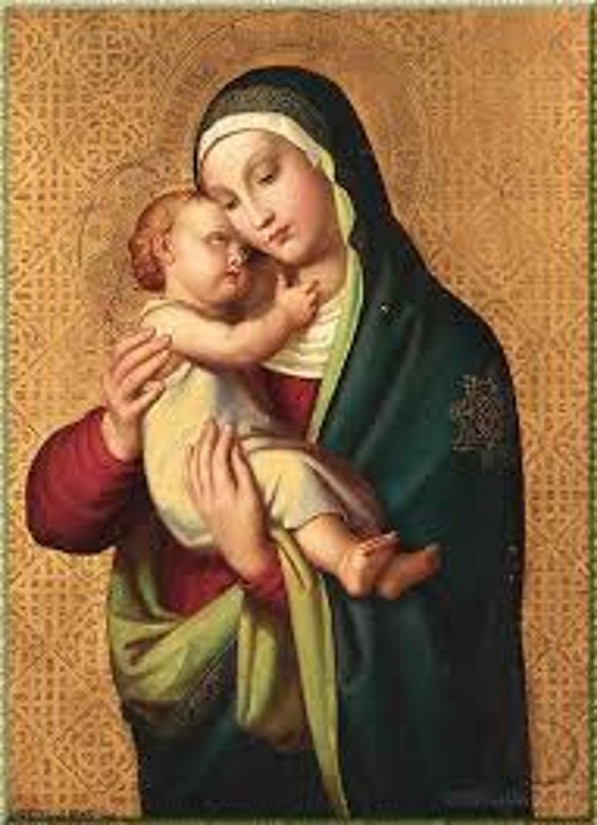
Since the Son born to Mary is a single Person (and that Person is God) with two natures, Mary can rightly be called the Mother of God. The Person she's the mother of is God. He's not, strictly and philosophically speaking, a human person, as we are. This doesn't mean that Mary existed before God (which is an impossibility). She is a human person with a human nature. She existed before Jesus' human nature was created.
Here's another way to look at it. A woman can't be the mother merely of a nature. She can only be the mother of a person who possesses a nature. When a child is conceived, he is a person, not just a nature. The same is true of Jesus, or else He would be two persons in addition to having two natures. Since Mary is the Mother not of Jesus' human nature but of Jesus the God-Man, a divine Person, she is rightly called the Mother of God.
The title “Mother of God” is the Western Church’s equivalent of the ancient Eastern title “Theotokos,” which means “God-bearer.” In 431, the Council of Ephesus sanctioned the title Theotokos for Mary as a way of declaring and protecting the divinity of Christ. The title declares the most important truth about Mary: She is the Mother of God. When we celebrate this feast on January 1, we honor not only Mary but also Jesus, True God and True Man. We proclaim the glorious truth that in Mary’s womb the Second Person of the Trinity united Himself completely with our humanity. “Taking a body like our own, He surrendered His body to death in place of all. Through this union of the immortal Son of God with our human nature, all were clothed with incorruption” (St. Athanasius, On the Incarnation, 8,9).
In Mary, we see the portrait of one who knew God’s shining face upon her, filling her with grace (Numbers 6:25). Looking upon her with love and showering her with divine blessings, God prepared her to say “yes” to His plan that she bear His Son into this world. As Mary consented in faith, the Father gave her His peace (6:26), continually encouraging her to trust Him as she saw His plan unfold. How deeply she must have needed this peace, as she faced dangerous and frightening circumstances such as giving birth in a faraway city in a cave, or fleeing to Egypt in the dead of night (Luke 2:4-7; Matthew 2:13-15). In each situation, Mary learned to trust more fully that God would bless her and keep her (Numbers 6:24).
Because the Son of God took flesh in Mary’s womb, we too can share in these glorious blessings. We have been baptized into Christ; we have a share in His humanity. We are heirs of the blessings that God gave to Israel and in a particular way to Mary, the beloved Daughter of Zion. Like Mary, we can walk confidently in the blessing and peace of the Lord. The Son of God, who left His throne to become one like us, has conquered sin and death for all of us. Each day, we can freely receive the life of Jesus into our hearts simply by responding “yes” to the Lord’s call, just as Mary did. By Jesus’ sanctifying blood, we have been made vessels of the Holy Spirit, enabling us to cry out “Abba! Father!” as true sons and daughters of God (Galatians 4:6-7). The Lord is not far off, but very near; indeed He dwells within us through His Holy Spirit. Let us turn to Him and allow His blessing, grace, and mercy to shine upon us.
Published in the Bulletin of January 1, 2017
CATEGORIES: So that you may more easily find the answers to your questions, the categories (in alphabetic order) into which these articles fall are listed to the right. Some articles appear in more than one category.
The titles of the articles can be seen below; they are listed in the order of publication in the bulletin.
By Ruben Beltran
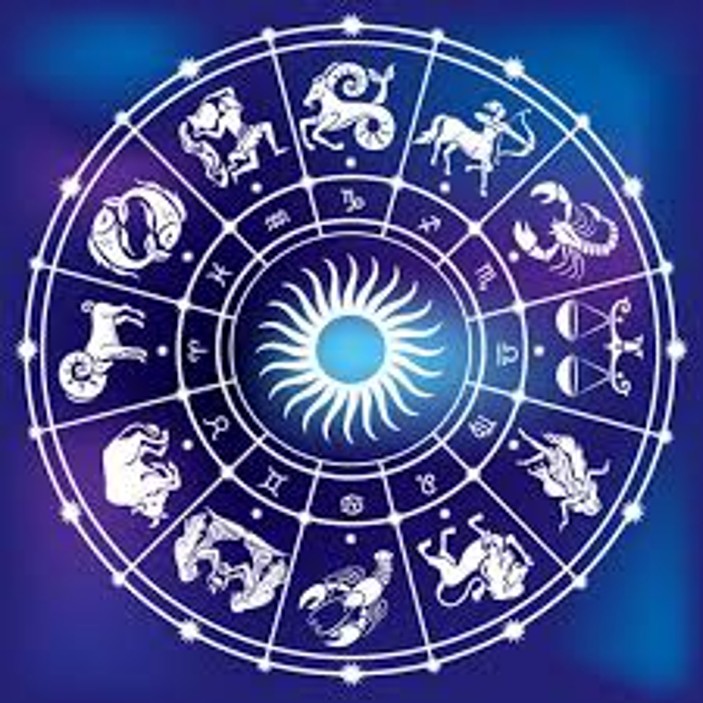
"What Does the Church Teach About Consulting Astrology / Horoscopes?" Since
the beginning of time, people have looked to the heavens to discern
their fates. The pagan world was ruled by belief in astrology. Pagans
believed that the stars were deities or that they were controlled by
deities. For instance, Apollo was the god of the sun, and his sister
Diana was the goddess of the moon. In fact, all of the planets in our
solar system are named after gods (Mercury, Venus, Mars, Jupiter, and
Saturn).
Because of this common pagan belief, the Old Testament contains repeated injunctions against star-worship (Deuteronomy 4:19, 17:3; 2 Kings 17:16, 21:3–5, 23:4; Jeremiah 8:2, 19:12–13; Zephaniah 1:4–6). Today, the practice of astrology is still going strong, especially amongst teens. You cannot open a magazine or surf the web without running into a section on Horoscopes. It’s always some weirdo giving vague predictions of how your relationships are going or what future business opportunities to take. So what does the Catholic Church say when it comes to Astrology and Horoscopes?
The Catechism of the Catholic Church states, "All forms of divination are to be rejected: recourse to Satan or demons, conjuring up the dead, or other practices falsely supposed to ‘unveil’ the future. Consulting horoscopes, astrology, palm reading, interpretation of omens and lots, the phenomena of clairvoyance, and recourse to mediums all conceal a desire for power over time, history and, in the last analysis, other human beings, as well as a wish to conciliate hidden powers. They contradict the honor, respect, and loving fear that we owe to God alone" (CCC 2116).
Many times people will tell me that consulting their horoscope is all in good fun, but The Catechism makes it very clear that ALL forms of divination are condemned—no matter how innocent they may seem. Most of these astrologers, mediums, and necromancers (those who say they can speak to the dead) have been shown to be frauds; and those who appear to have these abilities gain their powers from malicious spirits.
The Church Fathers were aware of this and were quick to attribute it to demons. We must be very careful as Catholics to not fall into superstitious beliefs. We must avoid all temptation to want to know and control our future. If we do not, we will fall into the same trap Satan set for Adam and Eve. Like our first parents, through pride, we wish to grasp at the fruit of the Tree of Knowledge and become “like God”. We must fight this temptation at all costs and trust in Christ. We must ignore the storms of life and focus on the King of kings, never being distracted. If we do not, we are doomed to sink as Peter did (Matthew 14:22-33).
So next time someone asks you what your sign is, simply respond, “the Cross”.
Published in the Bulletin of January 8, 2016
Submitted by Rhonda Storey
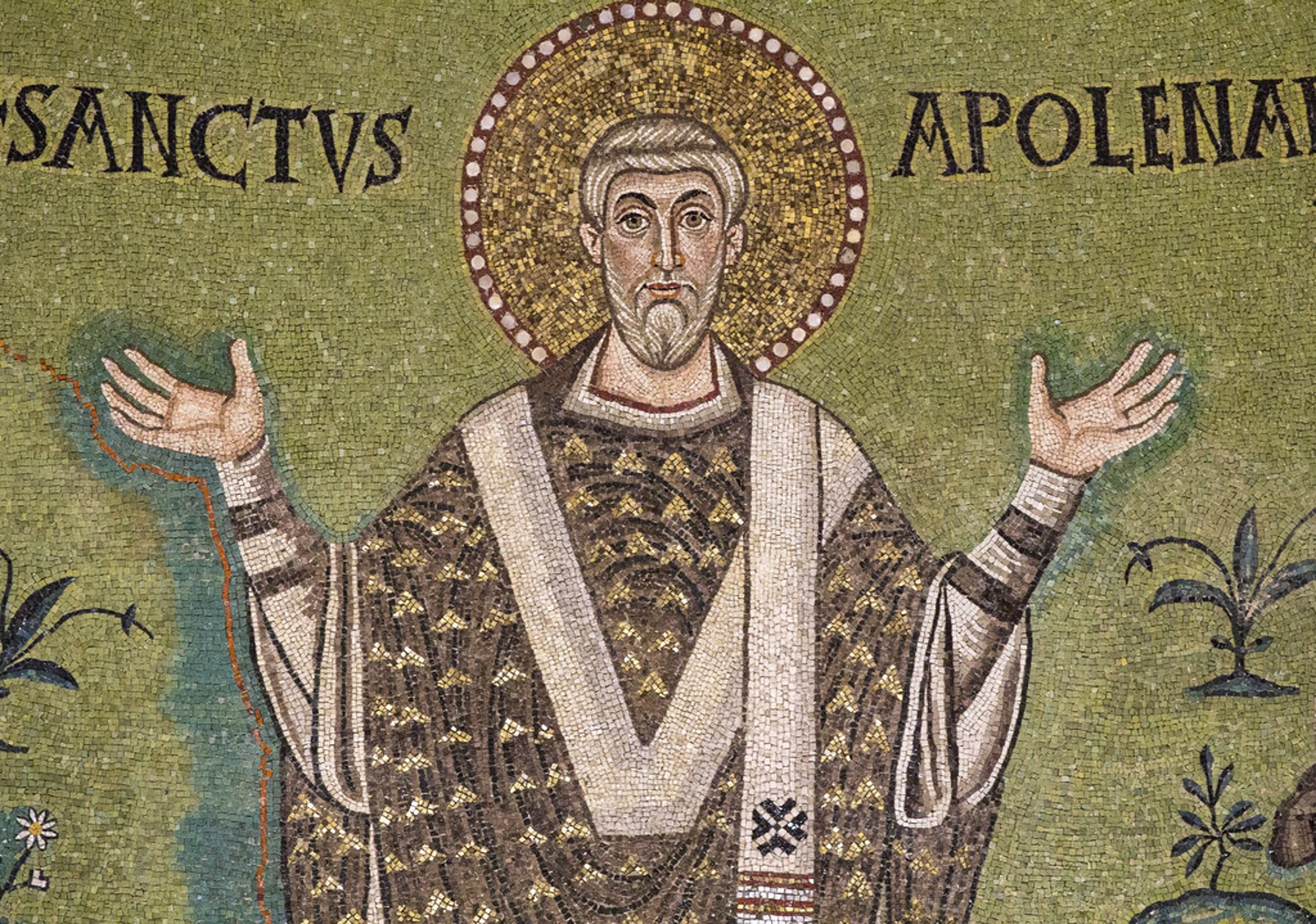
When such a question comes up, the obvious solution is to go to the rubrics. Unfortunately, in this case, the General Instruction on the Roman Missal (GIRM) is relatively silent on the topic. Because of the GIRM’s silence, many people have taken this to mean that the faithful may do whatever they want. However, this is not the case.
In the document, Instruction On Certain Questions Regarding the Collaboration of the Non-Ordained Faithful in the Sacred Ministry of Priests, put out by the Vatican on August 15, 1997, we read, "In Eucharistic celebrations, deacons and non-ordained members of the faithful may not pronounce prayers—especially not the Eucharistic prayer, with its concluding doxology—or any other parts of the liturgy reserved to the celebrant priest. Neither may deacons or non-ordained members of the faithful use gestures or actions which are proper to the same priest celebrant. It is a grave abuse for any member of the non-ordained faithful to "quasi preside" at the Mass while leaving only that minimal participation to the priest which is necessary to secure validity" (ICP Practical Provisions 6 §2).
What the above statement means is that we may not say the Eucharistic prayers along with the priest. Believe it or not, I see people mouthing the words along with the priest every week. More importantly to this topic, this also means the faithful may not use the same gestures that are reserved for the priest celebrant. As mentioned above, the GIRM is silent with regard to the posture of the faithful during the Our Father, however, the Sacramentary (the book of prayers for Mass used by the priest) states that the celebrant is to pray the Our Father with hands extended. Looking back at ICP, the faithful are NOT to use gestures or actions proper to the priest celebrant. Using this argument, one would think that the rubrics could be used to appeal to the faithful. Unfortunately, many of the faithful view the rubrics as another set of rules and those of us who wish to enforce the rubrics are no better than the Pharisees.
In that regard, let us look instead to another reason why the Orans Posture (and subsequently, joining hands) is not an appropriate gesture for the faithful during the Our Father. The Our Father takes place during the Liturgy of the Eucharist. This time of prayer and offering is directed to God (as is the entire Mass, but more specifically during the Liturgy of the Eucharist). As it is directed toward God, the extending and/or joining of hands creates a horizontal emphasis on the prayer, as opposed to the vertical emphasis that it demands. Many people who prefer joining hands or the Orans Posture argue that the Our Father is a community prayer, and as such joining and/or extending hands is a visible sign of that community. However, the Our Father is a community prayer, not because we join or extend our hands, but because we pray it together as the Body of Christ.
On September 3, 1958, the Sacred Congregation for Rites issued a document titled De Musica Sacra et Sacra Liturgia (Instruction on Sacred Music and Sacred Liturgy). This document stated, “Since the Pater Noster is a fitting and ancient prayer of preparation for Communion, the entire congregation may recite this prayer in unison with the priest in low Masses; the Amen at the end is to be said by all” (DM Prayers and Hymns § 32).
It was at this time that the faithful were given permission to pray the Our Father with the priest. However, the faithful maintained the same posture as before: standing, with their hands folded in prayer. Prior to this Instruction, the priest prayed the Our Father on behalf of the faithful. The Orans Posture is representative of praying on behalf of others. The next time you are at Mass, watch the priest’s gestures closely. Anytime he offers prayers on behalf of the faithful, he uses the Orans Posture. Anytime he is offering other prayers, his hands are folded together. Having a better understanding of what particular gestures mean will lead to a better understanding of the Liturgy.
American journalist Hunter S. Thompson was dead-on when he said, “Anything worth doing is worth doing right.” We are talking about the Holy Sacrifice of the Mass here. The Eucharist, “the source and summit of the Christian Life” (LG 11), is consecrated here. Jesus Christ, the King of Kings and the Lord of Lords makes Himself present during the Mass. It is of the utmost importance that we treat the Mass with the respect it deserves. This is not the time nor the place to get creative and inject one’s own style and preferences.
Published in the Bulletin of January 15, 2017
By Ed O’Neill, Catholic Apologist
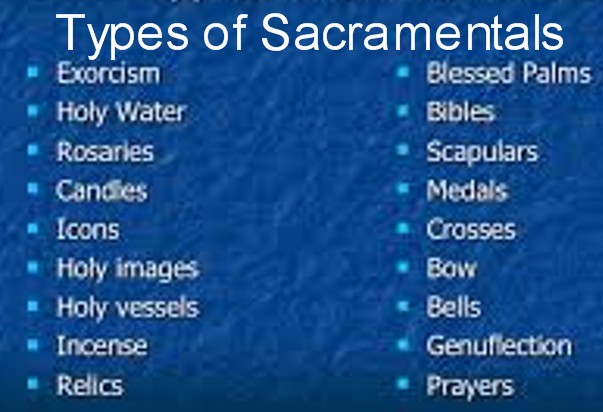
They prepare us to receive the fruit of the Sacraments and sanctify different circumstances of life. Sacramentals do not confer the grace of the Holy Spirit in the way that the Sacraments do, but by the Church's prayer, they prepare us to receive grace and dispose us to cooperate with it.
Among Sacramentals, Blessings (of persons, meals, objects, and places) come first. They include both praise of God for His works and gifts, and the Church's intercession that they may be able to use God's gifts according to the spirit of the Gospel. For example, the blessing at meals is a chance to offer God a prayer of praise and thanksgiving. It makes holy the mere need for nutrition and is a reminder of the most blessed meal, the Eucharist. The religious sense of the Christian people has always found expression in various forms of piety, such as the veneration of relics, visits to sanctuaries, pilgrimages, processions, the Stations of the Cross, the Rosary, medals, etc.
Sacramentals are often a stumbling block for non-Catholics who don’t understand their need. For instance, before his conversion to Catholicism, Dr. Scott Hahn was a staunch anti-Catholic Presbyterian minister. In his talks, Hahn often tells the story of how he discovered his grandmother’s rosary. His grandmother had just died and Hahn relates that he ripped the rosary beads to pieces pleading to God to set her free from the chains of Catholicism that had kept her bound. Today, the internationally recognized Catholic author and speaker couldn’t be more of a supporter of the Blessed Virgin Mary and a promoter of the Rosary.
Are there references to the use of Sacramentals in the Bible? While you will not find people in the Bible fingering rosary beads, wearing scapulars, or donning Miraculous Medals, there are a number of passages of Scripture that support the use of Sacramentals:
· In the Old Testament, Naaman went to Elisha for a cure for his leprosy. Elisha told him, “Go and wash seven times in the Jordan, and your flesh will heal, and you will be clean” (2 Kings 5:10).
· When the man came in contact with the bones of Elisha, he came back to life and rose to his feet (2 Kings 13:20-21).
· Jesus healed the blind man using mud (John 9:6-12).
· The woman with hemorrhages was healed by touching Jesus’ garment (Luke 8:44).
· In Acts 19:11-12, it is recounted that when face cloths or aprons that had touched the skin of Paul and were applied to the sick, diseases were healed and evil spirits released.
There are also a number of Sacramentals that are directly referenced in the Bible:
- Holy Water — Numbers 5:17 states, “In an earthen vessel [the priest] shall take holy water, as well as some dust from the floor of the tabernacle and put it in the water.”
- Sign of the Cross — St. Paul states emphatically, “May I never boast except in the Cross of our Lord Jesus Christ, through which the world has been crucified for me, and I to the world” (Galatians 6:14). In the Old Testament: “The Lord said, ‘Pass through the city, through the midst of Jerusalem, and mark an X on the foreheads of those who grieve and lament over all the abominations practiced within it. Old and young, male and female, women and children—wipe them out! But do not touch anyone marked with the X” (Ezekial 9:4,6).
- Blessed Salt: “When you have completed the purification, you must bring an unblemished young bull and an unblemished ram from the flock and present them before the Lord. The priests shall throw salt on them and sacrifice them as burnt offerings to the Lord” (Ezekial 43:23-24).
- Rosary: Finally, although the Rosary was not yet created during the time of the Bible, the main prayers used in the Rosary come from the Bible. Repetitive prayer is mentioned in the Bible, in Matthew 6:7 (“In praying, do not babble like the pagans, who think that they will be heard because of their many words.”). However, that is the only verse in Scripture that condemns such practice. There are several biblical passages that state otherwise on this issue:
· Jesus prays three times that the cup would pass from Him (Matthew 26:39-44);
· In Psalm 136, God is praised numerous times;
· In Revelations 4:8, the four living creatures cry out day and night, “Holy, holy, holy is the Lord God almighty.”
The proper use of Sacramentals implies reminds us of God’s love, mercy, and protection. Thus, to pray with a rosary or cross oneself with holy water is to put on "the armor of faith." Sacramentals often provide a tangible, richer experience of the Faith. They are meant to draw the faithful to the Church’s liturgy and Sacraments, yet realizing that the liturgy is far greater than any of them.
Published in the Bulletin of February 26, 2017
By Mike Stapp, Catholic Catechist
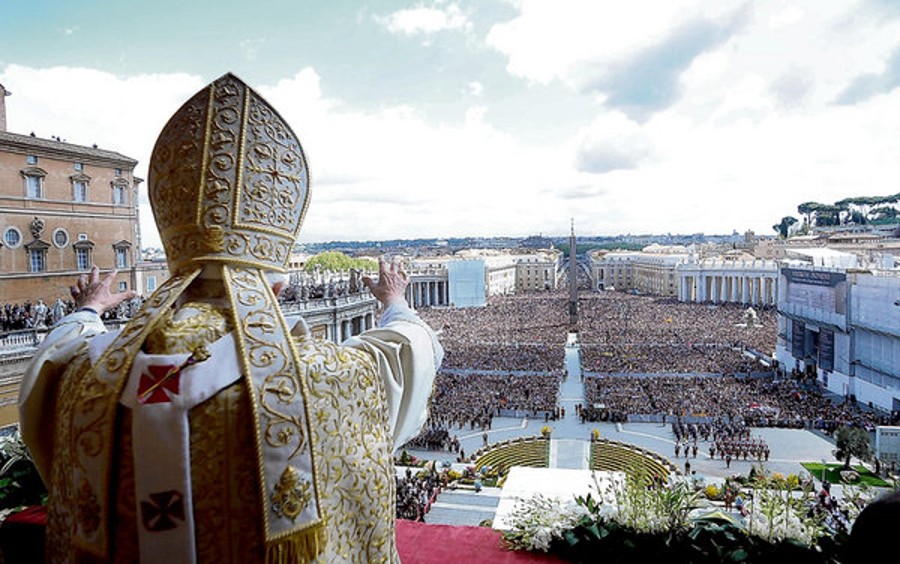
What is Papal Infallibility? First of all, let’s start with the purpose of infallibility: “It is the Magisterium’s task to preserve God’s people from deviations and defections and to guarantee them the objective possibility of professing the true faith without error... To fulfill this service, Christ endowed the Church’s shepherds with the charism of infallibility in matters of faith and morals.” (Catechism, 890). Infallibility just means that certain teachings of the Catholic Church are guaranteed to be without error—not that the Pope is correct every time he states his personal opinions or that he is unable to commit sin. The charism of infallibility is fully engaged only in definitive Magisterial teachings on faith and morals. This can occur in either Ordinary teachings or Extraordinary teachings. The Magisterium is the teaching office of the Catholic Church. It is exercised by the Pope alone when he teaches officially, OR by the whole “College” of Bishops together with the Pope.
The College of Bishops also has an “ordinary and universal” Magisterium. This is seen whenever the individual bishops teach the same faith; that is, in union with the Pope and each other. It’s also seen when an Ecumenical Council teaches definitively but without issuing a solemn definition. Occasionally, the Magisterium issues extraordinary definitions of doctrine. This occurs when the Pope teaches ex cathedra, officially and solemnly defining some truth of the faith. The official and solemn definitions of ecumenical councils (such as the Council of Trent, the First Vatican Council, etc.) are also extraordinary pronouncements.
Remember, it is the definitive teachings of the Magisterium that are considered to be infallible. This usually means that they explicitly state they’re defining some matter of the faith, or put forth a position as to be definitively held. However, some things that are taught repeatedly by the Magisterium can also be considered definitive, even if they’re not explicitly named to be such. The Catholic Church uses its charism of infallibility to give the faithful clarity and certainty about morality and the faith itself. As such, Catholics are required to give the “assent of faith” to such teachings. This means that our faith in them rests directly on our faith either in the Word of God, or in the Holy Spirit’s real and active assistance in the Magisterium.
You’ve probably heard a very common myth that infallibility has only been used a few times. That is not the case! It’s true that the Pope has exercised only rarely his own extraordinary power of defining the faith. But ecumenical councils have issued many extraordinary definitions over the years. And both the Pope and the full college of bishops have issued very many definitions in the course of their ordinary Magisterium. And, of course, infallibility hinges on whether a teaching is definitive, regardless of whether it’s ordinary or extraordinary. The main job of bishops is to teach the Gospel. They do so with a special assistance of the Holy Spirit so that we may hear a faithful, accurate proclamation of the one true Faith. Although individual bishops may err in their official teachings about faith and morals, the Magisterium as a whole never does. Nor does the Pope, by nature of Christ’s special creation of Peter’s Office as one that “confirms the brethren” in the Faith. Frequently, the Magisterium sees fit to define some point of doctrine so that we can see, understand, and hold it with great clarity. These definitions are infallible, and Catholics MUST believe them with the assent of faith.
But much of the time, the Magisterium teaches without making such definitions. Are we free to ignore these teachings that are not infallible? Not at all! We must believe these teachings, too, although a lesser degree of belief is required. The technical expression is “a religious submission of mind and will.” This is less than the absolute assent of faith, but it still means that we must honestly strive to understand and accept these teachings. As a practical matter, we should assume that even the Church’s non-definitive teachings are correct. They are still made with the assistance of the Holy Spirit, although not to the degree that guarantees that they’re free of error. We should have very compelling, objective reasons before challenging such teachings. (And please note that the most frequent topics of dissent are not in this category! Topics like contraception, abortion, divorce, and homosexuality are all addressed by definitive Church teachings.) Also remember that we tend to prefer our own flawed opinions, rather than admitting that we have to change. This call to change is the hard and unending work of Christian discipleship. It’s known as conversion.
Christ has given us an extraordinary gift in the Catholic Magisterium. It is the means by which Christ ensures that the light of His saving Gospel will shine on every generation. When the Church teaches infallibly, it gives us great light and clarity. But even in its non-definitive teaching, the Church still shines with the clear light of truth—a light that is far stronger than the darkness of the world.
Published in the Bulletin of March 5, 2017
By Catholic Answers
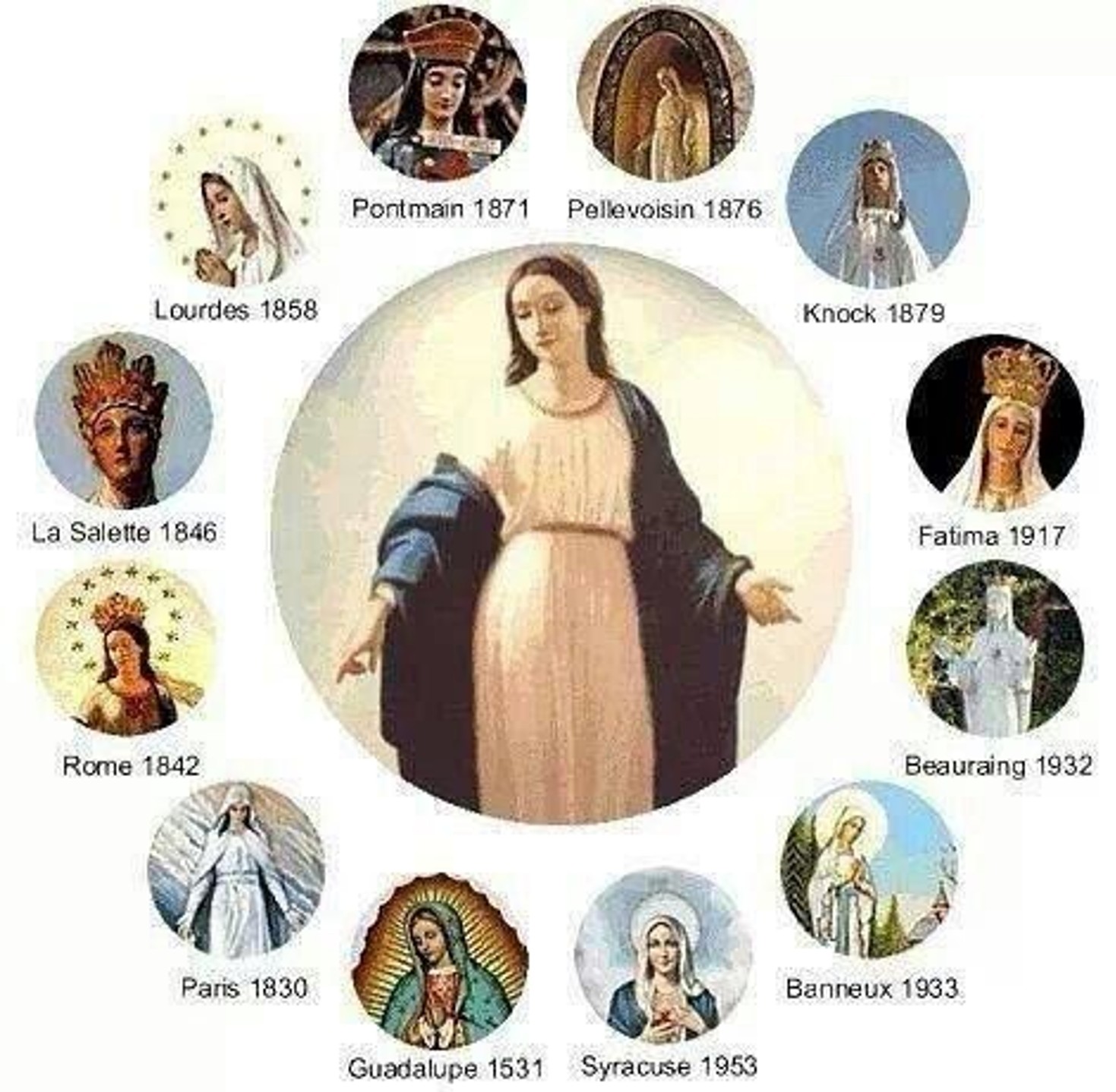
In the majority of Marian apparitions, only one person or a few people report having witnessed the apparition. According to the doctrine of the Roman Catholic Church, the era of public revelation ended with the death of the last living Apostle. A Marian apparition, if deemed genuine by Church authority, is treated as a private revelation that may emphasize some facet of the received public revelation for a specific purpose, but it can never add anything new to the deposit of faith. The Church may pronounce an apparition as worthy of belief, but belief is never required by divine faith.
An authentic apparition is believed not to be a subjective experience, but a real and objective intervention of divine power. The purpose of such apparitions is to recall and emphasize some aspect of the Christian message. The Church states that cures and other miraculous events are not the purpose of Marian apparitions, but exist primarily to validate and draw attention to the message. Apparitions of Mary are held as evidence of her continuing active presence in the life of the Church, through which she "cares for the brethren of her Son who still journey on earth."
In some apparitions, such as Our Lady of Lourdes or Our Lady of Fatima, an actual vision is reported, fully resembling that of a person being present. In some of these reports the viewers (at times children) do not initially report that they saw the Virgin Mary, but that they saw "a Lady" (often but not always dressed in white and/or blue) and had a conversation with her. In these cases, the viewers report experiences that resemble the visual and verbal interaction with a person present at the site of the apparition.
Apparitions should be distinguished from interior locutions in which no visual contact is claimed. In some cases of reported interior locutions, a large amount of text is produced, but no visual contact is claimed. Interior locutions usually do not include an auditory component, but consist of inner voices. Interior locutions are generally not classified as apparitions.
Physical contact is hardly ever reported as part of Marian apparitions. In rare cases a physical artifact is reported in apparitions. A well-known example is the image of Our Lady of Guadalupe which was miraculously imprinted on the cloak of St. Juan Diego.
Not all claims of visitations are dealt with favorably by the Roman Catholic Church. For example, claimed apparitions of Our Lady at Bayside, New York, have not been condoned or sanctioned in any way, nor those at the Necedah Shrine in Necedah, Wisconsin.
Published in the Bulletin of July 23, 2017
By Patrick Madrid
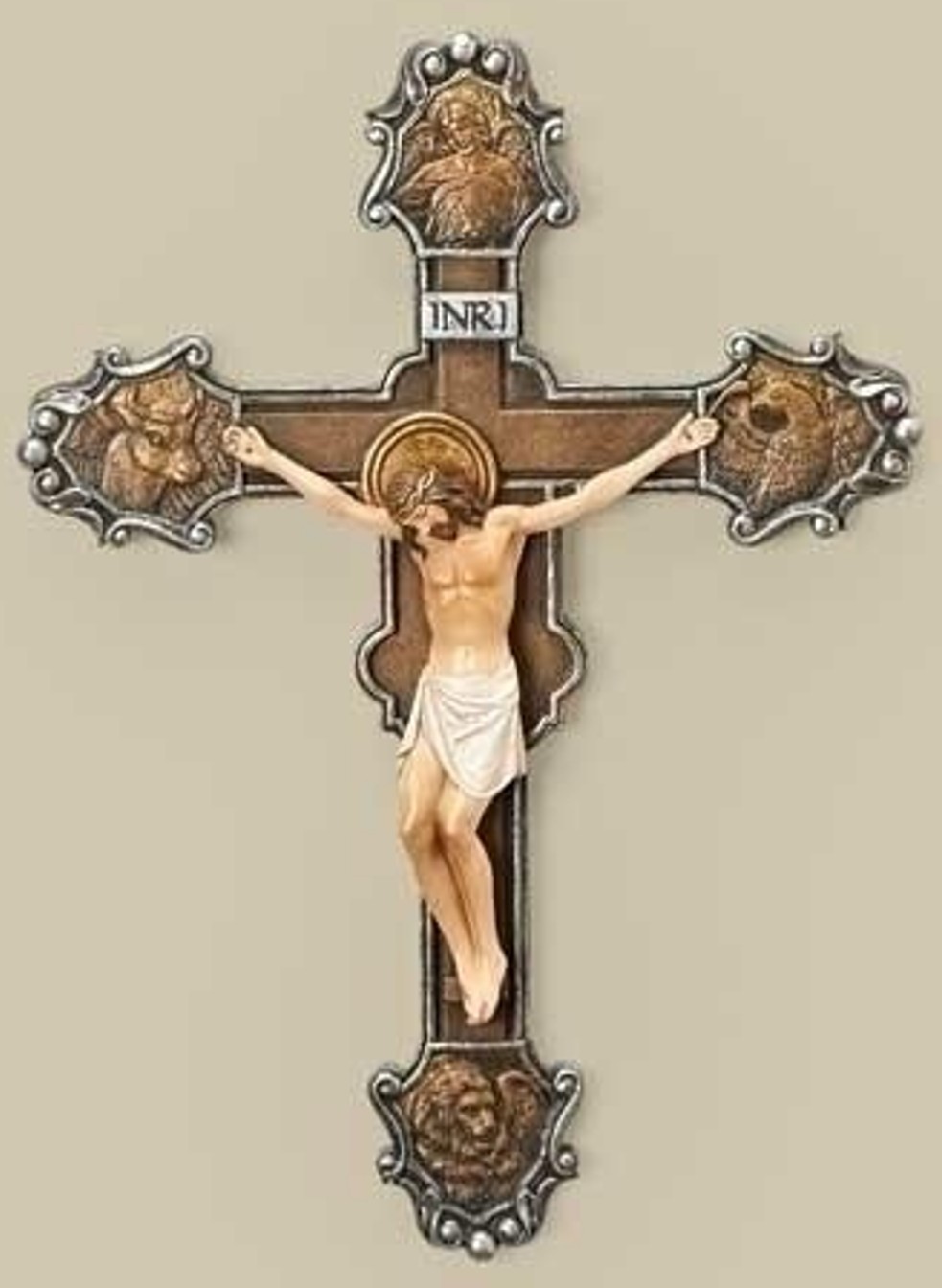
Why Do Catholics Use Crucifixes Instead Of Plain Crosses? Catholics
are often questioned why they wear and hang crucifixes, which are
crosses to which a “corpus” or the Body of Christ is attached, versus
just wearing and adorning themselves, their rosaries, their homes and
their churches with “plain crosses”. I had a Protestant Christian friend
once ask me in a church something to the effect of, “Why is Jesus still up there on that cross? He has risen from the dead.” The answer really, is quite simple, overwhelmingly powerful, and touching, yet quite to the point: Catholics
embrace crucifixes as an intensely visible reminder that Christ Jesus
suffered, died, and rose again for each one of us, every single
individual human soul of the human race that ever was, is, or will be,
and knew us all more than we know ourselves. It is the crucifix, not an unadorned cross, which most vividly underscores this fact.
Catholics emphasize both the crucifixion and the resurrection, not minimizing or downplaying the importance of either. In our manger scenes, stained glass windows, and statues, we also depict the Lord as a baby in the manger, as a toddler in his mother’s arms, and as a young man teaching the rabbis in the Temple. Each of these stages of the Lord’s life are worthy of depiction. But the focal point and purpose of Christ’s Incarnation and ministry is His death on the cross. As He Himself said, “For this I was born, and for this I have come into the world, to bear witness to the truth” (Jn 18:37). Archbishop Fulton Sheen summarized the reason for using a crucifix instead of an empty cross when he said, “Keep your eyes on the crucifix, for Jesus without the cross is a man without a mission; and the cross without Jesus is a burden without a reliever.”
Isn’t it true that when you see an empty cross, your mind automatically “sees” Christ there? After all, we recognize that the cross only has meaning because Christ died on it for our salvation. Catholics use crucifixes to avoid what St. Paul warned about, that the cross be “emptied of its power” (1 Cor 1:17). Christ’s supreme act was to die on the cross as atonement for our sins. His resurrection was proof that what He did on the cross worked—He conquered death—and it demonstrated beyond any doubt that He was who He claimed to be: God. The crucifixion was the act that changed history. The resurrection demonstrated the efficacy of that act. By His death on the cross, Christ conquered sin and death, redeemed the world, opened the way of salvation for all who would receive it, and reconciled His people with the Father (cf. Eph 2:13-18; Col 1:19-20). That is why the crucifix is such a potent reminder for us of what He did on our behalf that dark afternoon on Calvary. “Jesus told His disciples, ‘If any man would come after me, let him deny himself and take up his cross and follow me’” (Mt 16:24; cf. Mt 10:38). True, resurrection and glory await all those who follow Christ faithfully, but we will only arrive there by traveling the way of the cross.
St. Paul emphasized the crucifixion saying, “When I came to you, brethren, I did not come proclaiming to you the testimony of God in lofty words or wisdom. For I decided to know nothing among you except Jesus Christ and Him crucified” (1 Cor 2:1-2). And in 1 Corinthians 1:18-24 He said, “For the word of the cross is folly to those who are perishing, but to us who are being saved it is the power of God. For Jews demand signs and Greeks seek wisdom, but we preach Christ crucified, a stumbling block to Jews and folly to Gentiles, but to those who are called, both Jews and Greeks, Christ is the power of God and the wisdom of God.” In Galatians 6:14 he proclaimed: “But far be it from me to glory except in the cross of our Lord Jesus Christ, by which the world has been crucified to me, and I to the world.”
And lest anyone imagine that the early Christians did not focus their minds on Christ’s death on the cross, consider what St. Paul says in 1 Corinthians 11:26, where he again emphasizes the crucifixion: “For as often as you eat this Bread and drink this Cup, you proclaim the Lord’s death till He comes.” Recall the scene of the crucifixion. Some in the crowd that was present at Calvary shouted at Christ as He was dying: “Come down off your cross!” (cf. Mt 27:40; Mk 15:30). What a strange and sad echo those words sometimes find today in the arguments of those who object to the crucifix as a reminder of Christ’s sacrifice. We Catholics should strive to emulate St. Paul’s words to “know nothing among you except Jesus Christ and Him crucified” (1 Cor 2:2; cf. 1 Cor 1:17-18).
Published in the bulletin of July 30, 2017
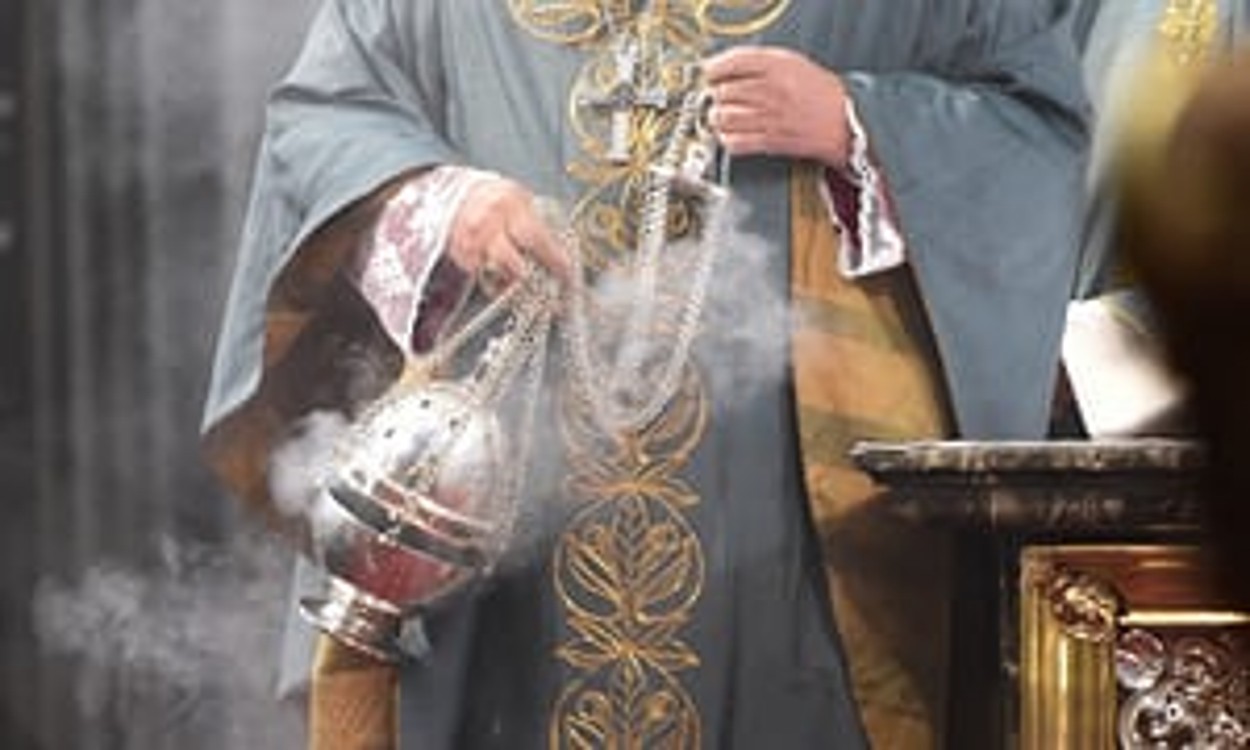
Hence, the Church’s worship contains various components that are noticeable and connect with our senses. The Catechism teaches us that, “In human life, signs and images involve a vital place. As a physical being, man communicates and sees profound substances through signs and images. As a social being, man needs signs and images to speak with others, through dialect, motions, and activities (CCC 1146).
To help connect with the greater part of our faculties amid the celebration of Mass, lifting up our bodies and souls to God, the Church for quite a long time has utilized incense as a vital outer sign. Incense was an imperative piece of love for some antiquated religions, including the Jewish people. In the Tabernacle, and also the Temple, God directed that a “sacrificial stone of incense” be constructed. God commanded that Aaron, the High Priest, “...must burn incense again when he lights the lamps at twilight so incense will burn regularly before the Lord for the generations to come” (Exodus 30:8). Associated with this custom is the best-known expression about incense in the Old Testament: “Let my supplication be set before you like incense; may the lifting up of my hands be like the evening sacrifice” (Psalm 141:2). Christians immediately received the utilization of incense, and it shows up unmistakably in the book of Revelation, as when St. John writes, “the smoke of the incense ascended with the supplications of the holy people from the hand of the holy Messenger of God” (Revelation 8:4).
In light of the above Scriptures, the essential significance behind the utilization of incense is to symbolize our supplications ascending to God. When we see the incense, we are reminded that the priest is there to pray for us before our God. Incense additionally brings to mind the wonderful reality of the Mass, reminding us that the Mass is a meeting place amongst Paradise and Earth.
Lastly, the thick billow of incense can regularly enlighten our perspective of sacred places. Our mortal personalities can’t grasp completely the mystery that is being re-presented before our eyes at the Mass; and the incense makes that reality significantly more unmistakable. So while the utilization of incense can appear to be interesting now and again, it has profound otherworldly roots and has been a piece of Heavenly love for a huge number of years.
Published in the Bulletin of August 27, 2017
by Hugh Houghton, Institute for Textual Scholarship
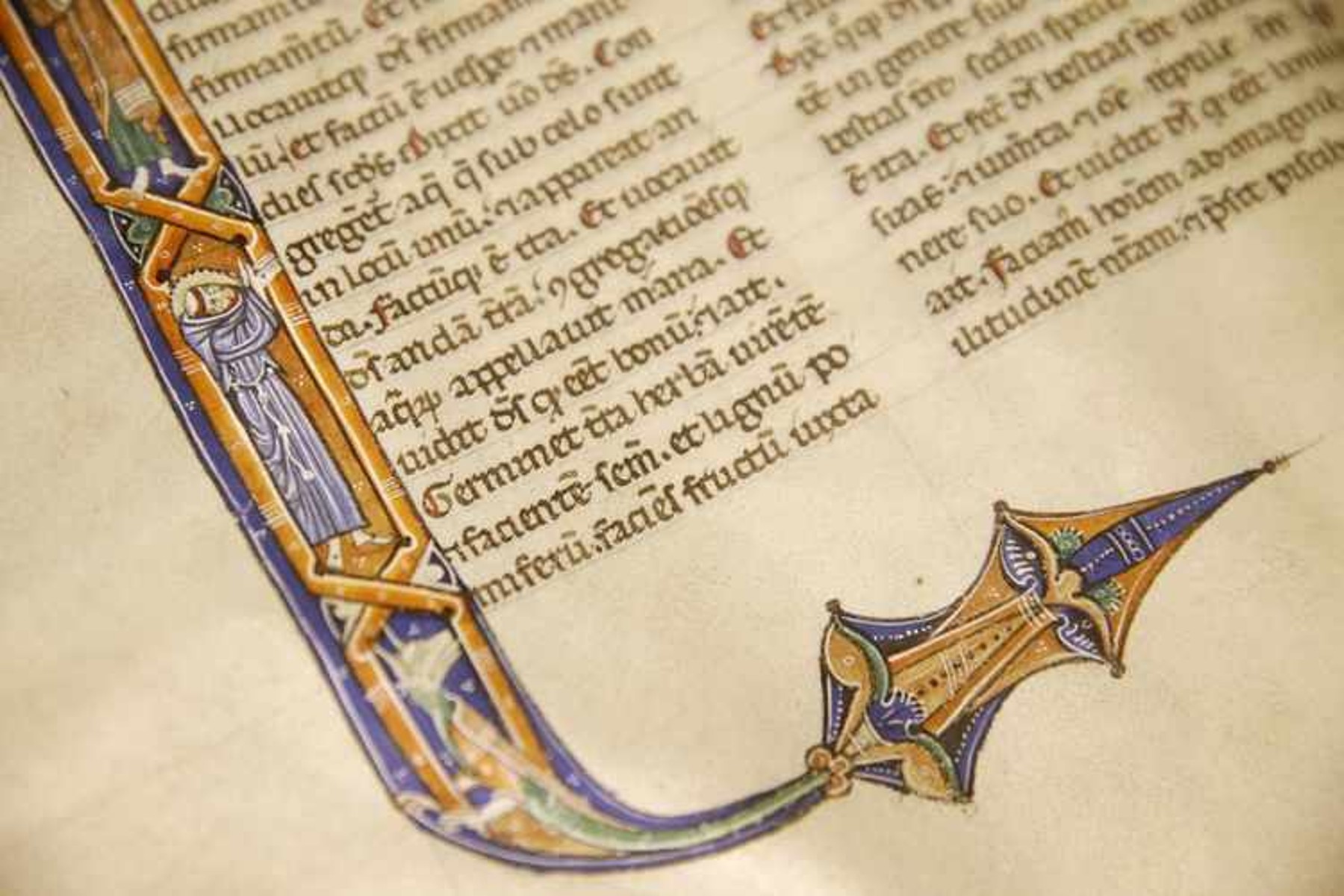
The extraordinary find, a work written by a bishop in northern Italy, Fortunatianus of Aquileia, dates back to the middle of the fourth century. The biblical text of the manuscript is of particular significance, as it predates the standard Latin version known as the Vulgate and provides new evidence about the earliest form of the Gospels in Latin. Despite references to this commentary in other ancient works, no copy was known to survive until Dr. Lukas Dorfbauer, a researcher from the University of Salzburg, identified Fortunatianus’ text in an anonymous manuscript copied around the year 800 and held in Cologne Cathedral Library.
Scholars had previously been interested in this ninth-century manuscript as the sole witness to a short letter which claimed to be from the Jewish high priest Annas to the Roman philosopher Seneca. They had dismissed the 100-page anonymous Gospel commentary as one of numerous similar works composed in the court of Charlemagne. But when he visited the library in 2012, Dorfbauer, a specialist in such writings, could see that the commentary was much older than the manuscript itself. In fact, it was none other than the earliest Latin commentary on the Gospels.
Pearls of wisdom: In his “De Viris Illustribus” (Lives of Famous Men), written at the end of the fourth century, St. Jerome, who was also responsible for the revision of the Gospels and the translation of the Hebrew Scriptures known as the Vulgate, included an entry for Fortunatianus. This prominent cleric had written a Gospel commentary including a series of chapter titles, which Jerome described as “a pearl without price.” Later Christian authors, such as Rabanus Maurus and Claudius of Turin, searched for it in vain. As with so many works from antiquity, it seemed to have been lost, the remaining copies destroyed in a raid or eaten by mice in a dusty library.
Among the features which attracted Dorfbauer’s attention was a long list of 160 chapter titles detailing the contents of the commentary, which corresponded to Jerome’s description of Fortunatianus’ work. In addition, the biblical text of the Cologne manuscript did not match the standard version of the Gospels produced by Jerome, but seemed to come from an earlier stage in the history of the Latin bible.
Groundbreaking discovery: This was where the University of Birmingham came in. The university’s Institute for Textual Scholarship and Electronic Editing (ITSEE) is home to long-term projects working on new editions of the Bible in Greek and Latin. As a specialist in the Latin New Testament, I was able to compare the biblical quotations in the Cologne manuscript with our extensive databases. Parallels with texts circulating in northern Italy in the middle of the 4th century offered a perfect fit with the context of Fortunatianus. Astonishingly, despite being copied four centuries after the last reference to his Gospel commentary, this manuscript seemed to preserve the original form of Fortunatianus’ groundbreaking work.
Such a discovery is of considerable significance to our understanding of the development of Latin biblical interpretation, which went on to play such an important part in the development of Western thought and literature. In this substantial commentary, Fortunatianus is reliant on even earlier writings which formed the link between Greek and Latin Christianity. This sheds new light on the way the Gospels were read and understood in the early Church, in particular the reading of the text known as “allegorical exegesis,” in which elements in the stories are interpreted as symbols. So, for example, when Jesus climbs into a boat on the Sea of Galilee, Fortunatianus explains that the sea which is sometimes rough and dangerous stands for the world, while the boat corresponds to the Church in which Jesus is present and carries people to safety.
English translation: In the form of a single (no longer anonymous) manuscript, or even a scholarly edition of the Latin text, it will still be some time before this work becomes as widely known as the famous writings of later Christian teachers such as Ambrose, Augustine, and Jerome. For that reason, I have worked closely with Dr. Dorfbauer to prepare an English translation of his full Latin edition of the commentary, the first ever to be produced. This will enable a much wider audience to take account of this rediscovered work. In fact, this English version may be the form in which most people will encounter Fortunatianus’ commentary, as studying languages is now a much smaller component in theological study, and online translation tools are beginning to produce more satisfactory results. You may download (for free) the English translation by going to this website: www.degruyter.com/viewbooktoc/product/469498.
Published in the Bulletin of September 3, 2017
by Matt Nelson of Catholic Answers
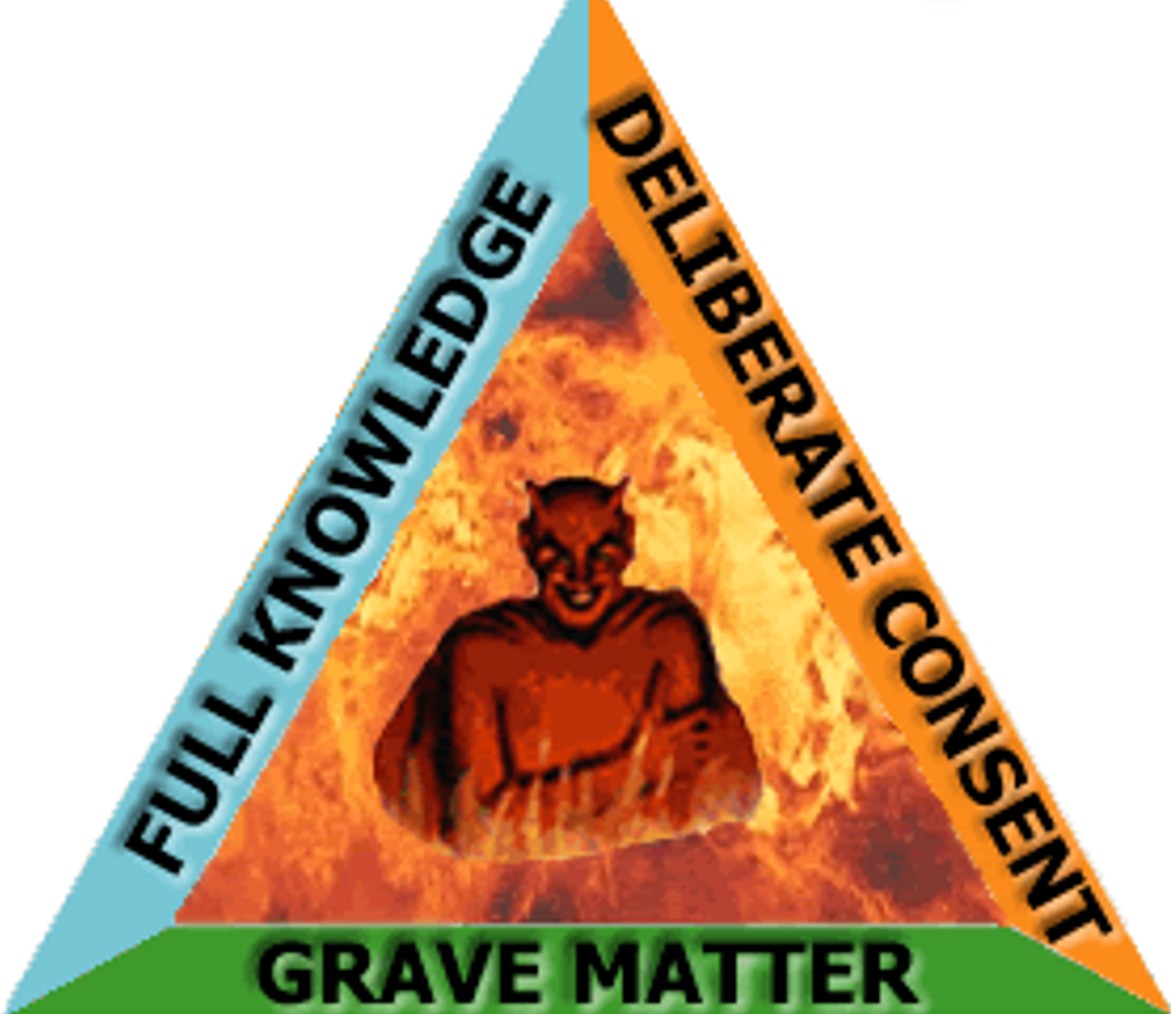
The Sunday liturgy is mandatory, like showing up for work; and, just as skipping work can have serious consequences, so can skipping church. In fact, it is a mortal sin to miss Sunday Mass without good reason. But is the “Sunday obligation” too strict of an expectation upon Catholics?
Moral laws are like signposts: they properly orient us, and once we have been properly oriented we cease to notice them. Likewise, the Sunday obligation helps to orient us spiritually. In a sense, the Sunday Mass prepares us for the days ahead and sets the spiritual tone for the week, filling us with God’s Word and grace so we might glorify the Lord with our lives. By starting our week with the Sunday liturgy, we publicly profess with our whole being that we are members of His Church and are nothing without Him. That is why Jesus said, “He who loves father or mother more than me is not worthy of me; and he who loves his son or daughter more than me is not worthy of me” (Matt. 10:37). Furthermore, the first and greatest commandment is, “You shall love the Lord your God with all your heart, and with all your soul, and with all your mind” (Matt. 22:38), which is consummated when we receive the Eucharist.
A Catholic is permitted to be absent from Sunday Mass in light of serious circumstances such as illness—but not for trivial reasons. We might be tempted to do miss because Mass is not always an engaging way to spend Sunday morning. Many of us are used to constant busyness but not used to the slowness or the silence of the liturgy. Even for a devout Catholic, it can be difficult to slow down and settle into a day of rest—and especially into a solemn hour of prayer and worship. We can’t grasp the intrinsic value of the Mass until we understand that its aim is not to stimulate like a form of entertainment—but to sanctify. Although the Eucharist is the “Source and Summit of the Christian Life,” according to the Catechism, it is not uncommon for a Catholic to feel almost nothing when he receives it (1324). Since the grace received in the Eucharist is not a physical or emotional sensation but a spiritual reality, it tends to leave the senses unmoved. For this reason, a Catholic’s experience of Sunday Mass may leave him feeling unmoved. This does not necessarily reflect a defect in the liturgy or the believer. Rather, it brings one to a deeper conviction of things unseen: “Blessed are those who have not seen and yet believe”.
Two grave dangers to the human soul are a lack of contemplation and lack of love. A human being cannot have enduring happiness without these two things. The Mass fosters both. To remember the Sabbath and keep it holy was not optional for the first-century Jew. To fail to do so was a violation of the third commandment and a grave sin (Num. 15:32-36). Christians replaced the Sabbath with a new day of rest that they called the Lord’s Day, the first day of the week. The essential moral prescription of the third commandment nonetheless remained: man ought to set apart a full day each week for rest and worship. “Think not that I have come to abolish the law and the prophets; I have come not to abolish them but to fulfill them,” Jesus said (Matt. 5:17).
Why Sunday? We are told in the Gospels that Jesus rose from the dead “on the first day of the week”, and ever since the time of the apostles, Christians have congregated on Sunday to worship God and receive the Eucharist together. To compound this, it is primarily in the act of receiving the Sunday Eucharist that the members of the Church unite themselves to their Lord and one other. Every Sunday “the whole Christ” is reunited in and through the Holy Eucharist. Moreover, our choice to participate is salvific: “Truly, truly, I say to you, unless you eat the Flesh of the Son of Man and drink His Blood, you have no life in you” (John 6:53). Theologian Colin Donovan reminds us that, “in the Mass it is Christ Himself who worships the Father, joining our worship to His. In no other way is it possible to adequately give thanks (eucharistia) to God...than by uniting our offerings to that of Jesus Christ Himself.” Christ does with us in the Mass what we cannot do alone: make a perfect offering to the Father.
The key to understanding why Catholics must attend Sunday Mass lies above all in the essence of the Mass itself. Our duty to be willing participants is not rooted in how it makes us feel but in what it is. As the sacred meeting place of God and man, the Mass reorients our lives towards God, reunites us with Him in love, and thereby communicates the grace of salvation to our souls. In the long run, there can be nothing more productive than that.
Published in the Bulletin of September 10, 2017
By Constance T. Hull (www.CatholicExchange.com)
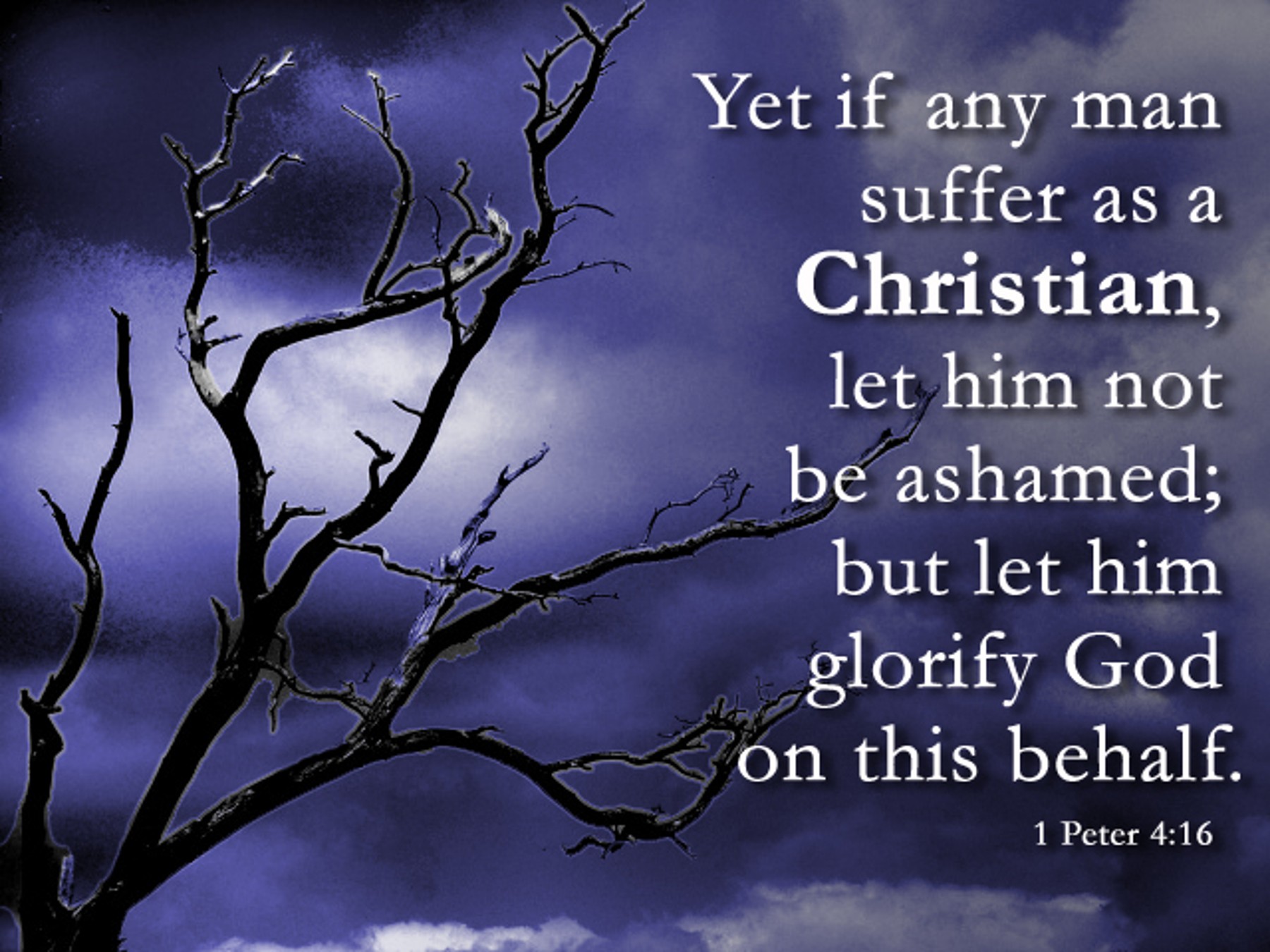
Being Catholic is demanding. It requires our whole selves, not a small section of ourselves that we carve out for Christ. In relying on our senses, we become overly concerned with how we feel in our prayer lives, at Mass, or in working with other people. We may abandon believing in Church doctrine—such as Purgatory—in place of the heresy of morally-therapeutic Deism. We may begin to think we have only to be a “good” person.
As Catholics, we believe in concrete and objective truths that are grounded in the very person of Jesus Christ, the Son of God made man—professed in the Nicene Creed. Why should we think that our lives will be any different from Our Savior’s, who gave His life for us all. The Resurrection does not happen before the Cross. Any cursory reading of Scripture will quickly dispel a sentimental understanding of the Christian life. During the Sermon on the Mount, Christ makes the Christian life very plain. He explains what we must do to gain everlasting life and find true happiness in this life and in the next. The Beatitudes are incredibly difficult, counterintuitive, and pragmatic. They are raw, gritty, and every single one of us fails to live up to them on a daily basis. If we turn the Beatitudes into something sentimental, or worse, an impossible ideal, then we’ve missed out on Christ’s call for each one of us. It is through the Beatitudes that Christ upsets the world order and teaches us something radically different. The Beatitudes do not always make us feel good. They demand too much to be reduced to feeling warm and fuzzy inside.
We are blessed in periods of trial and suffering because it is then that God draws us closer to Himself. It is through suffering that we learn to become entirely dependent on God. It can be easy to ignore the Cross in favor of a sole emphasis on the Resurrection, but this is not Catholic understanding. Our churches have—or at least should have—a crucifix on prominent display. It is the Cross that paves the way to the Resurrection. Without the Cross, we would still be lost in sin and death. We are called to lay down everything for God and others. We are called to give our very selves, our totality of self, to God. We cannot hold anything back, even if it means martyrdom. The Cross’s call to each one of us destroys any temptation to over-sentimentalize the Faith. Instead He says to you and to me, “Whoever wishes to come after me must deny himself, take up his cross, and follow me. For whoever wishes to save his life will lose it, but whoever loses his life for my sake and that of the Gospel will save it (Mark 8:34-36). The Cross is the only way to eternal life and if we reduce our faith to sentimentality and feelings, we will miss the mark. We cannot progress in holiness without living the Cross.
We
experience a wide variety of emotions throughout our day. We may feel
happy one minute and angry the next. Given this knowledge, it should be
apparent why our emotions cannot be our guide on the path to holiness.
If we only want to feel “good” all of the time, then Christianity is not
for us. If our attendance at Mass is predicated upon our feelings, then
it will be easy to
I've discovered most Christians don't know what to do with difficult situations because they have bought into the loie that God owes us (for our good behaviour).
The realit of life is that if you live long enough you are going to bleed, cry and hurt. AND God is still God IN that. - Matt Chandler
There is nothing greater that can be offered to us on this side of eternity than the Body, Blood, Soul, and Divinity of Our Savior, given to us in the Eucharist. Watch the priest’s actions closely during the Mass. Every movement and word brings us into a deeper reality. Focus on Christ during Mass, not feelings and emotions. The reduction of our Faith to sentimentality leads quickly to indifference and irrelevance.
Our faith is not sentimental, but is grounded in the Cross of Our Savior who endured torture and death to set us free. We are called to pick up our own Cross in order to follow God. Most of the time we do not feel “good” as we continue to persevere by God’s grace. Instead, we keep our eyes firmly fixed on Christ and ask Him to help us to bear our Crosses well so that we may enter into the deep realities of God.
Published in the Bulletin of September 17, 2017
By Fr. Ray Ryland of Catholic.com
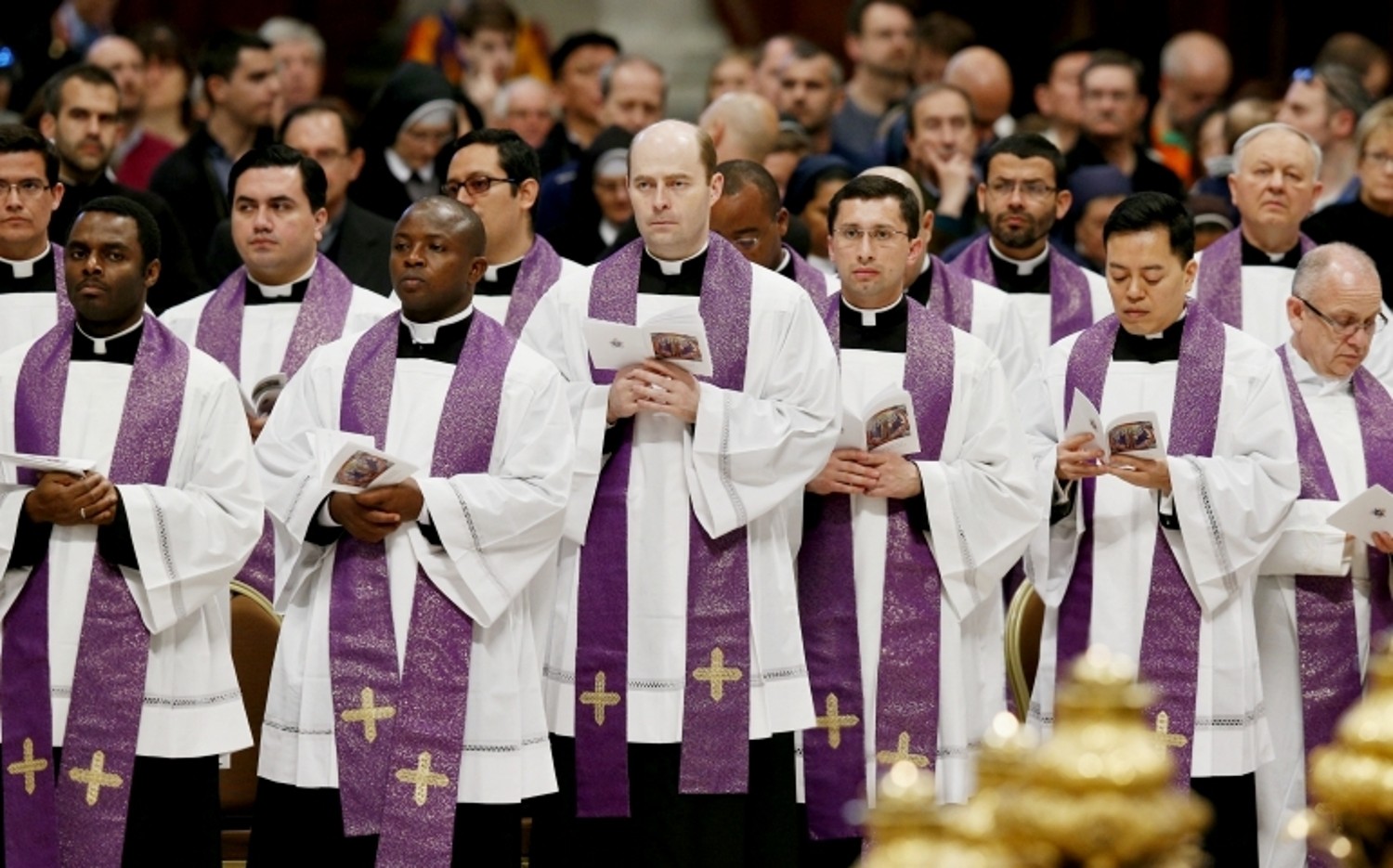

Why Do We Call Priests "Father"? Often non-Catholics ask, “Why do Catholics call their priests "Father"? They then cite Matthew 23:9: "You must call no one on earth your father." How should you answer?
A Catholic might respond, "How do you refer to your mother's husband? What do you call him?" If a Catholic is wrong in calling his priest "Father," then everyone who refers to his own natural father as "father" is also in the wrong. Both usages would be prohibited by a literal interpretation of Jesus' words. Jesus came not to abolish but to fulfill the Law of the Old Covenant (Mt 5:17).
If in Matthew 23:9, He literally forbids us even to acknowledge our natural fathers as our fathers, how can we keep the fourth commandment ("Honor your father and your mother")? Taken literally, Jesus' words in Matthew 23:9 contradict His claim in Matthew 5:17, but we know that the Son of God never contradicts Himself.
Look again at the passage in which Jesus says we must call no one "father." In contrast to the attitudes of the Pharisees and others, Jesus is specifying the qualities Christian leaders must exhibit (Mt. 23:1-12). The Pharisees aspired to being called "rabbi" (or "master" or "teacher"). Among the schools headed by teachers called "rabbi," there were divergences of belief, some of them in actual contradiction. A similar situation prevailed regarding the term "father" (in Aramaic, abba, a title of honor). The title was given to well-known Jewish religious authorities of the past. As with "rabbi," so with "father." The term designated the progenitor of a particular, even contradictory, interpretation of the Jewish faith.
Why did Jesus declare that no Christian leader is to be called "rabbi" or "father"? He was telling us that no leader may set up his own interpretation of the Catholic faith and seek followers for his opinions. The role of leaders in Christ's Church is faithfully to hand on Christ's teaching received through the apostles (Mt. 28:19). The words of the apostle Paul epitomize the essential attitude of the Christian teacher: "This is what I received from the Lord and in turn passed on to you" (1 Cor. 11:23). Paul writes to the Church at Corinth, condemning "these slogans you have, like 'I am for Paul,' 'I am for Apollos,' 'I am for Cephas'”(1 Cor. 1:12).
The history of Protestantism is essentially the story of this very
process—the unending proliferation of sectarian groups, saying "I am for
Martin Luther" or "I am for John Calvin" or "I am for John Wesley." The
World Christian Encyclopedia (David B. Barrett, ed.; Oxford,
1982) reported that in 1980 there were 20,780 distinguishable Christian
denominations in the world. Moreover, at the time the encyclopedia was
published, an average of 270 new denominations were springing up each
year—more than five every week. If that rate has continued, then there
are over 25,000 denominations today. Every single one of these
competing, contradicting denominations was formed by some person who
said, in effect, "Call me 'Master,' call me 'Teacher'; I will tell you
what the Christian truth is!"
Jesus foresaw this problem and provided the means for avoiding it. In
the passage under discussion, He tells us, "You have only one teacher,
the Christ." And how are we to be taught by our one Teacher? By the
means He provided. He founded the Church on the apostles and their
successors, with a special role for Peter, the Rock, the earthly head of
the Church. A Catholic knows that when the Church Christ founded speaks
solemnly, Christ Himself is speaking through her to each member.
Every follower of Christ wants to know the truth, for "the truth [and only the truth] will make you free" (John 8:22). For acquiring that truth in its fullness, the Catholic Church established by Jesus Christ offers the only alternative to the chaos of ever-expanding denominationalism.
Published in the Bulletin of November 5, 2017

What are the Top Ten Questions Asked of Catholics? We Catholics are often asked tough questions about our Catholic faith and its relationship to the Bible. Here are the ten most-asked-questions and the answers that should help you satisfy both your questioner and yourself.
10 Are your beliefs found in the Bible? All
Catholic beliefs can be found in the Bible in some form, whether
plainly or by an indirect indication. It is not necessary for
everything to be absolutely clear in Scripture alone, because that is
not a teaching of Scripture itself. Scripture also points to an
authoritative Church and Tradition, as St. Paul says in his Second
Letter to the Thessalonians:
"Stand firm and hold to the traditions which you were taught by us, either by word of mouth or by letter" (2 Thess. 2:15; 1 Cor. 11:2, 2 Thess. 3:6; 2 Tim. (1:13-14; 2:2). When the first Christians had a significant disagreement, they didn't simply open their Bibles (which didn't even exist at that point) to decide who was right; they held a council, which made binding decrees (Acts 15:1-29). The very books of the Bible had to be determined by the Church and that didn't happen until the late fourth century. Therefore, Sacred Tradition and authority were necessary for us to even have a Bible today.
9. Why do you obey the Pope? Catholics believe that Jesus commissioned St. Peter as the first leader of the Church. Matthew's Gospel has the most direct biblical indication of the papacy: "And I tell you, you are Peter (meaning literally "Rock") and on this rock I will build my church ... I will give you the keys of the kingdom of heaven" (Mt 16:18-19). Based on this statement of Jesus Himself, Peter is clearly portrayed in the New Testament as the leader of the disciples. A pope can make infallible, binding pronouncements under certain conditions. Infallibility doesn't mean that absolutely everything a pope says is free from error. All Christians believe that God protected Holy Scripture from error by means of inspiration, even though sinful, fallible men wrote it. We Catholics also believe that God the Holy Spirit protects His Church and its head from error (Jn. 14:16) by means of infallibility, even though sinful, imperfect men are involved in it.
8. Why do you call your priest "Father"? "And call no man your father on earth, for you have one Father, who is in heaven" (Mt 23:9). In this passage, Jesus is teaching that God the Father alone is ultimately the source of all authority. But He is not speaking absolutely, because if so, that would eliminate even biological fathers the title, "Church Fathers", the founding fathers of a country or organization, and so on. Jesus Himself uses the term "father" in Matthew (15:4-5; 19:5, 19, 29; 21:31), John (8:56), and several other places. In the parable of the Rich Man and Lazarus, Jesus actually presents Lazarus as using the address, "Father Abraham," twice (Lk. 16:24, 30; see also Acts 7:2; Rom. 4:12; Jas. 2:21). St. Paul also uses the term when he writes, "I became your father in Christ Jesus through the Gospel (1 Cor. 4:15; see also 1 Cor. 4:14-16) and refers to "our forefather Isaac" (Rom 9:10).
7. Why do you pray for the dead? The Bible clearly teaches the rightness of prayers for the dead in 2 Maccabees (12:40, 42, 44-45): "Then under the tunic of every one of the dead they found sacred tokens of the idols of Jamnia, which the law forbids Jews to wear. And it became clear to all that this was why these men had fallen ... And they turned to prayer, beseeching that the sin which had been committed might be wholly blotted out ... For if he were not expecting that those who had fallen would rise again, it would have been superfluous and foolish to pray for the dead ...He made atonement for the dead, that they might be delivered from their sin." St. Paul teaches this in a similar way: "Otherwise, what do people mean by being baptized on behalf of the dead? If the dead are not raised at all, why are people baptized on their behalf?" (1 Cor. 15:29). This indicates prayer and fasting for the dead. The word baptism often symbolically refers to penances (Mk 10:38-39; Lk. 3:16, 12:50). The apostle Paul also appears to be praying for a dead person, Onesiphorus, in 2 Timothy (1:16-18).
6. Why do you pray to idols (statues)? No Catholic who knows anything about the Catholic faith has ever worshiped a statue (as in pagan idolatry). If we cherish the memory of mere political heroes with statues and that of war heroes with monuments, then there can be no objection to honoring saints and righteous men and women: "Honor all men. Love the brotherhood. Fear God. Honor the emperor" (1 Pet 2:17; see also Rom. 12:10; Heb. 12:22-23). Statues are simply a visual reminder of great saints and heroes of the faith (Heb 11), who are more alive than we are (2 Cor. 3:18), as is evident by their praying: "O Sovereign Lord ... how long before thou wilt judge and avenge our blood on those who dwell upon the earth?" (Rev 6:10; see also Ps. 35:17). The saints in heaven were never intended by God to be cut off from the Body of Christ on earth. They are involved in intercession, just as the saints on earth are and they are described as "so great a cloud of witnesses" (Heb. 12:1).
5. Why do you confess your sins to a priest? Jesus Christ gave His disciples—and by extension, priests—the power not only to "loose" sins (that is, forgive in God's name), but also to "bind" (that is, refuse absolution to someone until a certain condition is met; for instance, having the intention not to continue the sin): "Whatever you bind on earth shall be bound in heaven and whatever you loose on earth shall be loosed in heaven" (Mt 18:18 - see also Mt 16:19). "If you forgive the sins of any, they are forgiven; if you retain the sins of any, they are retained" (Jn. 20:23). The priest serves as the representative of God and of His mercy. Confession gives new courage, confidence and a fresh start. One learns humility by this practice, receives additional grace in order to avoid sin and attains a certainty of forgiveness that is superior to mere feelings. Confession is also indicated in Matthew (3:5-6), Acts (19:18), and 1 John (1:9).
4. Why do you worship Mary? Catholics do not worship Mary. We venerate her because she is the Mother of God the Son, our Lord Jesus Christ. Veneration is completely different from the adoration of God. It is the honoring of a person, not the worship of Almighty God, our Creator. Catholics believe that Mary is the highest of God's creatures because of her exalted role. But, of course, like any other human being, she had to be saved by the mercy of God. She herself said, "My spirit rejoices in God my Savior" (Lk. 1:47). We believe that God saved her by taking away all stain of original sin at the moment of her conception (the Immaculate Conception). The very fact that God took on flesh and became man (Jn. 1:1, 14) indicates that He wished to involve human beings in His plan of salvation for mankind. Mary was a key person for this purpose, so this is why Catholics honor her so highly.
3. Why do you worship communion hosts? A consecrated host at a Catholic Mass is the true Body and Blood of Christ, not merely bread; so Catholics are worshiping Jesus, not a host. In the Gospel of John (6:51-56), Jesus states repeatedly that "he who eats my Flesh and drinks my Blood has eternal life" (6:54). He is speaking literally and He is so firm about it that, even though many followers objected and left Him (6:52, 60, 66), he did not soften His words to get them to stay. St. Paul agrees with this interpretation and writes that those taking Communion "in an unworthy manner will be guilty of profaning the Body and Blood of the Lord" (1 Cor. 11:27; see also 1 Cor. 10:16). We don't sin against someone's "body and blood" by destroying a photograph (which is a mere symbol) of the person. Moreover, in the Last Supper passages (Mt 26:26-28; Mk 14:22-24; Lk. 22:19-20), nothing suggests a metaphorical or symbolic interpretation. The Last Supper was the Jewish feast of Passover. This involved a sacrificial lamb and Jesus referred to His imminent suffering (Lk. 22:15-16, 18, 21-22). John the Baptist had already called Him the "Lamb of God" (Jn. 1:29).
2. If you died tonight, would you go to Heaven? Catholics have an assurance of salvation if they are faithful and keep God's commandments (1 Jn. 2:3) and the precepts of the Church. If they die in the state of grace, they are assured of Heaven. But to enter Heaven, one must be perfectly holy, because "nothing unclean shall enter it" (Rev 21:27; Is 4:4; Mal 3:2-4). The cleansing and purifying of the effects of sin, which makes us fit for God's holy presence, is what Catholics call Purgatory. This is clearly indicated in St. Paul's writings: "Each man's work will become manifest; for the Day will disclose it, because it will be revealed with fire—and the fire will test what sort of work each one has done. ...If any man's work is burned up, he will suffer loss, though he himself will be saved, but only as through fire" (1 Cor. 3:13, 15). "For we must all appear before the judgment seat of Christ, so that each one may receive good or evil, according to what he has done in the body" (2 Cor. 5:10).
And the Number One Question asked of Catholics:
1. Are you saved? Catholics can be sure as anyone else that they are in God's good graces. The apostle John states that "you may know that you have eternal life" (1 Jn. 5:13; see also Jn. 5:24). But this "assurance" has to be understood in light of John's other teachings in the same book: "For this is the love of God, that we keep His commandments" (1 Jn. 5:3; see also 1 Jn. 2:3-6). "We know that any one born of God does not sin" (1 Jn. 5:18). "He who loves God should love his brother also" (1 Jn. 4:21). "He who commits sin is of the devil" (1 Jn. 5:18; see also 1 Cor. 6:9). Likewise, St. Paul does not regard salvation as a one-time event, but as a goal to be sought after, one that can be lost: "Work out your own salvation with fear and trembling" (Phil 2:12; see also 1 Cor. 9:27, 10:12; Gal 5:1, 4; Phil 3:11-14; 1 Tim 4:1, 5:15). You might try answering this question this way, "If you mean, 'do I accept Jesus Christ as my personal Lord and Savior because He died on the Cross to save us from our sins?,' then the answer is 'Yes!'".
Published in the Bulletins of November 12 and November 19, 2017
By Fr. Gabriele Amorth

Scripture talks to us about the Kingdom of God but also of the kingdom of Satan. It is impossible to understand the salvific action of Christ if we ignore the destructive action of Satan.
Lucifer (Satan) was the most perfect being created by the hands of God before creating the world. His God-given authority and superiority over the other angels was recognized by all, so he thought that he had the same authority over creation as God. Satan tried to understand all of creation but could not, because creation was oriented toward Christ. Until Christ came into the world, God's plan could not be revealed in its entirety. Hence Satan's rebellion. He wanted to continue to be the absolute first, the center of creation, even if it meant opposing God's design. This is why Satan continually tries to dominate the world. Beginning with our forefathers, he seeks to enslave men by making them obey himself and disobey God. He was successful with Adam and Eve, and he hoped to continue with all people, with the help of the other rebelling angels (now demons). Even though Satan and his angels broke with God, He allowed them to maintain their power and rank (thrones, dominions, principalities, powers, etc.) even if they use them for evil purposes. St. Augustine did not exaggerate when he wrote that, if God gave Satan a free hand, "no man would be left alive." Since Satan cannot kill us, he tries to "make us into his followers in opposition to God.”
The truth of salvation is this: Jesus came "to destroy the works of the Devil" (I Jn 3:8), to free man from Satan's slavery, and to establish the kingdom of God after destroying the reign of Satan. However, between the Birth of Christ and the Second Coming of Christ, the Devil tries to entice as many people as possible to his side. Therefore, Paul tells us that "we are not contending against flesh and blood, but against the principalities, against the powers, against the world rulers of this present darkness, against the spiritual hosts of wickedness in the heavenly places" (Eph 6:12).
Let
us be clear about this: Jesus defeated Satan through His sacrifice.
However, Jesus also defeated Satan before His death, through His
teachings: "If it is by the finger of God that I cast out demons, then
the kingdom of God has come upon you" (Lk 11:20). Jesus first gave the
power to cast out demons to His apostles; then He extended the power to
the seventy-two disciples, and in the end He granted it to all those who
would believe in Him. How can those who deny the existence and the
many activities of Satan understand the achievements of Christ? How can
they understand the value of the redemptive death of Christ? On the
basis of Sacred Scripture, the Second Vatican Council affirms that
"Christ, by His death and resurrection, has freed us from the power of
Satan".
"The battle against the Devil, which is the principal task of St. Michael the Archangel, is still being fought today, because the Devil is still alive and active in the world. The evil that surrounds us today, the disorders that plague our society, are not only the results of original sin, but also the result of Satan's pervasive and dark actions." Revelation tells us that demons were hurled down to earth; therefore their final damnation has yet to happen. That is why they asked Jesus, "Have you come here to torment us before the time?" (Mt 8:29).
How can we defend ourselves from Satan and his demons? By prayer, the Sacraments, almsgiving, leading a Christian life, pardoning offenses, and soliciting the aid of our Lord, Mary, the saints, and the angels. Let me end here by speaking about the angels. They are our great allies! Each of us has a guardian angel, the most faithful of friends—who is with us twenty-four hours a day, from conception to death. The believer who lives in the presence of the Trinity and is certain of God's life within himself knows that he also has God's own Mother, who ceaselessly helps him, as well as the help of the angels and of the saints. Therefore, how can we feel alone, abandoned, or oppressed by evil? In the life of the believer there is pain, because it is the Cross that saves us, but there is no room for sadness. He who believes is always ready to give witness to those who ask him about the hope that sustains him (I Pet 3:15).
(Note: For many years, Fr. Amorth was the Chief Exorcist of Rome—until his death on September 16, 2016, at the age of 91. He said that, during his exorcisms, the names he invoked that the demons most hated to hear were the Blessed Mother, followed by Pope St. John Paul. Fr. Amorth wrote two books about his thousands of exorcisms).
Published in the Bulletin of January 14, 2018
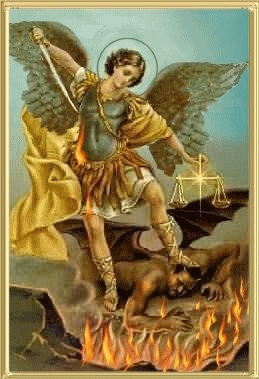
by Tim Staples (Catholic Apologist)
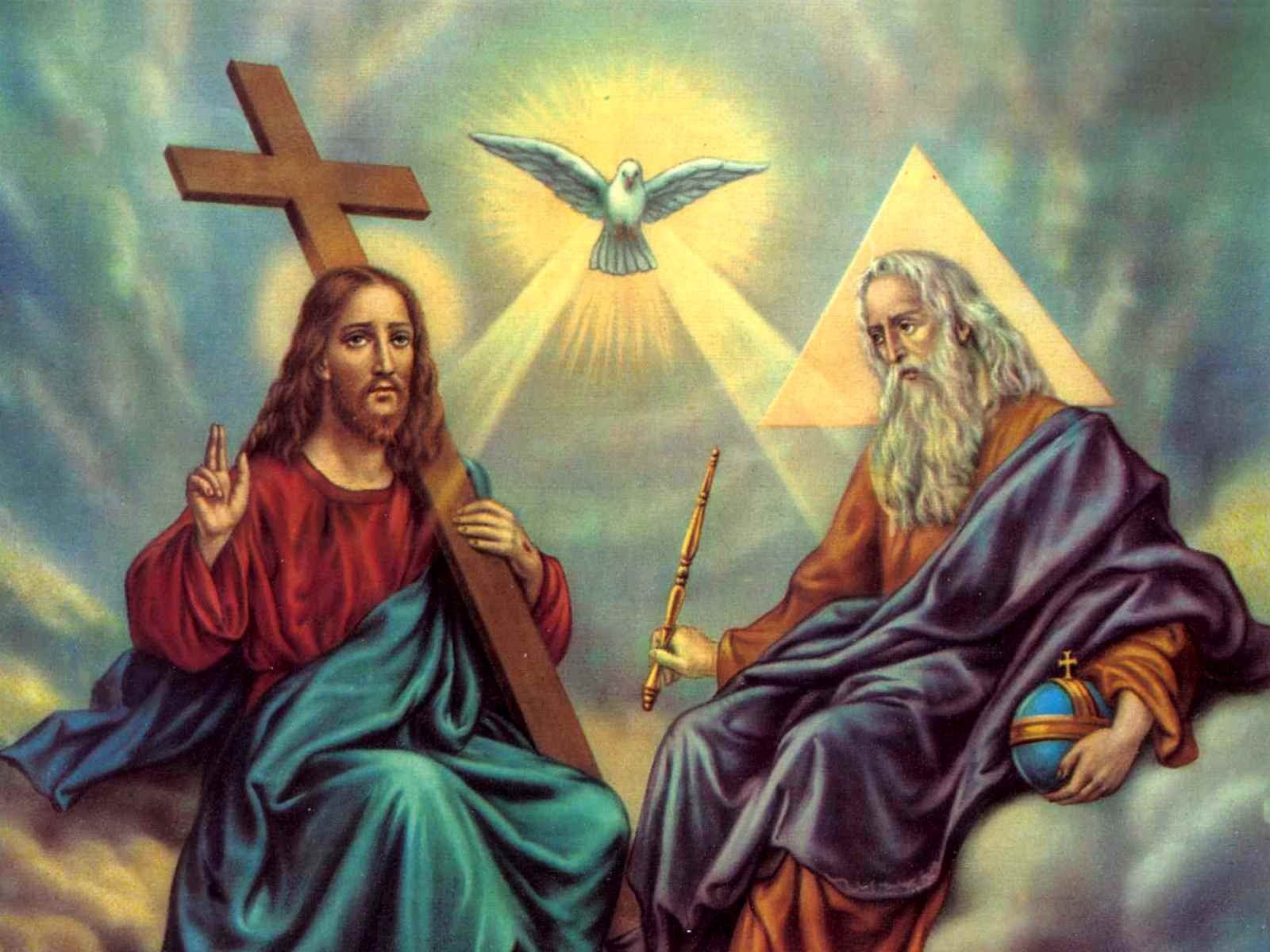
It has been said that mystery is not a wall to run up against, but an ocean in which to swim. It wasn’t until Pope John XXII (1316-1334) that the Church established the feast—to be celebrated annually on the first Sunday after Pentecost.
In Catholic theology, we understand the Persons of the Blessed Trinity to be truly distinct relationally, but not as a matter of essence or of nature. Each of the three Persons in the Godhead possesses the same eternal and infinite divine nature; thus, they are the one, true God in nature—not “three Gods.” Yet, they are truly distinct in their relations to each other. In order to understand the concept of Person in God, we look to the Council of Florence (1338-1445). Its definitions concerning the Trinity are as easy as one, two, three… four. It teaches that there is ONE nature in God, TWO processions, THREE persons, and FOUR relations that constitute the Blessed Trinity. The Son “proceeds” from the Father, and the Holy Spirit “proceeds from the Father and the Son.” These are the two processions in God. The four eternal relations in God are:
· 1. The Father actively and eternally generates the Son, constituting the person of God, the Father.
· 2. The Son is passively generated of the Father, which constitutes the person of the Son.
· 3. The Father and the Son actively spirate the Holy Spirit in the one relation that does not constitute a person—because the Father and Son are already constituted as persons in relation to each other
· 4. The Holy Spirit is passively spirated of the Father and the Son, constituting the person of the Holy Spirit.
We should take note of the distinction between the "generative" procession that constitutes the Son, and the "spirative" procession that constitutes the Holy Spirit. As St. Thomas Aquinas explains, and Scripture reveals, the Son is uniquely "begotten" of the Father (John 3:16; 1:18). He is also said to proceed from the Father as "the Word" in John 1:1. This "generative" procession is one of "begetting," but not in the same way a human being "begets" a human being. This is an intellectual "begetting," as a "word" proceeds from the knower while, at the same time remaining in the knower. Thus, this procession or begetting of the Son occurs within the inner life of God. There are not "two beings" involved; rather, two Persons relationally distinct, while ever-remaining ONE in being.
The Holy Spirit proceeds from the Father and the Son, but not in a generative sense; rather, in a spiration. "Spiration" comes from the Latin word for "spirit" or "breath." Jesus "breathed on them, and said to them, 'Receive the Holy Spirit...' " (John 20:22). Scripture reveals the Holy Spirit as pertaining to "God's love [that] has been poured into our hearts" (Romans 5:5), and as flowing out of and identified with the reciprocating love of the Father for the Son and the Son for the Father (John 15:26; Rev. 22:1-2). Thus, the Holy Spirit's procession has its origin in God's ultimate act of His will, which is love. The infinite act of love between the Father and Son is so perfect that "it" becomes a "He" in the third Person of the Blessed Trinity. God is not revealed to "be" love in any other religion in the world other than Christianity because in order for there to be love, there must be a beloved. From all eternity, the Father, Son, and Holy Spirit have poured themselves out into each other in an infinite act of love, which we, as Christians, are called to experience through faith and the sacraments (Romans 5:1-5). The Holy Spirit is depicted in Revelation 22:1-2 as a river of life flowing out from the Father and the Son, bringing life to all by way of bringing life to the very "Tree of Life" that is the source of eternal life in the Book of Revelation (Rev. 22:19).
Biblically speaking, we see each of the Persons in God revealed distinctly and yet one in nature. For example, in John 17:5, our Lord prays: "...and now, Father, glorify me in your own presence with the glory which I had with you before the world was made." Notice, before the creation, the Son was “with” the Father. Yet, this relationship between two persons clearly has no beginning in time because it existed before creation—from all eternity. As far as nature is concerned, Jesus’ words from John 10:30 come to mind: “I and the Father are one,” in that they each possess the same infinite nature. The Holy Spirit is also seen to be relationally distinct from both the Father and the Son in Scripture inasmuch as both the Father and the Son are seen as “sending Him”: "But when the Counselor comes (the Holy Spirit), whom I shall send to you from the Father, He will bear witness of me…" (John 15:26) and "...He will guide you into all truth" (John 16:13). In fact, I Cor. 2:10 also reveals the Holy Spirit to be omniscient when it says, "... no one comprehends the thoughts of God except the Spirit of God." Thus, the Holy Spirit is revealed in Scripture to possess the same infinite and divine nature as does the Father and the Son.
Published in the Bulletin of May 27, 2018
By St. John Paul II (July 1999)

It is precisely this tragic situation that Church doctrine explains when it speaks of eternal damnation or Hell. It is not a punishment imposed externally by God but a development of premises already set by people in this life. The very dimension of unhappiness which this obscure condition brings can be sensed by some of the terrible experiences we have suffered which, as is commonly said, make life "hell". In a theological sense however, Hell is something else: it is the ultimate consequence of sin itself, which turns against the person who committed it. It is the state of those who definitively reject the Father's mercy at the last moment of their lives.
To describe this reality, Sacred Scripture uses a symbolical language. In the Old Testament the condition of the dead had not yet been fully disclosed by Revelation. Moreover, it was thought that the dead were amassed in Sheol, a land of darkness (cf. Ez. 28:8; 31:14; Jb. 10:21f.; 38:17; Ps 30:10; 88:7, 13), a pit from which one could not escape (cf. Jb. 7:9), a place in which it was impossible to praise God (cf. Is 38:18; Ps. 6:6). The New Testament sheds new light on the condition of the dead, proclaiming that Christ conquered death and extended His liberating power to the kingdom of the dead. Redemption nevertheless remains an offer of salvation, which it is up to people to accept freely. This is why they will all be judged "by what they have done" (Rev 20:13). By using images, the New Testament presents the place destined for evildoers as a fiery furnace, where people will "weep and gnash their teeth" (Mt 13:42; cf. 25:30, 41), or like Gehenna with its "unquenchable fire" (Mk 9:43). All this is narrated in the Parable of the Rich Man, which explains that Hell is a place of eternal suffering, with no possibility of leaving nor of the alleviation of pain (cf. Lk. 16:19-3 1).
The Book of Revelation also figuratively portrays those who exclude themselves from the Book of Life as being in a "pool of fire," thus meeting with a "second death" (Rv. 20:13f.). Whoever continues to be closed to the Gospel is, therefore, preparing for "eternal destruction and exclusion from the presence of the Lord and from the glory of His might" (2 Thess. 1:9). The images of Hell that Sacred Scripture presents to us must be correctly interpreted. They show the complete frustration and emptiness of life without God. Rather than a place, Hell indicates the state of those who freely and definitively separate themselves from God, the source of all life and joy. (Note: Although Hell is not essentially "a place," confinement IS included, since the bodies of the damned—being bodies not spirits—must be in "some place.") The Catechism of the Catholic Church summarizes the truths of faith on this subject: "To die in mortal sin without repenting and accepting God's merciful love means remaining separated from Him forever by our own free choice. This state of definitive self-exclusion from communion with God and the blessed is called Hell" (No. 1033). "Eternal damnation," therefore, is not attributed to God's initiative, because in His merciful love He can only desire the salvation of the beings He created. In reality, it is the creature who closes himself to His love. Damnation consists precisely in definitive separation from God, freely chosen by the human person and confirmed with death that seals his choice forever. God's judgment simply ratifies this state.
Christian faith teaches that in taking the risk of saying "yes" or "no," which marks the human creature's freedom, some have already said "no." They are the spiritual creatures (angels) that rebelled against God's love and are called demons (cf. Fourth Lateran Council, DS 800-801). What happened to them is a warning to us: it is a continuous call to avoid the tragedy which leads to sin and to conform our life to that of Jesus who lived His life with a "yes" to God.
Eternal damnation remains a real possibility, but we are not granted, without special divine revelation, the knowledge of which human beings are effectively involved in it. The thought of Hell—and even less the improper use of biblical images—must not create anxiety or despair, but is a necessary and healthy reminder of freedom within the proclamation that the Risen Jesus has conquered Satan, giving us the Spirit of God who makes us cry "Abba, Father!" (Rm. 8:15; Gal. 4:6). This prospect is effectively reflected in the liturgical tradition of the Church, as the words of the Roman Canon attest: "Father, accept this offering from your whole family...save us from final damnation, and count us among those you have chosen".
Published in the Bulletin of June 17, 2018
What are the “Four Last Things"? By Peter Kreeft
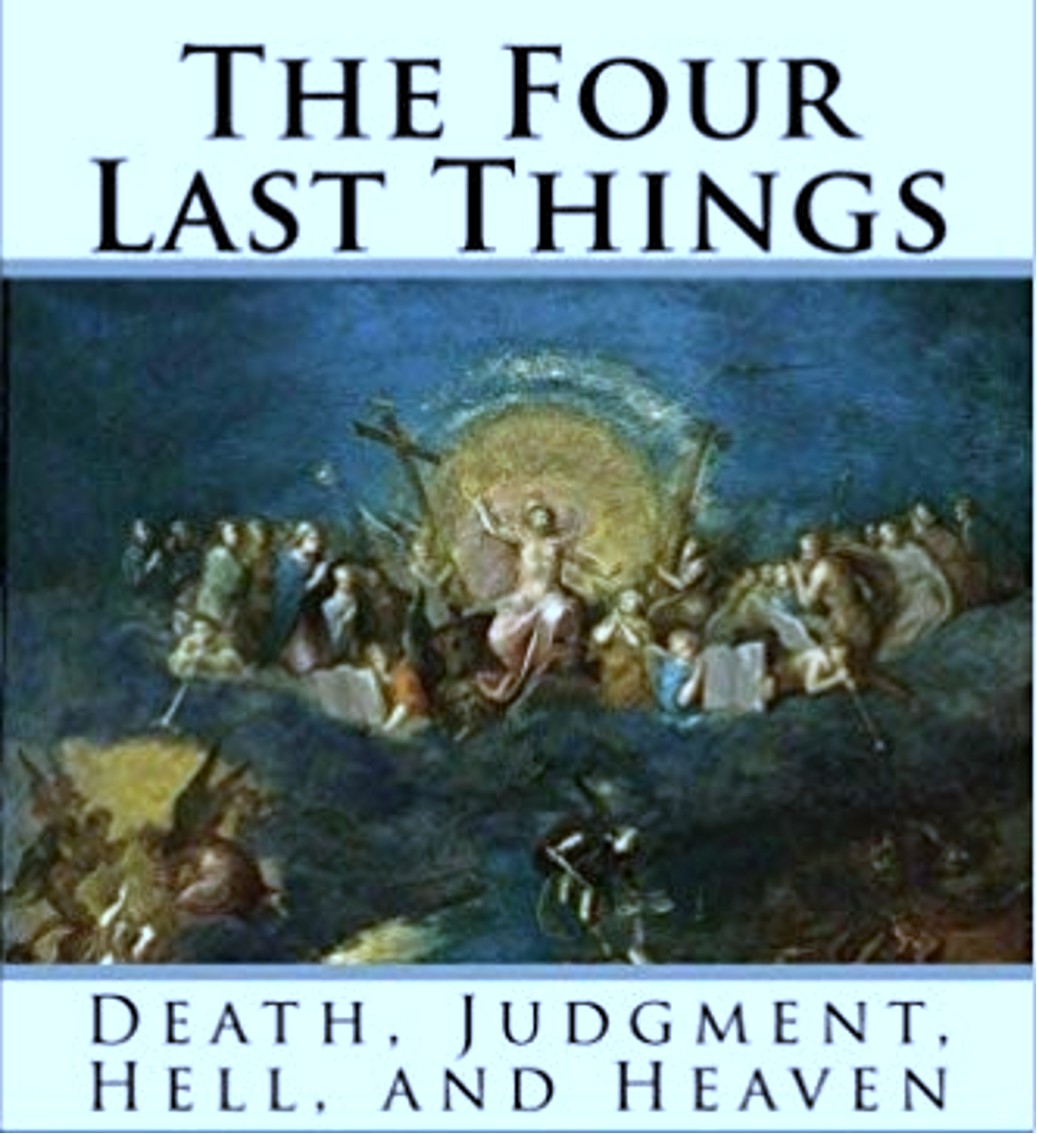
This instinctive conviction that there must be a higher, more-than-human justice is nearly universal. Thus, the second of the Four Last Things, Judgment, is also widely known. As Scripture says, “Whoever would draw near to God must believe that He exists and that He rewards those who seek Him” (Heb 11:6). The final judgment is an encounter with Christ.
Most people also know that justice distinguishes the good from the evil and, therefore, that after death there must be separate destinies for us—rewards for good and punishments for evil. Thus mankind also usually believes in some form of Heaven and Hell. There are only two eternal destinies: Heaven or Hell, union or disunion with God. Each one of us will be either with God or without Him forever. If Hell is not real, the Church and the Bible are also liars. Our basis for believing in the reality of Hell is exactly the same authority as our basis for believing in the reality of Heaven: Christ, His Church, and the Scriptures.
If Hell is not real, then Jesus Christ is either a fool or a liar, for He warned us repeatedly and with utmost seriousness about it. There is no reincarnation, no “second chance” after time is over. There is no annihilation, no end of the soul’s existence. There is no change of species from human being to angel or to anything else. The particular judgment occurs immediately after each individual’s death. The general judgment takes place at the end of all time and history.
So the scenario of final events is: (a) first, death; (b) then, immediately, the particular judgment; (c) then, either Hell, or Purgatory as preparation for Heaven, or Heaven; (d) and, at the end of time, the general judgment; (e) and the “new heavens and new earth” for those who are saved.
PETER KREEFT, a professor of philosophy at Boston College, is the best-selling author of over seventy-five books. This article is from his book, “Catholic Christianity: A Complete Catechism of Catholic Beliefs Based on the Catechism of the Catholic Church” (Ignatius Press, 2001).
Catechism 101
Death puts an end to human life as the time open to either accepting or rejecting the divine grace manifested in Christ. The New Testament speaks of Judgment primarily in its aspect of the final encounter with Christ in His second coming, but also repeatedly affirms that each will be rewarded immediately after death in accordance with his works and faith. Each person receives his eternal retribution in his immortal soul at the very moment of his death, in a particular judgment that refers his life to Christ: either entrance into the blessedness of Heaven—through a purification or immediately—or immediate and everlasting damnation in Hell. At the evening of life, we shall be judged on our love.
-Catechism of the Catholic Church, #1021-1022
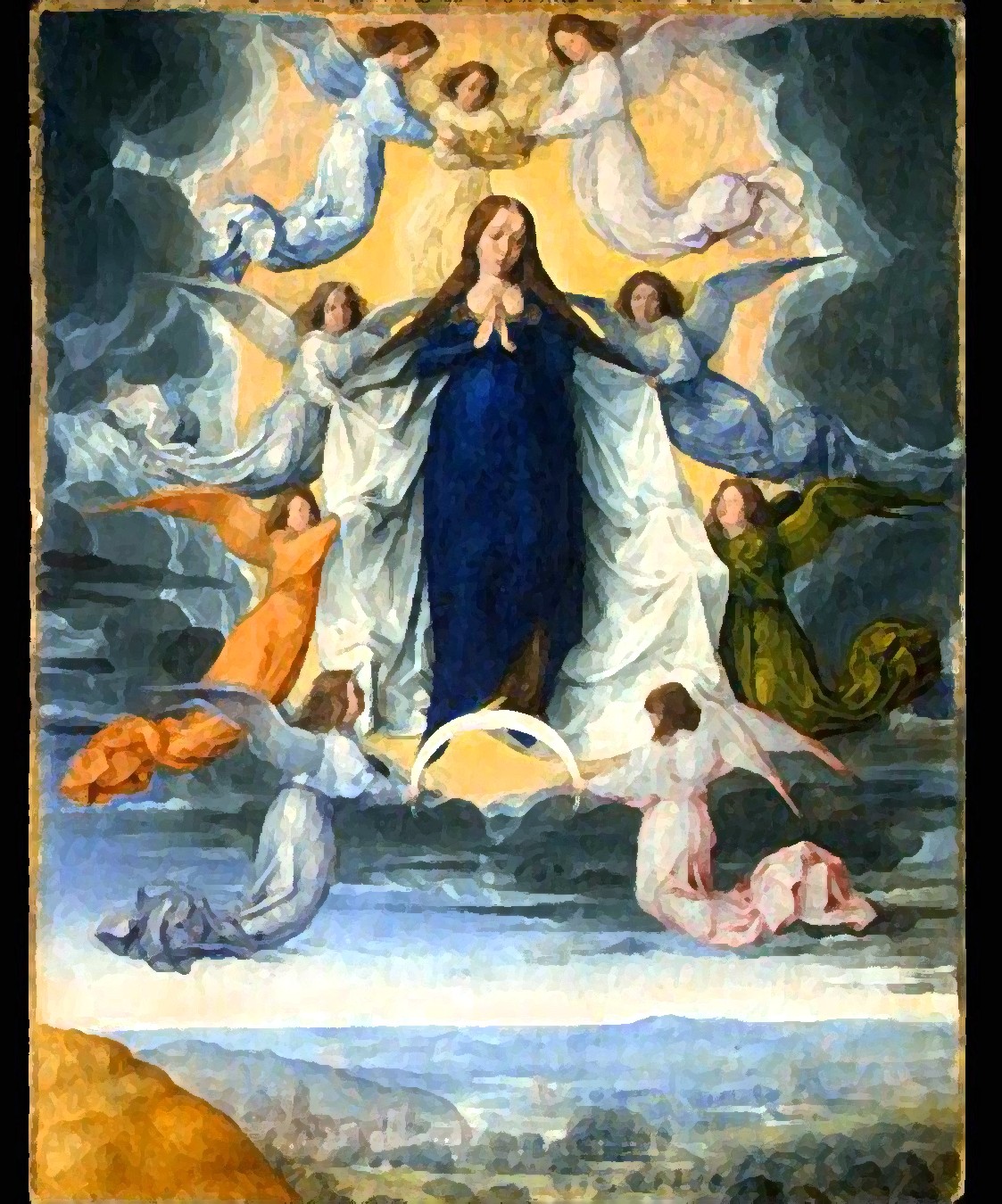
We see an example of this in the Papal Bull, "Ineffabilis Deus," in which Pius IX defined the Immaculate Conception. One thought that was clearly in the mind of Pius XII was the principle of consortium—that Mary was "always sharing Christ's lot" (AAS 42. 768).
In line with this, Pope Pius showed the relation of the Assumption to the Immaculate Conception: "For these two privileges are most closely related to each other. Christ has overcome sin and death by His own death; and one who is reborn in a heavenly way through baptism has conquered sin and death. However, in accord with His general rule, God does not wish to grant the full effect of victory over death to the just until the end of time... Yet God wished that the Blessed Virgin Mary be exempt from this general law. For she, by a completely singular privilege, conquered sin in her Immaculate Conception, and thus was not liable to that law of corruption of the grave, nor did she have to wait for the end of time for the redemption of her body" (AAS42. 754).
Pius XII next said he had asked the opinions of all the bishops of the world on the Assumption. Their response was almost unanimous in the affirmative. The universal teaching of the authorities of the Church, he tells us, gives us proof (Cf. Lumen Gentium, Nos. 25 and 12). He next reviewed some of the outstanding statements of Tradition throughout all the centuries. Teachings on the Assumption are found at a very early date in the liturgical books.
He also speaks of St. Francis de Sales, who "after stating that it would be wrong to doubt that Jesus Christ has kept in the most perfect way the divine commandment that children honor their parents, puts this question: 'What son, if he could, would not bring his mother back to life, and take her, after death, into Paradise?'" (AAS 42. 766).The Pope concluded: "All these arguments and considerations of the Holy Fathers rest on the Sacred Writings as their ultimate foundation. These place the revered Mother of God as most closely joined to her Divine Son, and always sharing in His lot. Hence, it seems practically impossible to think of her—who conceived Christ, brought Him forth, held Him in her hands, and pressed Him to her heart—as being separated from Him after this earthly life in body, even though not in soul" (AAS 42. 767-68).
It seems that the precise grounds for the definition is in the following passage just before the definition: "We must remember especially that, since the Second Century, the Virgin Mary has been presented by the Holy Fathers as the New Eve, who, although subject to the New Adam (Jesus), was most closely associated with Him in that struggle against the infernal enemy which, as foretold in the *Protevangelium, was to result in that most complete victory over sin and death. Wherefore, just as the glorious Resurrection of Christ was an essential part and final sign of this victory, so also that struggle which was common to the Blessed Virgin and her Son had to be closed by the 'glorification' of her virginal body" (AAS 42. 768). *(Note: The Protevangelium is a Messianic interpretation of Genesis 3:15, presaging man's ultimate triumph over sin through a coming Savior—used as the first anticipation of the Gospel. It concerns God's statement to the Serpent in the Garden of Eden about how the seed of the woman would crush the serpent's head: "And I will put enmity between thee and the woman, and between thy seed and her seed; He shall bruise thy head, and thou shalt bruise His heel".)
Pope Pius first recalled the New Eve theme, which we have seen. Then he focused on the fact, within that theme, that the New Eve had been closely associated with the New Adam in the struggle against sin and death. Still further, in the case of her Son, that struggle had brought glorification. Since the struggle was in common to both, then a common cause would have a common effect: it had to bring a parallel glorification to her, i.e., the Assumption. Pius XII carefully refrained from saying in his own words at any point that she died. Some, even a few of the Fathers, had denied that she ever died, basing this on the fact that death was the result of original sin, which she lacked. However, because, as Pius XII also said, she was "always sharing His lot," it seems much more probable that she did die, just as her Son did before her.
Published in the Bulletin of August 5, 2018
By Dr. Larry Rice
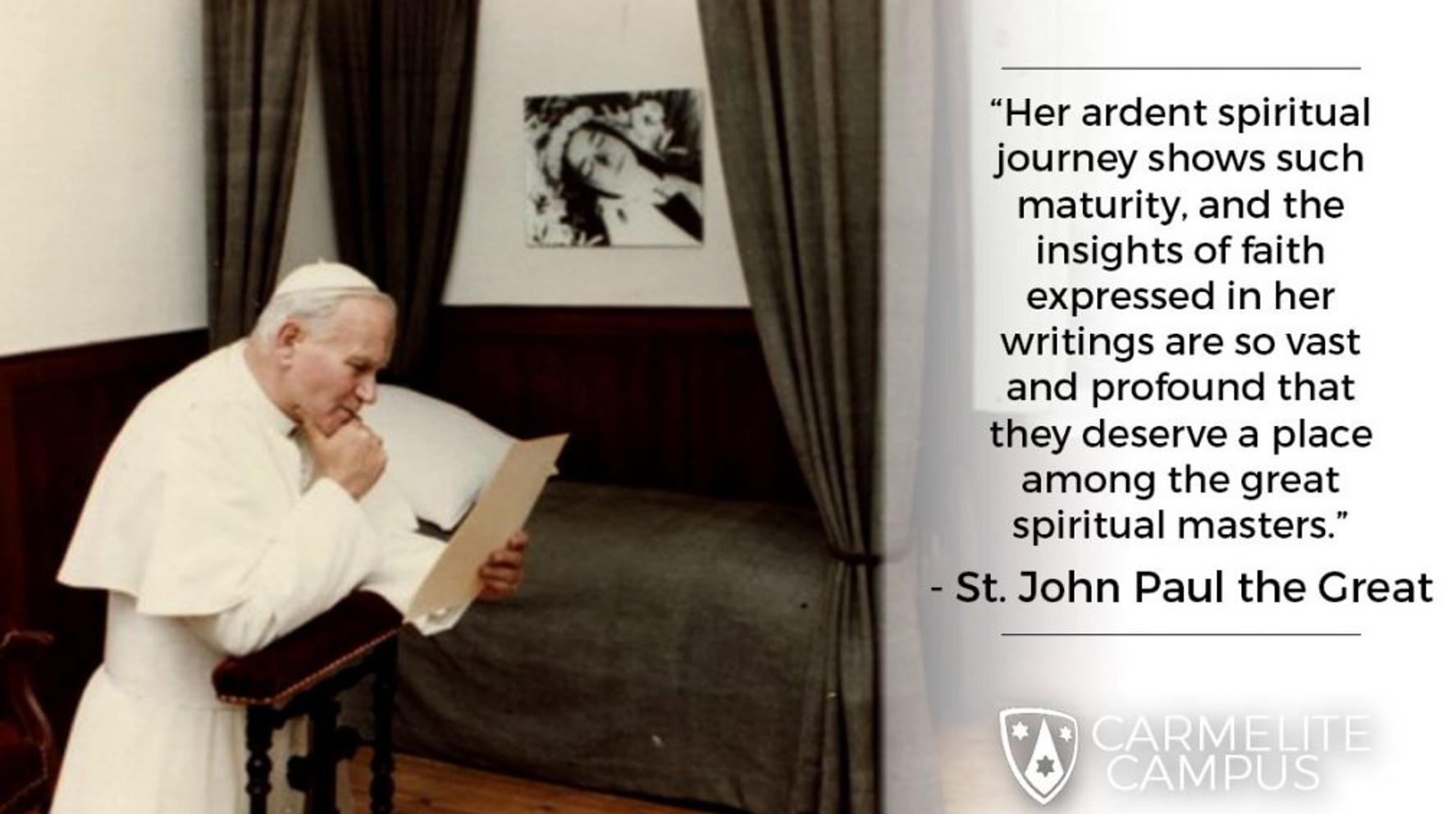
"What is a 'Doctor of the Church' "? Is there a doctor in the house? Well, if that house is the Church, then the answer is “yes.” Not medical doctors but more in line with Doctors who have a Ph.D. The title “Doctor of the Church,” unlike the title “Father of the Church,” is an official designation that is bestowed by the Pope in recognition of the outstanding contribution a person has made to the understanding and interpretation of the sacred Scriptures and the development of Christian doctrine. Through their research, study, and writing, these canonized saints have advanced the Church’s knowledge of the Faith. In fact, twenty-four of them are quoted in the Catechism of the Catholic Church. To be declared a Doctor of the Church does not imply that one's writings are free from error but rather that the whole body of a saint's work, taken together, serves to advance the cause of Christ and His Church.
Such men and women are also particularly known for the depth of understanding and the orthodoxy of their theological teachings. While the writings of the Doctors are often considered to be inspired by the Holy Spirit, this does not mean they are infallible; it means that they contributed significantly to the formulation of Christian teaching in at least one area.
The title was first awarded by Pope Boniface XIII (in the year 1295) to four saints: St. Ambrose, a 4th-century bishop of Milan; St. Augustine, a 5th-century bishop of Hippo; St. Jerome, a 5th-century biblical scholar and translator; and St. Gregory the Great, a pope at the start of the 7th century. Over the years the Church has added 32 additional saints to this notable list. Since 1970, four women have also been declared “Doctors of the Church”: St. Teresa of Avila, St. Catherine of Siena (both in 1970 by Pope Paul XI), St. Thérèse of Lisieux (in 1997 by Pope John Paul II), and St. Hildegard of Bingen (in 2012 by Pope Benedict XVI). Saints Teresa and Therese were both Discalced Carmelites nuns, St. Catherine was a lay Dominican, and Hildegard was a Benedictine. Most recently, in February 2015, the Armenian poet and monk, St. Gregory of Narek, was named a Doctor of the Church. All of the Doctors of the Church have advanced the knowledge of God through their writings on theology, spirituality, mysticism, or through their defense of the faith in the face of heresy and schism.
Eventually three criteria were developed for declaring a saint a Doctor of the Church: 1) holiness that is truly outstanding, even among saints; 2) depth of doctrinal insight; and 3) theological writings which the Church can recommend as an expression of the authentic and life-giving Catholic Tradition. The process of proclamation is first issued through a decree by the Congregation of Sacred Rites, which is then approved by the pope. The list of Doctors, relatively small compared to the vast array of saints over the centuries, has diversified over the years and has increasingly included women.
What’s interesting is that one of the Doctors, St. Thérèse of Lisieux, wrote only one book during her lifetime and that was her autobiography. She was the only saint whom St. John Paul II declared a Doctor during his 26-year pontificate! Her spiritual legacy was seen as extraordinary and St. John Paul explained how “...despite her inadequate training and lack of resources, she possesses an extraordinary wisdom. With her doctrine, she helps so many men and women of every state in life to know and love Jesus Christ and His Gospel.”
The complete list of the 36 Doctors of the Church, in order of declaration, is as follows:
St. Ambrose, St. Augustine, St. Jerome, St. Gregory the Great, St. Thomas Aquinas, St. John Chrysostom, St. Basil the Great, St. Gregory of Nazianzus, St. Athanasius, St. Bonaventure, St. Anselm, St. Isidore of Seville, St. Peter Chrysologus, St. Leo the Great, St. Peter Damian, St. Bernard of Clairvaux, St. Hilary of Poitiers, St. Alphonsus Liguori, St. Francis de Sales, St. Cyril of Alexandria, St. Cyril of Jerusalem, St. John Damascene, St. Bede the Venerable, St. Ephrem, St. Peter Canisius, St. John of the Cross, St. Robert Bellarmine, St. Albertus Magnus, St. Anthony of Padua, St. Lawrence of Brindisi, St. Teresa of Ávila, St. Catherine of Siena, St. Thérèse of Lisieux, St. John of Ávila, St. Hildegard of Bingen, and St. Gregory of Narek.
Published in the Bulletin of August 12, 2018

1.
What does the word "Epiphany" mean? "Epiphany" means "manifestation."
The word comes from Greek roots that means "to show, to display". An
epiphany is thus a time when something is shown or manifested to an
audience.
2. What is the feast of the Epiphany about? According to the Catechism of the Catholic Church, the Epiphany is the manifestation of Jesus as Messiah of Israel, Son of God, and Savior of the World. The great feast of Epiphany celebrates the adoration of Jesus by the wise men (Magi) from the East. In the Magi, the Gospel sees the first-fruits of the nations who welcome the good news of salvation through the Incarnation. The Magi's coming to Jerusalem in order to pay homage to the King of the Jews shows that non-believers can discover Jesus and worship Him as Son of God and Savior of the world.
3. When is Epiphany celebrated? This varies from country to country. In some countries, Epiphany is a holy day of obligation. Where that is the case, it is celebrated on January 6th. In the United States, the Feast of the Epiphany is transferred to the first Sunday after January 1st. In 2019, it so happens that the first Sunday after January 1st is January 6th, so this year the U.S. celebration of Epiphany coincides with its universal celebration.
4. Why is Epiphany connected with January 6th? Emeritus Pope Benedict says that it is hard to say how far back the beginnings of the Christmas feast go. It assumed its definitive form in the third century. At about the same time the Feast of the Epiphany emerged in the East on January 6th, and the Feast of Christmas in the West, on December 25th.
5. Who were the Magi? Emeritus Pope Benedict believes that the Magi were probably of a Persian priestly caste, but most people believe they were Arabian. Most likely, they were advisers to Kings, but NOT kings themselves. In Hellenistic culture, they were regarded as “rulers of a distinctive religion,” thought to be “strongly influenced by philosophy,” and that the Greek philosophers were their pupils. Others say that were possibly possessors and users of supernatural knowledge or magicians. The truth is, no one really knows exactly who they were.
6. Why did the Magi come to see Jesus? They presumably had material of a prophetic nature that allowed them to identify the birth of the new "King of the Jews" astronomically. They may have been especially motivated to come see this King since there was an expectation at the time that a universal ruler would shortly come from Israel. “But you, Bethlehem, in the land of Judah, are by no means least among the rulers of Judah; for out of you will come a ruler who will shepherd my people Israel” (Micah 5:2-4).
7. Why did they go to Herod first? Probably, because they assumed the newborn king would be a son of Herod—the current "king of the Jews." Emeritus Pope Benedict comments that it is quite natural that their search for the newborn King of the Jews should take them to Israel’s royal city and to the king’s palace. This, of course, played into Herod's paranoia and led to the slaughter of the innocents.
8. What was the star? It is hard to know. Some question whether the star was a natural phenomenon at all, pointing out that it seems to lead the Magi to Jerusalem, disappear, and then reappear and hover over the house in Bethlehem. But Matthew does not say that the star led them to Jerusalem. The Magi merely said that they had seen the new king's star "in the East" (that is, in their homeland), which is why they came to Jerusalem. Matthew does say that they went their way and the star they had seen in the East went before them, until it came to rest over the place where the Child was [Matthew 2:9]. Departing from Jerusalem at night, they may have noted that the star was in front of them in the sky—a coincidence arranged by Divine Providence. Then they noticed it was directly over the house—again, Divine Providence.
9. Does this mean astrology is okay? No, all forms of divination are to be rejected, such as recourse to Satan or demons, conjuring up the dead, or other practices supposed to “unveil” the future. Consulting horoscopes and astrology contradict the honor, respect, and loving fear that we owe to God alone. Gregory Nazianzen says that “at the very moment when the Magi adored Jesus, astrology came to an end, as the stars from then on traced the orbit determined by Christ." What’s important to remember is that it was not the star that determined the Child’s destiny, it was the Child that directed the star.
SOME MYTHS ABOUT EPIPHANY
The Magi are often called kings or wise men. However, wise men is more apt. They were, in all probability, the personal advisors to kings whose responsibilities would have included reading the stars, interpreting dreams, and a host of wisdom-seeking work. Some early Church traditions say there were twelve. Today, we choose to honor three, because three very significant gifts were offered. Over time, Church traditions have assigned them names: Melchior, Caspar, and Balthazar.
The Magi came “from the East” which, based on the nature of their gifts and Old Testament prophecy, means they most likely came from the ancient Arabian kingdom of Sheba. Arabia was known for its vast wealth from gold mines of Africa, as well as the Boswellian and Commiphora trees—from which frankincense and myrrh are derived. Of course, men from Persia could have brought these gifts, but they signify a giving of the best commodities from their own country to a neighboring King.
Scripture tells us that the Magi gave gifts to Jesus of gold, frankincense, and myrrh, all things suited for a King. Matthew (2:11) tells us these gifts were great treasures given as worship, but they may have even greater significance. Gold was indeed associated with royalty, but it may also foreshadow Jesus' purpose. In 1 Kings (6:20-22), the walls of the Most Holy Place and the altar are overlaid with gold. Frankincense was part of ceremonial worship of a deity. This gift underscores their belief that the Newborn King carried a claim of deity. Myrrh was used as a perfume, anointing oil, medicinal tonic, AND as a key ingredient in the mixture of spices used to prepare bodies for burial (John 19:39-40)—indicating that Jesus would die for His people.
Kings were in the habit of gathering the best and brightest into an advisory body of wise men, stargazers, and dreamers. Magi were consulted in the Book of Daniel and by Pharaoh in the time of Joseph. Truth is, our Faith allows a holy place for mysteries to persist. But if you’d like a bit more clarification of the myths surrounding these mystery men, here are some insights from author Dwight Longenecker:
MYTH #1: THERE WERE THREE WISE MEN. We have no idea how many there were, and the Bible does not tell. The number three was assumed because three gifts were given to Jesus: gold, frankincense, and myrrh. However, we don’t know the quantity of those gifts, or even if Jesus was only given one of each.
MYTH #2: THEY RODE CAMELS. This is a common misconception. Whenever you see movies from this time period, the actors are riding on camels. However, people in northern Arabia typically only rode Arabian horses. At the time of Christ’s birth, camels were used as pack animals, but wealthy travelers used the more comfortable and swift horse.
MYTH #3: THEY FOLLOWED A MIRACULOUS STAR. Matthew never says that they followed a star. He says they saw a star. The wise men were astrologers, and the star was an astronomical sign they saw that signified the prophecy of the Jewish king. That doesn’t mean a star led them from Arabia to Jesus.
MYTH #4: THEY WERE KINGS. It is unclear whether or not they were royalty, but they were not kings. They had royal connections though and were trusted by King Herod.
MYTH #5: THEY CAME FROM PERSIA, INDIA, AND AFRICA. This idea was added to tradition later. They likely came from Arabia, not these other countries or diverse backgrounds.
Published in the Bulletin of January 6, 2019
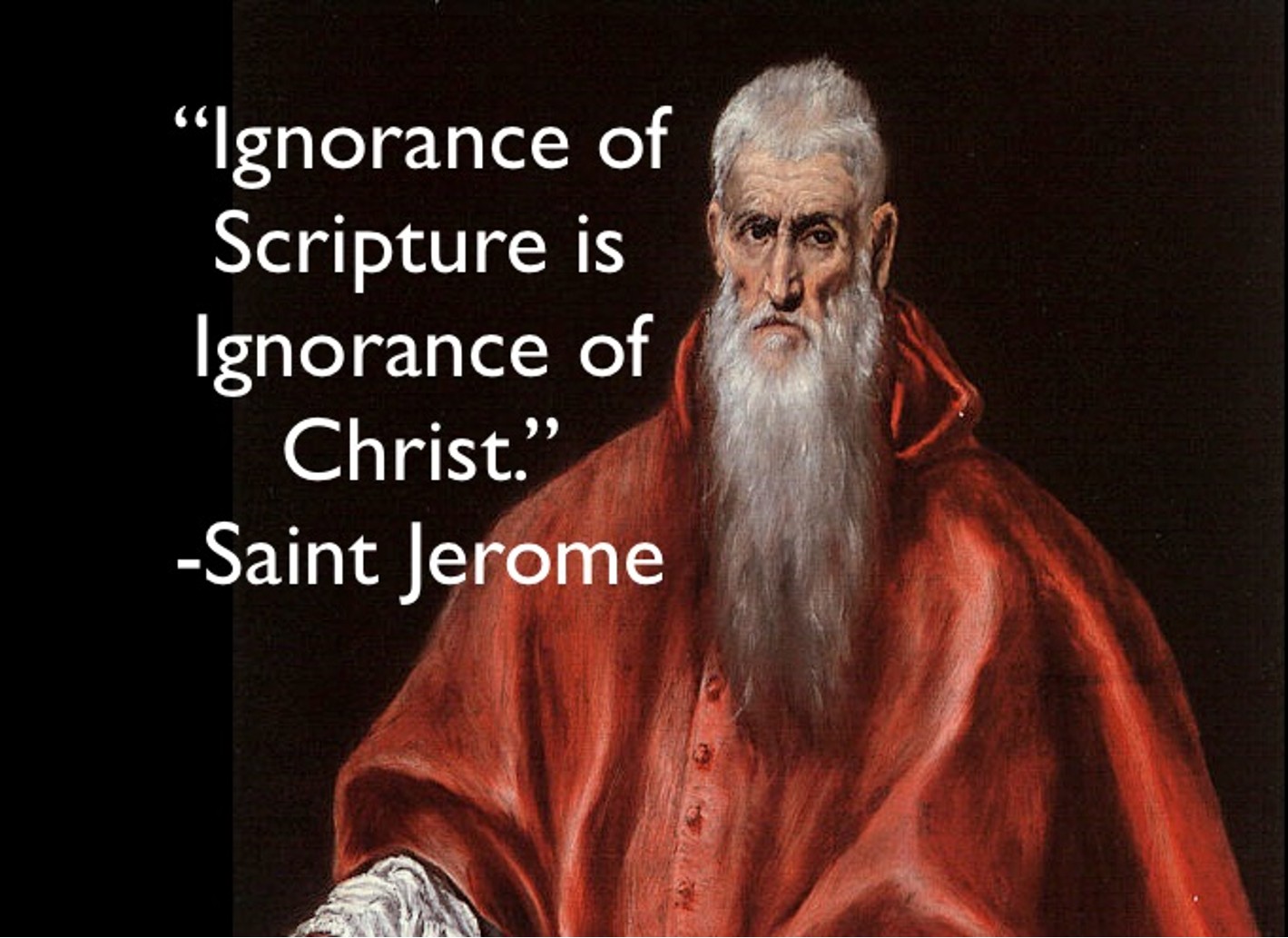
- Angels (Article 28, 73)
- Bible (Articles 6, 20, 21, 28, 31, 32, 42, 46, 48, 50, 55, 68)
- Church Discipline (Articles 7, 8, 12, 35, 49)
- Church Teaching (Articles 3, 9, 10, 11, 15, 18, 19, 21, 22, 26, 27, 28, 36, 37, 38, 43, 44, 47, 48, 49, 50, 51, 52, 54, 55, 56, 57, 58, 59, 61, 63, 64, 71, 72, 73, 74, 75, 76, 77, 78)
- Confession (Articles 30, 42, 44)
- Devotions (Articles 3, 22, 34, 39, 48, 59, 66)
- Catholic Education (Articles 13, 17, 20, 71, 72, 78)
- Eucharist (Articles 6, 16, 40, 48)
- General Knowledge (Articles 11, 22, 29, 31, 32, 33, 36, 37, 38, 44, 47, 58, 59, 66, 71, 72, 79)
- Hell (Articles 73, 75, 76)
- Jesus (Articles 1, 6, 7, 66)
- Liturgy (Articles 11, 12, 41, 48, 51, 67)
- Marriage (Articles 9, 14, 33, 43, 46, 57)
- Mary (Articles 43, 45, 60, 65, 72, 77)
- Mass (Articles 2, 4, 5, 12, 16, 23, 24, 25, 40, 41, 51, 62, 67, 69)
- Papacy (Article No. 64)
- Prayer (Articles 3, 8, 22, 62)
- Priesthood (Articles 19, 26, 51, 52, 53, 54, 58, 71)
- Purgatory (Articles 56, 76)
- Sacraments (Articles 1, 9, 10, 14,19, 26, 35, 41, 42, 47, 53, 63)
- Saints (Article 3, 72, 78)
Satan (Articles 7, 73)
- Suffering (Articles 56, 70)
